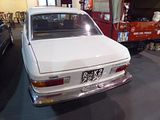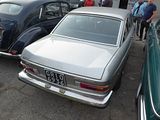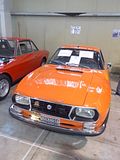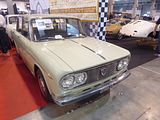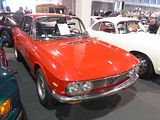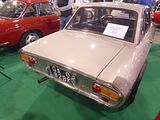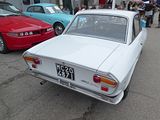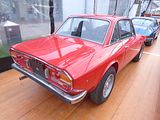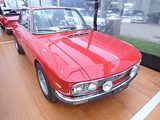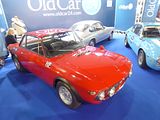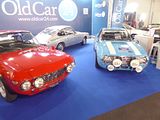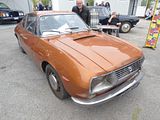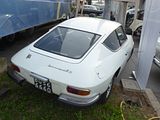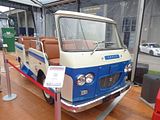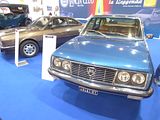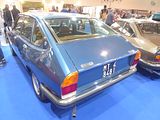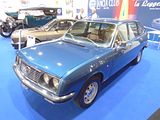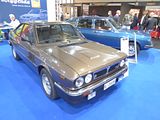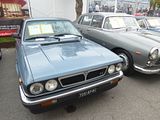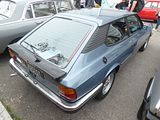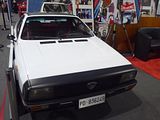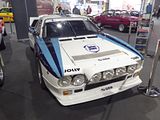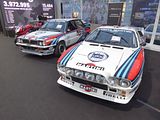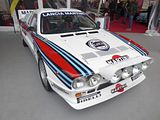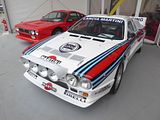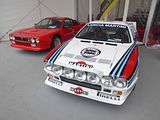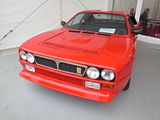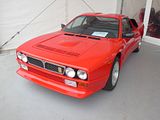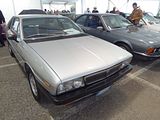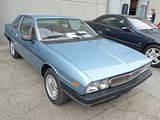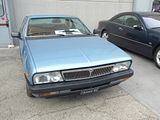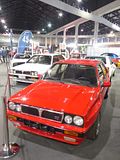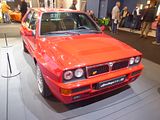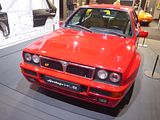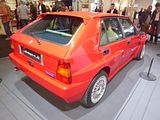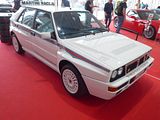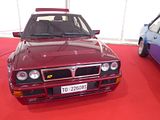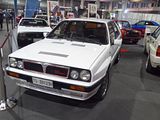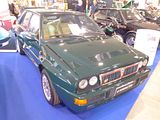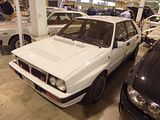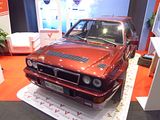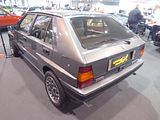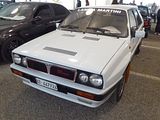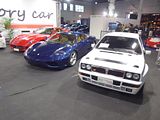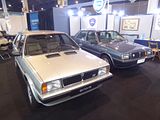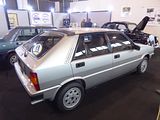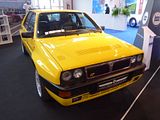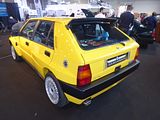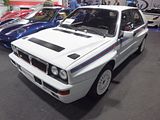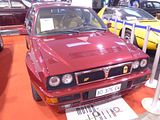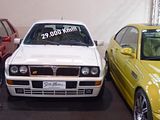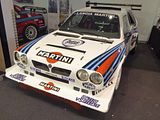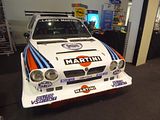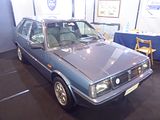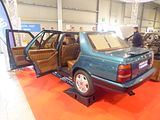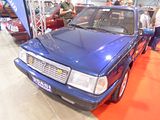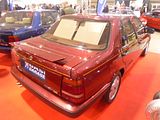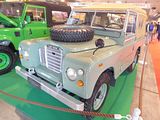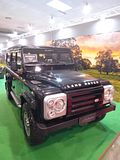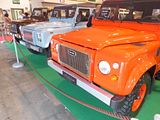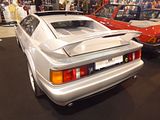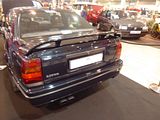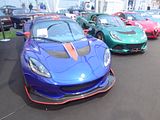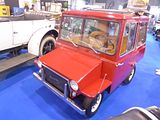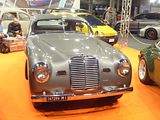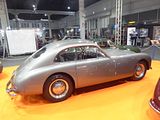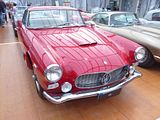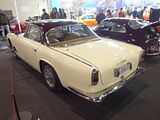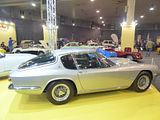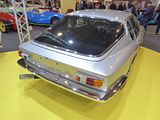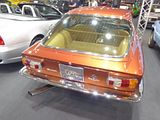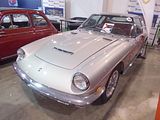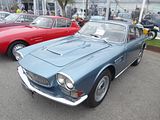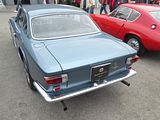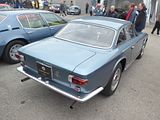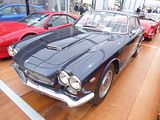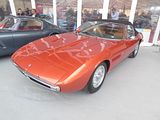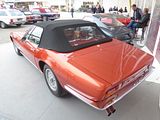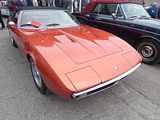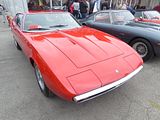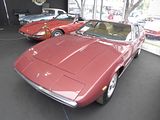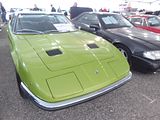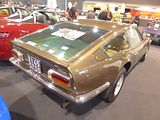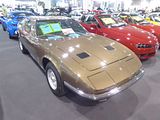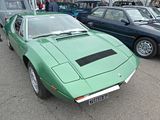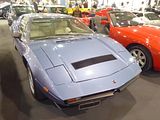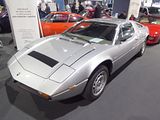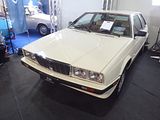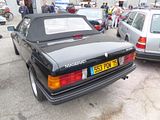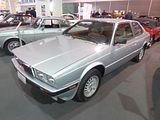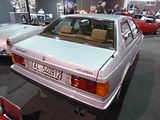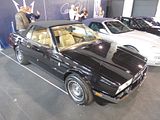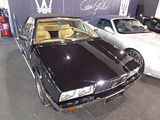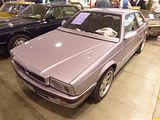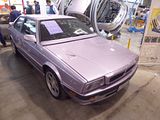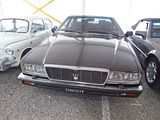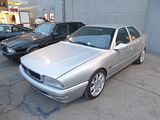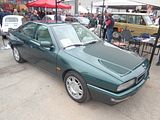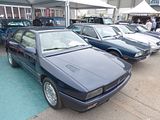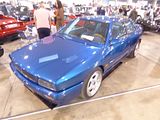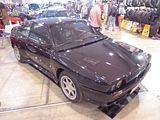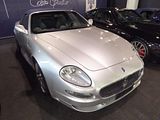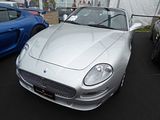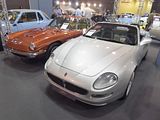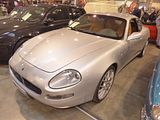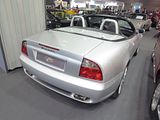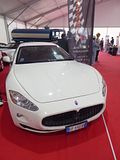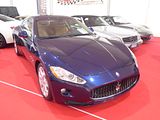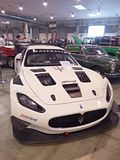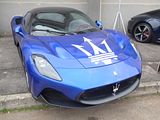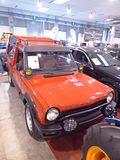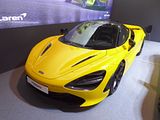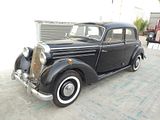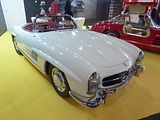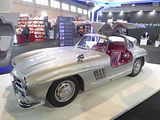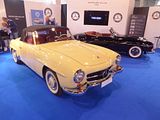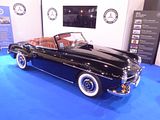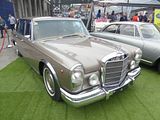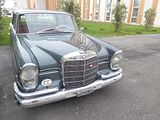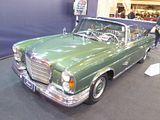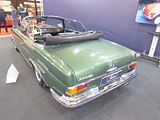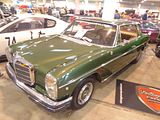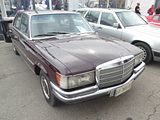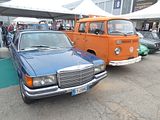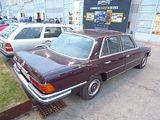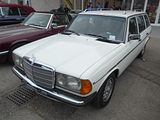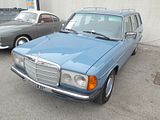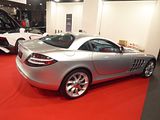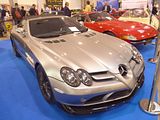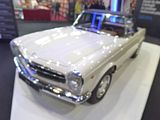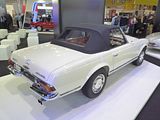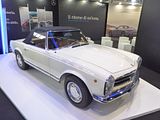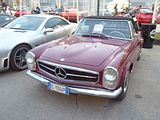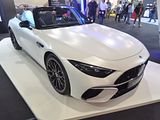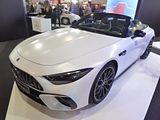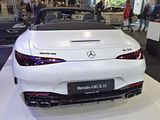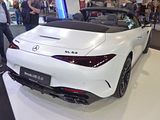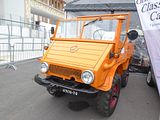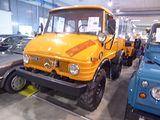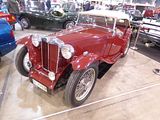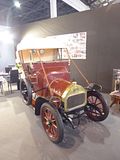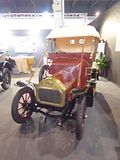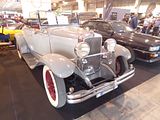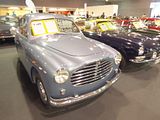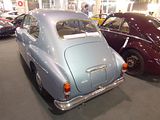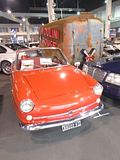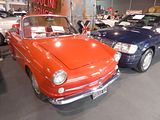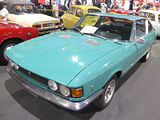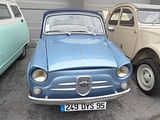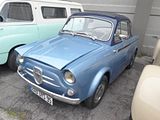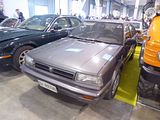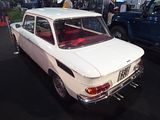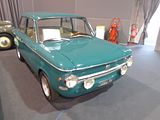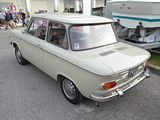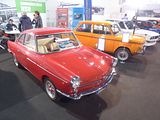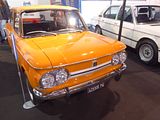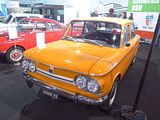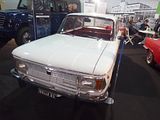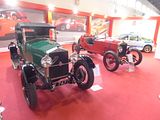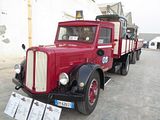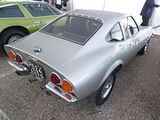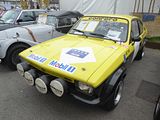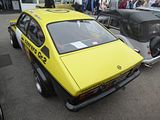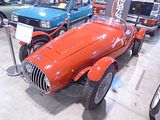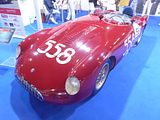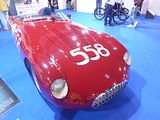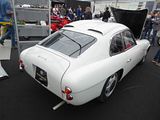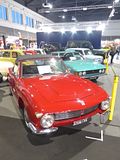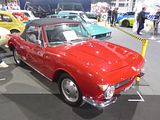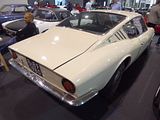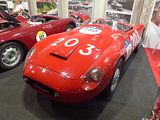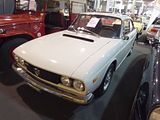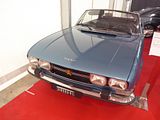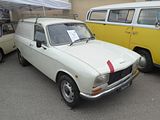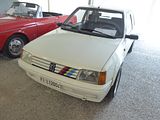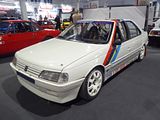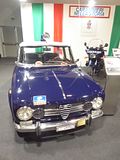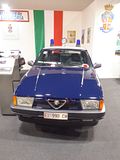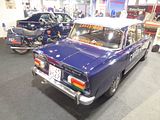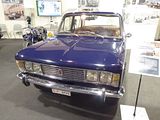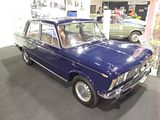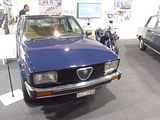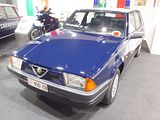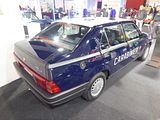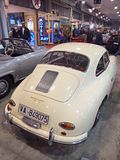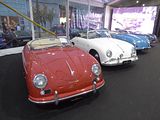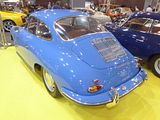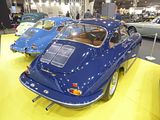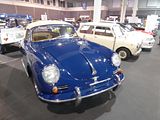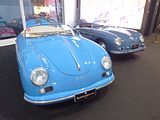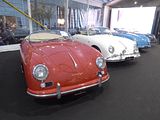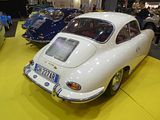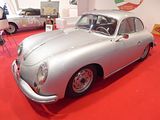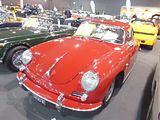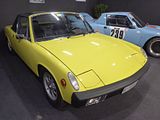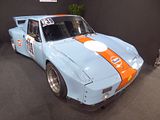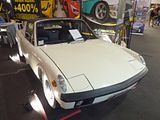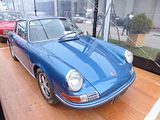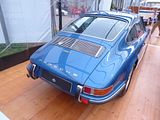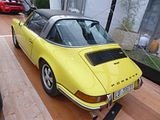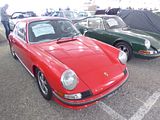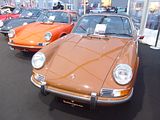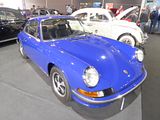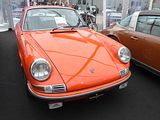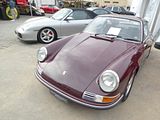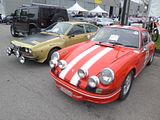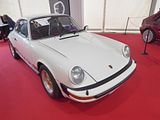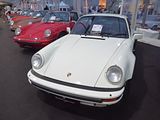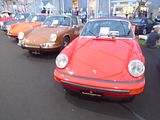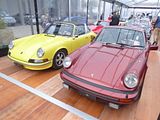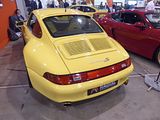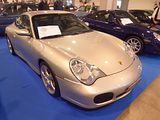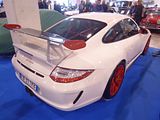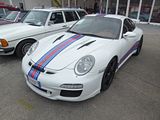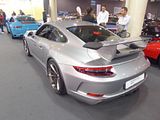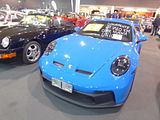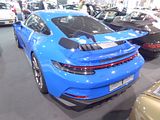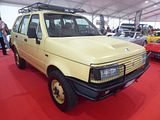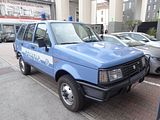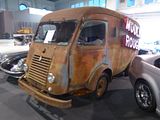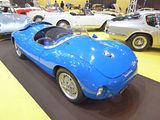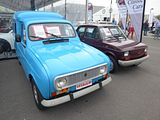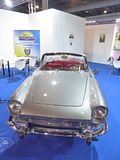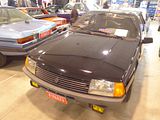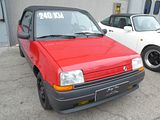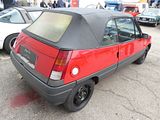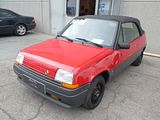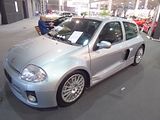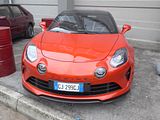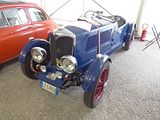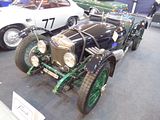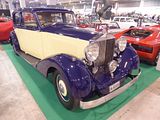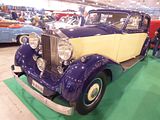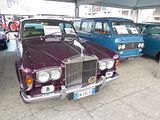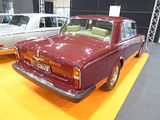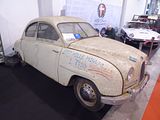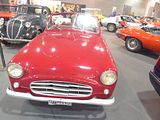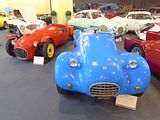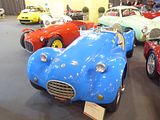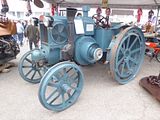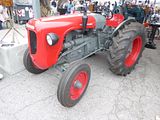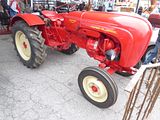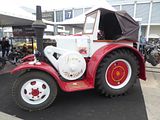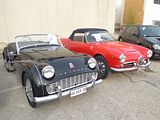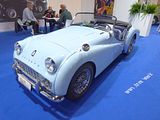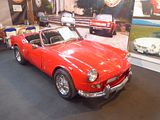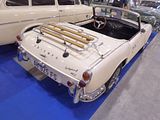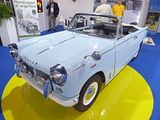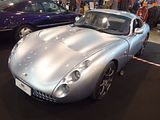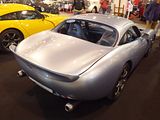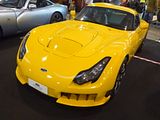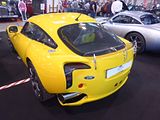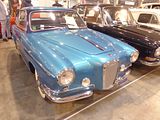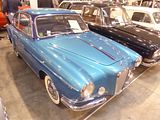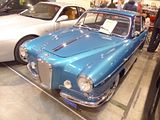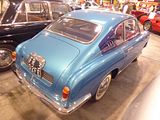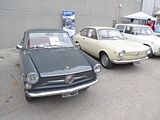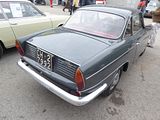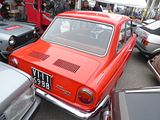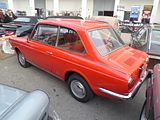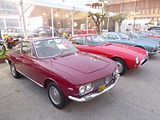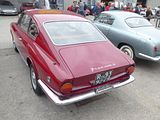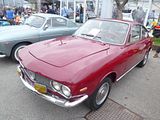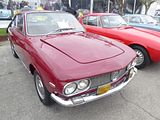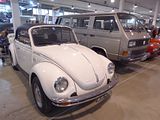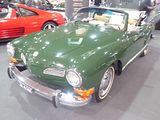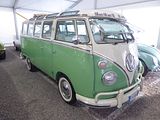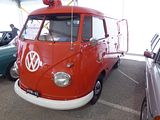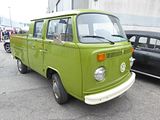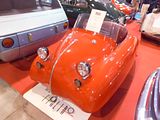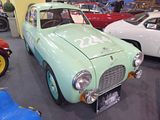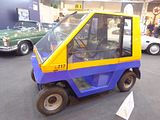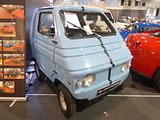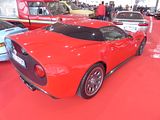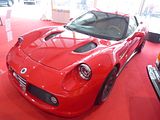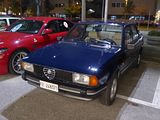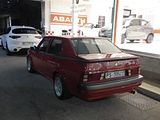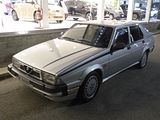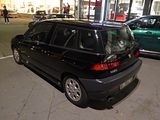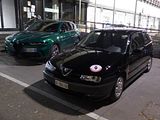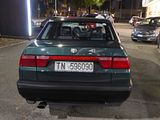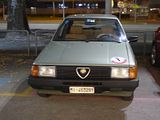FORD
The oldest Fords, of course, are all American, as it was only in the 1930s that production started in Europe. The Ford Model A was the Ford Motor Company’s second market success after its predecessor, the Model T. First produced on October 20, 1927, but not introduced until December 2, it replaced the venerable Model T, which had been produced for 18 years. This new Model A (a previous model had used the name in 1903–04) was designated a 1928 model and was available in four standard colours. By February 4, 1929, one million Model As had been sold, and by July 24, two million. The range of body styles ran from the Tudor at US$500 (in grey, green, or black) to the Town Car with a dual cowl at US$1200. In March 1930, Model A sales hit three million, and there were nine body styles available. Prices for the Model A ranged from US$385 for a roadster to US$1400 for the top-of-the-line Town Car. The engine was a water-cooled L-head inline four with a displacement of 3.3 litre. This engine provided 40 bhp. Top speed was around 65 mph (105 km/h). The Model A had a 103.5 in (2,630 mm) wheelbase with a final drive ratio of 3.77:1. The transmission was a conventional unsynchronized three-speed sliding gear manual with a single speed reverse. The Model A had four-wheel mechanical drum brakes. The 1930 and 1931 models were available with stainless steel radiator cowling and headlamp housings. The Model A came in a wide variety of styles including a Coupe (Standard and Deluxe), Business Coupe, Sport Coupe, Roadster Coupe (Standard and Deluxe), Convertible Cabriolet, Convertible Sedan, Phaeton (Standard and Deluxe), Tudor Sedan (Standard and Deluxe), Town Car, Fordor (five-window standard, three-window deluxe), Victoria, Town Sedan, Station Wagon, Taxicab, Truck, and Commercial. The very rare Special Coupe started production around March 1928 and ended mid-1929. The Model A was the first Ford to use the standard set of driver controls with conventional clutch and brake pedals, throttle, and gearshift. Previous Fords used controls that had become uncommon to drivers of other makes. The Model A’s fuel tank was situated in the cowl, between the engine compartment’s fire wall and the dash panel. It had a visual fuel gauge, and the fuel flowed to the carburettor by gravity. A rear-view mirror was optional. In cooler climates, owners could purchase an aftermarket cast iron unit to place over the exhaust manifold to provide heat to the cab. A small door provided adjustment of the amount of hot air entering the cab. The Model A was the first car to have safety glass in the windshield. Model A production ended in March 1932, after 4,858,644 had been made in all body styles. Its successor was the Model B, which featured an updated inline four-cylinder engine, as well as the Model 18, which introduced Ford’s new flathead (sidevalve) V8 engine.
Well known now, thanks to a starring role in the Harry Potter films is the Anglia 105E, a model that Ford launched in October 1959. It was a basic car, even in the better selling De Luxe version, so it was not surprising that Ford introduced a more powerful and luxurious model from 1962, the 123E Anglia Super. It had a larger 1198 cc engine and other refinements. Towards the end of the run Ford experimented with two colours of metallic paint on the Anglia, “Blue Mink” and “Venetian Gold”. 250 were made in the Blue and 500 were made in the Gold. Anglia saloons were provided with various levels of trim. The base model was the Standard, and this sported no chromework, painted rear light surrounds, steel slatted grille and limited interior trim. The deluxe had a chrome side strip, chrome rear lights, glovebox lid, sun visor and full width chrome radiator grille while the top of the range, also seen here, was the Super, which had twin chrome side strips, contrasting coloured roof and side flash, plusher interior trim, together with the 1198 cc engine and a gearbox with synchromesh on first gear. There was an Estate model here of a car brought back to popularity following a starring role in Harry Potter.
Using the project name of “Archbishop”, management at Ford of Britain in Dagenham created a family-sized car which they could sell in large numbers. The chief designer was Roy Brown Jr., the designer of the Edsel, who had been banished to Dagenham following the failure of that car. The car was designed to be economical, cheap to run and easy and inexpensive to produce in Britain. The front-wheel drive configuration used by Ford of Germany for the new Ford Taunus P4, a similarly sized model, was rejected in favour of traditional rear-wheel drive layout. Aimed at buyers of the Morris Oxford Farina and Vauxhall Victor, the car was launched as the Consul Cortina was launched on 20 September 1962. with a 1,198 cc three-bearing engine, which was an enlarged version of the 997 cc engine then fitted in the Ford Anglia. A few months later, in January 1963, the Cortina Super was announced with a five-bearing 1,498 cc engine. Versions of the larger engine found their way into subsequent variations, including the Cortina GT which appeared in spring 1963 with lowered suspension and engine tuned to give a claimed output of 78 bhp ahead of the 60 bhp claimed for the Cortina 1500 Super. The engines used across the Mark I range were of identical design, differing only in capacity and setup. The formula used was a four-cylinder pushrod design that came to be known as the “pre-crossflow” version as both inlet and exhaust ports were located on the same side of the head. The most powerful version of this engine (used in the GT Cortina) was 1,498 cc and produced 78 bhp. This engine contained a different camshaft profile, a different cast of head featuring larger ports, tubular exhaust headers and a Weber double barrel carburettor. Advertising of the revised version, which appeared at the London Motor Show in October 1964, and which dropped the Consul name from its official designation, made much of the newly introduced “Aeroflow” through-flow ventilation, evidenced by the extractor vents on the rear pillars. A subsequent test on a warm day involving the four different Cortina models manufactured between 1964 and 1979 determined that the air delivery from the simple eyeball outlets on the 1964 Mark I Cortina was actually greater than that on the Mark II, the Mark III or the Mark IV. The dashboard, instruments and controls were revised, for the second time, having already been reworked in October 1963 when round instruments replaced the strip speedometer with which the car had been launched: twelve years later, however, the painted steel dashboard, its “knobs scattered all over the place and its heater controls stuck underneath as a very obvious afterthought” on the 1964 Mark I Cortina was felt to have aged much less well than the car’s ventilation system. It was also in 1964 that front disc brakes became standard across the range. The Mark 1 Cortina was available as a two-door and four-door saloon, as well as in five-door estate (from March 1963) forms. Standard, Deluxe, Super, and GT trims were offered but not across all body styles. Early Standard models featured a simple body coloured front grille, earning it the nickname ‘Ironbar’. Since this version cost almost the same as the better equipped Deluxe it sold poorly and is very rare today. Options included heater and bench seat with column gearchange. Super versions of the estates offered the option of simulated wood side and tailgate trim. In an early example of product placement many examples of the brand new Cortina featured as “Glamcabs” in the comedy film Carry On Cabby.
Drawing on inspiration from the mid-engined Ford Mustang I concept vehicle, Lee Iacocca ordered development of a new “small car” to vice-president of design at Ford, Eugene Bordinat. Bordinat tasked Ford’s three design studios (Ford, Lincoln-Mercury, and Advanced Design) to create proposals for the new vehicle. The design teams had been given five goals for the design of the Mustang: It would seat four, have bucket seats and a floor mounted shifter, weigh no more than 2,500 pounds (1,100 kg) and be no more than 180 inches (4,572 mm) in length, sell for less than $2,500, and have multiple power, comfort, and luxury options. The Lincoln–Mercury design studio ultimately produced the winning design in the intramural contest, under Project Design Chief Joe Oros and his team of L. David Ash, Gale Halderman, and John Foster. Development of the Mustang was completed in a record 18 months from September 1962 to March 1964. and Iacocca himself championed the project as Ford Division general manager. The styling is often credited to one person, and that is not accurate, as this was very much a team effort, it has been reported by those involved. To decrease developmental costs, the Mustang used chassis, suspension, and drivetrain components derived from the Ford Falcon and Fairlane. It used a unitised platform-type frame from the 1964 Falcon, and welded box-section side rails, including welded crossmembers. Although hardtop Mustangs accounted for the highest sales, durability problems with the new frame led to the engineering of a convertible first, which ensured adequate stiffness. Overall length of the Mustang and Falcon was identical, although the Mustang’s wheelbase was slightly shorter. With an overall width of 68.2 in (1,732 mm), it was 2.4 in (61 mm) narrower, yet the wheel track was nearly identical. Shipping weight, approximately 2,570 lb (1,166 kg) with the straight six-cylinder engine, was also similar to the Falcon. A fully equipped V8 model weighed approximately 3,000 lb (1,361 kg). Although most of the mechanical parts were from the Falcon, the Mustang’s body was completely different; sporting a shorter wheelbase, wider track, lower seating position and lower overall height. An industry first, the “torque box” was an innovative structural system that greatly stiffened the Mustang’s construction and helped contribute to better handling. The car was launched in 17th April 1964, as a hardtop and a convertible, with the fastback version following in August. It was an instant sensation, with demand massively exceeding supply. Since it was introduced four months before the normal start of the 1965 production year and manufactured alongside 1964 Ford Falcons and 1964 Mercury Comets, the earliest Mustangs are widely referred to as the 1964½ model. Nevertheless, all “1964½” cars were given 1965 U.S. standard VINs at the time of production, and – with limited exception to the earliest of promotional materials – were marketed by Ford as 1965 models. The low-end model hardtop used a “U-code” 170 cu in (2.8 litre) straight-6 engine borrowed from the Falcon, as well as a three-speed manual transmission and retailed for US$2,368. Standard equipment for the early 1965 Mustangs included black front seat belts, a glove box light, and a padded dash board. Production began in March 1964 and official introduction following on April 17 at the 1964 World’s Fair. V8 models got a badge on the front fender that spelled out the engine’s cubic inch displacement (“260” or “289”) over a wide “V.” This emblem was identical to the one on the 1964 Fairlane. Several changes to the Mustang occurred at the start of the “normal” 1965 model year in August 1964, about four months after its introduction. These cars are known as “late 65’s”. The engine lineup was changed, with a 200 cu in (3.3 litre) “T-code” engine that produced 120 hp. Production of the Fairlane’s “F-code” 260 cu in (4.3 litre) engine ceased when the 1964 model year ended. It was replaced with a new 200 hp “C-code” 289 cu in (4.7 litre) engine with a two-barrel carburettor as the base V8. An “A-code” 225 hp four-barrel carburettor version was next in line, followed by the unchanged “Hi-Po” “K-code” 271 hp 289. The DC electrical generator was replaced by a new AC alternator on all Fords (a way to distinguish a 1964 from a 1965 is to see if the alternator light on the dash says “GEN” or “ALT”). The Mustang GT version was introduced as the “GT Equipment Package” and included a V8 engine (most often the 225 hp 289), grille-mounted fog lamps, rocker panel stripes, and disc brakes. In the interior the GT option added a different instrument panel that included a speedometer, fuel gauge, temp. gauge, oil pressure gauge and ammeter in five round dials (the gauges were not marked with numbers, however.) A four-barrel carburettor engine was now available with any body style. Additionally, reverse lights were an option added to the car from August 1964 production. In 1965, the Shelby Mustang was born, it was available only in newly introduced fastback body version with its swept-back rear glass and distinctive ventilation louvres. The standard interior features of the 1965 Mustang included adjustable driver and passenger bucket seats, an AM radio, and a floor mounted shifter in a variety of colour options. Ford added additional interior options during the 1965 model year. The Interior Decor Group was popularly known as “Pony Interior” due to the addition of embossed running ponies on the seat fronts, and also included integral armrests, woodgrain appliqué accents, and a round gauge cluster that would replace the standard Falcon instrumentation. Also available were sun visors, a (mechanical) remote-operated mirror, a floor console, and a bench seat. Ford later offered an under-dash air-conditioning unit, and discontinued the vinyl with cloth insert seat option, offered only in early 1965 models. One option designed strictly for fun was the Rally-Pac. Introduced in 1963 after Ford’s success at that year’s Monte Carlo Rally and available on other Ford and Mercury compacts and intermediates, the Rally-Pac was a combination clock and tachometer mounted to the steering column. It was available as a factory ordered item for US$69.30. Installed by a dealer, the Rally-Pac cost US$75.95.A 14″ rim option was available for Rally-pac and GT350R vehicles widening front and rear track to 57.5″. Reproductions are presently available from any number of Mustang restoration parts sources. A compass, rear seat belts, A/C, and back-up lights were also optional. The 1966 Mustang debuted with moderate trim changes including a new grille, side ornamentation, wheel covers and filler cap. Ford’s new C-4 “cruise-o-matic” three-speed auto transmission became available for the 225 hp V8. The 289 “HiPo” K-code engine was also offered with a c4 transmission, but it had stronger internals and can be identified by the outer casing of the servo which is marked with a ‘C’. The long duration solid-lifter camshaft that allowed the high revving 289 to make the horsepower it was known for, was not friendly for a low stall speed automatic torque converter. The “HiPo” could be spotted very easily by the 1-inch-thick vibration damper, (as compared to 1/2 inch on the 225-hp version) and the absence of a vacuum advance unit on the dual point distributor. With the valve covers off, there is a large letter “K” stamped between the valve springs, along with screw in studs (vs. a pressed in stud for other 289s) for the adjustable rocker arms. A large number of new paint and interior color options, an AM/eight-track sound system, and one of the first AM/FM mono automobile radios were also offered. It also removed the Falcon instrument cluster; the previously optional features, including the round gauges and padded sun visors, became standard equipment. The Mustang would be the best-selling convertible in 1966, with 72,119 sold, beating the number two Impala by almost 2:1. The 1965 and 1966 Mustangs are differentiated by variations in the exterior, despite similar design. These variations include the emblem on the quarter-panels behind the doors. From August 1964 production, the emblem was a single vertical piece of chrome, while for 1966 models the emblem was smaller in height and had three horizontal bars extending from the design, resembling an “E”. The front intake grilles and ornaments were also different. The 1965 front grille used a “honeycomb” pattern, while the 1966 version was a “slotted” style. While both model years used the “Horse and Corral” emblem on the grille, the 1965 had four bars extending from each side of the corral, while on the 1966, these bars were removed. The 1966 model year saw introduction of ‘High Country Special’ limited edition, 333 of them were sold in Colorado, Wyoming, and Nebraska. When Ford wanted to introduce the Mustang in Germany, they discovered that Krupp company had already registered the name for a truck. The German company offered to sell the rights for US$10,000. Ford refused and removed Mustang badges from exported units, instead naming the cars as T-5 (a pre-production Mustang project name) for the German market until 1979 when Krupp copyrights expired. In 1965, Harry Ferguson Research purchased 3 Mustang notchbacks and converted them to 4×4 in an attempt to sell potential clients on their FF AWD system. A similar system was used in the Ferguson P99 Formula One car, and would go on to be featured in the Jensen FF, widely considered the first AWD passenger car. As in the Jensen FF, the AWD Mustangs also featured an ABS braking system, long before such a feature was commonplace. Ford Australia organised the importation and conversion of 1966 Mustang to right-hand-drive for the Australian market. This coincided with the launch of new XR Falcon for 1966, which was marketed as “Mustang-bred Falcon”. To set the official conversion apart from the cottage industry, the RHD Mustangs were called “Ford Australia Delivered Mustang” and had compliance plates similar to XR Falcon. About 209 were imported to Australia with 48 units were converted in 1965 while the further 161 were done in 1966. The 1967 model year Mustang was the first redesign of the original model. Ford’s designers began drawing up a larger version even as the original was achieving sales success, and while “Iacocca later complained about the Mustang’s growth, he did oversee the redesign for 1967 .” The major mechanical feature was to allow the installation of a big-block V8 engine. The overall size, interior and cargo space were increased. Exterior trim changes included concave taillights, side scoop (1967 model) and chrome (1968 model) side ornamentation, square rear-view mirrors, and usual yearly wheel and gas cap changes. The high-performance 289 option was placed behind the newer 335 hp 6.4 litre FE engine from the Ford Thunderbird, which was equipped with a four-barrel carburettor. During the mid-1968 model year, a drag racer for the street could be ordered with the optional 428 cu in (7.0 litre) Cobra Jet engine which was officially rated at 335 hp. All of these Mustangs were issued R codes on their VIN’s. The 1967 Deluxe Interior was revised, discontinuing the embossed running horse motif on the seat backs (the source for the “pony interior” nickname) in favor of a new deluxe interior package, which included special colour options, brushed aluminium (from August 1966 production) or woodgrain dash trim, seat buttons, and special door panels. The hardtop also included upholstered quarter trim panels, a carryover from the 1965-66 deluxe interior. The 1967 hardtop also had the chrome quarter trim caps, carried over from 1965-66, but these were painted to match the interior in 1968 models. The 1967 deluxe interior included stainless steel-trimmed seat back shells, similar to those in the Thunderbird. These were dropped at the end of the 1967 model year, and were not included in the woodgrain-trimmed 1968 interior. The deluxe steering wheel, which had been included in the deluxe interior for the 1965-66, became optional, and could also be ordered with the standard interior. The 1968 models that were produced from January 1968 were also the first model year to incorporate three-point lap and shoulder belts (which had previously been optional, in 1967-68 models) as opposed to the standard lap belts. The air-conditioning option was fully integrated into the dash, the speakers and stereo were upgraded, and unique center and overhead consoles were options. The fastback model offered the option of a rear fold-down seat, and the convertible was available with folding glass windows. Gone was the Rally-Pac, since the new instrument cluster had provisions for an optional tachometer and clock. Its size and shape also precluded the installation of the accessory atop the steering column. The convenience group with four warning lights for low fuel, seat belt reminder, parking brake not released, and door ajar were added to the instrument panel, or, if one ordered the optional console and A/C, the lights were mounted on the console. Changes for the 1968 model increased safety with a two-spoke energy-absorbing steering wheel, along with newly introduced shoulder belts. Other changes included front and rear side markers, “FORD” lettering removed from hood, rearview mirror moved from frame to windscreen, a 302 cu in (4.9 litre) V8 engine was now available, and C-Stripe graphics were added. The California Special Mustang, or GT/CS, was visually based on the Shelby model and was only sold in Western states. Its sister, the ‘High Country Special’, was sold in Denver, Colorado. While the GT/CS was only available as a coupe, the ‘High Country Special’ model was available in fastback and convertible configurations during the 1966 and 1967 model years, and as a coupe for 1968. The 1968 Ford Mustang GT Fastback reached iconic status after it was featured in the 1968 film Bullitt, starring Steve McQueen. In the film, McQueen drove a modified 1968 Mustang GT 2+2 Fastback chasing a Dodge Charger through the streets of San Francisco. There were further annual updates until the model’s replacement in 1973, but with each the car got steadily bigger and less overtly sporty. Sales reduced, too, suggesting that Ford were losing their way. Mustang II did not fix that, of course, but gradually, the legendary nameplate has returned to delivering the same sort of promise as those early and much loved cars were able to do.
Iacocca, who had been one of the forces behind the original Mustang, became president of Ford Motor Company in 1970, and ordered a smaller, more fuel-efficient Mustang for 1974. Initially, it was to be based on the Ford Maverick, but ultimately was based on the Ford Pinto subcompact. The new model, called the “Mustang II”, was introduced on September 21, 1973, two months before the first 1973 oil crisis, and its reduced size allowed it to compete against successful imported sports coupes such as the Japanese Datsun 240Z, Toyota Celica and the European Ford Capri (then Ford-built in Germany and Britain, sold in U.S. by Mercury as a captive import car). The Mustang II also later competed against the Chevrolet Monza, Pontiac Sunbird, Oldsmobile Starfire and Buick Skyhawk. First-year sales were 385,993 cars, compared with the original Mustang’s twelve-month sales record of 418,812. Ultimately, the Mustang II was an early example of downsizing that would take place among Detroit’s Big Three during the “malaise era”. Iacocca wanted the new car, which returned the Mustang to its 1965 model year predecessor in size, shape, and overall styling, to be finished to a high standard, saying it should be “a little jewel”. Not only was it smaller than the original car, but it was also heavier, owing to the addition of equipment needed to meet new U.S. emission and safety regulations. Performance was reduced, and despite the car’s new handling and engineering features the galloping mustang emblem “became a less muscular steed that seemed to be cantering”. Engines for the 1974 models included the venerable 2.3 L I4 from the Pinto and the 2.8 L Cologne V6 from the Mercury Capri. The 1975 model year reintroduced the 302 cu in (4.9 L) Windsor V8 that was only available with the C-4 automatic transmission, power brakes, and power steering. This continued through production’s end in 1978. Other transmissions were the RAD four-speed with unique gearing for all three engines, and the C-3 automatic behind the 2.3 L and 2.8 L. The “5.0 L” marketing designation was not applied until the 1978 King Cobra model. All 302 cu in (4.9 L)-equipped Mustang IIs, except the King Cobras, received updated versions of the classic Ford “V8” emblem on each front fender. The car was available in coupe and hatchback versions, including a “luxury” Ghia model designed by Ford’s recently acquired Ghia of Italy. The coupe was marketed as a “hardtop” but actually had a thin “B” pillar and rear quarter windows that did not roll down. All Mustangs in this generation did feature frameless door glass, however. The “Ghia” featured a thickly padded vinyl roof and smaller rear quarter windows, giving a more formal look. 1974 models were: hardtop, hatchback, Mach 1, and Ghia. Changes introduced for 1975 included the availability of an “MPG” model which had a different rear axle ratio for better fuel economy. 1976 added the “Stallion” trim package. The Mach 1 remained through the life cycle 1974–1978. Other changes in appearance and performance came with a “Cobra II” version in 1976–1978 and a “King Cobra” in 1978 of which around 4,972 were built. The 1977–1978 hatchback models in all trim levels were now available with the T-top roof option, which included a leatherette storage bag that clipped to the top of the spare tire hump.
At the end of November 1975, in time for the 1976 model year, production began of the Taunus series “GBTS”, also known as the “Ford Taunus TC2”. Ford of Britain continued to sell the Cortina Mark III, the Dagenham produced version of the earlier Taunus TC, for more than half a year following the launch of the Taunus TC2, but in September 1976 the Cortina Mark IV was introduced in Britain, after which the Taunus TC2 and Cortina Mk IV were almost identical, apart from regional variations in terms of specification changes and trim levels. Internally, they were for the most part differentiated by the driving position: LHD (left-hand drive) cars were badged Taunus while RHD (right-hand drive) cars were badged Cortina, generally regardless of the country of assembly. However, where the German “Ford Taunus” name had no significant positive presence the “Ford Cortina” name was used in certain smaller LHD markets such as Greece, South Korea, Philippines, Israel (which took most of its LHD cars as Cortinas, sourced from the UK plant, till 1981) and Taiwan. The Taunus TC2 was essentially a “reskin” of the Taunus TC, and was in most markets presented as such. For Ford’s Cortina buyers the reskin was a little more extensive, with the loss of the “coke-bottle” line which distinguished the Cortina Mk III from the 1976 Mk IV model, and promotional material in respect of the Cortina played up the differences between the Cortinas Mark III and IV. The Taunus TC2 retained an overall silhouette very similar to that of the Taunus TC, though actually all the principal outer body panels were newly shaped as were the rear window and side windows. Parking became a little easier now that the rear corners of the car were visible from the driver’s seat. From outside the car the most obvious change was the loss at the front of the “Knudsen Nose” which made for a less eye-catchingly individualistic look, but resulted in a more harmonious body shape. The suspension set-up was unchanged from that on the Taunus TC (as improved in September 1973). The twin circuit hydraulic braking system still operated on disc brakes at the front and drum brakes at the rear, their diameters unchanged. However, where in 1970 a buyer of the entry level 1294 cc would have found a brake servo only on the options list, servo-assisted brakes for the Taunus TC2 were standard across the range.[16] On the six-cylinder cars, which had heavier engine blocks, it also became possible from August 1977 to specify as an option power assisted steering. The range of engine sizes was the same apart from one important addition: buyers could specify an enlarged 1993 cc version of the “Pinto” OHC engine. It was therefore now possible to buy a 2-litre vTaunus with either 4 or 6 cylinders. The four-cylinder powered car came with an advertised maximum output of 98 PS while the six-cylinder version offered only 90 PS. The more recently designed four-cylinder unit also came with more torque. Nevertheless, the six-cylinder car achieved its maxima at lower engine speeds and some commentators found it more relaxing to drive. There were few changes to the interior of the TC2, since the dashboard, instrumentation and switchgear had already been redesigned for the 1974 model year version of the TC1 just two years earlier, although there were new steering wheel designs and updated trim materials. As before, all but the 1294 cc-engined car could be ordered, at extra cost, with a three-speed automatic transmission. The automatic box offered was no longer a Borg Warner system, but Ford’s own C3 transmission produced at the manufacturer’s transmission plant in Bordeaux which had opened in 1973. Since 1970 the Taunus TC had competed head-on for market-share with the Opel Ascona, and in 1973 the two were joined in what was now a three-way tussle by the Volkswagen Passat. Strictly comparable production data for the three cars are not easily accessible, but if one leaves out Opels assembled in Britain as Vauxhall Cavaliers, then in volume terms the three-way tussle was narrowly won between 1976 and 1982 by the Ford Taunus TC2/TC3, with 1,583,699 cars produced. Between 1975 and 1981 Opel produced 1,316,459 Ascona Bs. The Opel figures would rise above those for the Taunus if one added the 196,512 Vauxhall Cavaliers built, on behalf of Vauxhall at Opel’s Antwerp plant, and be boosted further if one added the 534,634 mechanically similar Opel Mantas that shared the Ascona’s production line. During the six years between 1976 and 1982 Volkswagen produced 1,360,312 Passats. To make the Volkswagen group the convincing winner in this contest it would be necessary to add the 1,290,164 mechanically similar Audi 80s to the figure given here for the Volkswagen Passat. Despite its strong performance in the market place, by 1980, with new contenders from Volkswagen and Opel arriving, the output data suggest that the age of the Taunus TC’s basic design was beginning to count against it. In a sector which gained in significance during the increasingly cash-strapped 1970s, as many buyers traded down from larger cars such as the Opel Rekord, the Taunus TC2/TC3 (like the TC before it) achieved market place success through a combination of good looks and aggressive pricing. The mechanically conservative car was widely regarded as dependable, despite never entirely ridding itself of irritating defects and weaknesses which a more rigorous development process should have prevented. When, in 1979, the Taunus TC3 (also known as the Taunus series “GBFS”) replaced the Taunus TC2 the major components remained basically the same. In the UK Ford presented the facelifted car as the “Cortina Model 80”, although it quickly became known, if only informally, as the Cortina Mk 5.
With over 16 million units sold, the Fiesta has been an undoubted success for Ford, vindicating the decision that was taken back in the early 1970s that they really did need a car in this class, one that they were frankly late in joining. Originally developed under the project name “Bobcat” (not to be confused with the subsequent rebadged Mercury variant of the Ford Pinto) and approved for development by Henry Ford II in September 1972, just after the launch of two comparable cars – the Fiat 127 and Renault 5, the Fiesta was an all new car in the supermini segment, and was at the time the smallest car ever made by Ford. Development targets indicated a production cost US$100 less than the current Escort. The car was to have a wheelbase longer than that of the Fiat 127, but with overall length shorter than that of Ford’s Escort. The final proposal was developed by Tom Tjaarda at Ghia. The project was approved for production in late 1973, with Ford’s engineering centres in Cologne and Dunton (Essex) collaborating. Ford estimated that 500,000 Fiestas a year would be produced, and built an all-new factory near Valencia, Spain; a trans-axle factory near Bordeaux, France; factory extensions for the assembly plants in Dagenham, UK. Final assembly also took place in Valencia. The name Fiesta belonged to General Motors, used as a trim level on Oldsmobile estate models, when the car was designed but it was freely given for Ford to use on their new B-class car. After years of speculation by the motoring press about Ford’s new car, it was subject to a succession of carefully crafted press leaks from the end of 1975. A Fiesta was on display at the Le Mans 24 Hour Race in June 1976, and the car went on sale in France and Germany in September 1976; to the frustration of UK dealerships, right hand drive versions only began to appear in January 1977. Its initial competitors in Europe, apart from the Fiat 127 and Renault 5, included the Volkswagen Polo and Vauxhall Chevette. Chrysler UK were also about to launch the Sunbeam by this stage, and British Leyland was working on a new supermini which was eventually launched as the Austin Metro in 1980. The Fiesta was initially available in Europe with the Valencia 957 cc with high compression and low compression options, and 1,117 cc engines in Base, Popular, L, GL (1978 onward), Ghia and S trim, as well as a van. A sporting derivative, the 1.3 Supersport was offered for the 1980 model year, using the 1.3 litre Kent Crossflow engine, effectively to test the market for the similar XR2 introduced a year later, which featured a 1.6 litre version of the same engine. Black plastic trim was added to the exterior and interior. The small square headlights were replaced with larger circular ones, with the front indicators being moved into the bumper to accommodate the change. With a quoted performance of 0–60 mph in 9.3 seconds and 105 mph top speed, the XR2 hot hatch became a cult car beloved of boy racers throughout the 1980s. Minor revisions appeared across the range in late 1981, with larger bumpers to meet crash worthiness regulations and other small improvements in a bid to maintain showroom appeal ahead of the forthcoming second generation. Rust claimed almost all the original Fiestas, so they are a rare sight today.
The Sierra RS Cosworth model. a very sporting version of Ford’s upper-medium sized family car, was built by Ford Europe from 1986 to 1992, the result of a Ford Motorsport project with the purpose of producing an outright winner for Group A racing in Europe. The project was defined in the spring of 1983 by Stuart Turner, then recently appointed head of Ford Motorsport in Europe, who had realised right away that Ford was no longer competitive in this area. Turner got in touch with Walter Hayes, at the time the vice-president of public relations at Ford, to get support for the project. Hayes had earlier been the driving force behind the development of the Ford GT40 that won Le Mans in 1966, and the Cosworth DFV engine that brought Ford 154 victories and 12 world championships in Formula One during the 1960s and 1970s. Hayes found the project very appealing and promised his full support. Turner then invited Ken Kohrs, vice-president of development, to visit Ford’s longtime partner, the automotive company Cosworth, where they were presented a project developed on Cosworth’s own initiative, the YAA engine. This was a twin cam, 16-valve engine based on Ford’s own T88 engine block, better known as the Pinto. This prototype proved an almost ideal basis for the engine Turner needed to power his Group A winner. Therefore, an official request for a turbocharged version (designated Cosworth YBB) capable of 180 HP on the street and 300 HP in race trim, was placed. Cosworth answered positively, but they put up two conditions: the engine would produce not less than 204 HP in the street version, and Ford had to accept no fewer than 15,000 engines. Turner’s project would only need about 5,000 engines, but Ford nevertheless accepted the conditions. The extra 10,000 engines would later become one of the reasons Ford also chose to develop a four door, second generation Sierra RS Cosworth. To find a suitable gearbox proved more challenging. The Borg-Warner T5, also used in the Ford Mustang, was chosen, but the higher revving nature of the Sierra caused some problems. Eventually Borg-Warner had to set up a dedicated production line for the gearboxes to be used in the Sierra RS Cosworth. Many of the suspension differences between the standard Sierra and the Cosworth attributed their development to what was learned from racing the turbocharged Jack Roush IMSA Merkur XR4Ti in America and Andy Rouse’s successful campaign of the 1985 British Saloon Car Championship. Much of Ford’s external documentation for customer race preparation indicated “developed for the XR4Ti” when describing parts that were Sierra Cosworth specific. Roush’s suspension and aerodynamics engineering for the IMSA cars was excellent feedback for Ford. Some production parts from the XR4Ti made their way into the Cosworth such as the speedometer with integral boost gauge and the motorsport 909 chassis stiffening plates. In April 1983, Turner’s team decided on the recently launched Sierra as a basis for their project. The Sierra filled the requirements for rear wheel drive and decent aerodynamic drag. A racing version could also help to improve the unfortunate, and somewhat undeserved, reputation that Sierra had earned since the introduction in 1982. Lothar Pinske, responsible for the car’s bodywork, demanded carte blanche when it came to appearance in order to make the car stable at high speed. Experience had shown that the Sierra hatchback body generated significant aerodynamic lift even at relatively moderate speed. After extensive wind tunnel testing and test runs at the Nardò circuit in Italy, a prototype was presented to the project management. This was based on an XR4i body with provisional body modifications in fibreglass and aluminium. The car’s appearance raised little enthusiasm. The large rear wing caused particular reluctance. Pinske insisted however that the modifications were necessary to make the project successful. The rear wing was essential to retain ground contact at 300 km/h, the opening between the headlights was needed to feed air to the intercooler and the wheel arch extensions had to be there to house wheels 10” wide on the racing version. Eventually, the Ford designers agreed to try to make a production version based on the prototype. In 1984, Walter Hayes paid visits to many European Ford dealers in order to survey the sales potential for the Sierra RS Cosworth. A requirement for participation in Group A was that 5,000 cars were built and sold. The feedback was not encouraging. The dealers estimated they could sell approximately 1,500 cars. Hayes did not give up, however, and continued his passionate internal marketing of the project. As prototypes started to emerge, dealers were invited to test drive sessions, and this increased the enthusiasm for the new car. In addition, Ford took some radical measures to reduce the price on the car. As an example, the car was only offered in three exterior colours (black, white and moonstone blue) and one interior colour (grey). There were also just two equipment options: with or without central locking and electric window lifts. The Sierra RS Cosworth was first presented to the public at the Geneva Motor Show in March 1985, with plans to release it for sale in September and closing production of the 5,000 cars in the summer of 1986. In practice, it was launched in July 1986. 5545 were manufactured in total of which 500 were sent to Tickford for conversion to the Sierra three-door RS500 Cosworth. The vehicles were manufactured in right hand drive only, and were made in Ford’s Genk factory in Belgium. Exactly 500 RS500s were produced, all of them RHD for sale in the UK only – the biggest market for this kind of Ford car. It was originally intended that all 500 would be black, but in practice 56 white and 52 moonstone blue cars were produced.To broaden the sales appeal, the second generation model was based on the 4 door Sierra Sapphire body. It was launched in 1988, and was assembled in Genk, Belgium, with the UK-built Ford-Cosworth YBB engine. Cylinder heads on this car were early spec 2wd heads and also the “later” 2wd head which had some improvements which made their way to the 4X4 head. Suspension was essentially the same with some minor changes in geometry to suit a less aggressive driving style and favour ride over handling. Spindles, wheel offset and other changes were responsible for this effect. Approximately 13,140 examples were produced during 1988-1989 and were the most numerous and lightest of all Sierra Cosworth models. Specifically the LHD models which saved weight with a lesser trim level such as manual rear windows and no air conditioning. In the UK, the RHD 1988-1989 Sierra Sapphire RS Cosworth is badged as such with a small “Sapphire” badge on the rear door window trims. All 1988-1989 LHD models are badged and registered as a Sierra RS Cosworth with no Sapphire nomenclature at all. “Sapphire” being viewed as a Ghia trim level that saw power rear windows, air conditioning and other minor options. Enthusiasts of the marque are mindful of this and will describe the LHD cars by their body shell configuration, 3 door or 4 door. As the Sapphire Cosworth was based on a different shell to the original three-door Cosworth, along with its more discreet rear wing, recorded a drag co-efficient of 0.33, it registered slightly better performance figures, with a top speed of 150 mph and 0-60 of 6.1 seconds, compared to the original Cosworth. In January 1990, the third generation Sierra RS Cosworth was launched, this time with four wheel drive. As early as 1987, Mike Moreton and Ford Motorsport had been talking about a four wheel drive Sierra RS Cosworth that could make Ford competitive in the World Rally Championship. The Ferguson MT75 gearbox that was considered an essential part of the project wasn’t available until late 1989 however. Ford Motorsport’s desire for a 3-door “Motorsport Special” equivalent to the original Sierra RS Cosworth was not embraced. The more discreet 4-door version was considered to have a better market potential. It was therefore decided that the new car should be a natural development of the second generation, to be launched in conjunction with the face lift scheduled for the entire Sierra line in 1990. The waiting time gave Ford Motorsport a good opportunity to conduct extensive testing and demand improvements. One example was the return of the bonnet louvres. According to Ford’s own publicity material, 80% of the engine parts were also modified. The improved engine was designated YBJ for cars without a catalyst and YBG for cars with a catalyst. The latter had the red valve cover replaced by a green one, to emphasise the environmental friendliness. Four wheel drive and an increasing amount of equipment had raised the weight by 100 kg, and the power was therefore increased to just about compensate for this. The Sierra RS Cosworth 4×4 received, if possible, an even more flattering response than its predecessors and production continued until the end of 1992, when the Sierra was replaced by the Mondeo. The replacement for the Sierra RS Cosworth was not a Mondeo however, but the Escort RS Cosworth. This was to some extent a Sierra RS Cosworth clad in an “Escort-like” body. The car went on sale in May 1992, more than a year after the first pre-production examples were shown to the public, and was homologated for Group A rally in December, just as the Sierra RS Cosworth was retired. It continued in production until 1996. The Sierra and Sapphire Cosworths were undoubted performance bargains when new, but they also gained a reputation both for suffering a lot of accidents in the hands of the unskilled and also for being among the most frequently stole cars of their generation. These days, though, there are some lovely and treasured examples around and indeed you are far more likely to see a Cosworth version of the Sierra than one of the volume selling models.
The Ford Escort RS Cosworth is a sports derivative and rally homologation special of the fifth generation European Ford Escort. It was designed to qualify as a Group A car for the World Rally Championship, in which it competed between 1993 and 1998. It was available as a road car from 1992–96 in very limited numbers. Ford developed the car around the chassis and mechanicals of its spiritual predecessor, the Sierra Cosworth to accommodate the larger Cosworth engine and transmission, whilst clothing it in Escort body panels to make it resemble the standard car. Designed under the guidance of Rod Mansfield and John Wheeler of Ford’s SVO department, the styling was carried out during 1989, a year before the standard Escort was launched, by Stephen Harper at MGA Developments in Coventry. The spoiler was added by Frank Stephenson, who originally proposed a three-deck piece. The body tooling was created by coachbuilders Karmann at their facility in Rheine, Germany, where the cars were manufactured. Changes were made to the engine management system and a new turbocharger was fitted. Permanent four wheel drive with a 34/66% front/rear split came courtesy of an uprated five speed gearbox as used in the Sierra Cosworth. Recaro sports seats came as a standard fitment. Later production models were available without the oversize tail spoiler although by far the majority were still ordered with it. Like its Sierra predecessor, they are commonly nicknamed “Cossie” by enthusiasts. The car’s top speed was 150 mph, which rivalled lower-end supercars including the Audi Quattro, BMW M3, Nissan 300ZX and Toyota Supra, and comfortably outperformed traditional “hot hatchbacks” like the Volkswagen Golf GTI. It was much faster than the 126 mph which the Escort RS2000 and earlier Escort RS Turbo were capable of. Two versions were produced. The initial 2,500 units were “homologation specials” used to get the FIA accreditation for entry into the World Rally Championship. They were fitted with a Garrett T3/T04B turbocharger. Among these initial units, a handful were badged as Motorsport versions, these lacked certain refinements such as a sunroof and sound deadening. The initial cars included features that, although they made the Cosworth a more effective car, did not enhance it as a road vehicle, and once the rules were satisfied Ford attempted to make the car less temperamental and easier to drive under normal conditions. The second generation, starting production from late 1994, were fitted with a Garrett T25 turbocharger, a smaller unit which reduced turbo lag and increased usability in everyday driving situations. With these later models, the ‘whale tail’ spoiler became a delete option. . The Escort Cosworth was a rare car, with 7,145 vehicles produced from the start of production on 19 February 1992 until the last car rolled out of the factory on 12 January 1996.
FRANCIS LOMBARDI
The Carrozzeria Francis Lombardi was founded in 1947 in Vercelli, Italy, by noted pilot Carlo “Francis” Lombardi. They originally engaged in some aeronautical design, but this soon ended. and they focussed exclusively on automobiles after 1950. Their first efforts were coupés on Fiat 1100 and 1400 basis; these were soon followed by station wagons with wood-panelled bodywork on 1100-basis. Francis Lombardi also made six-seater limousines from Fiat sedans of the period such as the 1400 and 1800. Intended for ministerial or representational use, they had stretched wheelbases and luxuriously fitted interiors. Famously, they built a Vatican-commissioned Fiat 2300-based limousine with a glass roof for Pope Paul VI in 1963 – this was the first “true” Popemobile. Francis Lombardi also developed four-door versions of the Fiat 600, 850, and 127. This series of small four-door saloons was called “Lucciola” by Lombardi. The first one was the 600 Lucciola which appeared in early 1957; in addition to four doors without a B-pillar (the rear door opening backwards) it also had a floor mounted shifter unlike a regular 600. Francis Lombardi’s greatest commercial success was with the luxuriously appointed Fiat 500 called “My Car”; which supported an annual production of about 6,000 cars in the sixties, up from about 1,500 towards the late fifties. The Fiat 850 Lucciola was also used by Spain’s SEAT for their 850 four-door sedan, although eventually they developed their own, longer version. At the end of the sixties, the Lombardi Grand Prix appeared, the closest thing to an independent design from the firm. This model had a convoluted history and was sold in small numbers under a variety of names until 1972, fitted with Fiat engines in various states of tune. Francis Lombardi continued to focus on modifying cars as well, building coupés on Fiat as well as on NSU basis (1000 TTS). In the 1970s they made special versions of the Fiat 128 and Lancia 2000, but in 1973 their doors were closed for good. Ten years later, Carlo Lombardi died. This is their version of the Nuova 500, which was known as the Francis Lombardi MyCar which came with a fixed roof, a slightly raised roofline and a higher quality interior trim compared to the Fiat version.
GHIA
This the very rare 1500 GT. These were made by Ghia between 1962 and 1967 with 846 cars being produced. The two-seater Coupe was based on a shortened Fiat 1500 C chassis and powered by a mildly tuned version of the Fiat’s 1500cc in-line, four cylinder engine. The unit was mated to a four speed manual gearbox. Suspension was independent by coil springs at the front and a leaf-spring mounted live axle at the rear. The car rode on pretty Borrani wire wheels. Thanks to its streamlined shape the 1500 GT was capable of around 110mph – an impressive speed for a 1500cc car of this period.
GIANNINI
This Giannini 500 TV incorporates various performance enhancing products made by Giannini. Founded in 1920 by the Giannini brothers – Attilio and Domenico – the company began tuning the little FIAT 500 Topolino in the 1930’s and secured 12 world speed records with one of its modified cars. In the early 1960s the original company closed, the brothers going their separate ways to found new enterprises. Attilio’s new design company lasted only until 1971 but that founded by Domenico – Giannini Automobili SpA – survives today as part of the FIAT Group. In 1963 Giannini Automobili began modifying cars and selling tuning kits. That same year it introduced its own modified version of the baby FIAT – the 500TV – and throughout the decade and into the 1970’s Giannini-tuned cars battled with those of its rival Abarth on the racetracks of Europe. In more recent years Giannini has specialised in the production of limited-edition versions of FIAT production models.
This is even rarer, an example of an 850 prepared and set up by the Giannini car specialists. The 850 S included several mechanical improvements such as an oversized carburettor, a light alloy oil sump, a high-efficiency silencer that increased the compression ratio and raised power to 48hp SAE, and many accessories that made it aesthetically unmistakable.
Giannini continued to supply tuning kits for most fiat models in the 1970s and 80s and this 126 is an example of a car with some of their parts fitted
GILCO
Gilco is a magical name for all those who are enthusiastic about early, post-war motor racing. The firm was known primarily for its excellent work supplying the chassis for Alfa Romeo, Ferrari (from 1946–1958, during which time he helped to produce their first grand prix car), Stanguellini and Cisitalia. Gilco (an acronym for Gilberto Colombo, the founder) was an extraordinary company. Its activity began in 1946, when the company began producing tubular chassis for small 750-cc and 1,100-cc “Sport” class motor cars, which were lightweight, small displacement racers with open bodywork. In 1949, Gilco produced the 205MM type chassis, with the intention of fitting barchetta coachwork in order to race at the Mille Miglia. This project was later changed as the prototype of a small series of 50–100 cars all to be produced in a spider form. This one was driven by Malaguti
GOLDEN AGE OF RALLYING
This year’s special display was a collection of historic rally cars centred around the Gino Macaluso Foundation and it included such stars as an Alitalia liveried Lancia Stratos, An A112 Abarth, Fiat 124 Sport Spider and Sandro Munari’s championship winning Lancia Fulvia HF1600, still bearing is rally battle scars.
HONDA
There were very few Japanese cars here, a reflection of the fact that it is only recently when there have been significant sales of cars from brands from Japan. There was this rather nice Honda N600, though. Launched initially as the Hobbbbbbbbbbbbbbnda N360 this was a small front-engine, front-wheel drive, two-passenger two-box automobile manufactured and marketed from March 1967 through 1970 in compliance with Japan’s kei car regulations. After a January 1970 facelift, the N360 became the NIII360 and continued in production until June 1972. A larger-engined variant, the N600, was marketed through 1973. All models complied with Japanese kei car dimensional regulations, though vehicles with the 401 cc and 598 cc engines exceeded the kei engine displacement limits and were largely intended for international sales. The N360 featured front wheel drive and an air-cooled, four stroke, 354 cc, 31 bhp two-cylinder engine. This same engine was also used in the Honda Vamos, with a beam axle/leaf spring rear suspension. With the N360 nameplate, along with its variants, Honda used the “N” prefix, designating “norimono” (translating from Japanese to English as “vehicle” ) — to distinguish the car from its motorcycle production. Honda marketed the N360 as a two-door sedan, with a three-door wagon (considered a commercial vehicle in Japan, and therefore called a “Light van”) called the LN360 arriving in June of the first year. It has a horizontally divided rear gate and boxier rear bodywork for maximum load capacity. The LN360 had the same 31 PS engine as the sedan, and a top speed of 105 km/h (65 mph). After a January 1970 facelift it became the LNIII 360, with a new non-reflective dash, bigger turn signals, and the same new front end as the sedan. The LNIII 360 was built until late 1971, when the Life Van took over. The N360 was an all new, clean-sheet product, and did not share its chassis with the Honda Sports roadster, or the Honda L700 commercial platform. The N360 was a new market segment for Honda, providing an affordable, reliable, and easy-to-maintain vehicle that had broad market appeal to private car ownership. The roadsters and trucks built up to then had specific, targeted appeal. The engine’s technological specifications reflected engineering efforts resulting from the development of the larger Honda 1300, which used an air-cooled 1.3-litre engine. One of the primary differences between the N360 and the Honda Life that followed was the N360/600 had an air-cooled engine, and the Life had a water-cooled engine. The water-cooled engine was better able to comply with newly enacted emission standards in Japan, and reflected an industry wide move away from air-cooled as well as two-stroke engines. As does the original Mini, but unlike the succeeding Life, the N360/600 had its gearbox mounted in the sump rather than bolted on as a separate unit. An upgraded 36 PS engine was added in October 1968 for the N360 TS, which was sold as the N360 Touring following a minor update in January 1969. The updated version is referred to as the NII. A 401.54 cc engine was used in the similar N400, a model sold in certain export markets beginning in late summer 1968. This occupied the narrow slot between the 360 and the 600; in most markets it was only sold as the N400 L with better equipment. The Hondamatic-equipped N360AT which appeared in August 1968 was the first kei car equipped with an automatic transmission. The larger-engined N600 was developed alongside the N360 in order to target export markets like the US and Europe, where motorways demanded higher top speeds. It was also briefly sold in the domestic Japanese market, however, where it went on sale in July 1968 as the N600E. Only 1,500 examples were sold until early 1969 when the N600 was discontinued in Japan; because of its larger engine it did not qualify for any of the tax and insurance breaks given to kei cars even though it was as small as one. Sales ended in 1973 with the introduction of the Civic.
It is more than a quarter of a century since Honda stunned the world with a true Ferrari-beater. Its origins go back all the way to 1984, when Honda commissioned the Italian car designer Pininfarina to design the HP-X (Honda Pininfarina eXperimental), which had a mid-mounted C20A 2.0 L V6 configuration. After Honda committed to the project, management informed the engineers that the new car would have to be as fast as anything coming from Italy and Germany .The HP-X concept car evolved into a prototype called the NS-X, which stood for “New”, “Sportscar” and “eXperimental”. The NS-X prototype and eventual production model were designed by a team led by Chief Designer Ken Okuyama and Executive Chief Engineer Shigeru Uehara, who subsequently were placed in charge of the S2000 project. The original performance target for the NS-X was the Ferrari 328, and later the 348 as the design neared completion. Honda intended the NS-X to meet or exceed the performance of the Ferrari, while offering targeted reliability and a lower price point. For this reason, the 2.0L V6 of the HP-X was abandoned and replaced with a more powerful 3.0L VTEC V6 engine. The bodywork design had been specifically researched by Okuyama and Uehara after studying the 360 degree visibility inside an F-16 fighter jet cockpit. Thematically the F-16 came into play in the exterior design as well as establishing the conceptual goals of the NSX. In the F-16 and other high performance craft such as unlimited hydroplanes, single seat race cars etc. the cockpit is located far forward on the body and in front of the power plant. This “cab-forward” layout was chosen early in the NSX’s design to optimise visibility while the long tail design enhanced high speed directional stability. The NS-X was designed to showcase several Honda automotive technologies, many derived from its F1 motor-sports program. The NS-X was the first production car to feature an all-aluminium monocoque body, incorporating a revolutionary extruded aluminium alloy frame, and suspension. The use of aluminium in the body alone saved nearly 200 kg in weight over the steel equivalent, while the aluminium suspension saved an additional 20 kg; a suspension compliance pivot helped maintain wheel alignment changes at a near zero value. Other notable features included an independent, 4-channel anti-lock brake system; titanium connecting rods in the engine to permit reliable high-rpm operation; an electric power steering system; Honda’s proprietary VTEC variable valve timing system (a first in the US) and, in 1995, the first electronic throttle control fitted to a Honda. With a robust motorsports division, Honda had significant development resources at its disposal and made extensive use of them. Respected Japanese Formula One driver Satoru Nakajima, for example, was involved with Honda in the NS-X’s early on track development at Suzuka race circuit, where he performed many endurance distance duties related to chassis tuning. Brazilian Formula One World Champion Ayrton Senna, for whom Honda had powered all three of his world championship-winning Formula One race cars before his death in 1994, was considered Honda’s main innovator in convincing the company to stiffen the NSX chassis further after initially testing the car at Honda’s Suzuka GP circuit in Japan. Senna further helped refine the original NSX’s suspension tuning and handling spending a whole day test driving prototypes and reporting his findings to Honda engineers after each of the day’s five testing sessions. Senna also tested the NSX at the Nurburgring and other tracks. The suspension development program was far-ranging and took place at the Tochigi Proving Grounds, the Suzuka circuit, the 179-turn Nurburgring Course in Germany, HPCC, and Hondas newest test track in Takasu, Hokkaido. Honda automobile dealer Bobby Rahal (two-time CART PPG Cup and 1986 Indianapolis 500 champion) also participated in the car’s development. The production car made its first public appearances as the NS-X at the Chicago Auto Show in February 1989, and at the Tokyo Motor Show in October 1989 to positive reviews. Honda revised the vehicle’s name from NS-X to NSX before final production and sale. The NSX went on sale in Japan in 1990 at Honda Verno dealership sales channels, supplanting the Honda Prelude as the flagship model. The NSX was marketed under Honda’s flagship Acura luxury brand starting in 1991 in North America and Hong Kong. It sent shockwaves through the industry, as the car was considerably better than the Ferrari 348 in just about every respect. But that was not the end of the story, of course. While the NSX always was intended to be a world-class sports car, engineers had made some compromises in order to strike a suitable balance between raw performance and daily driveability. For those NSX customers seeking a no-compromise racing experience, Honda decided in 1992 to produce a version of the NSX specifically modified for superior on-track performance at the expense of customary creature comforts. Thus, the NSX Type R (or NSX-R) was born. Honda chose to use its moniker of Type R to designate the NSX-R’s race-oriented design. In 1995, a Targa model was released, the NSX-T, which allowed customers to experience fresh air thanks to two removable targa top panels. The original NSX body design received only minor modifications from Honda in the new millennium when in 2002 the original pop-up headlamps were replaced with fixed xenon HID headlamp units.
INNOCENTI
From a distance, you would probably have seen this car and thought that it was “simply” an example of the classic Issigonis-designed Mini. But this is Italy, where BMC’s baby was built locally for many years, so it was no surprise to see that it had Innocenti badges and some different detailing, especially the front grille. Innocenti was an Italian machinery works originally established by Ferdinando Innocenti in 1920. Over the years they produced Lambretta scooters as well as a range of cars, most of them with British Leyland origins. After World War II, the company was famous for many years for Lambretta scooters models. From 1961 to 1976 Innocenti built under licence the BMC (later the British Leyland Motor Corporation, or BLMC for short) Mini, with 998 cc and 1,275 cc engines, followed by other models, including the Regent (Allegro), with engines up to 1,485 cc. The company of this era is commonly called Leyland Innocenti. The Innocenti Spyder (1961–70) was a rebodied version of the Austin-Healey MKII Sprite (styling by Ghia). The car was produced by OSI, near Milan. In 1972 BLMC took over control of the company in a £3 million deal involving the purchase of the company’s land, buildings and equipment. BLMC had high hopes for its newly acquired subsidiary at a time when, they reported to the UK press, Italian Innocenti sales were second only to those of Fiat, and ahead of Volkswagen and Renault. There was talk of further increasing annual production from 56,452 in 1971 to 100,000. However, the peak production under BLMC was 62,834 in 1972, in spite of exports increasing from one car in 1971 to more than 17,000 in 1974. Demonstrating their ambitions, the British company installed as Managing Director one of their youngest UK based senior executives, the then 32-year-old former Financial Controller Geoffrey Robinson. Three years later BLMC ran out of money and was nationalised by the UK government. In February 1976, the company passed to Alejandro de Tomaso and was reorganised by the De Tomaso Group under the name Nuova Innocenti. Benelli had a share and British Leyland retained five percent, with De Tomaso owning forty-four percent with the aid of a rescue plan from GEPI (an Italian public agency intended to provide investment for troubled corporations). Management was entirely De Tomaso’s responsibility, however, and later in 1976 GEPI and De Tomaso combined their 95% of Innocenti (and all of Maserati) into one new holding company. However, with the loss of the original Mini, the Austin I5, and the (admittedly slow-selling) Regent, sales were in freefall. Production was nearly halved in 1975 and was down to about a fifth of the 1974 levels in 1976. After this crisis, however, the new Bertone-bodied Mini began selling more strongly and production climbed to a steady 40,000 per annum by the end of the ’70s. The first model had Bertone-designed five-seater bodywork and was available with Leyland’s 998 cc and 1275 cc engines. Exports, which had been carried out mainly by British Leyland’s local concessionaires, began drying up in the early eighties as BL did not want to see internal competition from the Innocenti Mini. Sales to France (Innocenti’s biggest export market) ended in 1980, with German sales coming to a halt in 1982. Around the same time, the engine deal with Leyland ended, and production soon dropped into the low twenty thousands. Later models, from model year 1983 on, used 993 cc three-cylinder engines made by Daihatsu of Japan. De Tomaso developed a turbocharged version of this engine for Daihatsu which found use in both Innocenti’s and Daihatsu’s cars. Fiat bought the company in 1990, and the last Innocenti models were versions of the Uno-based Fiat Duna Saloon and Estate, which were badged Elba. The brand was retired in 1996. The car seen here was badged Cooper 1300, and these cars had lots of little differences compared to the Longbridge and Cowley made models. Innocenti had been assembling Minis since 1965, creating finished cars from CKD kits, the first cars called Innocenti 850. In 1971, they started to produce the Innocenti Cooper 1300, following the demise of the model in the UK, which had been replaced by the 1275GT, and it continued until 1975 when all the Issigonis Minis were deleted, to be replaced by the hatchback Bertone Mini 90 and 120 cars
INTERMECCANICA
The Intermeccanica Murena was the result of a brief foray into the world of car making by two Americans, M. Charles Schwendler and Jospeh Vos. The two men planned to build the fastest and most luxurious station wagon (shooting brake in Europe) that the world had ever seen with styling that no one would ever forget. They succeeded on all three points, however the unforgettable styling wasn’t well received in 1969 and the price tag that was double that of a new Porsche 911 resulted in very slow sales. By the time the company folded in 1970 just 10 had been sold. Construction of the Murena was taken care of by Intermeccanica in Italy, each body was individually coach built from steel by Italian specialists and given an American powertrain – specifically the 429 cu. in. (7 litre) V8 from the Ford Thunderbird and the accompanying 3-speed automatic transmission. This engine turns out 360 bhp at 4,600 rpm 480 ft lbs of torque at 2,800 rpm, the weight of the vehicle is 3770 lbs, the 0-62 mph time is 7.5 seconds and the 1/4 mile time is 15.5 seconds. These were respectable times for a luxurious four seater with ample luggage space and air-conditioning in 1969. Suspension is independent up front with a live axle in the rear, it’s geared more for luxury that sporting endeavours however it does have Girling disc brakes both front and back, and rack and pinion steering. Inside the car there’s comfortable seating for four adults, with both rear bucket seats offering good legroom, excellent views out of the panoramic windows, and a centre console that runs between both sets of seats offering ashtrays and a minibar. There’s a sunroof above the front seats and good visibility out across the long low hood, and despite the sound proofing the low burble of the V8 is an ever-present accompaniment to the car’s stereo. The first Murena prototype which was displayed at the 1969 New York Motor Show where it attracted plenty of attention, Road & Track Magazine did a review of the car which was mostly positive but the $14,995 USD price tag was just too much for most buyers. Production ceased in less than 12 months with just 10 cars sold. Today collectors view the Murena 429 GT with considerable interest. It’s one of a few unusual Italian/American vehicles that make good use of reliable American V8 power and Italian styling and coach building. With less than a dozen examples of this car extant there’s always a lot of interest when one (rarely) pops up for sale. There is some debate about the provenance of this particular car.
ISO
Originally founded in Genoa in 1939, but transferred to Bresso in 1942 by Renzo Rivolta, an engineer and the heir of industrialists, the Iso Rivolta company was initially named ‘Isothermos” and manufactured refrigeration units before World War II. After the Second World War, the company reopened its doors, completely changing its activity. In 1948 it began to build motorcycles, scooters and motocarries (three-wheeled transport scooters/motorcycles). Among the most famous are the Furetto (1948), ‘Isoscooter (1950),’ Isocarro (1951), ‘Isomoto (1954) and’ Isosport (1953). Accordingly, the business was refounded as Iso Autoveicoli S.p.A. in 1953 to reflect the production of motorized transport.
The Isetta is far more significant than many show-goers would realise, as without these cars, the modern BMW company simply would not exist. However, the car originated with the Italian firm of Iso SpA, and it is two of those models which were to be seen here. In the early 1950s the company was building refrigerators, motor scooters and small three-wheeled trucks. Iso’s owner, Renzo Rivolta, decided he would like to build a small car for mass distribution. By 1952 the engineers Ermenegildo Preti and Pierluigi Raggi had designed a small car that used the motorcycle engine of the Iso Moto 200 and named it Isetta—an Italian diminutive meaning little ISO. The Isetta caused a sensation when it was introduced to the motoring press in Turin in November 1953, it was unlike anything seen before. Small (only 7.5 ft long by 4.5 ft wide) and egg-shaped, with bubble-type windows, the entire front end of the car hinged outwards to allow entry. In the event of a crash, the driver and passenger were to exit through the canvas sunroof. The steering wheel and instrument panel swung out with the single door, as this made access to the single bench seat simpler. The seat provided reasonable comfort for two occupants, and perhaps a small child. Behind the seat was a large parcel shelf with a spare wheel located below. A heater was optional, and ventilation was provided by opening the fabric sunroof. Power came from a 236 cc 9.5 hp split-single two-stroke motorcycle engine. The engine was started by a combination generator-starter known as Dynastart. A manual gearbox provided four forward speeds and reverse. A chain drive connected the gearbox to a solid rear axle with a pair of closely spaced 25 cm (10 in) rear wheels. The first prototypes had one wheel at the rear, but having a single rear wheel made the car prone to roll-overs, so the rear wheel layout was changed to two wheels set 19 in apart from each other. This narrow track eliminated the need for a differential. The front axle was a modified version of a Dubonnet independent front suspension. The Isetta took over 30 seconds to reach 50 km/h (31 mph) from rest. Top speed was only about 75 km/h (47 mph). The fuel tank held only 13 litres. However, the Isetta would get somewhere between 50 and 70 mpg depending on how it was driven. In 1954, Iso entered several Isettas in the legendary Mille Miglia where they took the top three spots in the economy classification. Over a distance of 1,600 km (1,000 mi) the drivers achieved an average speed of over 70 km/h (43 mph). In view of its maximum speed, which was just 15 km/h (9 mph) higher, this was an almost incredible figure. However, despite its initial success, the Isetta was beginning to slip in popularity at home. This was mainly due to renewed competition from Fiat with its 500C model. Renzo Rivolta wanted to concentrate on his new Iso Rivolta sports car, and was extremely interested in doing licensing deals. Plants in Spain and Belgium were already assembling Isettas and Autocarros using Italian made Iso components. BMW began talking with Rivolta in mid-1954 and bought not just a license but the complete Isetta body tooling as well. Rivolta did not stop with licensing the Isetta to BMW. He negotiated similar deals with companies in France and Brazil. After constructing some 1,000 units, production of the Italian built cars ceased in 1955, although Iso continued to build the Isetta in Spain until 1958. In addition to the Turismo, Iso in Spain also built the Autocarro, a commercial version with full-width rear axle. The Autocarro was offered in several body styles, a flatbed pickup, enclosed truck, a tilt-bed, or even a fire engine, although some of these might not have been sold. The Autocarro was an extremely popular type of vehicle in Italy, and numerous manufacturers produced some variant of the type. Iso had previously produced a motorcycle-type Isocarro. The Iso Autocarro was larger than most, with its four-wheel layout, conventional rear axle with differential and leaf springs, and a large tubular frame. It could carry a 500 kg load. It is thought that more than 4,000 Autocarros were built
The Iso Fidia (or Iso Rivolta Fidia), initially Iso Rivolta S4, is a four-door sedan which was produced by the Italian automobile maker Iso Automoveicoli S.p.A. from 1967 to 1975. The Fidia, first presented at the Frankfurt Motor Show in September 1967, was the only four-door model from Iso. Production only got underway some time after the initial presentation of the car, and its European press launch which took place in Athens, came more than a year later, in February 1969. At the time of the press launch 15 cars had already been built, but it was only in February 1969 that the car swapped its “S4” name for the more euphonious “Fidia”. The car was marketed as a unique combination of comfort and sporting performance, and the slogan that appeared in sales material was “Le quattro poltrone piu veloci del mondo” (“the four fastest seats in the world”). The choice of Athens for the press launch was connected to the car’s new name, Fidia, which was the name (commonly spelled “Phidias” by anglophone classicists) of the artist who some 24 centuries earlier had supervised creation of the friezes which originally decorated the Parthenon (and which in 1816 turned up in the British Museum, following their controversial removal in 1802 by Lord Elgin). In some ways, Athens was not a good choice for a press launch: locally available fuel was of too low an octane for the (single) car made available to journalists and the brief test drive round the city suburbs was characterized by “horrible pinking”. The body design was the work of Giorgetto Giugiaro (then at Ghia). The interior featured polished wood and hand-stitched leather. High development costs drove the purchase price higher than that of a Rolls-Royce. The Fidia’s main competitors were other contemporary luxurious and sporty sedans like the Maserati Quattroporte. The second Fidia made (and the first with right hand drive) was purchased by English rockstar John Lennon: the car had celebrity appeal. The updated dashboard which was presented in 1971 In 1971 the car received a new interior, which essentially brought it into line with the Iso Lele. The wooden dashboard was replaced by a leather one, which commentators found more elegant but also less practical. The instruments now appeared more randomly scattered than on the earlier cars, and were partially obscured by the Nardi steering wheel. The Fidia, like other Iso cars, was originally powered by a Chevrolet V8 engine, and was quite quick off the line (0-60 mph in around 7 seconds). By 1973, after General Motors demanded payment in advance of shipment, the engine supplier had been switched and cars were delivered with a Ford 5.8 litre V8, matched with a ZF five speed manual gear box or with Ford’s own ‘Cruise-O-Matic’ automatic gearbox. In the rarefied market segment that it occupied, the car tended to find itself overshadowed by the Maserati Quattroporte, itself never a mass seller. Until Maserati in effect retreated from the market in response the economic shock that saw massive oil price increases, the Fidia was comfortably outsold by its Modenese competitor. In 1971 Iso produced just 15 Fidias, which rose to 21 in 1972 and slid to 20 in 1973. In total, there were 192 Fidias built.
The Iso Lele (or Iso Rivolta Lele) is a grand tourer that was produced between 1969 and 1974. The Lele, being a 2+2-seater, filled the gap between the Grifo and the Fidia while sharing its powertrain with its siblings. The styling was done by Marcello Gandini of Bertone. The car is named after Lele Rivolta, wife of Piero Rivolta (son of Iso company founder Renzo). Meant as a Christmas present for Piere Rivolta’s wife Rachelle (LeLe) Rivolta, it was decided to put the car into production to succeed the IR 300. It was first presented to the public at the 1969 New York International Auto Show and was made to compete against the Lamborghini Espada. The car was initially powered by a 300 or 350 bhp General Motors V8 and was available with a 4-speed manual (later a 5-speed unit from ZF Friedrichshafen) and a 4-speed automatic transmission sourced from General Motors. In 1972, after about 125 cars had been produced, General Motors demanded that Iso pay in advance for the engines. Iso chose to replace the Chevrolet engine with Ford’s Cleveland V8 rated at 325 bhp. The automatic transmission was also sourced from Ford, while the manual transmission remained unchanged. The chassis was the same Bizzarrini designed unit which had found use in Iso automobiles since the IR 300. It had an unequal-length double-wishbones front suspension with coil springs while the rear suspension consisted of a de Dion layout with a Salisbury axle unit. Disc brakes were used on all four wheels and were mounted inboard on the chassis. The rear suspension had dual trailing arms and a Watts linkage which located the De Dion axle. Koni telescopic shock absorbers and coil springs completed the unit. The Lele came with a ZF power steering which was the same unit used by Maserati and Campagnolo magnesium alloy wheels, wrapped in 215/70 VP15 Michelin XWX tyres. The interior was upholstered in leather and came with creature comforts like air conditioning and electric windows along with plush carpeting. The speedometer and tachometer were placed behind the steering column while an additional four gauges were present on the centre console which consisted of an ammeter, fuel gauge and water and oil temperature gauges. The car came with a hidden headlamp styling with popup covers partially covering the quad headlamp units when not in use. In 1973, the standard version (now known as Lele IR6) was joined by the Lele IR6 Sport, with an engine modified to generate 360 bhp and only available mated to the ZF 5-speed transmission. The engine had a compression ratio of 8.6:1, had a bore and stroke of 101.6 x 88.9 mm and had a redline of 5,800 rpm. It was based on two bespoke versions made for Iso-Marlboro Formula One team drivers Howden Ganley and Nanni Galli. The variant featured removal of sound deadening components, a new dashboard and engine modifications. The angular Gandini styled body and the comfortable nature of the car did little to help sales and only 285 cars were made. About 160 Ford-engined Leles had been built by the time production wound up in 1974 due to Iso’s bankruptcy.
ISOTTA FRASCHINI
The Isotta Fraschini D80 (civilian version) is a large truck built in Italy from 1934 to 1955, the Isotta Fraschini D80 NM (military version) was built only in 1935. In the 1930s the Italian company Isotta Fraschini (IF), which specialized in the production of luxury cars, airplane, and naval engines had acquired through German company MAN SE the production license of Diesel engines. In 1934 they got in the truck market with the D80 heavy truck. In 1935 they added the D80 NM (“Nafta Militare” i.e. Army Diesel fuel), immediately adopted by the Italian Royal Army. They were also used by the Italian Corpo Truppe Volontarie in the Spanish Civil War. In 1937 the Isotta Fraschini D65 was added. These two trucks are known as the 1st series. Following the unification decree of 1937, which required manufacturer to standardize certain properties (weight, capacity, number of axle, speed) in relation to any requisition for the war effort, in 1939 the Milanese house changed the rules thus allowing unified production of Isotta Fraschini D80 CO (civilian version) and D80 COM (military version) both known as the 2nd series. After World War II, the 3rd series went into production for the civilian market. In 1949, Brazil Fàbrica Nacional de Motores (FNM) bought the rights for the production of the truck, and produced it there as the ‘FNM R-80’, then as ‘FNM D 7.300’
IVECO
The Iveco Massif is a utility 4×4 vehicle mainly aimed at the utility services and military markets and was part of Iveco’s 4×4 and off-road range, which also includes the Trakker lorry and Daily 4×4 van. Massif was produced by Santana Motor from 2007 to 2011 and its rebadged and restyled version of the Santana PS-10. In 2010, due to poor sales and Fiat Group’s ability to serve the European 4×4 market with imported Jeeps, such as the Jeep Wrangler vehicles, that were made to replace the Santana in the market, Iveco decided to stop the agreement with Santana. In 2011 the owner of Santana, the Government of Andalusia, decided to close down the company and its car factory and 1,341 people were laid off or retired prematurely. From 6,692 cars made in 2007, the company manufactured 1,197 in 2009 and no more than 769 in 2010. The Massif was produced in Linares, Spain by Santana Motor and was marketed by Iveco (the commercial section of the Fiat motor company) and competed with the Land Rover Defender at the utility end of the 4×4 market. The Massif is essentially a revamped and restyled version of the Santana PS-10, which (like the Defender) is itself a derivative of the Land Rover series which Santana formerly built under licence. The Massif was part of a joint venture between Iveco and Santana; Iveco announced in Madrid in May 2006 that it was essentially taking over the PS-10 product. Iveco already supplied the engine and drive-train to Santana for its PS-10 model, so this seemed a logical progression. The Massif was produced alongside the Santana PS-10. The Massif was styled by Giorgetto Giugiaro and the Iveco Style Centre. The Massif bears a clear family resemblance to its sister product, the Santana PS-10, which itself was heavily based on the Land Rover Series. Beyond the modernized front clip, the family resemblance to the Land Rover Defender is strong. The Massif was available with two versions of Iveco’s 3.0 litre diesel engine taken from the Iveco Daily van. A 150 PS HPI version with 350 N⋅m (258 lb⋅ft) of torque and a 176 PS HPT version with 400 N⋅m (295 lb⋅ft) of torque were available. The extra horsepower of the HPT version comes from a variable geometry turbocharger. Both engines met Euro IV emissions standards. The Massif is fitted with a 6-speed ZF 6S400 overdrive manual gearbox with high and low range ratios. No automatic was available. The Massif also has selectable four-wheel drive, like its forebears in the Land Rover series. This was intended to reduce fuel consumption, claimed as “up to 10%” by Iveco. The decision to have selectable four-wheel drive is based on already available solution, permanent 4×4 need costly components (central differential) and development. Therefore Massif is usually in four-by-two, rear-wheel drive unless four-wheel drive is engaged. The Massif is also fitted with manual-locking free-wheeling hubs on the front axles which prevent the rotation of front axle components, supposedly to reduce wear. An optional limited-slip rear differential was also available to improve off-road ability by reducing the chance of getting cross-axled. The Massif has all round disc brakes with ventilated discs on the front axle and simple discs on the rear axle. The hand brake is also a disc brake, operating on the transmission. The Massif is fitted with parabolic suspension all round, as opposed to the coil springs of its contemporary, the Land Rover Defender. The parabolic suspension system is arranged with double bladed springs on the front axle and four bladed springs on the rear axle. The Massif is fitted with hydraulic dampers on the front axle, gas dampers on the rear axle and anti-roll bars at both front and rear to give a compromise of on-road handling and off-road ability. The parabolic suspension system can be regarded as a cost-effective compromise between the simplicity and load carrying ability of leaf springs and the better comfort and axle articulation (and thus off-road ability) of coil springs. The Massif is built as a body-on-frame construction with a ladder chassis, rather than a monocoque construction which is now common with most modern 4×4s. The chassis is based on the chassis used for the Iveco Daily van range. This layout is another similarity with Land Rover’s Defender. The rear door of the Massif was designed to have a full metre-wide opening to allow a standard Euro-pallet to be comfortably carried in the rear of the vehicle – intended as a unique selling point of the vehicle because of its anticipated market of the utility/commercial sector. The Massif can also be specified with a variety of transmission or transfer box power take-off units and electrical connections on the body work to increase its attraction to commercial users further. The interior of the Massif had been overhauled from the Santana PS-10 version to make it more competitive with the recently updated Land Rover Defender. The Massif was available in long (2,768 mm (109.0 in)) and short wheelbase (2,452 mm (96.5 in)) variants. A hardtop, station wagon, pickup and chassis cab were available. The long wheelbase station wagon seats up to 7 people. A “heavy duty” version of the Massif with a 3.5 tonne GVW and towing capacity was also in development for commercial users. The Massif was also aimed at the service sector and the Iveco website showed computer generated models of the Massif with custom bodywork to allow the Massif to be used as emergency service vehicles such as ambulances and fire-fighting vehicles for off-road use; traditionally a sector that the Land Rover Defender, with its specially dedicated Land Rover Special Vehicles division, has dominated. Launch models had been heavily promoted with advertising showing the All Blacks New Zealand rugby union squad as Iveco had signed up as the main sponsor of the team. Launch vehicles were displayed with black body work and the “tribal” graphics associated with the team. Iveco also announced that a military specification of the Massif would have been available, being fully air-portable similarly to its sister vehicle, the Santana PS-10. Although the PS-10 was available in left- and right-hand drive models, the Massif was available only in left-hand drive and only in mainland Europe. Iveco had initially intended the Massif to be launched in the UK in early 2009.
JAGUAR
This is a Mark V 3.5 litre Drophead Coupe. The origin of the Mark V name is somewhat mysterious as there had been no Mk I to IV Jaguars and the MK IV designation was only given to its predecessor after the launch of the Mk V. It was perhaps a nod to Bentley who built 11 advanced Mark V saloons in 1939, resuming with the Mark VI in 1946-52 and who then dropped the “Mark” naming thereafter, while Jaguars continued with the Mark VII to X. The Mark V was launched at the 1948 London Motor Show at the same time as the XK120, with which it shared a stand. However, the Mark V vastly outsold the XK120 by roughly 5,000 cars per year as compared to 2,000 per year for the XK120. While the XK120 had a new overhead-camshaft XK engine, the Mark V retained the 1936 driveline including the “Jaguar” overhead-valve pushrod straight-6, 2½ litre and 3½ litre units for which the company was renamed after the war. No 1½ litre version was offered. Claimed power output in this application was 104 bhp for the 2664 cc Mark V and 126 bhp for its more popular 3486 cc sibling. The chassis was new with independent front suspension by double wishbones and torsion bar, an arrangement that would be used by Jaguar for many future vehicles. It also had hydraulic brakes, which Jaguar had been slow to adopt compared to other manufacturers, and an all pressed steel body. The styling of the car followed prewar SS-Jaguar lines with upright chrome grille and the leaping Jaguar radiator cap mascot became available as an option. There is a distinct hint of the recently modernised Bentley look in the style of the front grille. The wheels were 16-inch steel-disc type, significantly smaller than the 18-inch ones on the MK IV. From the side, a distinctive styling touch was a “tuck in” curve at the base of the rear window following the curved profile of the side glass. Rear-wheel spats (fender skirts) were standard. Production ran through to 1951, and although the majority of Mark Vs were Saloon models, around 1000 Drophead Coupés were made as well, and these are now highly sought after.
Jaguar stunned the world with the XK120 that was the star of the Earls Court Motor Show in 1948. Seen in open two seater form, the car was a testbed and show car for the new Jaguar XK engine. The display car was the first prototype, chassis number 670001. It looked almost identical to the production cars except that the straight outer pillars of its windscreen would be curved on the production version. The roadster caused a sensation, which persuaded Jaguar founder and design boss William Lyons to put it into production. Beginning in 1948, the first 242 cars wore wood-framed open 2-seater bodies with aluminium panels. Production switched to the 112 lb heavier all-steel in early 1950. The “120” in the name referred to the aluminium car’s 120 mph top speed, which was faster with the windscreen removed. This made it the world’s fastest production car at the time of its launch. Indeed, on 30 May 1949, on the empty Ostend-Jabbeke motorway in Belgium, a prototype XK120 timed by the officials of the Royal Automobile Club of Belgium achieved an average of runs in opposing directions of 132.6 mph with the windscreen replaced by just one small aeroscreen and a catalogued alternative top gear ratio, and 135 mph with a passenger-side tonneau cover in place. In 1950 and 1951, at a banked oval track in France, XK120 roadsters averaged over 100 mph for 24 hours and over 130 mph for an hour, and in 1952 a fixed-head coupé took numerous world records for speed and distance when it averaged 100 mph for a week. Roadsters were also successful in racing and rallying. The first production roadster, chassis number 670003, was delivered to Clark Gable in 1949. The XK120 was ultimately available in two open versions, first as an open 2-seater described in the US market as the roadster (and designated OTS, for open two-seater, in America), and from 1953 as a drophead coupé (DHC); as well as a closed, or fixed head coupé (FHC) from 1951. A smaller-engined version with 2-litres and 4 cylinders, intended for the UK market, was cancelled prior to production. There were a number of the open two seater version seen here as well as a couple of the Fixed Head Coupe.
Jaguar launched the Mark IX in 1959, as a replacement for the previous Mark VIII. The early versions were identical in exterior appearance to the Mark VIII except for the addition of a chrome “Mk IX” badge to the boot lid. Later versions had a larger tail-lamp assembly with the addition of an amber section for traffic indication, visually similar to the tail-lights of the smaller Mark 2 Jaguar sedan. By the time the Mark IX reached the market, it was quite an old design, as it was based on the Mark VII which had been first seen in 1950. The Mark VII chassis came from the even earlier Jaguar Mark V but whilst the wheelbase remained the same at 10 feet, the new model’s body looked more streamlined, with integrated headlights and mudguards, a two-piece windscreen, and longer rear overhang. As on the Mark V, the rear wheels were partially covered by removable spats. Whereas the Mark V had a prewar engine originally developed by the Standard Motor Company, the Mark VII was powered by the newly developed XK engine, which had first been seen in the 1948 XK120, with the 3442 cc straight-six providing 160 bhp, the same as in the XK120. Published performance figures for the Mark VII were based on the standard 8:1 compression ratio, but as this was unsuitable for the UK market’s low-octane Pool petrol, an engine with a lower compression ratio of 7:1 engine was optional. British motoring magazines tested the car’s performance with the higher compression ratio, using the Ostend to Brussels autoroute in Belgium, where 80 octane fuel was available. In 1952, The Motor recorded a top speed of 101 mph, 0–60 mph in 13.7 seconds and returned 17.6 miles per imperial gallon. These were impressive figures for the time, and were one reason why the car was popular in motorsport as well as on the road. When the car was being developed Jaguar thought it would find most of its customers overseas, mainly because UK car tax at that time penalised buyers of larger-engined cars. However it went into production just as Britain’s postwar economic austerity began to ease, and in 1951 the car’s enthusiastic reception in both the British and American markets prompted Jaguar to relocate production to larger premises, at the Browns Lane plant, which had been built for wartime production as a shadow factory and was now available for immediate use. By the time the Mark VII was upgraded to M specification in 1954, 20,908 had been produced. Launched at the London Motor Show in October 1954, the Mark VII M continued with the same capacity and 8:1 compression ratio, uprated to 190 bhp. A four-speed manual gearbox was standard, while the Borg Warner automatic, introduced in 1953 and hitherto available only on exported Mark VIIs, now became optional for British buyers. Distinguishing the Mark VII M from its predecessor, circular grilles over the horns were installed below the headlights in place of the former integrated auxiliary lamps, which were moved slightly further apart and mounted on the bumper. Both bumpers now wrapped further around the sides of the car. In 1956, with the advent of the Suez Crisis Britain anticipated fuel rationing, and bubble cars appeared on the streets. Jaguar switched focus to their smaller saloons (the Mark I 2.4 had been introduced in 1955), and neither the Mark VII M nor any of its increasingly powerful but fuel-thirsty successors would match the production volumes of the original Jaguar Mark VII. Nevertheless, before it was superseded by the Mark VIII, the Mark VII M achieved 10,061 sales during its two-year production run. The Mark VII was succeeded by the Mark VIII i 1956, and although this looked very similar, there were plenty of detailed differences, The interior fittings were more luxurious than those of the Mark VII. Distinguishing visually between the models is facilitated by changes to the front grille, the driving or fog lamps being moved from the front panel to the horizontal panel between bumper and front panel, larger rear lamps and most obviously a curved chrome trim strip below the waistline which allowed the factory to offer a variety of two-tone paint schemes. In addition the new car had rear spats that were cut back to display more of the rear wheels and featured a one-piece slightly curved windscreen, where the Mark VII had incorporated a two-piece front screen of flat glass. Just 6227 examples were made before the introduction of the Mark IX. The new car had a larger 3.8 litre 190 bhp version of the XK engine Standard transmission was a four-speed manual system: options included overdrive, but most cars were built with a Borg Warner three-speed automatic box. The Mark IX was the first production Jaguar to offer four-wheel servo-assisted Dunlop disc brakes and recirculating ball power steering, which were now standard equipment. The brake system included a vacuum reserve tank to preserve braking in the event that the engine stalled. On models with automatic transmission, the brakes were equipped with an electromagnetic valve that maintained brake pressure at rest when the brake pedal was released to prevent the car from rolling back on an incline, hence its name “Hill Holder”. The Hill Holder was often troublesome (failing to release the brakes when the accelerator was depressed) and was disconnected on most cars without ill effect. The power steering was driven by a Hobourn-Eaton pump, operating at 600-650 psi. It was attached to the back of the generator and allowed the steering to be geared up to 3.5 turns lock-to-lock as against the 4.5 turns for the Mark VII and VIII models. The sunshine roof became a standard fitting for the UK market. The interior was in the same luxurious mode with extensive use of leather, walnut wood trim and deep pile carpet. A range of single and duo-tone paint schemes was offered. 10,009 examples of the Mark IX were made before its replacement in 1961 by the lower and more contemporary-styled Mark X.
The Series 2 E Type introduced a number of design changes, largely due to U.S. National Highway Traffic and Safety Administration mandates. The most distinctive exterior feature is the absence of the glass headlight covers, which affected several other imported cars, such as the Citroën DS, as well. Unlike other cars, this step was applied worldwide for the E-Type. Other hallmarks of Series 2 cars are a wrap-around rear bumper, larger front indicators and tail lights re-positioned below the bumpers, and an enlarged grille and twin electric fans to aid cooling. Additional U.S.-inspired changes included a steering lock which moved the ignition switch to the steering column, replacing the dashboard mounted ignition and push button starter, the symmetrical array of metal toggle switches replaced with plastic rockers, and a collapsible steering column to absorb impact in the event of an accident. New seats allowed the fitment of head restraints, as required by U.S. law beginning in 1969. The engine is easily identified visually by the change from smooth polished cam covers to a more industrial “ribbed” appearance. It was de-tuned in the US with twin two-barrel Strombergs replacing three SUs. Combined with larger valve clearances horsepower was reduced from 265 to 246 and torque from 283 to 263. Air conditioning and power steering were available as factory options. Production totalled 13,490 of all types, ith 4885 of the FHC, 5,326 of the 2+2 and 8,628 of the OTS model.
Although some of the older cars lived for a few months more, whilst production ramped up, the Jaguar XJ6 and Daimler Sovereign cars that were launched in 1968 were intended to replace all the saloon cars. Offered initially with a choice of 2.8 and 4.2 litre XK engines, these cars wowed the press and the public just as much as many of their predecessors had done, both for their excellence and the fact that they were priced well below their competitors. It was not long before there was a long waiting list. As if this was not enough, the new V12 engine which had first been seen in the Series 3 Jaguar E Type was slotted under the bonnet of the cars in Spring 1972, creating one of the fastest and most refined saloons available in the world. At the time, the fact that it would only average around 11 mpg was not an issue, but within 18 months, and the onset of the Yom Kippur war and the resultant fuel crisis of late 1973, suddenly these cars – desirable as they were – became rather harder to sell. A Series 2 model was launched in the autumn of 1973, with new front end styling and bumper height set to meet the requirements of the critical US market.
As is well known, the XJ220 was developed from a V12-engined 4-wheel drive concept car designed by an informal group of Jaguar employees working in their spare time. The group wished to create a modern version of the successful Jaguar 24 Hours of Le Mans racing cars of the 1950s and ’60s that could be entered into FIA Group B competitions. The XJ220 made use of engineering work undertaken for Jaguar’s then current racing car family. The initial XJ220 concept car was unveiled to the public at the 1988 British International Motor Show. Its positive reception prompted Jaguar to put the car into production; some 1500 deposits of £50,000 each were taken, and deliveries were planned for 1992. Engineering requirements resulted in significant changes to the specification of the XJ220, most notably replacement of the Jaguar V12 engine by a turbocharged V6 engine. The changes to the specification and a collapse in the price of collectible cars brought about by the early 1990s recession resulted in many buyers choosing not to exercise their purchase options. A total of just 271 cars were produced by the time production ended, each with a retail price of £470,000 in 1992. The production XJ220 used a 3.5-litre twin turbocharged engine, which was given the designation Jaguar/TWR JV6. This engine, which replaced the Jaguar V12 engine featured in the concept car, was a heavily redesigned and significantly altered version of the Austin Rover V64V V6 engine. The decision to change the engine was based on engine weight and dimensions, as well as to environmental emission considerations. Use of the shorter V6 engine design allowed the wheelbase of the XJ220 to be shortened and its weight to be reduced; the V12 engine was definitively ruled out when it was determined it would have difficulty in meeting emissions legislation whilst producing the required power and torque. TWR purchased the rights to the V64V engine from Austin Rover in 1989 and developed a completely new turbocharged engine, codenamed JV6, under the auspices of Allan Scott, with proportions roughly similar to the V64V, and suitable for Sportcar racing. TWR redesigned all parts of the engine, increasing the displacement to 3.5 litres, and adding two Garrett TO3 turbochargers. The JV6 engine would first be used in the JaguarSport XJR-10 and XJR-11 racing cars; its compact dimensions and low weight made it an ideal candidate for the XJ220. The engine had a 90° bank angle, four valves per cylinder and belt-driven double overhead camshafts. It shares a number of design features with the Cosworth DFV Formula One engine. The V64V engine chosen had a short but successful career as a purpose-designed racing car engine. It was designed by Cosworth engine designer David Wood for Austin Rover Group’s Metro derived Group B rally car, the MG Metro 6R4. The redesign work necessary to create the Jaguar/TWR JV6 engine was undertaken by Andrew Barnes, TWR’s Powertrain Manager, and also involved Swiss engine builder Max Heidegger who had designed and built the race engines used in the XJR-10 and XJR-11 racing cars. The XJ220’s engine had a bore and stroke of 94 mm × 84 mm, dry sump lubrication, Zytek multi point fuel injection with dual injectors and Zytek electronic engine management. The engine was manufactured with an aluminium cylinder block, aluminium cylinder heads with steel connecting rods and crankshaft, and in the standard state of tune, it produced a maximum power of 550 PS at 7200 rpm and torque of 475 lb·ft at 4500 rpm. The XJ220 can accelerate from 0–60 miles per hour in 3.6 seconds and reach a top speed of 213 miles per hour.The exhaust system had two catalytic converters, which reduced the power output of the engine. During testing at the Nardò Ring in Italy the XJ220, driven by 1990 Le Mans Winner Martin Brundle achieved a top speed of 217.1 miles per hour when the catalytic converters were disconnected and the rev limiter was increased to 7,900rpm; owing to the circular nature of the track, a speed of 217 mph is equivalent to 223 mph on a straight, level road. The V64V engine had the additional benefit of being very economical for such a powerful petrol engine, it was capable of achieving 32 mpg, in contrast, the smallest-engined Jaguar saloon of the time, the Jaguar XJ6 4.0 could only achieve around 24 mpg. Four-wheel drive was decided against early in the development process, for a number of reasons. It was thought rear-wheel drive would be adequate in the majority of situations, that the additional complexity of the four-wheel drive system would hinder the development process and potentially be problematic for the customer. FF Developments were contracted to provide the gearbox/transaxle assembly, modifying their four-wheel drive transaxle assembly from the XJ220 concept into a pure rear-wheel drive design for the production car. A five-speed gearbox is fitted; a six-speed gearbox was considered but deemed unnecessary, as the torque characteristics of the engine made a sixth gear redundant. The transaxle featured a viscous coupling limited slip differential to improve traction. The transmission system featured triple-cone synchromeshing on first and second gears to handle rapid starts, whilst remaining relatively easy for the driver to engage and providing positive feel. The exterior retained the aluminium body panels of the XJ220 concept, but for the production vehicles, Abbey Panels of Coventry were contracted to provide the exterior panels. The scissor doors were dropped for the production model, and significant redesign work was carried out on the design when the wheelbase and overall length of the car was altered. Geoff Lawson, Design Director at Jaguar took a greater interest in the car and insisted the design had to be seen to be a Jaguar if it was to be successful in promoting the company. Keith Helfet returned to undertake the necessary redesign work mandated by the change in the wheelbase, which was reduced by 200 mm. The turbocharged engine required larger air intakes to feed the two intercoolers. Situated between the doors and the rear wheels, the air intakes were larger on the production version of the XJ220 than on the concept car. A number of small design changes for the body were tested in the wind tunnel; the final version had a drag coefficient of 0.36 with downforce of 3,000 lb at 200 mph. The XJ220 was one of the first production cars to intentionally use underbody airflow and the venturi effect to generate downforce. The rear lights used on the production XJ220 were taken from the Rover 200. The production model utilised the same Alcan bonded honeycomb aluminium structure vehicle technology (ASVT) as the concept car for the chassis. The chassis design featured two box section rails which acted as the suspension mounting points and would provide an energy absorbing structure in the event of a frontal impact, these were successfully tested at speeds up to 30 mph, an integral roll cage formed part of the chassis and monocoque, providing additional structural rigidity for the car and allowing the XJ220 to easily pass stringent crash testing.The rear-wheel steering was dropped from the production car to save weight and reduce complexity, as was the height adjustable suspension and active aerodynamic technology. The suspension fitted to the production model consisted of front and rear independent suspension, double unequal length wishbones, inboard coil springs and anti-roll bars, with Bilstein gas-filled dampers. The suspension was designed in accordance with the FIA Group C specifications. The braking system was designed by AP Racing and featured ventilated and cross-drilled discs of 13 in diameter at the front and 11.8 in diameter at the rear. The calipers are four pot aluminium units. JaguarSport designed the handbrake, which are separate calipers acting on the rear brake discs. Feedback from enthusiasts and racing drivers resulted in the decision to drop the anti-lock braking system from the production car. The braking system was installed without a servo, but a number of owners found the brakes to be difficult to judge when cold and subsequently requested a servo to be fitted. Rack and pinion steering was fitted, with 2.5 turns lock to lock; no power assistance was fitted. The Bridgestone Expedia S.01 asymmetric uni-directional tyres were specially developed for the XJ220 and had to be rateable to a top speed in excess of 220 mph, carry a doubling of load with the exceptionally high downforce at speed and maintain a compliant and comfortable ride. Rally alloy wheel specialists Speedline Corse designed the alloy wheels, these are both wider and have a larger diameter on the rear wheels; 17 inches wheels are fitted to the front and 18 inches are fitted at the rear, with 255/55 ZR17 tyres at the front and 345/35 ZR18 tyres at the rear. The interior was designed for two passengers and trimmed in leather. Leather trimmed sports seats are fitted together with electric windows and electrically adjustable heated mirrors. The dashboard unusually curves round and carries onto the drivers door, with a secondary instrument binnacle containing four analogue gauges, including a clock and voltmeter fitted on the front of the drivers door. Air conditioning and green tinted glazing was also fitted.The luggage space consists of a small boot directly behind and above the rear portion of the engine, also trimmed in leather. The car was assembled in a purpose-built factory at Wykham Mill, Bloxham near Banbury. HRH The Princess of Wales officially opened the factory and unveiled the first production XJ220 in October 1991. The JV6 engines used in the Jaguar racing cars were produced by Swiss engineer Max Heidegger, but delivering the number of engines required for the XJ220 program was considered beyond his capacity. TWR formed a division, TWR Road Engines, to manage the design, development, construction and testing of the engines for the production cars. The JV6 engine used in the XJ220 featured little commonality with the engines Heidegger built for use in the XJR racing cars, being specifically engineered to meet performance and in particular, the European emissions requirements, which the race engines didn’t have to meet. FF Developments, in addition to their design work on the gearbox and rear axle assembly were given responsibility for their manufacture. The aluminium chassis components and body panels were manufactured and assembled at Abbey Panels factory in Coventry, before the body in white was delivered to the assembly plant at Bloxham. The car, including chassis and body components, consists of approximately 3000 unique parts. The first customer delivery occurred in June 1992, and production rates averaged one car per day. The last XJ220 rolled off the production line in April 1994; the factory was then transferred to Aston Martin and used for the assembly of the Aston Martin DB7 until 2004.
LAMBORGHINI
As is well known, Lamborghini made tractors before they starting producing cars, and the marque found success with these especially in Italy in the post war period. These days they are very collectible, and so it was perhaps no surprise to find a number of these vehicles here.
The Lamborghini 350 GT is a grand tourer manufactured by Lamborghini between 1964 and 1966. It was the first production vehicle produced by Lamborghini. The 350 GT was based on the earlier Lamborghini 350 GTV and was equipped with a 3.5 litre V12 engine and a 2-door coupé body by Carrozzeria Touring. The 350 GT debuted at the March 1964 Geneva Motor Show and production began the following May. The success of this model ensured the company’s survival, establishing it as a viable competitor with rival manufacturer Ferrari. The manufacture of the bodies was entrusted to Touring of Milan, who used their patented Superleggera method of construction to fix aluminium alloy panels directly to a tubular structure. The first 350 GT frame was fabricated by Neri and Bonacini, who continued to act as Lamborghini’s chassis supplier until production of the 350 GT was underway, when the job was turned over to Marchesi. Chassis and bodies were mated at Touring, which then delivered the complete assemblies—with even the bumpers in place—to the Lamborghini factory. The cars could be ordered in several colours. The first 350 GT chassis and body, delivered to the Lamborghini factory on March 9, 1964, was named No. 101 (Touring No. 17001). That same month No. 101 debuted at the Geneva show. The first customer delivery of a 350 GT was No. 104 (Touring No. 17004), delivered on July 31, 1964. No. 104 is displayed in mint condition at the Sinsheim Technical Museum. Production increased slowly. Despite the initial goal of building 10 cars a week, less than 25 cars were delivered to customers in 1964. Lamborghini produced one hundred-twenty 350 GTs before replacing it with the Lamborghini 400 GT in 1966.[1] Many 350 GTs were subsequently fitted with the larger 4.0 litre engine used in the 400 GT, in order to take advantage of the later engine’s greater power and better replacement parts availability.
This is a Miura, a car some will say was the first true supercar. For sure, this car, produced between 1966 and 1973, is widely considered to have instigated the trend of high performance, two-seater, mid-engined sports cars. When released, it was the fastest production road car available. The Miura was originally conceived by Lamborghini’s engineering team, Gian Paolo Dallara, Paolo Stanzani, and Bob Wallace who in 1965 put their own time into developing a prototype car known as the P400. The engineers envisioned a road car with racing pedigree – one which could win on the track and be driven on the road by enthusiasts. The three men worked on its design at night, hoping to convince Lamborghini such a vehicle would neither be too expensive nor distract from the company’s focus. When finally brought aboard, Lamborghini gave his engineers a free hand in the belief the P400 was a potentially valuable marketing tool, if nothing more. The car featured a transversely-mounted mid-engine layout, a departure from previous Lamborghini cars. The V12 was also unusual in that it was effectively merged with the transmission and differential, reflecting a lack of space in the tightly-wrapped design. The rolling chassis was displayed at the Turin Salon in 1965. Impressed showgoers placed orders for the car despite the lack of a body to go over the chassis. Bertone was placed in charge of styling the prototype, which was finished just days before its debut at the 1966 Geneva motor show. Curiously, none of the engineers had found time to check if the engine would fit inside its compartment. Committed to showing the car, they decided to fill the engine bay with ballast and keep the car locked throughout the show, as they had three years earlier for the début of the 350GTV. Sales head Sgarzi was forced to turn away members of the motoring press who wanted to see the P400’s power plant. Despite this setback, the car was the highlight of the show, immediately boosting stylist Marcello Gandini’s reputation. The favourable reaction at Geneva meant the P400 was to go into production by the following year. The name “Miura”, a famous type of fighting bull, was chosen, and featured in the company’s newly created badge. The car gained the worldwide attention of automotive enthusiasts when it was chosen for the opening sequence of the original 1969 version of The Italian Job. In press interviews of the time company founder Ferruccio Lamborghini was reticent about his precise birth date, but stressed that he was born under the star sign Taurus the bull. Early Miuras, known as P400s (for Posteriore 4 litri), were powered by a version of the 3.9 litre Lamborghini V12 engine used in the 400GT at the time, only mounted transversely and producing 350 hp. Exactly 275 P400 were produced between 1966 and 1969 – a success for Lamborghini despite its then-steep price. Taking a cue from the Morris Mini, Lamborghini formed the engine and gearbox in one casting. Its shared lubrication continued until the last 96 SVs, when the case was split to allow the correct oils to be used for each element. An unconfirmed claim holds the first 125 Miuras were built of 0.9 mm steel and are therefore lighter than later cars. All cars had steel frames and doors, with aluminium front and rear skinned body sections. When leaving the factory they were originally fitted with Pirelli Cinturato 205VR15 tyres (CN72). The P400S Miura, also known as the Miura S, made its introduction at the Turin Motorshow in November 1968, where the original chassis had been introduced three years earlier. It was slightly revised from the P400, with the addition of power windows, bright chrome trim around external windows and headlights, new overhead inline console with new rocker switches, engine intake manifolds made 2 mm larger, different camshaft profiles, and notched trunk end panels (allowing for slightly more luggage space). Engine changes were reportedly good for an additional 20 hp. Other revisions were limited to creature comforts, such as a locking glovebox lid, a reversed position of the cigarette lighter and windshield wiper switch, and single release handles for front and rear body sections. Other interior improvements included the addition of power windows and optional air conditioning, available for US$800. About 338 P400S Miura were produced between December 1968 and March 1971. One S #4407 was owned by Frank Sinatra. Miles Davis also owned one, which he crashed in October 1972 under the influence of cocaine, breaking both ankles. The last and most famous Miura, the P400SV or Miura SV featured different cam timing and altered carburettors. These gave the engine an additional 15 hp to a total of 380 hp. The last 96 SV engines had a split sump. The gearbox now had its lubrication system separate from the engine, which allowed the use of the appropriate types of oil for the gearbox and the engine. This also alleviated concerns that metal shavings from the gearbox could travel into the engine with disastrous and expensive results and made the application of an optional LSD far easier. The SV can be distinguished from its predecessors from its lack of “eyelashes” around the headlamps, wider rear wings to accommodate the new 9-inch-wide rear wheels and Pirelli Cinturato tyres, and different taillights. 150 SVs were produced.
Which small boy (and perhaps car loving girl) did not lust after a Countach back in the 1970s and 1980s. A dramatic looking car, this was the stuff of dreams that you would only ever see at the London or NEC Motor Shows. Countach first made an appearance, as a concept in 1971, but it was 1973 before the production car made its debut, and despite unfortunate timing with fuel shortages and a recession, and a number of financial problems for its maker, the car sold well throughout its production life. The Countach entered production as the LP400 with a 3929 cc engine delivering 370 hp. The first production Countach was delivered to an Australian in 1974. Externally, little had altered from the final form of the prototype except at the rear, where conventional lights replaced the futuristic light clusters of the prototype. The styling had become rather more aggressive than Gandini’s original conception, with the required large air scoops and vents to keep the car from overheating, but the overall shape was still very sleek. The original LP400 rode on the quite narrow tyres of the time, but their narrowness and the slick styling meant that this version had the lowest drag coefficient of any Countach model. The emblems at the rear simply read “Lamborghini” and “Countach”, with no engine displacement or valve arrangement markings as is found on later cars. By the end of 1977, the company had produced 158 Countach LP400s. In 1978, a new LP400 S model was introduced. Though the engine was slightly downgraded from the LP400 model (350 bhp), the most radical changes were in the exterior, where the tyres were replaced with 345/35R15 Pirelli P7 tyres; the widest tyres available on a production car at the time, and fibreglass wheel arch extensions were added, giving the car the fundamental look it kept until the end of its production run. An optional V-shaped spoiler was available over the rear deck, which, while improving high-speed stability, reduced the top speed by at least 16 km/h (10 mph). Most owners ordered the wing. The LP400 S handling was improved by the wider tyres, which made the car more stable in cornering. Aesthetically, some prefer the slick lines of the original, while others prefer the more aggressive lines of the later models, beginning with the LP400 S. The standard emblems (“Lamborghini” and “Countach”) were kept at the rear, but an angular “S” emblem was added after the “Countach” on the right side. 1982 saw another improvement, this time giving a bigger, more powerful 4754 cc engine. The bodywork was unaltered, however the interior was given a refresh. This version of the car is sometimes called the 5000 S, which may cause confusion with the later 5000 QV. 321 of these cars were built. Two prototypes of the 1984 Countach Turbo S were built by Lamborghini, of which one is known to exist. The Turbo S weighed 1,515 kg (3,340 lb), while its 4.8 litre twin-turbo V12 had a claimed maximum power output of 758 PS and a torque output of 876 N·m (646 lb·ft), giving the car an acceleration of 0–100 km/h (0–62 mph) in 3.7 seconds and a top speed of 335 km/h (208 mph). A turbo adjuster, located beneath the steering wheel, could be used to adjust the boost pressure from 0.7 bar to 1.5 bar at which the engine performed its maximum power output. The Turbo S has 15″ wheels with 255/45 tyres on the front and 345/35 on the rear. In 1985 the engine design evolved again, as it was bored and stroked to 5167 cc and given four valves per cylinder—quattrovalvole in Italian, hence the model’s name, Countach 5000 Quattrovalvole or 5000 QV in short. The carburettors were moved from the sides to the top of the engine for better breathing—unfortunately this created a hump on the engine deck, reducing the already poor rear visibility to almost nothing. Some body panels were also replaced by Kevlar. In later versions of the engine, the carburettors were replaced with fuel injection. Although this change was the most notable on the exterior, the most prominent change under the engine cover was the introduction of fuel injection, with the Bosch K-Jetronic fuel injection, providing 414 bhp, rather than the six Weber carburettors providing 455 bhp. As for other markets, 1987 and 1988 model Quattrovalvoles received straked sideskirts. 610 cars were built.
Lamborghini had been toying for some time with the idea of a smaller and cheaper car, powered by a V8 engine, to rival the smaller Ferraris, and the result, the Urraco, was first seen at the 1970 Turin Show. It was styled by Marcello Gandini, and engineered by Paolo Stanzani. It was launched with a 2.5 litre V8 engine, engineered to be cheaper to build, with belt-driven camshafts, situated within a steel monocoque structure suspended on McPherson struts. It reached the market before the rival Maserati Merak and Ferrari 308 GT4 Dino, which should have given it a big advantage. But it did not. For a start, it was deemed not powerful enough, so even before the difficulties of the late 1973 Fuel Crisis made things difficult, the car did not sell well at all. The solution was to add more power, and this came when the engine was enlarged to 3 litres, with four chain-driven cams, which took power from 220 bhp to 265 bhp. A roll-hoop across the back of the cabin improved rigidity, and more powerful brakes were fitted. It sold better, though never in the sort of volume that had been anticipated, and the addition of an Italian market tax special P200 did not help much, either. Just 66 of these were built, whereas 520 of the original P250 models found buyers, and 190 of the more powerful P300s added to the total before production ceased in 1979. The story did not quite end there, as in 1976 a heavily revised version, with removable targa roof panels, appeared, called the Silhouette, and both were replaced by the Jalpa in the 1980s, though neither of these sold as well as the Urraco.
At a time when the company was financed by the Swiss-based Mimran brothers, Lamborghini began development of what was codenamed Project 132 in June 1985 as a replacement for the Countach model. The brief stated that its top speed had to be at least 315 km/h (196 mph). The design of the car was contracted to Marcello Gandini, who had designed its two predecessors. When Chrysler bought the company in 1987, providing money to complete its development, its management was uncomfortable with Gandini’s designs and commissioned its design team in Detroit to execute a third extensive redesign, smoothing out the trademark’s sharp edges and corners of Gandini’s original design, and leaving him famously unimpressed. In fact, Gandini was so disappointed with the “softened” shape that he would later realise his original design in the Cizeta-Moroder V16T. The car became known as the Diablo, carrying on Lamborghini’s tradition of naming its cars after breeds of fighting bulls. The Diablo was named after a ferocious bull raised by the Duke of Veragua in the 19th century, famous for fighting an epic battle with ‘El Chicorro’ in Madrid on July 11, 1869 In the words of Top Gear presenter Jeremy Clarkson, the Diablo was designed “solely to be the biggest head-turner in the world.” The Diablo was presented to the public for sale on January 21, 1990. Its power came from a 5.7 litre 48-valve version of the existing Lamborghini V12 featuring dual overhead cams and computer-controlled multi-point fuel injection, producing a maximum output of 499 PS and 580 N·m (428 lb/ft) of torque. The vehicle could reach 100 km/h in about 4.5 seconds, with a top speed of 202 mph. The Diablo was rear-wheel drive and the engine was mid-mounted to aid its weight balance. The Diablo came better equipped than the Countach; standard features included fully adjustable seats and steering wheel, electric windows, an Alpine stereo system, and power steering from 1993 onwards. Anti-lock brakes were not initially available, although they would eventually be used. A few options were available, including a custom-moulded driver’s seat, remote CD changer and subwoofer, rear spoiler, factory fitted luggage set and an exclusive Breguet clock for the dash. The Diablo VT was introduced in 1993. Although the VT differed from the standard Diablo in a number of ways, by far the most notable change was the addition of all wheel drive, which made use of a viscous centre differential (a modified version of LM002’s 4WD system). This provided the new nomenclature for the car (VT stands for viscous traction). The new drivetrain could direct up to 25% of the torque to the front wheels to aid traction during rear wheel slip, thus significantly improving the handling characteristics of the car. Other improvements debuting on the VT included front air intakes below the driving lamps to improve brake cooling, larger intakes in the rear arches, a more ergonomic interior with a revised dashboard, electronically adjustable dampers, four-piston brake calipers, power steering, and minor engine refinements. Many of these improvements, save the four-wheel drive system, soon transferred to the base Diablo, making the cars visually nearly identical. Further updates would follow before the car gave way to the Murcielago in 2001. The Diablo sold in greater numbers than its predecessor with 2898 examples being made during its 11 year production life. There were several here, including the VT and the SV, a few of them were the late model cars with their faired-in headlights.
In its turn, the Diablo gave way to the Murcielago in 2001. Taking its name from the Spanish for “bat”, this was Lamborghini’s first new design in eleven years and more importantly, the brand’s first new model under the ownership of German parent company Audi, which was manifest in a much higher level of quality and reliability. The Murcielago was styled by Peruvian-born Belgian Luc Donckerwolke, Lamborghini’s head of design from 1998 to 2005. Initially it was only available as a Coupe. The Murciélago was an all-wheel drive, mid-engined supersports car. With an angular design and an exceptionally low slung body, the highest point of the roof is just under 4 feet above the ground. One of the vehicle’s most distinguishing features are its scissor doors. which lends to the extreme image. First-generation Murciélagos, produced between 2001 and 2006, were powered by a Lamborghini V12 that traces its roots back to the company’s beginnings in the 1960s. The rear differential is integrated with the engine itself, with a viscous coupling centre differential providing drive to the front wheels. Power is delivered through a 6-speed manual transmission. The Murciélago suspension uses an independent double-wishbone design, and bodywork features carbon fiber, steel and aluminium parts. The rear spoiler and the active air intakes integrated into the car’s shoulders are electromechanically controlled, deploying automatically only at high speeds in an effort to maximise both aerodynamic and cooling efficiency. The first generation cars were produced between 2001 and 2006, and known simply as Murciélago, sometimes Murciélago VT. Their V12 engines produced just under 580 PS (572 hp), and powered the car to 100 km/h (62 mph) in 3.8 seconds. Subsequent versions incorporated an alphanumeric designation to the name Murciélago, which indicated their engine configuration and output. However, the original cars are never referred to as “LP 580s”. The Murciélago Roadster was introduced in 2004. Primarily designed to be an open top car, it employed a manually attached soft roof as cover from adverse weather, but a warning on the windshield header advised the driver not to exceed 100 mph (160 km/h) with the top in place. The designer used the B-2 stealth bomber, the Wally 118 WallyPower yacht, and architect Santiago Calatrava’s Ciutat de les Arts i les Ciències in Valencia, Spain as his inspiration for the roadster’s revised rear pillars and engine cover. In March 2006, Lamborghini unveiled a new version of its halo car at the Geneva Motor Show: the Murciélago LP 640. The new title incorporated the car’s name, along with an alphanumeric designation which indicated the engine’s orientation (Longitudinale Posteriore), along with the newly updated power output. With displacement now increased to 6.5 litres, the new car made 640 PS ( 631 hp) at 8000 rpm. The Murciélago’s exterior received a minor facelift. Front and rear details were revised, and side air intakes were now asymmetrical with the left side feeding an oil cooler. A new single outlet exhaust system incorporated into the rear diffuser, modified suspension tuning, revised programming and upgraded clutch for the 6-speed “e-Gear” automated sequential transmission with launch control rounded out the performance modifications. Interior seating was also re-shaped to provide greater headroom, and a new stereo system formed part of the updated dashboard. Optional equipment included Carbon fibre-reinforced Silicon Carbide (C/SiC) ceramic composite brakes, chrome paddle shifters and a glass engine cover. At the 2006 Los Angeles Auto Show, Lamborghini announced that the roadster version of the Murciélago would also be updated to LP 640 status. At the 2009 Geneva Motor Show, Lamborghini unveiled the ultimate version of the Murciélago, the LP 670–4 SuperVeloce. The SV moniker had previously appeared on the Diablo SV, and Miura. SV variants are more extreme and track-oriented, and are released at the end of each model’s production run. The SuperVeloce’s V12 produced 670 PS (661 hp) at 8000 rpm and 660 N·m (490 lbf·ft) of torque at 6500 rpm, thanks to revised valve timing and upgraded intake system. The car’s weight was also reduced by 100 kg (220 lb) through extensive use of carbon fibre inside and out. A new lighter exhaust system was also used. As a result of the extensive weight loss, the SV had a power-to-weight ratio of 429 bhp/ton. Also standard were the LP 640’s optional 15-inch carbon-ceramic disc brakes with 6 piston calipers. The original production plan for the SV was limited to 350 cars, but in fact only 186 LP 670-4s were produced before the factory had to make room for the new Aventador production line. Numbered cars 1–350 do not represent the order in which cars were manufactured. Only 5-6 were made with manual transmission. Production of the Murciélago ended on November 5, 2010, with a total run of 4,099 cars. Its successor, the Aventador, was released at the 2011 Geneva Motor Show.
The Lamborghini Huracán (Spanish for “hurricane”; [uɾaˈkan]) is a sports car replacing the previous V10 offering, the Gallardo. The Huracán was revealed online in December 2013, making its worldwide debut at the 2014 Geneva Auto Show, and was released in the market in the second quarter of 2014. The Huracán’s name (huracán being the Spanish word for hurricane) is inspired by a Spanish fighting bull. Historic Spanish fighting bulls have traditionally provided the names of most Lamborghini car models. Huracán was a bull known for its courage that fought in 1879. The Huracán maintains the 5.2-litre naturally aspirated Audi/Lamborghini V10 engine with an additional 0.2 litres, compared to the Gallardo, tuned to generate a maximum power output of 602 bhp/610 PS. To ensure its balance and performance, the car is mid-engined. The engine has both direct fuel injection and multi-point fuel injection. It combines the benefits of both of these systems; it is the first time this combination is used in a V10 engine. To increase its efficiency, the Huracán’s engine also includes a start-stop system. The firing order of the engine is 1, 6, 5, 10, 2, 7, 3, 8, 4, 9. This is printed on a metal plate on the top of the engine, as with all other Lamborghini models. The drag coefficient of Cd=0.39 was undisclosed until 2021. The LP 610-4 designation comes from the car having 610 PS and four-wheel drive, while LP stands for “Longitudinale Posteriore”, which refers to the longitudinal mid-rear engine position. Changes from the Gallardo include full LED illumination, a 12.3 inch full-colour TFT instrument panel, fine napa leather and Alcantara interior upholstery, redesigned dashboard and central tunnel, Iniezione Diretta Stratificata (IDS, essentially an adapted version of parent Audi’s Fuel Stratified Injection) direct and indirect gasoline injections, engine Stop & Start technology, EU6 emissions regulation compliance, Lamborghini Doppia Frizione (LDF) 7-speed dual-clutch transmission with 3 modes (STRADA, SPORT and CORSA), 20-inch wheels, carbon-ceramic braking system, optional Lamborghini Dynamic Steering variable steering system and MagneRide electromagnetic damper control. The main competitors of the Huracán include the McLaren 650S (as well as the 720S), the Audi R8, the Ferrari 458 Speciale and the 488 GTB. Extra options that increase the price of the car include interior enhancements, special paint schemes, improved suspension, and a lifting system, as well as multiple components optionally available in carbon fibre, rather than aluminium. The convertible variant of the Huracán LP 610-4 was revealed at the Frankfurt Motor Show on 14 September 2015. The 5.2-litre naturally-aspirated V10 engine is the same as the coupé and generates a maximum power output of 602 bhp/610 PS. Acceleration from 0 to 100 km/h (62 mph) takes 3.4 seconds and the top speed is 323 km/h (201 mph). It has the same 7-speed Lamborghini Doppia Frizione (LDF) dual-clutch transmission as that of the coupé. The Spyder has a dry weight of 1,542 kg (3,400 lb) which is 120 kg (265 lb) more than the coupé due to chassis reinforcing components. The Spyder has a CO2 emission of about 280 g/km. Unveiled at the 2016 Geneva Motor Show, the Huracán LP 580-2 is a lower cost derivative of the Huracán LP 610-4 that differs mostly in having the 5.2 L V10 engine detuned to 572 bhp/580 PS and 533 Nm (393 lb/ft) of torque along with having a rear wheel drive drivetrain instead of the all-wheel drive drivetrain found in the standard Huracán. Lamborghini claims the car will accelerate from 0–100 km/h (0–62 mph) in 3.4 seconds and 0–200 km/h (0–124 mph) in 10.1 seconds. The top speed is claimed to be as high as 320 km/h (199 mph). It also features slight visual differences to the standard variant of the car – with a different front fascia and larger air vents at the rear of the car for improved brake cooling. The seven-speed dual-clutch transmission is the same as used in the standard LP 610–4. The base level LP 580-2 costs US$201,100, about US$40,000 less than the base level LP 610–4. A convertible variant of the Huracán LP 580-2 was unveiled at the Los Angeles Auto Show on 16 November 2016. The 5.2-litre naturally-aspirated V10 engine is the same as in the coupé, and generates a maximum power output of 572 bhp/580 PS. 0 to 100 km/h (62 mph) takes 3.6 seconds and the top speed is 320 km/h (199 mph). A track oriented variant of the Huracán, called the Performante, was unveiled at the 2017 Geneva Motor Show. The Performante underwent various exterior changes with the most noticeable being the front and rear bumpers. Carbon fibre is used for the bumpers and the side skirts. An adjustable carbon fibre rear wing has been added to increase downforce. The position of the exhaust has also been changed, and is now just a bit above the rear diffuser. The interior also underwent noticeable changes, now sporting new seats and a new digital speedometer (similar to that of the Aventador SV’s speedometer). The Performante’s 5.2-litre V10 has been tuned to have a power output of 631 bhp/640 PS at 8,000 rpm and 601 Nm (443 lb/ft) of torque at 6,500 rpm. The weight has also decreased by 40 kg (88 lb), courtesy of the forged aluminium and forged carbon fibre body components (first used in the construction of the Sesto Elemento). All the new aero components on the car have active aerodynamic capability and help keep the car stable at high speeds. The Performante is capable of accelerating from 0–100 km/h (0–62 mph) in 2.9 seconds, 0–200 km/h (0–124 mph) in 8.9 seconds. It also has a theoretical top speed of 325 km/h (200 mph). The car has been stiffened by 10% with new springs, roll bars, and radial axial arm bushings. The magnetorheological suspension has been reworked to give a driver a serious track experience. The Lamborghini Dynamic Steering has been re-calibrated. The Performante utilises Lamborghini’s new ALA (Aerodinamica Lamborghini Attiva) system, which is said to be 80% lighter than regular sports car hydraulic systems. According to Lamborghini, ALA is also said to provide 750% more downforce than the standard Huracán. The Lamborghini Huracán Performante Spyder was unveiled at the 2018 Geneva Motor Show. It takes much of the styling inspiration from the coupé and the outgoing LP 610-4 Spyder. The Spyder is identical to the coupé from performance and technological standpoint, but the acceleration time from 0–60 mph has risen by one-tenth of a second and stands at 3.1 seconds while the 0–200 km/h (0–124 mph) has risen by four-tenths of a second and stands at 9.3 seconds. Due to the loss of the roof, the Spyder weighs 125 kg (276 lb) more than the coupé due to chassis reinforcing components. Top speed remains the same as well and stands at 325 km/h (202 mph). Deliveries of the Spyder began in the fourth quarter of 2018. The Huracán received a mid-cycle update in 2019, now being called the Huracán Evo. It now shares its engine and some of the technology with the Performante variant. The updated version of the Huracán has a more aggressive design language, the new front bumper has integrated aeroblades for improved downforce along with the rear styling inspired by the Performante variant, having the same rear diffuser, exhaust pipe position and radiators. A new ducktail spoiler improves downforce by 5 times as compared to the outgoing model. The engine is shared with the Performante and generates 631 bhp/640 PS at 8,000 rpm and 601 Nm (443 lb/ft) of torque at 6,500 rpm. The exhaust system is more refined and has titanium intake valves. This allows the car to achieve a 0–60 mph) acceleration time of 2.9 seconds, 0–200 km/h (0–124 mph) acceleration time of 9 seconds and a top speed of 325 km/h (202 mph). The car has a braking distance from 100–0 km/h (62–0 mph) of 104 ft (32 m). The Huracán Evo has a rear-wheel steering system for improved handling and a torque vectoring system. A new central processing unit controls the various functions of the car and monitors various settings. The control system is controlled by the new infotainment system (via an 8.4 inch touchscreen) dubbed the Lamborghini Dinamica Veicolo Integrata which has integrated both Apple CarPlay and Android Auto. The infotainment system predicts the driving modes by a feed forward logic. The feed forward logic works by sensors monitoring the lateral, longitudinal and vertical accelerations, as well as roll, pitch and yaw rate to predict the best possible driving mode for the driver. The magnetorheological suspension is also revised and now uses electromagnetic current to adjust the suspension system in accordance with the driving mode. The transmission system from the outgoing model is retained which transfers power to all four wheels. A new Ego mode allows the driver to change driving settings to their own preference. The Huracán Evo Spyder was introduced online in February 2019. The Spyder has the same enhancements as the coupé but is 100 kg (220 lb) heavier due to the addition of chassis reinforcement components owing to the loss of the roof. The car has the same canvas folding soft top as the outgoing model which takes 17 seconds for operation and is operable at speeds up to 50 km/h (31 mph). The Spyder can accelerate to 100 km/h (62 mph) in 3.1 seconds from a standstill, to 200 km/h (124 mph) in 9.3 seconds and can attain a top speed of 325 km/h (202 mph). A rear-wheel drive variant of the Evo debuted in January 2020, replacing the LP 580–2. The front splitter has been reshaped and generates more airflow, which is directed to the revised diffuser. Unique to the RWD model is P-TCS (Performance Traction Control System) that ensures that torque is not cut off abruptly; Lamborghini claims this increases oversteer by 30 percent compared to the LP 580–2. The engine is detuned and is now rated at 602 bhp/610 PS. Due to the detuned engine, the car is slower than the standard Huracán Evo accelerating to 100 km/h (62 mph) in 3.3 seconds while having the same top speed. The car also receives a unique paint option, Giallo Belenus, along with a matching interior upholstered in leather and microsuede. A convertible version of the rear-wheel drive variant of the Evo was showcased in May 2020, replacing the LP 580-2 Spyder. Like the Coupé variant, the convertible has a power output of 602 bhp/610 PS. The convertible has a 0– 60 mph acceleration time of 3.5 seconds and has a claimed top speed of 323 km/h (201 mph). Unveiled on April 12, 2022, The Huracán Tecnica sits between the EVO RWD and the track-focused STO. It is 6.1 cm (2.4 in) longer than the EVO, but is the same height and width. It uses the naturally-aspirated V10 engine from the STO and has a top speed of 325 km/h (202 mph) and an acceleration time of 0–100 km/h (0–62 mph) in 3.2 seconds. According to Lamborghini, the Tecnica’s aerodynamic changes increase downforce 35 percent and reduce drag by 20 percent compared to the EVO. It is expected that production will end in 2024.
The Huracán STO (Super Trofeo Omologato) is a track focused variant of the Huracan. It is completely different from other Huracan variants. The STO has a taller rear wing with a roof snorkel for engine cooling. There is a shark fin aerodynamic device connecting the roof snorkel with the rear wing. The engine cover is reminiscent of the Lamborghini Super Trofeo Evo race cars. The entire hood opens to reveal a small compartment for storing racing equipment, the body is made of 75% carbon fibre, the engine and the power output of the STO is the same as the Huracan Perfomante and the Huracan Evo but it has Rear-wheel drive with Rear Wheel Steering system, it has CCMR Brakes inspired from Formula 1. The STO comes with three new modes: STO for road driving, TROFEO for fast lap times on dry tarmac, and PIOGGIA for wet weather driving. The bucket seats on the interior feature racing harnesses.
LANCIA
Sitting at the top of the Lancia range from 1931 to 1939 was the Astura, Lancia replacing the Lambda model with two models: the four-cylinder Artena and the larger, V8-powered Astura. Both of these models were introduced at the Paris Motor Show in 1931. The Astura chassis was used by various coachbuilders to create coupes, convertibles and sedans. The Astura evolved over four series: First series, built between 1931 and 1932 with 496 units made; Second series, built between 1932 and 1933 with 750 units made. The engine mountings were modified for this generation to reduce noise and vibration; Third series, built between 1933 and 1937 with 1,243 units made. The third-generation Astura was offered in short-wheelbase and long-wheelbase variants, and was powered by a new, larger engine; Fourth series, built between 1937 and 1939 with 423 units made. Only offered in long-wheelbase. They were among the most elegant cars of their time. This one has a glorious Pininfarina body.
Another elegant car, this is a 1936 Lancia Belna Portout Convertible. To preserve and strengthen the domestic automobile industry, the French government imposed high import taxes on foreign-made cars. To remedy this, Lancia decided to invest in the construction of a new plant in Bonneuil-sur-Marne, south of Paris. Production at the Parisian plant focused on the production of Augusta chassis and lasted from 1934 to 1937: in the French market it was called the ‘Belna’. Identified by the suffix F in front of the serial number, it was produced both as a saloon and as a chassis for coachbuilding. In particular it was the ingenious coachbuilder Marc Pourtout who was responsible for the construction of the Belna cabriolets, of which very few examples are known to date. Also admirable were those very few Belnas fitted with the ‘Eclipse’ bodywork, i.e. a hard-roofed coupé-cabriolet, futuristic at the time and just as fascinating today. The Pourtout cabriolet was an example of typically French understated styling: the figures available to date are unclear as to how many Belna cabriolets were produced. What is certain is that very few examples of these charming Lancias remain to this day. This Lancia Belna Cabriolet Pourtout is an admirable example of French style combined with Italian technical refinement. Restored more than 10 years ago by its previous French owner, it has been in the same collection since it was imported to Italy a few years ago. The car retains its French number plates from the period, suggesting that it was most likely delivered new to Paris, where it has spent almost its entire life to date.
Launched in 1937, the Aprilia was one of the first cars to be designed using a wind tunnel. This was in collaboration with Battista Farina and Politecnico di Torino and allowed the car to achieve a record low drag coefficient of 0.47. This was the last of Vincenzo Lancia’s designs, with the car entering production in the very month in which he died. The first series (model. 238) of which 10,354 units were built between 1937–39 featured a 1,352 cc V4 motor providing 47 bhp. The second series (model. 438) of which 9,728 were made, was first seen in 1939 and production of which continued after the war, had its engine capacity increased to 1,486 cc which provided 48 bhp. A Lusso model of this second series was also offered as well as a lungo (lengthened) version. 706 of these were made between 1946 and 1949, making a grand total of 20,082 cars, with 7,554 additional chassis for coach built bodies, produced in Turin along with about 700 in France. With the Aprilia, Lancia followed their tradition of offering cars with the steering wheel on the right even in markets seen by other manufacturers as left hand drive markets. Outside the UK and Sweden customers increasingly picked the optional left hand drive versions, however. Although the regular Berlina is the best known version, the car was available with a number of coachbuilt bodies and it is some of these which were seen here, with a Pininfarina Cabrio model among them.
This Lancia Aprilia is described as a prototype for Pinin Farina’s Cabriolet coachwork. It was completed by the factory on March 27th, 1947, and two weeks later, it was acquired by SVAM – the Lancia dealership in Modena, Italy. The bare chassis was immediately sent to Pinin Farina with the request for ‘2+2’ cabriolet coachwork. Dubbed a ‘Speciale,’ it was given one-off alumiinum coachwork with several unique design cues such as open wheels, swept-back windshield, sloping sides, and a low profile. It is believed that much of the styling was influenced by Pinin Farina stylist Fedele Bianco. The dashboard and upholstery are done in a combination of Bakelite with the former receiving chrome trim and pieces. There are foldable rear seats that can accommodate luggage, as much of the trunk space is occupied by a spare wheel. The unique design was presented to Lancia in late 1947 but its governing board decided not to put it into production. The Lancia was later acquired by Roblou, a Lancia importer in Neuilly sur Seine, France, where it remained until 1965. Belgian dealer Bernard Marreyt re-discovered the car in northern France in 2010, and following its acquisition, it was submitted for a three-year restoration in Northern Italy. Upon completion, its exterior was done in grey-blue with medium red leather upholstery.
The Appia was a small car that was made between 1953 and 1963, in three distinct Series. First series Appias were only offered in factory body styles, but this changed with the second and third series Appias, which were also built as a platform chassis intended for coachbuilt bodies. Towards the end of 1955 a first batch of 14 chassis based on the brand new second series Appia were built and handed over to some of the most prominent coachbuilders of the time: Allemano, Boano, Ghia Aigle, Motto, Pininfarina, Vignale and Zagato. Initially all fourteen chassis were coded Tipo 812.00, based on standard saloon mechanicals; five of were upgraded to a more powerful 53 PS engine and floor-mounted gearchange, and given the new type designation 812.01. At the April 1956 Turin Motor Show, a month after the successful introduction of the second series Appia in Geneva, five specially bodied Appias were shown: a coupé and a two-door saloon by Vignale, a coupé each from Pininfarina, Boano and Zagato. Between Spring 1956 and Spring 1957 the coachbuilders presented their one-off interpretations of the Appia at various motor shows. Later more 812.01 chassis were built, bringing the total of unique to thirteen. Of the coachbuilders who had worked on the first fourteen chassis, two were selected by Lancia to produce special Appia body styles: Pininfarina for the coupé, and Vignale for the convertible. Their nearly definitive proposals debuted at the March 1957 Geneva Motor Show, and soon went into limited series production. Built by their respective designers on chassis supplied by Lancia, these were included in Lancia’s own catalogue and regularly sold through Lancia dealerships. In the later years other variants were added to the official portfolio: Vignale’s Lusso, Zagato’s GTE and Sport, and Viotti’s Giardinetta. All of these variants were built on the 812.01 type chassis with the more powerful engine and floor change; when the third series saloon debuted its mechanical upgrades were transferred to the chassis, and the engine gained one horsepower 54 PS. In early 1960 a revised, more powerful engine was adopted thanks to a new Weber carburettor and an inlet manifold with a duct per each cylinder. In total 5,161 Appia chassis for coachbuilders were made.
Designed by Vittorio Jano, the Lancia Aurelia was launched in 1950 and production lasted until the summer of 1958.The very first Aurelias were the B10 Berlinas. They used the first production V6 engine, a 60° design developed by Francesco de Virgilio who was, between 1943 and 1948 a Lancia engineer, and who worked under Jano. The first cars had a capacity of 1754 cc, and generated 56 hp. During production, capacity grew from 1.8 litres to 2.5 litres across six distinct Series. Prototype engines used a bore and stroke of 68 mm x 72 mm for 1569 cc; these were tested between 1946 and 1948. It was an all-alloy pushrod design with a single camshaft between the cylinder banks. A hemispherical combustion chamber and in-line valves were used. A single Solex or Weber carburettor completed the engine. Some uprated 1991 cc models were fitted with twin carburettors. At the rear was an innovative combination transaxle with the gearbox, clutch, differential, and inboard-mounted drum brakes. The front suspension was a sliding pillar design, with rear semi-trailing arms replaced by a de Dion tube in the Fourth series. The Aurelia was also first car to be fitted with radial tyres as standard equipment. Aurelia was named after Via Aurelia, a Roman road leading from Rome to France. The B21 version was released in 1951 with a larger 1991 cc 70 hp engine and a 2-door B20 GT coupé appeared that same year. It had a shorter wheelbase and a Ghia-designed, Pininfarina-built body. The same 1991 cc engine produced 75 hp in the B20. In all, 500 first series Aurelias were produced. This is generally believed to the first car to use the name GT, or Gran Turismo. The B20 GT Aurelia had a successful career in motorsport, too. In the 1951 Mille Miglia the 2-litre Aurelia, driven by Giovanni Bracco and Umberto Maglioli, finished 2nd beaten only by the Ferrari America. The same year it took first in class and 12th overall at LeMans. Modified Aurelias took the first three places on 1952’s Targa Florio with Felice Bonetto as the winner and another win on Lièges-Rome-Lièges of 1953.
This Lancia, with its distinctive Vignale body, clearly illustrates the ‘transatlantic’ themes running through Italian car design in the late 1940’s and early 1950’s. This is especially noticeable in the exuberant and expressive use of chrome trim. Its specification, respectable today, was a wonder at its 1950 introduction. The design was the work of both Gianni Lancia and the famed Vittorio Jano who was responsible for all the great pre-war Alfa Romeos including the Monza and P3. Aurelias feature the world’s first production V-6 engine, rear-mounted 4 speed transaxle and inboard rear brakes that give the cars a handling balance not often found outside of competition cars. Indeed from the outset competition versions were highly successful; in 1951 there was a class win at Le Mans, a 2nd in the Mille Miglia and they dominated the Pescara Six Hour Race. The remote gear linkage is smooth and direct. Manufacturers of similar systems could not get it as ‘right’ in the 1970’s as Lancia did at the beginning of the ’50s! This car has the first series 1,750cc single carburettor engine, not known for its power, but possessed of adequate torque to make the car eminently driveable in modern highway traffic. Chassis number B50-1406, was ordered in the Spring of 1951 from Lancia by a main agent in Novara (Piedmont) Italy, who made something of a specialty of Vignale bodied Lancias. It was delivered in the early fall of 1951, to a wealthy resident of Alessandria (Piedmont) Italy. Nothing is known of its history until it appeared at a Coys of Kensington auction in London in June, 1996. The auction catalog lists a ‘noted Italian collector’ as the seller, and says that he purchased the car in 1980 in Naples, however, it also mentions that it was shown at ‘the 1951 Genoa Motor Show’ and is ‘a one-off’. The current vendor has carried out extensive research in Italy, including at the Carlo Biscaretti di Ruffia Museum in Turin, but could not find any evidence of a motor show having been held in Genoa. In addition, further research has uncovered at least one other Aurelia built in this series. Chassis number 1475 was offered at auction in Paris on June 28, 1999. The cars differ in small detail; wheelcovers, upholstery, bumpers. This example, 1406, was sold at the London auction to a Japanese collector, who then sold it through a dealer in the San Francisco, California area in early 1997. The new owner purchased the car in March of 1997 and gave it a complete mechanical rebuild (it was not in good running order at all) which was completed in August 1999. This work included a full rebuild of the engine and all its ancillaries, along with work to the gearbox, clutch, brakes and electrical system. All of this work was carried out by a specialist in Italian cars and is well documented. The cost of this work amounted to some $24,645. Upholstery was probably replaced around five years ago. While the paintwork is presentable, it is now beginning to show its age. In October 1999 the Lancia was driven on a 500 mile round-trip to the invitation-only Castle Hill Concours d’Elegance in Ipswich, Massachusetts. There the car received an award for Most Significant /Original Post-WW II car.
Just two of these 1952 Lancia Aurelia B52 Special Vignale were built to a design made by maestro Giovanni Michelotti. The Lancia Aurelia B52 production would run only a brief period, from 1952 through 1953, culminating in a total of only 98 cars built with the B52 designation. Vignale constructed a mere five examples, each of which slightly varies in coachwork and trim details. Of these five examples, only two were coupes. This particular car, chassis number B52-1026, was completed at the Lancia factory and dispatched to Carrozzeria Vignale where the exceptional Michelotti body design was executed on special order from Count Christian Orssich de Slavetich, a close friend of King Peter II of Yugoslavia. Having spent much of his time in Switzerland, the Count subsequently registered the Lancia Aurelia B52 B52-1026 in Zurich on August 17, 1954.
One of the prettiest cars ever built, in my opinion, was the Aurelia B24 Spider. Based on the chassis of the Aurelia B20 GT, and designed by Pininfarina, the B24 Spider was produced only in 1954-1955, just 240 of them were built before a cheaper Aurelia Convertible would replace it. The difference between them is that the Spider has the wrap around panoramic front windscreen, distinctive 2 part chrome bumpers, removable side screens and soft top. 181 of them were LHD cars with B24S (‘sinistra’) designation; and the remaining 59 cars were RHD. All were equipped with 2,451cc engines. A really nice Spider nice now is worth hundreds of thousands of £ and it is not hard to see why. There was a Convertible version here, too.
Replacing the Aurelia was the Flaminia, which although superficially similar to its illustrious predecessor and materially “better” in just about every respect, never managed to capture buyers’ imaginations in the same way when new, and even now, it has to play second fiddle to the older car. The first model in the range was the Berlina, which was launched at the 1957 Geneva Show. It had a Pininfarina styled body which took much inspiration from the Florida concept car that had been shown in the previous year. Much was new under the skin. Its larger 2.5 litre 100 bhp V6 engine was new in detail, and was designed to allow for further increases in capacity, which would come in time. I was smoother than the Aurelia engines and had more torque, and with better cylinder head design and revised cooling, it was more robust, as well. There was synchromesh on all four gears. Lancia’s famous sliding pillar suspension was banished in favour of unequal length wishbones and coil springs which required less maintenance and were more refined. But the car was heavy, and complex, and exceedingly expensive. Lancia thought that their customers would pay a premium for “the best”, but tastes were changing, and the Berlina was never a strong seller, with fewer than 3000 of them being constructed, most of them being the first series cars. Just 549 of the later second series model with 110 bhp and disc brakes were made between 1961 and 1963, hardly surprising when the car cost more than a Rolls Royce Silver Cloud, as it did in the UK. The later cars had a 2.8 litre engine and 125 bhp, and just 599 of these were made between 1963 and 1968. There was more success with the coachbuilt two door variants which joined the range. The most successful of these, the Pininfarina Coupe, was the first to appear. This was made between 1959 and 1967, during which time 5284 of these mostly steel-bodied cars were constructed. In many ways they were very like the Berlina, just a bit smaller, though there was a floor mounted gear lever, and the cars had more power. The first 3200 of them had a 119 bhp single carb engine with a sport camshaft. Later 3Bs had a triple choke Solex from 1962 and the power went up to 136 bhp. It was only a year after the Pininfarina car’s debut when Touring of Milan announced their Flaminia models. These aluminium bodied cars were sold in three distinct variants between 1960 and 1965. The single carburettor GT was followed by a Convertible in 1960, both of them uprated to 140 bhp triple Weber 3C spec in 1961. The 2.8 litre 3C took over in 1963 and were supplemented by a new 2+2 version called the GTL, with a taller roofline, front-hinged bonnet, longer doors and more substantial seats. It is the rarest of all Flaminia models, with just 300 made. The styling house to offer a car was Zagato, with their Sports and SuperSports. Only 526 were made and there is a complicated production history which probably shows the sort of chaotic thinking that was going on at Lancia and which would lead to is bankruptcy and take over by Fiat in 1969. The first 99 Sports had faired-in headlights and the 119 bhp engine. From 1960 another 100 cars were built with expose lights until the introduction of the Sport 3C with the 140 bhp triple carb. Zagato made 174 of those in 1962 and 1963, still with the exposed lights. The faired-in lights returned in 1964 on the SuperSport, which also had a Kamm tail, and with DCN Webers this one put out 150 bhp. 150 of these were made between 1964 and 1967. Many of the earlier cars were upgraded early in their life, so if you see one now, you cannot be totally sure of is true origin. Production of the car ceased in 1970, with fewer than 13,000 Flaminia of all types having been built. These days, the cost to restore them properly – and it is a huge job – exceeds the value of most of them, by some margin, as Berlina and Coupe models tend not to sell for more than £30k. The Zagato cars are a different matter, and when they come up for sale, routinely go for over £300k. The Touring cars – considered by most to be the prettiest tend to be around £100k for the GT and another 50 – 80k for a convertible – a long way from the value of an Aston Martin DB4 Volante, which cost roughly the same when new.
Named after the Via Flavia, the Roman road leading from Trieste (Tergeste) to Dalmatia, and launched at the 1960 Turin Motor Show, the Flavia was initially available only as a four-door saloon, featuring a 1.5 litre aluminium boxer engine, Dunlop disc brakes on all four wheels, front-wheel drive and front suspension by unequal-length wishbones. This model was soon joined by a two-door coupé, designed by Pininfarina on a shortened platform. Vignale built 1,601 two-door convertibles, while Zagato designed an outlandish-looking light weight two-door sport version. The sport version has twin carburettors for extra power (just over 100 hp); however, this version of the engine was notoriously difficult to keep in tune. Even the single-carburettor engine suffered from the problem of timing chain stretch. Sprockets with vernier adjusters were fitted to allow for chain wear, and the cam timing was supposed to be checked every 6000 miles. Early cars also suffered from corrosion of the cylinder heads caused by using copper gaskets on aluminium heads; nevertheless, the car was quite lively for its day, considering the cubic capacity. Later development of the engine included an enlargement to 1.8 litres, a mechanical injection version using the Kugelfischer system, and a five-speed manual gearbox. Towards the end of the 1960s, when Fiat took control of the company, the Vignale and Zagato versions were discontinued. The coupé and saloon versions received new bodywork, first presented in March 1969 at the Geneva Motor Show. The engine increased to 2.0 litres, available with carburettor or injection, and four- or five-speed gearbox. The 2.0 litre models were only made with revised Pininfarina Coupe and revised Berlina bodies.
The model was updated further in 1971, an evolution of the Series II Flavia Coupé and a stable mate to the 2000 Berlina model The car’s bodyshell was designed and made by Pininfarina. The interior was also designed by Pininfarina and bears a striking resemblance to that of the Ferrari 330 GT. The cosmetic changes to the 2000 Coupé were largely confined to a new grille (matte black instead of chrome) with headlamps incorporated into the now wider intake, new bumpers (with rubber strips on the HF), and the tail was shorn of its vestigial tailfins, with a raised and squared decklid. The interior did not undergo significant changes, merely refinement of the previous design. The powerplant was adopted from the 2000 sedan and available in two states of tune: carburettors on the 2000 Coupé, Bosch electronic fuel injection and engine management on the 2000 HF which raised its output to 123 bhp, which was the same as contemporary BMW and Alfa Romeo models. This improvement, however, was never publicised by Lancia because the marketing department believed that their targeted customers would less favourably respond to a campaign that emphasised power and performance rather than quality, technical sophistication and riding comfort. The HF was recognizable by the body-side rub-strip, wooden Nardi steering wheel, and magnesium alloy wheels by Cromodora. Both versions had a 5-speed manual transmission with a dog-leg gearbox arrangement. The Lancia 2000 and 2000 HF coupé were technologically advanced for the day with features such as 5 speed transmission, power assisted steering and electronic fuel injection on the 2000 HF. The cars offer sporty but also very refined and comfortable transport and are very capable in modern traffic and motorway cruising. They are very well appointed with polished stainless steel brightwork, as opposed to chromed mild steel. The 2000 and 2000 HF Coupé are considered to be some of the last true Lancia cars, designed before Fiat took control of the company in 1969. The cars do not suffer the corrosion problems associated with later generation Lancias and are generally regarded as being more resistant than contemporary rivals from other manufacturers. The cars were expensive when new and hence only sold in small numbers, and they are particularly rare now, so seeing one of these elegant machines was a real treat.
Lancia replaced the long-running Appia with a new model in 1963, the Fulvia. Like the larger Flavia which had been shown 3 years earlier, it came with front wheel drive, and a host of exquisite engineering which ensure that even though it was expensive, it was actually not profitable for its maker, and was a direct contribution to the marque’s bankruptcy and take over by Fiat in 1969. It was not long before the initial Berlina saloon model was joined by a Coupe. First seen in 1965. the Coupe proved to be the longest lived of all Fulvia variants, surviving until 1976 when it was effectively replaced by the 1300cc version of the Beta Coupe. Before that, it had undergone a steady program of updates, with more powerful engines, including a capacity increase from the initial 1200cc of the narrow angle V4 to 1300 and then later 1600cc, and the car was developed into a successful rally machine for the late 60s. The Sport Zagato version was designed by Ercole Spada at Zagato and was intended to be the more sporting model of the range. It was also considerably more expensive. Early cars had an unusual side hinged bonnet, but this was changed on the Series 2 models which were launched in 1970, and which also switched to all-steel bodies. Seen here was both the Fulvia Coupe and the Sport Zagato.
The Lancia Jolly was a light commercial vehicle produced between 1959 and 1963. In four years, 3011 units were produced. The low-loading Jolly, based on the Appia passenger car, was available with van or pick-up bodywork. An updated version with a bigger engine, called the Super Jolly, replaced it. The Jolly was powered by a four-cylinder, 1,090 cc engine producing 36.5 hp. The maximum speed was 98 km/h (60.9 mph). In the wake of the ‘beach’ vehicle known as ‘Spiaggine’ that were very much in vogue from the late 1950s to the late 1960s, the concept of which was created by Gianni Agnelli when he commissioned Boano to make a special Fiat 500 for use in the summer, Lancia thought of promoting itself by creating this ‘en plain air’ vehicle using not a simple car, but a mezz mezz used also as a minibus, the Lancia Superjolly. Lancia entrusted the Ruggeri coach-builder with the production of this vehicle in very few units (from the information gathered by the Lancia Registro, it seems that only four or five were built) and only for internal Lancia use, so much so that today only three are known to have survived. This vehicle was used for promotional purposes. It can be seen in photos and videos of the time at Monte Carlo, no doubt on the occasion of the F1 GPs where it parades the winners for two consecutive years: Graham Hill (1965) and Jackie Stewart (1966). It was also a vehicle used by Princess Grace Kelly of Monaco. As it can be seen from the photographic and video evidence of the time, these vehicles were used with test plates. The Lancia Superjolly was also used as a vehicle for visits by important dignitaries, in fact there are reports that it had the honour of being used by no less than two Popes: the first time by Paul VI and later by John Paul II.
The Lancia Beta (Type 828) was an entry-level luxury car produced by Italian car manufacturer Lancia from 1972 to 1984. It was the first new model introduced by Lancia after it had been taken over by Fiat in 1969. The Beta was made in several body styles, namely 4-door fastback saloon (Beta berlina), 4-door three-box, notchback saloon (Beta Trevi), 2-door coupé (Beta Coupé), 2-door targa (Beta Spider), 3-door estate (Beta HPE); a mid-engined sports car was also sold under the Beta name, the Lancia Beta Montecarlo. When Fiat acquired Lancia in 1969, the company had been without a Technical Director for the year following the death of Technical Director Antonio Fessia.[2] Ing. Sergio Camuffo was given the job of developing the new model in early 1970. Although in the difficult years before the Fiat take-over, a number of the engineering staff had left the company, Camuffo was able to pull together a core of Lancia engineers — who were tasked with getting the car into production by the end of 1972. Romanini, chassis design, Zaccone Mina, engine development, with Gilio and Bencini in testing. This was a very short timeframe, and development money was relatively limited. These were key factors that influenced the decision to use an existing power plant: the Fiat twin overhead cam straight four engine with its alloy head and cast iron block. At the Beta’s launch late in 1972 Fiat chief Gianni Agnelli told journalists that Lancia’s output would be about 40,000 units in 1972 at a time when a volume of 100,000 was needed to cover the fixed costs involved in developing and building the cars. Lancia’s lack of profitability was also evidenced by the absence of replacement models under development at the time of the Fiat take-over. The Lancia Fulvia, though much loved, had been developed with little concern for making it cost-effective to manufacture; it had therefore been sold at a high price in correspondingly low volumes. The company’s new owner’s objective with the new Beta was to retain the quality image and price premium of existing Lancias, while minimising development time and production costs — using in-house Fiat group technology and parts where possible. The project adapted a well-regarded existing Fiat engine, fitted transversely and driving the front wheels, in line with Fiat’s investment in this configuration during the previous decade. The gear box was a development of a transmission unit then being developed by Fiat-partner Citroën for a forthcoming model of their own. Above all, and in contrast with the Fulvia, the Beta design was relatively inexpensive to produce in volumes significantly higher than those achieved by predecessor Lancia saloons. The company chose the name Beta for a new vehicle to be launched in 1972. The choice of name symbolised a new beginning as it reflected the fact that the company’s founder, Vincenzo Lancia (1881–1937), had used letters of the Greek alphabet for his early vehicles — such as Alpha, Beta, Gamma, Delta, and so on. “Beta” had been used before, for Lancia’s 1908 car and again for a 1953 bus. Lancia had previously used the first letter of the Greek alphabet, Alpha, but this was not chosen for the new 1972 Lancia due to the obvious confusion it might cause with Alfa Romeo. All versions of the car came with DOHC engines, five-speed gearboxes, rack and pinion steering, fully independent suspension using MacPherson struts, both front and rear, with disc brakes on all four wheels. The front-wheel-drive models were available in a number of engine capacities ranging from 1.3 L to 2.0 L. Breathing was provided by a single Weber carburettor until fuel injection was introduced on late two litre HPE and Coupe models. As with a number of previous front-wheel drive-Lancia models, the engine and gearbox were mounted on a subframe that bolted to the underside of the body. However, in the Beta the engine and manual gearbox were fitted transversely in-line. This Fiat-inspired configuration not only enabled neat engine bay packaging, but also, by tilting the engine 20 degrees rearwards, the Lancia engineers achieved improved weight transfer over the driven wheels and towards the centre of the car, as well as lowering the centre of gravity. The rear-wheel drive Lancia Montecarlo employed a similar layout except the subframe was mounted at the rear. On the front-wheel drive Betas, Lancia designed a particularly original independent rear suspension with MacPherson struts attached to parallel transverse links that pivoted on a centrally mounted cross member bolted to the underside of the floorpan. An anti-roll bar was fitted to the floorpan ahead of the rear struts with both ends of the bar trailing back to bolt to the rear struts on each side. This unique design went on to be used in later Lancia models. The design was never patented by Lancia, and consequently inspired similar rear suspension system layouts in other manufacturers’ vehicles during the 1980s and 1990s. A short wheelbase coupé was introduced in June 1973, then the following year the 2+2 Spider convertible. At the 1975 Geneva Motor Show Lancia launched the HPE (High Performance Estate), styled in a similar vein to the Reliant Scimitar and Volvo 1800ES while utilizing the wheelbase of the Berlina. Later the Beta Montecarlo, a two-seater mid-engined coupé was launched. The different models all underwent various revisions and improvements over the years. Power steering specially produced by the German company ZF became available on certain Left Hand Drive models and was also used on the Gamma. For 1975 the exterior styling was modified by Pininfarina: “the back window has been relocated in a more upright position” to aid visibility, the rear quarter pillars gained sharper trailing edges, the waistline was lowered and windows made larger. Electronic ignition became available in 1978. Automatic transmission became available the same year; the Beta was the first Lancia manufactured with an automatic transmission factory option. In 1981 power steering also became available on certain Right Hand Drive models. Also in that year a fuel-injected version of the 2.0-litre engine became available on certain models. The Coupé and HPE underwent a facelift in June 1983 (at the same time that the supercharged VX versions were introduced) and remained available for a little while longer than the other bodystyles. Introduced in 1972, the first body style to appear, and the most common was the four-door berlina (saloon), with a wheelbase of 2,535 mm (99.8 in) and ‘fastback’ styling giving the appearance of a hatchback, although in fact it had a conventional boot like a saloon. This practice was common in the industry at the time as manufacturers deemed that hatchback designs would not be accepted in this market sector. It featured 1400, 1600 and 1800 transversely mounted twin-cam engines based on earlier Fiat designs along with five speed gearbox. In 1974 the 1.8ES version was launched featuring electric windows, alloy wheels and sunroof. At the Turin Auto Show in November 1974 a 1300 engine joined the range at the bottom, then in the fall of 1975 the existing 1600 and 1800 engines were replaced by new 1600 and 2000 units. The 2.0 litre units had improved torque (up 20% to 128 lb ft at 2800 rpm). In the same year Lancia returned to the US market with the Beta. Automatic versions were introduced in 1978. In 1981 the 2.0 became available with electronic fuel injection. Berlina production ended in 1981
In 1973 the second style to appear was a 2+2 two-door coupé with a 93″ wheelbase, although due to the fuel crisis it did not become available to the public until early 1974. It was launched with 1.6 and 1.8 engines. New 1.6 and 2.0 engines replaced the original units in late 1975 followed by a 1.3 in early 1976, at which point the Fulvia Coupe was deleted. In 1978 automatic transmission and power steering became available. In 1981 the car received a minor facelift and at the same time the 2.0 became available with fuel Bosch electronic fuel injection. In 1983 a 2.0 VX supercharged engine became available with an output of 135 bhp. The bodywork was developed in-house by a Lancia team led by Aldo Castagno, with Pietro Castagnero acting as styling consultant. Castagnero had also styled the Beta’s predecessor, the Lancia Fulvia saloon and coupé. The car was popular in the mid 1970s with 111,801 examples being built, though they are quite rare now.
The Beta HPE was a three-door sporting estate or shooting-brake introduced in March 1975. HPE stood for High Performance Estate, and then later High Performance Executive. This model had Berlina’s longer wheelbase floorpan combined with the coupé’s front end and doors. The HPE was also styled in house at Lancia by Castagno’s team, with Castagnero as styling consultant. At launch it came with either 1600 or 1800 twin-cam engines, these being replaced in November of the same year by new 1.6 and 2.0 units. In 1978, like other Beta models automatic transmission became available along with power steering. It was renamed the Lancia HPE (without the Beta) from 1979 and in autumn 1981 gained the option of a fuel injected 2.0 engine. In 1984 a 2.0VX supercharged version became available. Like all other cars in the Beta range the HPE was discontinued in 1984.
Considered to be part of the Beta family, though there is an awful lot about the car that is very different from the front wheel drive models was the MonteCarlo, no fewer than eight examples of which were displayed. First conceived in 1969, with a a final design completed by 1971 by Paolo Martin at Pininfarina, what was initially known as the Fiat X1/8 Project, was originally designed as Pininfarina’s contender to replace Fiat’s 124 Coupe, but it lost out to Bertone’s cheaper design, which became the Fiat X1/9. Rather than scrap the proposal completely, it was developed further, when Fiat commissioned Pininfarina to build a 3.0 litre V6 mid-engined sports car. An X1/8 chassis was used as the start point, and developed for the first time in-house by Pininfarina and not based on any existing production car. Due to the 1973 Oil Crisis, the project was renamed X1/20 and updated to house a 2.0 litre engine. The first car to be made out of the X1/20 Project was the Abarth SE 030 in 1974. The project was passed to Lancia, and the road car was launched at the 1975 Geneva Motor Show as the Lancia Beta MonteCcarlo. It was the first car to be made completely in-house by Pininfarina. Lancia launched the MonteCarlo as a premium alternative to the X1/9, with the 2 litre twin cam engine rather than the X1/9’s single cam 1300. Both used a similar, based on the Fiat 128, MacPherson strut front suspension and disc brakes at both front and rear. Lancia Beta parts were limited to those from the existing Fiat/Lancia standard parts bin, the transverse mount version of the Fiat 124’s twin cam engine and the five speed gearbox and transaxle. MonteCarlos were available as fixed head “Coupés” and also as “Spiders” with solid A and B pillars, but a large flat folding canvas roof between them. Sales were slow to get started, and it soon became apparent that there were a number of problems with a reputation for premature locking of the front brakes causing particular alarm. Lancia suspended production in 1979 whilst seeking a solution, which meant that the car was not produced for nearly two years. The second generation model, known simply as MonteCarlo now, was first seen in late 1980. The braking issue was addressed by removing the servo, as well as few other careful mechanical tweaks. The revised cars also had glass panels in the rear buttresses, improving rear visibility somewhat, and there was a revised grille. In the cabin there was a new three spoke Momo steering wheel in place of the old two spoke one, as well as revamped trim and fabrics. The engine was revised, with a higher compression ratio, Marelli electronic ignition and new carburettors which produced more torque. It was not enough for sales to take off, and the model ceased production in 1982, although it took quite a while after that to shift all the stock. Just under 2000 of the Phase 2 cars were made, with 7798 MonteCarlos made in total.
The first offspring of the X1/20 project to actually be revealed to the public wasn’t the definitive Beta Montecarlo, but rather the Abarth 030. Powered by a 280 hp, 3.2 litre V6, sporting conspicuous aerodynamic appendages (including a snorkel over the roof to feed the engine) and the Abarth red-yellow livery, the SE 030 was first intended as a replacement to the 124 Abarth in motorsport. Nevertheless, Fiat for the time being preferred racing the high volume selling 131 for marketing reasons, and only two Abarth 030s were ever made. In 1974 one of the two prototypes took part in the then-popular Giro d’Italia automobilistico, a championship consisting of both road and track races. Driven by Giorgio Pianta and Cristine Becker it scored a remarkable second place, just behind the Lancia Stratos Turbo of the duo Andruet-Biche. The Montecarlo Turbo was a Group 5 racer. It was the first racing car to be fielded by Lancia in eight years when it entered the May 1979 Silverstone Six-Hours race. It won the 1979 World Championship for Makes (under 2-litre division) and overall for 1980 World Championship for Makes and 1981 World Endurance Championship for Makes. Hans Heyer also won the Deutsche Rennsport Meisterschaft in 1980 at the wheel of a Montecarlo. In 1980 Turbo also placed first and second at Giro d’Italia automobilistico, an Italian counterpart of the Tour de France Automobile. Being a silhouette car, the Montecarlo Turbo only shared the centre section of the body with its namesake production car. Front and rear tubular subframes supported the suspension and housed the engine, still mid-mounted with Colotti gearbox. Three engines were used: 440 hp 1,425.9 cc, 490 hp 1,429.4 cc and 490 hp 1,773.0 cc. The Montecarlo was the basis for Lancia’s successful Group B rally car, the Lancia 037. Debuting in 1982, the car won the 1983 WRC Manufacturers’ Championship for Lancia. Similarly to the Montecarlo Turbo, the 037 only retained the centre section from the Montecarlo but little else, and its supercharged engine, while still midship, was mounted longitudinally rather than transversely as it is in the Montecarlo.
Homologation requirements for the World Rally Championship’s Group B mandated Lancia to produce at minimum 200 verifiable road-going examples in order to compete with the 037. 207 037 Stradale (Italian for “road going/for the road”) cars are known to have been produced from 1982 through 1984. This road-going 037 variant was equipped with an Abarth-developed DOHC 2.0-litre (1,995 cc) 16-valve Inline-four engine, mated to an Abarth Volumex Roots-type supercharger generating 205 hp at 7,000 rpm. It was capable of pushing the car to over 220 km/h (137 mph) and to 100 km/h (62 mph) from a standstill in 5.8 seconds.
After finishing the Beta family, Lancia turned their engine to a new flagship, calling their new model the Gamma, which continued the naming convention of using Greek letters that was started by its smaller stablemate. Launched at the 1976 Geneva Show, there were several surprises about the new car. As with several other cars of the period, the fastback style of the Berlina featured a conventional boot at the rear, and was not a hatchback, despite its appearance. At the car’s press launch Pininfarina explained that a hatchback was avoided to save the inconvenience to back seat passengers when luggage is being loaded: “inconvenience” was thought to be a reference to possible draughts.More surprising, perhaps was the mechanical configuration. Lancia developed unique flat-4 engines for the Gamma (an idea initially was to use a Fiat V6). Engine designer De Virgilio also drew up an engine for the Gamma which was a V6 4-cam with either 3- or 4-litre displacement, but this never came to fruition. The Flat four engine finally chosen for the Gamma lacked the cachet afforded to luxury cars in this sector, which generally came with 6 or 8 cylinders. The 4-cylinder engine was unusually large for a modern 4-cylinder petrol engine, though Subaru EJ flat-4 engines matched it in volume and the later Porsche 944 and 968 had 3 litre straight-4 engines. The “4” had certain engineering advantages, but more than anything it allowed Aldo Brovarone (Pininfarina chief stylist) to design a rakish looking coupé with a low bonnet line and a steeply raked windscreen. Pressure cast in alloy with wet cylinder liners, the engine was also extremely light and though it only produced 140 bhp, (120 bhp in 2.0-litre form) in line with traditional Lancia thinking it generated a huge amount of torque, most of which was available at just 2000 rpm. The car was initially available with a displacement of 2.5 litres, as the Gamma 2500, but this was later joined by a 2.0 litre version (Gamma 2000), which resulted from the Italian tax system (cars with engines larger than 2.0 L are subject to heavier tax burden). The displacement was lowered by decreasing the bore rather than the stroke of the engine. Both displacements were using Weber carburettors, though the 2.5 litre later came in a version fitted with fuel injection, the Gamma 2500 I.E. Ironically, it was the engines that caused the Gamma to have a poor name. They overheated far too easily, wore its cams, and leaked oil. The wishbone bushes wore out early, and, because the power steering was driven from the left cam-belt, the car was prone to snapping that belt when steering was on full lock — with disastrous results. By the time the Facelifted car was launched most of these problems had been addressed, but the damage was done, and the car’s poor reputation cemented. Lancia referred to the change merely as a “face-lift”. The main change was that the engines went from carburettors to Bosch L-Jetronic fuel injection. At the same time a lot of cosmetic work was done; the cars got a new corporate grille, 15-inch “sunburst” alloy wheels, and a slightly upgraded interior, with new instrumentation and interior lighting, new badging, a new style handbrake and gear lever gaitor. But sales continued to lessen, and the car was deleted in 1984, Lancia having built 15,272 berlinas and 6,790 coupés. These days, the Coupe is more commonly seen than the Berlina, and indeed there were no Berlina models here and just the Coupe.
Lancia launched the Delta in 1979, as what we would now think of as a “premium hatch”. Offered in 1300 and 1500cc engines, this car, which collected the prestigious “Car of the year” award a few months later, brought Italian style and an expensive feeling interior to a new and lower price point in the market than Lancia had occupied since the early days of the Fulvia some 15 years earlier. The range grew first when a model was offered using the 4 speed AP automatic transmission and then in late 1982, more powerful models started to appear, with first a 1600cc engine, and then one with fuel injection, before the introduction of the HF Turbo. All these cars kept the same appearance and were quite hard to tell apart. These were the volume models of the range, but now they are very definitely the rare ones, as it is the performance versions which have survived and are now much loved classics, even though relatively were sold when they were new, thanks to a combination of the fact that they were quite costly and that they only ever came with left hand drive. The Integrale evolved over several years, starting off as the HF Turbo 4WD that was launched in April 1986, to homologate a new rally car for Lancia who needed something to fill the void left by the cancellation of Group B from the end of 1986. The Delta HF 4X4 had a four-wheel drive system with an in-built torque-splitting action. Three differentials were used. Drive to the front wheels was linked through a free-floating differential; drive to the rear wheels was transmitted via a 56/44 front/rear torque-splitting Ferguson viscous-coupling-controlled epicyclic central differential. At the rear wheels was a Torsen (torque sensing) rear differential. It divided the torque between the wheels according to the available grip, with a maximum lockup of 70%. The basic suspension layout of the Delta 4WD remained the same as in the rest of the two-wheel drive Delta range: MacPherson strut–type independent suspension with dual-rate dampers and helicoidal springs, with the struts and springs set slightly off-centre. The suspension mounting provided more isolation by incorporating flexible rubber links. Progressive rebound bumpers were adopted, while the damper rates, front and rear toe-in and the relative angle between springs and dampers were all altered. The steering was power-assisted rack and pinion. The car looked little different from the front wheel drive models. In September 1987, Lancia showed a more sophisticated version of the car, the Lancia Delta HF Integrale 8V. This version incorporated some of the features of the Delta HF 4WD into a road car. The engine was an 8-valve 2 litre fuel injected 4-cylinder, with balancing shafts. The HF version featured new valves, valve seats and water pump, larger water and oil radiators, more powerful cooling fan and bigger air cleaner. A larger capacity Garrett T3 turbocharger with improved air flow and bigger inter-cooler, revised settings for the electronic injection/ignition control unit and a knock sensor, boosting power output to 185 bhp at 5300 rpm and maximum torque of 224 lb/ft at 3500 rpm. The HF Integrale had permanent 4-wheel drive, a front transversely mounted engine and five-speed gearbox. An epicyclic centre differential normally split the torque 56 per cent to the front axle, 44 per cent to the rear. A Ferguson viscous coupling balanced the torque split between front and rear axles depending on road conditions and tyre grip. The Torsen rear differential further divided the torque delivered to each rear wheel according to grip available. A shorter final drive ratio (3.111 instead of 2.944 on the HF 4WD) matched the larger 6.5×15 wheels to give 24 mph/1000 rpm in fifth gear. Braking and suspension were uprated to 284 mm ventilated front discs, a larger brake master cylinder and servo, as well as revised front springs, dampers, and front struts. Next update was to change the engine from 8 valves to 16. The 16v Integrale was introduced at the 1989 Geneva Motorshow, and made a winning debut on the 1989 San Remo Rally. It featured a raised centre of the bonnet to accommodate the new 16 valve engine, as well as wider wheels and tyres and new identity badges front and rear. The torque split was changed to 47% front and 53% rear. The turbocharged 2-litre Lancia 16v engine now produced 200 bhp at 5500 rpm, for a maximum speed of 137 mph and 0–100 km/h in 5.5 seconds. Changes included larger injectors, a more responsive Garrett T3 turbocharger, a more efficient intercooler, and the ability to run on unleaded fuel without modification. The first Evoluzione cars were built at the end of 1991 and through 1992. These were to be the final homologation cars for the Lancia Rally Team; the Catalytic Evoluzione II was never rallied by the factory. The Evoluzione I had a wider track front and rear than earlier Deltas. The bodyside arches were extended and became more rounded. The wings were now made in a single pressing. The front strut top mounts were also raised, which necessitated a front strut brace. The new Integrale retained the four wheel drive layout. The engine was modified to produce 210 bhp at 5750 rpm. External changes included: new grilles in the front bumper to improve the air intake for engine compartment cooling; a redesigned bonnet with new lateral air slats to further assist underbonnet ventilation; an adjustable roof spoiler above the tailgate; new five-bolt wheels with the same design of the rally cars; and a new single exhaust pipe. Interior trim was now grey Alcantara on the Recaro seats, as fitted to the earlier 16V cars; leather and air conditioning were offered as options, as well as a leather-covered Momo steering wheel. Presented in June 1993, the second Evolution version of the Delta HF Integrale featured an updated version of the 2-litre 16-valve turbo engine to produce more power, as well as a three-way catalyst and Lambda probe. A Marelli integrated engine control system with an 8 MHz clock frequency which incorporates: timed sequential multipoint injection; self-adapting injection times; automatic idling control; engine protection strategies depending on the temperature of intaken air; Mapped ignition with two double outlet coils; Three-way catalyst and pre-catalyst with lambda probe (oxygen sensor) on the turbine outlet link; anti-evaporation system with air line for canister flushing optimised for the turbo engine; new Garrett turbocharger: water-cooled with boost-drive management i.e. boost controlled by feedback from the central control unit on the basis of revs/throttle angle; Knock control by engine block sensor and new signal handling software for spark park advance, fuel quantity injected, and turbocharging. The engine now developed 215 PS as against 210 PS on the earlier uncatalysed version and marginally more torque. The 1993 Integrale received a cosmetic and functional facelift that included. new 16″ light alloy rims with 205/45 ZR 16 tyres; body colour roof moulding to underline the connection between the roof and the Solar control windows; aluminium fuel cap and air-intake grilles on the front mudguards; red-painted cylinder head; new leather-covered three-spoke MOMO steering wheel; standard Recaro seats upholstered in beige Alcantara with diagonal stitching. In its latter years the Delta HF gave birth to a number of limited and numbered editions, differing mainly in colour, trim and equipment; some were put on general sale, while others were reserved to specific markets, clubs or selected customers.
The Lancia Delta S4 is a Group B rally car manufactured by the Italian car company Lancia. The Delta S4 competed in the World Rally Championship in 1985 and 1986, until Group B class was disbanded and the cars were eventually banned from competition completely by European sanctioning body FIA. The car replaced, and was an evolution of the 037. The S4 took full advantage of the Group B regulations, and featured a midship-mounted engine and all-wheel drive for superior traction on loose surfaces. A total of 28 complete chassis were manufactured. The car’s 1,759 cc Inline-four engine combined supercharging and turbocharging to reduce turbo lag at low engine speeds (rpm). The engine generated a maximum output of 490 PS but some sources even claim that the engine was capable of generating 507 PS. In 1985, when Lancia engineers tested an S4 engine under extreme conditions, it developed around 1,014 PS at 5 bars of boost pressure. An engine capacity multiple of 1.4 was applied to forced induction engines by the FIA and the choice of 1,759 cc put the S4 in the under 2,500 cc class, which allowed for a minimum weight of 890 kg (1,962 lb). The combined super/turbocharger system (often referred to as twincharging) was a development of the 037 engine that generated 325 hp with a supercharger only. Like Peugeot’s earlier 205 T16, the mid-engine Lancia Delta S4 was a silhouette race car (for marketing purposes), and shared virtually nothing in terms of construction with the production front-engine Delta. The chassis was a tubular space frame construction much like the 037. It featured long travel double wishbone suspension front and rear, with a single large coil over at the front along with a separate spring and twin shock absorbers at the rear. The bodywork was made of a carbon fibre composite with front and rear bodywork fully detachable for fast replacement due to accident damage, allowing ease of access during on-event servicing. The bodywork featured several aerodynamic aids including bonnet opening behind the front-mounted water radiator with Gurney flap, front splitter and winglets moulded into the front bumper panel, flexible front skirt, and rear deck lid wing that featured both a full aerofoil wind section twinned with a deflection spoiler. The door construction style was brought from the 037 with a hollow shell all-Kevlar construction that had no inner door skin, no door handle or window winder. The door was opened with a small loop and the windows were fixed perspex with small sliding panels to allow ventilation and passing of time cards. The all-wheel drive system, developed in cooperation with English company Hewland, featured a centre differential which allowed for 60-75% of the torque to go to the rear wheels. The transmission was a 5-speed also developed by Hewland. The method of turbocharging and supercharging an engine is referred to as twincharging. The Delta S4 was the first example of this technology. The Delta S4 had a comparatively large Kühnle, Kopp & Kausch 27 turbocharger with a boost threshold of 4500 rpm. The turbo technology of the time had quite marked boost thresholds, with little or no response below this. Some people mistake this for turbo lag. This phenomenon, known as boost threshold, negatively affects driveability, an important aspect of any car. The Abarth Volumex R18 supercharger was the twin of the turbo, providing low to mid range boost and improving engine response and driveability of the S4. Superchargers do not suffer from lag as they are powered directly from the engine’s crankshaft, rather than by the exhaust gases. However, because of this direct mechanical connection, the supercharger presents a significant parasitic load to the engine at higher engine speeds. Lancia designed their twincharger system so the supercharger provides instantaneous boost in the lower range, switching to the turbocharger for more efficient operation at higher engine speeds. In competition, the car won its first event, the 1985 RAC Rally in the hands of Henri Toivonen and carried Markku Alén to second in the drivers’ championship the following year. For two weeks after the end of the 1986 season Alen was champion until the FIA annulled the results of the Sanremo Rally due to irregular technical scrutineering. Alén had won that event and the loss of points handed the title to Peugeot’s Juha Kankkunen. All told, in 1986 there were three wins for the Delta S4 (San Remo not included). The Monte Carlo Rally by Toivonen, Rally Argentina by Massimo Biasion and the Olympus Rally by Alén. The car also won the 1986 European Rally Championship with Italian driver Fabrizio Tabaton, whose car was run by Italian team HF GRIFONE in ESSO livery. The factory supported Jolly Club team also ran cars in Totip [it] livery, one of which was for Dario Cerrato. The car competed at every rally that year except for the extremely demanding and gruelling Safari Rally in Kenya, where Lancia decided that the Delta S4 was not developed enough for that event, so they decided to use the older 037 for Alen, Biasion and three local drivers who were regulars in the event. The car’s legacy was tainted by the fatal crash of Toivonen and co-driver Sergio Cresto on the 1986 Tour de Corse, where the Finnish driver inexplicably missed a tight left-hand hairpin bend and plunged into a ravine. The car burst into flames immediately, killing both of the crew. The accident led directly to the abolition of Group B.
The Group S Lancia ECV was to replace the Delta S4 in the 1987 season but the Group S was scrapped along with Group B and Lancia used the production-derived Delta for the 1987 season.
The task of transforming the Delta into a saloon car was given to its original designer Giorgetto Giugiaro, who worked on the car between 1979 and 1980. The result was the Prisma, and it was launched in late December 1982 and went on sale in Italy in early January 1983, while its European première was held at that year Geneva Motor Show. The initial range was composed of five models, equivalent to that the freshly revised 1982 Delta. Prisma 1300 was powered by a 1301 cc 78 PS engine mated to a 5-speed gearbox; a 1498 cc 85 PS engine was available with the same gearbox on Prisma 1500, or with Lancia’s own Verrone-built 3-speed automatic transmission on the Prisma 1500 automatica. At the top of the range there was Prisma 1600, mounting the 1585 cc 105 PS twin-cam engine from the Delta 1600 GT, with Marelli Digiplex ignition. Similarly to the Delta GT, the Prisma 1600 was also equipped with four disc brakes, a 5-speed gearbox with dedicated ratios and lower profile tyres on wider wheels; it also boasted the amplest standard equipment, Zegna-designed chequerboard wool cloth upholstery and some exclusive options, such as air conditioning. The two cars shared a platform (including the 2475 mm wheelbase), drivetrains, doors and windscreen. The Prisma became the most popular Lancia nearly immediately; with a daily production of 250 a cumulative production of 100,000 was reached in 1984. June 1984 saw the introduction of the Lancia Prisma diesel, the marque’s first modern diesel-engined passenger car. The diesel was imperative, as more than a third of Italian sales in the Prisma’s class were of diesel-powered cars. Its naturally aspirated 1929 cc SOHC four-cylinder had an iron block, aluminium head and indirect injection; it put out 65 PS. The engine had been developed by Fiat, and was also installed in the Fiat Regata DS—although the Fiat lacked some of Lancia’s NVH-improving solutions. The diesel engine was light, only weighing 11 kg (24 lb) more than the 1.6-litre petrol unit. All Diesel Prismas sported a sightly domed hood, needed to clear the taller engine. Some updates were introduced with the diesel, including optional hydraulic power steering, redesigned seats, new striped cloth upholstery and a four-spoke steering wheel. About a year later, in May 1985, the Prisma turbo diesel was added to the range. The 1.9-litre engine from the Prisma diesel received a KKK turbocharger with wastegate valve, an intercooler and an oil cooler; its gearbox was the same ZF 5-speed unit used on the Delta HF turbo. Power was 80 PS and torque 172 N·m. The turbo diesel Prisma adopted disk brakes, wheels and tyres from the top-of-the-range 1600 as well as similarly rich equipment, and added standard power steering. A major mid-cycle refresh débuted at the April 1986 Turin Motor Show. Changes were made to the exterior and interior of the car. Outside there were more modern, enveloping bumpers—the front one with provisions for integrated fog lights; the redesigned grille and bonnet bore a family resemblance to the flagship Thema. Also new were the ventilation grille on the C-pillar and full-wheel hubcaps. Inside new seats, new instrumentation and air conditioning system. The 1986 range included seven models, two of them all-new: 1.3, 1.5, 1.5 Automatica, 1.6, 1.6 i.e., 4WD, diesel and turbo ds. 1.3 and 1.5 models had revised intake and exhaust system, fuel cut-off, a new carburettor and breakerless ignition. The diesel versions had also received some minor engine updates, and the turbo diesel had been renamed turbo ds. The new Prisma 1.6 i.e. used a version of the 1585 cc twin-cam engine equipped with Weber-Marelli IAW integrated electronic ignition and fuel injection system, developing 108 PS. In comparison to the carburetted Prisma 1600—which remained on sale as Prisma 1.6—further changes had been made: the cylinder head had been rotated 180°, bringing the exhaust side to the front for better cooling, and the whole engine was canted forward 18° to lower its centre of gravity. The other new arrival was the Prisma 4WD, featuring a two-litre fuel injected engine and Lancia’s three differential permanent four wheel drive. Derived from the flagship Thema, the 1995 cc, twin-cam 8-valve engine featured two counter rotating balance shafts and IAW fuel injection; it developed 115 PS and 120 lbf·ft. The 4WD package was completed by four disk brakes from the 1.6, power steering and wide, low profile 185/60 tyres on 14-inch 8-spoke alloy wheels. Minor details set the 4WD apart from other Prismas: outside a “4WD” script on the right half of the grille and on the new side skirts, inside it sported the instrument panel from the Delta HF 4WD with six round gauges, yellow scales and hands. In June 1987 the 4WD was updated and rechristened Prisma integrale; it came with standard two-tone paintwork in a choice of three tone on tone combinations, a matching Alcantara interior, and a drop in price from the 4WD — at least in the home market where prices were cut by 10 percent. The last update for the Prisma was the introduction of the eight model in the range, the upmarket Prisma 1.5 LX, in March 1988. The LX trim added metallic paint, checked cloth interior with beige carpeting and convenience equipment. The successor of the Prisma, the Lancia Dedra, was unveiled in early 1989, with sales commencing in May; production of the Prisma ended in 1989.
First shown at the Turin Auto Show in 1986, the Lancia Thema 8·32 (“8” standing for the number of cylinders and “32” for the number of valves) was assembled at Lancia’s S. Paolo plant in Turin. It used a 2,927 cc, Tipo F105L, Ferrari V8. This engine was based on the unit used in the Ferrari 308 and in the Ferrari Mondial Quattrovalvole, and some of the componentry was assembled by Ducati from castings made at Maranello. The engine differed from other Ferrari V8s of the time in that it was equipped with a cross-plane type crankshaft rather than the usual flat-plane crankshaft, smaller valves and different firing order: all this was to make the engine characteristics more suitable for a four-door luxury saloon. In non catalysed form the engine produced 215 PS at 6,750 rpm, and the car was capable of 0–100 km/h in 6.8 seconds and a top speed of 240 km/h (149 mph). Catalysed versions produce 205 PS which gave 0–100 km/h in 7.2 seconds and a top speed of 235 km/h (146 mph). The transmission was a 5-speed manual gearbox; there was no automatic option. The braking system used larger 294 mm vented front discs and the standard 251 mm rear ones from the other Themas. All 8·32s featured Bosch KE3 Jetronic fuel injection, ABS, ZF’s brand new Servotronic electronically controlled rack-and-pinion power steering (which varied steering wheel effort according to vehicle speed), and a retractable rear spoiler. The latter, designed to increase high speed stability, was controlled by the driver via a rotary switch on the right stalk. In closed position, it would fit flush with the boot lid. The tyres were specially developed 205/55 VR15 Goodyears on five-spoke 6J×15 alloy wheels. The car offered a handmade wood-and-Alcantara (or optional Poltrona Frau leather) interior, and was complete with similar luxury equipment as LX versions of the Thema. Stitched leather covered the entire dashboard, the steering wheel (including centre), gear and handbrake levers and booths, centre console, door panels and sun visors, while the headlining was Alcantara. A bespoke dashboard fascia housed two main instruments, six small auxiliary gauges, and triple round air conditioning vents. Like the door cappings and the lids concealing the radio and ashtray, it was veneered in matte varnish burr wood. The instrumentation had black dials with yellow hands and markings; it included water thermometer, oil thermometer and pressure gauge, and check panels for the lights and the drivetrain. The seats (and matching door panel inserts) were trimmed in beige or date brown Alcantara as standard, with black or brown leather was an optional extra. Brown interiors got colour-matching switchgear, carpets and trim. Irrespective of interior selection, Thema 8·32 buyers could choose from five paint colours, all metallics: Blizzard Blue, Winner Red, Quartz Grey, Reflex Green and Black. A double hand-painted pinstripe (the upper matched to body colour, the lower yellow) ran along the sides and the rear of the car. Besides the paint scheme, retractable spoiler and wheels, the only exterior details setting the 8·32 apart from other Themas were yellow “8·32” badges, a silver eggcrate-type grille, and twin exhaust outlets. Some notable options were automatic climate control, electrically actuated sunroof, provision for a car phone in the front armrest, and rear individual power seats. In 1988 the 8·32 received series 2 updates like other Themas, including new lights front and rear, a smaller grille badge, removal of model badging at the rear and on the side skirts, and the new side rubbing strips (previously absent on this model). There were no third series 8·32s. This version of the Thema was produced in limited numbers, with 2370 Series 1 built between 1986 and 1988 and 1601 Series 2 built between 1989 and 1992. All were left-hand drive, although one Thema 8·32 was converted to right hand drive by TAK Motor Co. in South Africa in 1987 for the MD of TAK. The Thema 8·32’s key competitors were some of the fastest saloon models of the late 1980s including the Audi 100 Quattro, BMW M535i, Ford Sierra RS Cosworth, Saab 9000 2.3 Turbo S, and the Vauxhall Lotus Carlton/Opel Lotus Omega. Road & Track described the 8·32 as one of the “one of the weirder sleepers to come out of the 1980s”. Towards the end of his life, Enzo Ferrari owned an 8·32 as his personal transport.
LAND ROVER
The Series 2 model, the successor to the successful Series I, saw a production run from 1958 to 1961. It came in 88 in and 109 in wheelbases (normally referred to as the ‘SWB’ and ‘LWB’). This was the first Land Rover to receive the attention of Rover’s styling department. Chief Stylist David Bache produced the familiar ‘barrel side’ waistline, with a 5 in greater width to cover the vehicle’s wider tracks, as well as the improved design of the truck cab variant, introducing the curved side windows and rounded roof still used on current Land Rovers. The series II was the first vehicle to use the well-known 2.25-litre petrol engine, although the first 1,500 or so short wheelbase (SWB) models retained the 52 hp 2.0-litre petrol engine from the series I. This larger petrol engine produced 72 hp and was closely related to the 2.0-litre diesel unit still in use. This engine became the standard Land Rover unit until the mid-1980s when diesel engines became more popular. The 109-inch series II station wagon introduced a twelve-seater option on top of the standard ten-seater layout. This was primarily to take advantage of UK tax laws, by which a vehicle with 12 seats or more was classed as a bus, and was exempt from Purchase Tax and Special Vehicle Tax. This made the twelve-seater not only cheaper to buy than the 10-seater version, but also cheaper than the seven-seater 88-inch Station Wagon. The twelve-seater layout remained a highly popular body style for decades, being retained on the later series and Defender variants until 2002, when it was dropped. The unusual status of the twelve-seater remained until the end—such vehicles were classed as minibuses and thus could use bus lanes and (if registered correctly) could be exempt from the London Congestion Charge. There was some degree of overlap between series I and II production. Early series-II 88-inch ehicles were fitted with the old 2-litre petrol engine to use up existing stock from production of the series I. The 107-inch Station Wagon continued until late 1959 due to continued demand from export markets and to allow the production of series-II components to reach full level. The SII and the SIIA are very difficult to distinguish. There were some minor cosmetic changes. Body configurations available from the factory ranged from short-wheelbase soft-top to the top-of-the-line five-door station wagon. A 2.25-litre diesel was added to the engine line, which after 1967 included a 2.6-litre inline six cylinder petrol engine for the long-wheelbase models, which also had servo-assisted brakes. 811 of these were NADA (or North American Dollar Area) trucks, which were the only long-wheelbase models made for the American and Canadian markets. From February 1969 (home market), the headlamps moved into the wings on all models, and the sill panels were redesigned to be shallower a few months afterwards. The series IIA is considered by many the most hardy series model constructed. It is quite possibly also the type of classic Land Rover that features strongly in the general public’s perception of the Land Rover, from its many appearances in popular films and television documentaries set in Africa throughout the 1960s, such as Born Free. In February 1968, just a few months after the Rover Company had been subsumed, under government pressure, into the Leyland Motor Corporation, the Land Rover celebrated its twentieth birthday, with total production to date just short of 600,000, of which more than 70% had been exported. Certainly it was whilst the series IIA was in production that sales of utility Land Rovers reached their peak, in 1969–70, when sales of over 60,000 Land Rovers a year were recorded. (For comparison, the sales of the Defender have been around the 25,000 level since the 1990s.) As well as record sales, the Land Rover dominated many world markets- in Australia in the 1960s Land Rover held 90% of the 4×4 market. This figure was repeated in many countries in Africa and the Middle East. The Series 3 replaced this version in 1971.
The Series III had the same body and engine options as the preceding IIa, including station wagons and the One-Ton versions. Little changed cosmetically from the IIA to the Series III. The series III is the most common series vehicle, with 440,000 of the type built from 1971 to 1985. The headlights were moved to the wings on late production IIA models from 1968/9 onward (ostensibly to comply with Australian, American and Dutch lighting regulations) and remained in this position for the series III. The traditional metal grille, featured on the series I, II and IIA, was replaced with a plastic one for the series-III model. The 2.25-litre engine had its compression raised from 7:1 to 8:1, increasing the power slightly (the high compression engine had been an optional fit on the IIa model for several years). During the series-III production run from 1971 until 1985, the 1,000,000th Land Rover rolled off the production line in 1976. For many years, a SWB Land Rover was the shortest 7-seat vehicle available in Europe. The series III saw many changes in the later part of its life as Land Rover updated the design to meet increased competition. This was the first model to feature synchromesh on all four gears, although some late H-suffix SIIA models (mainly the more expensive Station Wagons) had used the all-synchro box. In keeping with early 1970s trends in automotive interior design, both in safety and use of more advanced materials, the simple metal dashboard of earlier models was redesigned to accept a new moulded plastic dash. The instrument cluster, which was previously centrally located, was moved to the driver’s side. Long-wheelbase Series-III vehicles had the Salisbury rear axle (the differential housing and axle case are one piece)[clarification needed] as standard, although some late SIIA 109-inch vehicles had them too. In 1980, the 2.25-litre petrol and diesel engines received five main bearing crankshafts to increase rigidity and the transmission, and axles and wheel hubs were strengthened. This was the culmination of a series of updates to the transmission that had been made since the 1960s to combat the all-too-common problem of the rear axle half-shafts breaking in heavy usage. This problem was partly due to the design of the shafts themselves. Due to the fully floating design of the rear wheel hubs, the half shafts can be removed very quickly without even having to jack the vehicle off the ground. The tendency for commercial operators to overload their vehicles exacerbated this flaw which blighted the series Land Rovers in many of their export markets and established a reputation that continues in many markets to the present day. This is despite the 1982 re-design (mainly the increase of driving-splines from 10 to 24 to reduce stress) that all but solved the problem. Also, new trim options were introduced to make the interior more comfortable if the buyer so wished (many farmers and commercial users preferred the original, non-trimmed interior). These changes culminated in April 1982 with the introduction of the “County” spec. Station Wagon Land Rovers, available in both 88-inch and 109-inch types. These had all-new cloth seats from the Leyland T-45 Lorry, soundproofing kits, tinted glass and other “soft” options designed to appeal to the leisure owner/user. Of more interest was the introduction of the High Capacity Pick Up to the 109-inch chassis. This was a pick-up truck load bay that offered 25% more cubic capacity than the standard pick-up style. The HCPU came with heavy-duty suspension and was popular with public utility companies and building contractors.
There were a number of late model Defender here, too.
There were a number of Defender models modified by Riland.
LOTUS
The silver Italdesign concept that eventually became the Esprit was unveiled at the Turin Motor Show in 1972 as a concept car, and was a development of a stretched Lotus Europa chassis. It was among the first of designer Giorgetto Giugiaro’s polygonal “folded paper” designs. Originally, the name Kiwi was proposed, but in keeping with the Lotus tradition of having all car model names start with the letter “E”, the name became Esprit. The production Esprit was launched in October 1975 at the Paris Auto Show, and went into production in June 1976, replacing the Europa in the Lotus model lineup. These first cars eventually became known as S1 Esprits. With a steel backbone chassis and a fibreglass body, the Esprit was powered by the Lotus 907 4-cylinder engine, as previously used in the Jensen Healey. This engine displaced 2.0 litre, produced 160 bhp in European trim 140 bhp in US/Federal trim, and was mounted longitudinally behind the passengers, as in its predecessor. The transaxle gearbox was a 5-speed manual unit, previously used in the Citroën SM and Maserati Merak; it featured inboard rear brakes, as was racing practice at the time. The Series 1 embodied Lotus’ performance through light weight mantra, weighing less than 1,000 kg (2,205 lb). The original Esprit was lauded for its handling and is said to have the best steering of any Esprit. However, it was generally regarded as lacking power, especially in markets such as the United States where the engine was down-rated for emissions purposes. Lotus’ claim of 0-60 mph in 6.8 seconds and a top speed of 138 mph may be thought of as optimistic – actual road test times indicated 0-60 mph in 8 seconds and a top speed of around 133 mph. The S1 Esprit can be distinguished from later Esprits by a shovel-style front air dam, Fiat X1/9 tail lights, lack of body-side ducting, and Wolfrace alloy wheels. Inside the car, the most obvious indication of an S1 Esprit is a one-piece instrument cluster with green-faced Veglia gauges. The car gained fame through its appearance in the James Bond film The Spy Who Loved Me (1977) where a fictionally-modified version was featured in a long action sequence. Bond’s Esprit car is first chased on road, by a motorcycle, then by another car, and then a helicopter, then converts into a submarine for an undersea battle. A series of improvements made to the Esprit during its initial run culminated in the S2 Esprit, which was introduced in 1978. The most obvious of these changes are intake and cooling duct “ears” located behind the rear quarter window, tail lights from the Rover SD1, and an integrated front spoiler. S2 Esprits also used 14-inch Speedline alloy wheels designed specifically for Lotus. Other changes included relocating the battery from above the right side fuel tank (under the rear quarter window) to the rear of the car, adding an access door to the engine cover, as well as replacing the instrument cluster made by Veglia with individual gauges made by Smiths and using different style of switches on the dashboard. During this era, a special edition car was released to commemorate Lotus’s racing victories and their victory in the 1978 F1 World Championship. Sharing the black and gold colour scheme of Lotus’ then F1 sponsor, John Player & Sons, these cars are commonly known as the John Player Special (JPS) Esprits. The “JPS” Esprit has the same mechanicals as the regular two-litre S2. According to Lotus themselves a limited series of 300 was built, but most likely the total was considerably lower.Lotus’ records of production figures are notoriously vague, but best estimates suggest that 149 JPS Esprits were produced. The S2.2 was produced as a stop-gap model from May 1980, almost identical to the S2 but with an enlarged (2.2 litre) type 912 engine used. This kept horsepower the same, but bumped up torque from 140 lb·ft to 160 lb·ft. Importantly, the S2.2 also introduced the use of a galvanised chassis, although it did not benefit from the succeeding S3’s chassis improvements. These cars are extremely rare even among Esprits: according to Lotus themselves, only 88 were produced in its thirteen-month production span. In 1980 the first factory turbocharged Esprit was launched. Initially, this was another special edition model commemorating F1 ties and reflecting current sponsorship, this time in the blue, red and chrome livery of Essex Petroleum, and is therefore known as the Essex Esprit. The new turbocharged dry-sump type 910 engine produced 210 hp and 200 lb·ft of torque. 0-60 mph could be achieved in 6.1 seconds, with a top speed of 150 mph. These performance improvements were coupled to a redesign and strengthening of the chassis and rear suspension, where an upper link was added to alleviate strain on the driveshafts, along with brake improvements. The Essex cars introduced a Giugiaro-designed aerodynamic body kit with a rear lip spoiler, prominent louvered rear hatch, more substantial bumpers, a deeper front airdam, and air ducts in the sills just ahead of the rear wheels, which were 15″ Compomotive three piece items. Internally, scarlet leather, combined with a roof-mounted Panasonic stereo, made for a dramatic environment. 45 Essex Esprits were built, interspersed and followed by a number of non Essex-liveried but otherwise identical specification dry-sump turbo cars. Two Essex-spec Turbo Esprits – one in white and the other in copper – were featured in the James Bond film For Your Eyes Only (1981), although these were scripted as the same vehicle – the white one was destroyed by an anti-burglar explosion system in Spain, while the copper red one was a “rebuild” of the original (actually a joke between Bond and Q in the latter’s laboratory), and was fully functional (the copper exterior paint colour for the replacement car was chosen to make the car stand out more in filming against the snowy background of Cortina, Italy, the only locale in which it appears). By the close of 1980, Lotus was effectively building three different models of Esprit, with distinct chassis designs and body moulds – the Domestic S2.2, the Export S2.2, and the dry-sump Turbo Esprit. Introduced in April 1981, the Turbo Esprit and S3 Esprits marked a necessary consolidation: both new models had a common chassis, inheriting much of the configuration of the Essex cars, whilst body production was based on a single common set of moulds. The S3 continued to use the 2.2 litre type 912 engine of the S2.2, whilst the Turbo Esprit reverted to a less complex wet-sump lubrication system, retaining the power and torque outputs of its dry-sump predecessor. The interior for both cars was revised and featured new trim; combined with changes to the body moulds this resulted in more headroom and an enlarged footwell. Externally, the Turbo Esprit retained the full aerodynamic body kit of the Essex cars, and featured prominent ‘turbo esprit’ decals on the nose and sides; the S3 gained the more substantial bumpers, yet retained the simpler sill line and glazed rear hatch of the S2.2 body style. Both models were supplied with 15″ BBS alloy wheels. For the 1985 model year, the S3 and Turbo underwent some slight alterations to the bodywork and to the front suspension. In April 1986, the final incarnations of the Giugiaro-styled Esprit were announced, with raised engine compression giving rise to the ‘HC’ moniker. This increased the output of the naturally aspirated engine to 172 hp and 160 lb·ft for the Esprit HC, and to 215 hp and 220 lb·ft for the Turbo Esprit HC, with the increased torque available at a lower rpm. For markets with stringent emissions requirements (mainly the United States), Lotus introduced the HCi variant, teaming the higher compression engine with Bosch KE-Jetronic fuel injection and a catalytic converter- the first fuel-injected Esprits. This engine had the same peak power as the carburettor version, but at a somewhat higher engine speed, and torque dropped to 202 lb·ft.
In 1987, a new version of the mid-engined Esprit was unveiled, incorporating rounder styling cues given by designer Peter Stevens (who later designed the McLaren F1). A new Lotus patented process was introduced to create the new body, called the VARI (Vacuum Assisted Resin Injection) process, which offered more advantages than the previous hand laid process. Kevlar reinforcement was added to the roof and sides for roll-over protection, resulting in an increase of the Esprit’s torsional rigidity by 22 percent. Giugiaro is said to have liked the restyling, claiming it was perhaps too close to his original design. The Stevens styled cars retained the mechanical components of the previous High Compression Esprit and Turbo Esprit, but introduced a stronger Renault transaxle, which necessitated a move to outboard rear brakes. However, the MY 1988 North American Esprit Turbo kept its Citroën SM type transaxle and the Bosch K-Jetronic fuel injection system used in the previous model year. The car’s Type 910 engine retained 215 bhp and 220 lb·ft, but decreased its zero to sixty from 5.6 seconds to a varied time between 5.4 – 5.1 seconds and a top speed of over 150 mph. The exterior style changes were accompanied by a redesign of the interior, allowing a little more space for the occupants. The Stevens styled Esprit is often known by its project code of X180. In 1989, the Esprit was again improved with the GM multi-port, electronic fuel injection system and the addition of a water to air intercooler, which Lotus has named the Chargecooler, producing the SE (Special Equipment). This inline-four engine was known as the Type 910S. Horsepower was pushed up to 264 with 280 available on overboost and zero to sixty miles per hour times reduced to 4.7 seconds with a top speed of over 160 mph. Several modifications were made to the body kit as well, like side skirts which are parallel to the body, five air ducts in the front air dam, wing mirrors from the Citroën CX and the addition of a rear wing. Along with the SE, Lotus produced the little seen Esprit S, a midrange turbocharged car offering fewer appointments and 228 hp, as well as the standard turbo still offering 215 hp . The N/A and lower-powered turbo were cancelled after 1990, and the S in 1991. Another unusual variant was a two-litre “tax special” developed for the Italian market, fitted with an intercooled and turbocharged version of a new 1,994 cc version of the venerable 900-series four-cylinder engine. Equipped with SE trim, this appeared in December 1991 and produced 243 PS at 6,250 rpm. Beginning in the autumn of 1996, this engine became available in other markets as well. The Esprit was a popular and successful addition to the American IMSA Bridgestone Supercar Championship and as a result Lotus produced the SE-based X180R, with horsepower bumped to 300 and with racing appointments. The Sport 300 was a derivative of the X180R sold in Europe, which included many modifications. These are known as the fastest of the four-cylinder Esprits and among the most desirable. In 1993, another exterior and interior revamp of the car resulted in the S4 which was the first model to include power steering. The exterior redesign was done by Julian Thompson, which included a smaller rear spoiler placed halfway up the rear decklid. Other major changes were to the front and rear bumpers, side skirts and valence panels. New five spoke alloy wheels were also included in the redesign. The S4 retained the same horsepower as the SE at 264 hp.The S4 was succeeded in 1994 by the S4s (S4 sport), which upped power to 300 bhp and 290 lb·ft of torque, improving all-around performance while retaining the comfort of the previous version. Top speed was increased to 168 mph, skidpad increased to 0.91g, an increased slalom of 61.7 mph and a 0-60 mph time of 4.6 seconds. Although the engine kept its 2.2-litre capacity, many modifications were added to improve engine performance. Some of the changes were enlarged inlet ports, cylinder head modifications, a re-calibrated ECM and a revised turbocharger. The most visible external styling changes was the addition of a larger rear wing taken from the Sport 300. In 1996 the Esprit V8 used Lotus’ self-developed all-aluminium, twin-turbocharged (Garrett T25/60 turbos) 90-degree V-8, Code-named Type 918, in front of the same Renault transmission as before with no Chargecooler. Derek Bell developed an uprated gearbox that overcame a lot of the gearbox problems with a much thicker single piece input shaft. The Type 918 engine was detuned from a potential 500 bhp to 350 bhp to prevent gearbox damage due to the fragility of the Renault UN-1 transmission. In period tests, zero to sixty miles per hour came in at 4.4 seconds and top speeds of over 175 mph were achieved. Produced alongside V8 models was the GT3, a turbocharged four-cylinder car with the type 920 2.0 litre chargecooled and turbocharged engine which had been used only in Italian market cars previously. In 1998 the V8 range was split into SE and GT specifications, both cars with a much changed interior configuration, both offering similar performance with the SE being the more luxurious of the two. The ultimate incarnation of the Esprit came in 1999 with the Sport 350. Only 50 were made, each offering 350 horsepower (per the name) and various engine, chassis and braking improvements, like the addition of AP Racing brakes, stiffer springs and a revised ECU. Several visual changes were made as well, including the addition of a large carbon fibre rear wing on aluminium uprights in place of the standard fibreglass rear wing. By this time the Esprit could reach 60 mph in 4.3 seconds as well as reaching 0-100 mph in less than 10 seconds, and weighed 1,300 kg (2,866 lb) as a result of many modifications. Thereafter, Lotus made little development aside from minor cosmetic changes including a switch to four round tail lights for the 2002 model year. Esprit production ceased in February 2004 after a 28 year production run. A total of 10,675 Esprits were produced.
The Lotus Carlton (other names include Vauxhall Lotus Carlton, Lotus Omega and Opel Lotus Omega) is a Vauxhall Carlton/Opel Omega A saloon upgraded by Lotus to be a 177 mph sports saloon with acceleration to equal contemporary supercars. Like all Lotus vehicles, it was given a type designation—Type 104 in this case. The external differences were minimal with the addition of a rear spoiler, vents on the bonnet, Lotus badges on the front wings and bootlid, a bodykit and considerably wider wheel arches distinguishing it from a standard Carlton/Omega. The car was only sold in one colour, a shade called Imperial Green, a very dark green that in anything but direct light appears black. Performance modifications started with an upgraded engine, which was enhanced by Lotus from the standard Opel 2,969 cc 24v straight six unit (used in the GSi). The engine was enlarged to a capacity of 3,615 cc Lotus then added Garrett AiResearch T25 twin-turbochargers, which provide up to 0.7 bar (10 psi) of boost from about 1500 rpm. The original distributor ignition system of the engine was replaced with a three-coil wasted spark system. The distributor drive was re-purposed as a water pump drive for the water-air intercooler circuit. The intercooler itself is manufactured by Behr and is capable of reducing the temperature of the compressed charge from 120 °C to 60 °C. In addition to fitting two turbochargers and an intercooler system, Lotus directed a number of engineering changes to the engine so that it would perform reliably with the higher power output. To cope with the higher cylinder pressures (about 95 bar (9,500 kPa)), the external webbing on the engine block was reinforced. The crankshaft was replaced as well; early development crankshafts were machined from billet steel in Italy, but the production units were forged by Opel and sent to Maschinenfabrik Alfing Kessler for machining. The cylinder head was left mostly the same as the 4 valves per cylinder from the Opel Omega, although the combustion chamber was milled to reduce the static compression ratio to 8.2:1 (from 10.0:1). The engine was fitted with forged slipper pistons produced by Mahle. Piston connecting rods were replaced with new units made to an original Lotus design. The same ZF 6-speed manual transmission as fitted to a contemporary Chevrolet Corvette ZR-1 was used to transfer this power to the rear wheels via a rear limited-slip differential from the V8 Holden Commodore. The multi-link suspension of the Omega, already praised by the automotive press, was modified by Lotus for better high-speed stability and improved handling dynamics. To combat the problem of significant camber change (seen with the car at high speed and when fully laden), the self-levelling suspension from the Opel Senator was fitted. Also borrowed from the Senator was the Servotronic power steering system, which provides full power assist at parking speeds, and reduces the power assist as the road speed increases. The Lotus engineers would have preferred using a rack and pinion steering arrangement, but cost and space constraints limited them to the worm-and-roller arrangement. The Lotus Carlton produced 377 bhp at 5,200 rpm and 419 lb⋅ft (568 N⋅m) at 4,200 rpm of torque, of which 350 lb⋅ft (470 N⋅m) was available from 2000 rpm. The car is capable of 0–60 mph in 5.2 seconds and achieve 0–100-0 mph in less than 17 seconds. Tall gearing allows it to achieve approximately 55 mph in first gear. The Lotus Carlton/Omega held the title of the second fastest four-door saloon car for some years, after Alpina B10 Bi-Turbo. The Carltons/Omegas were a favourite target of joyriders and other thieves. This posed a problem for the police, who had nothing quicker than the 24V Senator Bs. Because the Carlton/Omega could equal or exceed the performance of many contemporary sports cars while also carrying four passengers, it generated some controversy among the automotive and general press. Bob Murray, then editor of Autocar magazine, wrote: “Nobody buying this car could possibly argue he either needs or will be able to use a top whack which is claimed to be around 180 mph.” Murray went on to suggest that Vauxhall should follow the example set by German automakers (who had begun electronically limiting the top speed of their high-performance cars to 155 mph.) This sentiment was picked up by newspapers and talk radio stations, who would interview people calling for the car’s ban. Ultimately, the Opel executives associated with the project voted unanimously to not restrict the car’s top speed, and it was released to acclaim from the motoring press. Production of the Lotus Carlton/Omega began in 1990, four years after the original Omega went on sale. Opel had hoped to build 1,100 cars in total, but owing to the recession of the early 1990s, the £48,000 cars were not selling as well as anticipated and production at Lotus was halted in December 1992. Only 950 cars were completed: 320 Carltons and 630 Omegas, 150 short of the original target. The cars are now starting to become modern classics as low-mileage, well-looked-after examples become rare.
Also here were examples of the recently discontinued Exige and Elise.
MARCELLINA
One of a number of obscure microcars that was here, this was one of the simplest of the lot, a boxy roll-top two seater with an Innocenti two stroke engine mounted centrally in a tubular chassis and simple forward or backward gearing.
MASERATI
Oldest of this brand’s cars was an A6 1500, Maserati’s first production road car. Development was started in 1941 by the Maserati brothers, but it was halted as priority shifted to wartime production, and was completed after the war. The first chassis, bodied by Pininfarina, debuted at the Geneva Salon International de l’Auto in March 1947. This first prototype was a two-door, two-seat, three window berlinetta with triple square portholes on its fully integrated front wings, a tapered cabin and futuristic hidden headlamps. The car was put into low volume production, and most received Pininfarina coachwork. For production Pininfarina toned down the prototype’s design, switching to conventional headlamps; soon after a second side window was added. Later cars received a different 2+2 fastback body style. A Pininfarina Convertibile was shown at the 1948 Salone dell’automobile di Torino, and two were made; one car was also given a distinctive coupé Panoramica body by Zagato in 1949, featuring an extended greenhouse. Sixty-one A6 1500s were built between 1947 and 1950, when it began to be gradually replaced by the A6G 2000. The A6 1500 was powered by a 1,488cc inline six, with a single overhead camshaft and a single Weber carburettor, producing 65 hp. Starting from 1949 some cars were fitted with triple carburettors. Top speed varied from 146 to 154 km/h (91 to 96 mph). The chassis was built out of tubular and sheet steel sections. Suspension was by double wishbones at the front and solid axle at the rear, with Houdaille hydraulic dampers and coil springs on all four corners. Sixty-one A6 1500s were built between 1947 and 1950, when it began to be gradually replaced by the A6G 2000.
Maserati had made their first forays into the grand tourer market, with the 1947 A6 1500, 1951 A6G 2000 and 1954 A6G/54, but whilst these cars had proven that the expanding the business beyond race cars was feasible; these A6 road cars were still built at the rate of just a dozen examples a year, which hardly constituted series production. A different approach was going to be needed, with the objective of building fully accomplished grand tourers. An engine was not really a problem. The 2 litre twin cam unit that had enabled Maserati to achieve racing success and international visibility in the early 1950s, thanks to cars such as the A6GCM;, had already been enlarged to three litre capacity on the Maserati 300S. Chief engineer Giulio Alfieri felt the next step was to design an all-new 3.5-litre engine; the resulting long-stroke six, designed foremost for endurance racing on the Maserati 350S, was ready in 1955. The main development efforts that led to the 3500 GT were carried out in 1956–57, despite the frantic activity required by Maserati’s participation in the Formula 1 world championship. Alfieri modified the 350S’s engine to suit a touring car, such as switching to a wet sump oil system and changing the engine accessories. He also made several business trips to the United Kingdom in order to contact components suppliers. None were found in Italy, as Italian taxation system and the industry structure forced manufacturers to design every part in-house; a daunting task for small companies like Maserati. Thus the 3500 GT alongside Italian Weber carburettors and Marelli ignition, used many British-made components such as a Salisbury rear axle, Girling brakes and Alford & Alder suspension parts. Clearly the bodywork would have to be Italian. According to Carrozzeria Touring’s Carlo Felice Bianchi Anderloni it was Commendatore Franco Cornacchia, a prominent Ferrari dealer, that put in contact Maserati owner Omar Orsi with the Milanese Carrozzeria The first 3500 GT Touring prototype had a 2+2 body, with superleggera construction and was white in colour; it was nicknamed Dama Bianca (White Lady). Two 3500 GT prototypes were shown at the March 1957 Salon International de l’Auto in Geneva. Both had a 2,600 mm (102.4 in) wheelbase and aluminium bodywork; they were Touring’s Dama Bianca, and another one by Carrozzeria Allemano. Touring’s proposal was chosen for series production; few changes were made to it, chiefly a more imposing grille. Production of the 3500 GT started in late 1957; eighteen cars were built that year, the first handful leaving the factory before Christmas. All 3500 GTs had leather interior and Jaeger-LeCoultre instruments. A first Touring convertible prototype was shown at the 1958 Turin Motor Show, but it was a proposal by Carrozzeria Vignale (designed by Michelotti) shown at the 1959 Salon de l’Auto in Paris that went into production as 3500 GT Convertibile. The Convertibile did not feature Touring’s Superleggera construction, but rather a steel body with aluminium bonnet, boot lid and optional hard top; it was also built on an 10 cm (3.9 in) shorter wheelbase, and weighed 1,380 kg (3,042 lb). Front disc brakes and limited slip differential became optional in 1959, and were standardised in 1960; rear discs became standard in 1962. The 3500 GTi was introduced at the 1960 Salon International de l’Auto, and by the following year became the first fuel-injected Italian production car. It had a Lucas mechanical fuel injection, and developed 232 bhp. A 5-speed gearbox was now standard. The body had a lowered roofline and became somewhat longer; minor outward changes appeared as well (new grille, rear lights, vent windows). From 1961 convertible 3500s for export markets were named 3500 GT Spyder and GTi Spyder. In total, 2,226 3500 GT coupés and convertibles were built between 1957 and 1964. In the first year, 1958, just 119 cars were sold, while 1961 was the best-selling year, totalling 500. All together, 245 Vignale convertibles and nearly 2000 coupés were manufactured, of these, 1981 being Touring coupés, the rest were bodied by other coachbuilders: Carrozzeria Allemano (four coupés, including the 1957 prototype), Zagato (one coupe, 1957), Carrozzeria Boneschi (1962 Turin Motor Show and 1963 Geneva Motor Show ), Pietro Frua (two or three coupés, one spider) and Bertone (one coupé, 1959 Turin Motor Show) The last was a coupé by Moretti for the 1966 Geneva Motor Show. The car was replaced by the Sebring in 1964.
Known internally as Tipo AM109, the Mistral was a 2-seat gran turismo produced between 1963 and 1970, as a successor to the 3500 GT. It was styled by Frua and bodied by Maggiora of Turin. Named after a cold northerly wind of southern France, it was the first in a series of classic Maseratis to be given the name of a wind. The Mistral was the last model from the Casa del Tridente (“House of the Trident”) to have the company’s renowned twin-spark, double overhead cam straight six engine. Fitted to the Maserati 250F Grand Prix cars, it won 8 Grand Prix between 1954 and 1960 and one F1 World Championship in 1957 driven by Juan Manuel Fangio. The engine featured hemispherical combustion chambers fed by a Lucas indirect fuel injection system, a new development for Italian car manufacturers. Maserati subsequently moved on to V8 engines for their later production cars to keep up with the demand for ever more powerful machines. Three engine were fitted to the Mistral, displacing 3500, 3700 and 4000 cc and developing 235 bhp at 5500 rpm, 245 bhp at 5500 rpm and 255 bhp at 5200 rpm, respectively. Only the earliest of the Mistrals were equipped with the 3500 cc, the most sought after derivative is the 4000 cc model. Unusually, the body was offered in both aluminium and, from 1967, in steel, but no one is quite sure how many of each were built. The car came as standard with a five speed ZF transmission and four wheel solid disc brakes. Per Maserati practice, the front suspension was independent and the rear solid axle. Acceleration 0-60 for both the 3.7 litre and 4.0 litre engines was around or just under 7 seconds, and top speed approximately 140 mph (225 km/h) to 145 mph (233 km/h). The body was designed by Pietro Frua and first shown in a preview at the Salone Internazionale dell’Automobile di Torino in November 1963. It is generally considered one of the most beautiful Maseratis of all time. It is also often confused with the very similar looking but larger and more powerful Frua designed AC 428. A total of 828 coupés and 125 Spyders were built. Only the Spyder received the 3500 engine; just 12 were made, along with 76 3.7 litre and 37 4.0 litre versions. Twenty Spyders were right hand drive. The Mistral was succeeded by the Ghibli, which overlapped production from 1967 on.
The Sebring was based on the earlier Maserati 3500 GT, and aimed at the American Gran Turismo market, taking its name from Maserati’s 1957 racing victory at the 12 Hours of Sebring. A single two-seat spyder was built by Vignale in 1963 but did not enter production. The Series I (Tipo AM 101/S) was shown at the Salon International de l’Auto 1962 and again at the Salone dell’automobile di Torino in 1963. Employing all but the Maserati 3500’s coachwork, it could reach 137 mph and 0–60 mph in 8.5 seconds on 185×15 Pirelli Cinturato tyres. A Borg-Warner automatic transmission was available, a first for Italian automobiles. When leaving the factory it originally fitted Pirelli Cinturato 205VR15 tyres (CN72). A total of 348 Series I Sebrings were built between 1962 and 1965. The engine was updated in 1963, gaining 15PS for a total of 235 PS. The 3700 engine first appeared in 1964, although only a handful of Series I cars were thus equipped. In 1965, the modified Series II (Tipo AM 101/10) was introduced. It had lightly redesigned headlamps, modernised bumpers, new front indicators, and new side grilles replacing the lower extraction vents used hitherto. It took minor design cues from the contemporary Quattroporte. At the rear, aside from the squared off bumpers, the taillights were now mounted horizontally rather than vertically and the bootlid opening was narrowed somewhat. The Series II rode on larger 205×15 Pirelli Cinturatos. A run of 247 units were made from 1964 until 1968. Along with the 3500 engine, the 3700 and the even larger 4000 were added. The 4000 GTiS has a 4,012 cc engine producing 255 PS at 5,200 rpm. It remained in production until 1968, when financial constraints forced Maserati to drop its older models from production. No major updates took place over the last three years of production, except for a slight power gain for the 4000, now up to 265 PS. 348 units of Sebring 3.5 and 245 of 3.7 and 4.0 (combined) were made, for a total of 593 units from 1962 to 1969.
There were a couple of the very pretty Ghibli model – the first of three very different models to bear the name – on dealer stands. First unveiled in prototype form on the Maserati stand at the November 1966 Turin Motor Show, this grand tourer with an all steel body, characterised by a low, shark-shaped nose, was designed by a young Giorgetto Giugiaro, then working at Carrozzeria Ghia. Deliveries started in March of the following year. While the 1966 Ghia prototype was a two-seater, on the production car two emergency rear seats were added—consisting of nothing more than a cushion without backrest—and the Ghibli was marketed as a 2+2, though everyone tends to think of this car as a 2 seater, and the later Indy as the real 2+2 from the range. The first Ghibli cars were powered by a front placed quad-cam 4.7 litre dry sump V8 engine that prodiuced 306 bhp, mated to a five-speed manual or, on request, to a three-speed automatic transmission. It had a 0-60 mph time of 6.8 seconds, a top speed of 250 km/h (155 mph). The car also featured pop-up headlamps, leather sport seats and alloy wheels. A convertible version, the Ghibli Spyder, went into production in 1969. Its convertible top folded away under a flush fitting body-colour tonneau cover behind the front seats; thus the Spyder eschewed any vestigial rear passenger accommodation, and was a strict two-seater. A removable hard top was available as an option. The 4.9-litre Ghibli SS was released later in 1969. Its V8 engine was stroked 4 mm to displace 4930 cc, and put out 330 bhp; its top speed of 280 km/h (174 mph) made it the fastest Maserati road car ever produced. In all, 1,170 coupés and 125 Spyders (including 25 Spyder SS) were produced.
The Maserati Indy (Tipo AM 116) is a four-seater fastback grand tourer produced from 1969 to 1975. The Indy was conceived as an alternative to the Ghibli offering a V8 engine and room for four people; it effectively replaced both the ageing six-cylinder 2+2 Maserati Sebring—which descended from the 1957 3500 GT— and the first generation Quattroporte. Two coachbuilders showed their proposals at the November 1968 Salone dell’automobile di Torino, both based on a Maserati 4.2-litre chassis. On Ghia’s stand there was the Simùn, a 2+2 berlinetta designed by Giorgetto Giugiaro; on Carrozzeria Vignale’s, a sleek 4-seater fastback penned by Giovanni Michelotti. Both coachbuilders had already an established relationship with Maserati, as Vignale had been responsible for the 3500 GT Spyder, Mexico and Sebring, while Giugiaro had recently penned the Ghibli at Ghia. Vignale’s prototype was preferred, and the production model was launched by Maserati at the Geneva Motor Show the following March. The car was christened Indy in honour of Maserati’s two victories at the Indy 500. At its launch in 1969 the Indy was offered with a 4.2-litre V8 engine. From 1970 a 4.7-litre Indy 4700 was offered alongside the 4200; the same year some interior updates were introduced, including seats with retractable headrests and a new dashboard. In 1972, Maserati added the Indy 4900 to the range, equipped with the new 4.9-litre V8. Production of the Indy ended in 1975. In total 1,104 were produced, 440 of them Indy 4.2s, 364 Indy 4.7s and 300 Indy 4.9s. These days the cars worth a fraction of the prices charged for a Ghibli, which makes them something of a bargain to my mind.
The Merak was introduced at the 1972 Paris Auto Show, over a year after the Bora, a car whose front part of the bodyshell up to the doors, it shares. The front ends are differenced mainly by the use of dual chrome bumpers in place of twin trapezoidal grilles, but the similarities end at the B-pillar. Unlike its bigger sister the Merak doesn’t have a true, fully glassed fastback, but rather a cabin ending abruptly with a vertical rear window and a flat, horizontal engine bonnet pierced by four series of ventilation slats. Giugiaro completed the vehicle’s silhouette by adding open flying buttresses, visually extending the roofline to the tail. The main competitors of the Merak were the similarly Italian, mid-engined, 3-litre and 2+2 Dino 308 GT4 and Lamborghini Urraco P250. However unlike its transverse V8-engined rivals the Merak used a more compact V6, that could therefore be mounted longitudinally. Having been designed during the Citroën ownership of Maserati, certain Citroën hydropneumatic systems were used in the Merak, as for the Bora. These included the braking system and the clutch which were both hydraulically assisted and operated, and the pop-up headlights were hydraulically actuated. After 1976, when the French manufacturer gave up control of Maserati, the Citroën-derived parts were gradually replaced by more conventional systems. In 1977 Alejandro de Tomaso purchased Maserati and the Bora was discontinued after a production run of less than 600 cars, while the Merak remained on sale for six more years. The Merak’s V6 engine descended from the 2.7 litre Tipo C.114 originally designed by Giulio Alfieri in 1967 for use in the Citroën SM, that was bored out to 91.6 mm to displace 2,965 cc. It was a chain-driven double overhead camshaft, 12-valve unit featuring an unusual 90° angle between the cylinder banks. The lubrication system used a wet sump and an oil cooler. This V6 did not end its days on the Merak: it was later modified and made into the first ever production twin-turbocharged engine in the Biturbo, ending its career in the 1990s Ghibli after reaching the highest specific output of any production engine at the time. The powerplant was mounted longitudinally behind the passenger compartment, and joined through a single-plate dry clutch to a 5-speed, all synchromesh Citroën transaxle gearbox and a limited-slip differential. The original Merak’s three-litre engine produced 190 PS at 6000 rpm. Three twin-choke Weber carburettors (one 42 DCNF 31 and two 42 DCNF 32) fed the engine, and the compression ratio was 8.75:1. Maserati declared a top speed of over 240 km/h (149 mph). Early Meraks (1972 to 1975) were fitted with the Citroën SM’s dashboard, characterised by oval instrument gauges inset in a brushed metal fascia and a single-spoke steering wheel. 630 were made up to 1974. The lightened and more powerful Merak SS (Tipo AM122/A) was introduced at the 41st Geneva Motor Show in March 1975, although it did not enter production until the next year. It featured a 50 kg weight reduction and a 30 PS power increase to 220 PS (217 hp), thanks to the adoption of three larger 44 DCNF 44 carburettors and a higher 9:1 compression ratio. The SS was recognisable from a black grille between the pop-up headlights. A Maserati-designed upper fascia with round instruments and a four-spoke steering wheel replaced the previous SM-derived interior furniture. Later cars were bestowed with the full driver-oriented dashboard and three-spoke padded steering wheel of the Maserati Bora. The US-spec version of the Merak SS also saw a return to traditional hydraulics, eliminating the last of the Citroen high pressure system. 1000 units of the SS had been made by 1983, when all Merak production ceased. A third version of the Merak was made, In November 1977 at the Turin Auto Show, De Tomaso launched the Merak 2000 GT (Tipo AM122/D), which was basically a Merak with a smaller two-litre powerplant. It was built almost exclusively for the Italian market, where a newly introduced law strongly penalised cars with engine capacity over 2000 cc by subjecting them to a 38% Value Added Tax against the usual 19% VAT. The Merak’s competitors already offered similar two-litre models, specifically the Urraco P200 and Dino 208 GT4. The Merak 2000 GT featured a 1,999 cc engine generating 170 PS (168 hp) at 7000 rpm. Colour choice was limited to two shades: metallic light blue or gold. The two-litre cars were also distinguished by a black tape stripe running just below the mid-body character line, matte black bumpers in place of the usual chrome and the absence of the front spoiler, available as an optional. The SS’s front bonnet with the grille between the headlights was used on 2000 GTs. When production ended in 1983 just 200 Meraks 2000 GT had been made. Although a total of 1830 Merak models were made, they are rare cars now. Their low values meant that when they went wrong, which they inevitably did, it was not economic to repair or restore them, and a large number have been scrapped, which is a pity, as this is a great looking car.
Maserati replaced their entire range in 1981 with the BiTurbo. Introduced initially as a single model, a 2 door coupe with a 2 litre twin-turbo V6 engine, over the next 15 years, it would evolve into a complex range of different models, and three basic bodystyles, as well as the special low-volume Karif and V8 engined Shamal cars. The car was designed by Pierangelo Andreani, Chief of Centro Stile Maserati up to 1981, and was somewhat influenced by the design of the recent Quattroporte III. The BiTurbo marked quite a change of direction for the Modense firm, a consequence of its acquisition by Alejandro de Tomaso in 1976. de Tomaso’s ambitious plans for the marque were to combine the prestige of the Maserati brand with a sports car that would be more affordable than the earlier high-priced models that had traditionally made up the Maserati range. The Biturbo was initially a strong seller and brought Italian prestige to a wide audience, with sales of about 40,000 units, but it quickly became apparent that the quality of the car was way off what the market expected, and the car is not regarded as one of the marque’s better models. Indeed, the Biturbo is number 28 in the BBC book of “Crap Cars” and in 2007 was selected as Time Magazine’s worst car of 1984, although they ranked the Chrysler TC by Maserati as a “greater ignominy”. Between 1987–89 a facelift was phased in, which helped to soften the sharp bodylines. The redesign included a taller and more rounded grille with mesh grille and bonnet, aerodynamic wing mirrors and 15″ disc-shaped alloy wheels, now mounted on 5-lug hubs. Some models received the wraparound bumpers with integral foglights and the deep sills introduced with the 2.24v. In 1991 the entire lineup was restyled for a second time, again by the hand of Marcello Gandini; the design features introduced with the Shamal were spread to the other models. Gandini, the Shamal’s designer, developed an aerodynamic kit that included a unique spoiler at the base of the windscreen hiding the windshield wipers, a rear spoiler, and side skirts. The new two-element headlights used poli-ellypsoidal projectors developed by Magneti-Marelli. Inset in body-colour housings, they flanked a redesigned grille, slimmer and integrated in the bonnet; the 1988 bumpers were adopted by all models. The 15″ disc-shaped alloys were replaced by new 16″ seven-spoke wheels, with a hubcap designed to look like a centerlock nut. The second facelift was referred to as “nuovolook”. The engines underwent change, too. As well as being the first ever production car with a twin-turbocharged engine, it was also the first production car engine with three valves per cylinder. The aluminium 90-degree SOHC V6 engine was roughly based on the 2.0 litre Merak engine, itself based on earlier V8 Formula One Maserati engines, designed by Giulio Alfieri. Because in Italy new cars with engine displacement over 2000 cc were subjected to a 38% value added tax, against 19% on smaller displacement cars, throughout the Biturbo’s production life there were both two-litre models aimed mainly at the domestic market and “export” versions, initially with a 2.5 litre V6. The carburettor 2.5 unit produced 185 hp and 208 lb·ft of torque in North American spec and slightly more elsewhere. Fuel injection was fitted in 1987 raising power to 187 hp. In 1989 the enlarged 2.8 litre engine bumped power to 225 hp and 246 lb·ft of torque for North America and 250 PS for Europe. In 1988, with the coupés being restyled, the Biturbo name was dropped in favour of 222—meaning 2-door, 2-litre engine and 2nd generation. The car carried all the visual clues of Gandini’s first facelift, with a more rounded grille and bonnet, different wing mirrors and rear spoiler. The engine size of the 222 E export model grew from the Biturbo’s 2.5- to 2.8-litres. A mixed velour-leather interior was standard on the domestic models, while export markets got leather upholstery as standard. 1990 saw the arrival of the 2.8 litre 222 SE, heir to the Biturbo ES. It inherited the latter’s limited paint finish availability (red, silver or black) and the dark trim and grille, while modern aprons and side skirts (blacked out as well) came from the 2.24v. After just a year the 222 SE was replaced by the 1991-restyled 222 SR; the SR offered adaptive suspension as an option. Simultaneously the very similar 222 4v. joined the lineup; it was a 222 SR with a 2.8 litre four-valve engine, the first DOHC car in the direct Biturbo E lineage. It used wider, 16″ 7-spoke wheels.
The third generation car to bear the Quattroporte name (Tipo AM 330) was developed under the Alejandro de Tomaso-GEPI ownership. After the brief parenthesis of the Citroen-era front-wheel drive Quattroporte II, the third generation went back to the classic formula of rear-wheel drive and large Maserati V8 engine. It was designed by Giorgetto Giugiaro. A pre-production Quattroporte was introduced to the press by Maserati president Alejandro de Tomaso on 1 November 1976, in advance of its début at the Turin Motor Show later that month. It was only three years later though, in 1979, that the production version of the car went on sale. Initially “4porte” badging was used, changed in 1981 to Quattroporte. Two versions of the V8 engine were available: a 4,930 cc one producing 280 PS and a smaller 4,136 cc engine producing 255 PS which was phased out in 1981. The interior was upholstered in leather and trimmed in briar wood. The Quattroporte III marked the last of the hand-built Italian cars; all exterior joints and seams were filled to give a seamless appearance. From 1987 the Royale superseded the Quattroporte, as a built-to-order ultra-luxury version of the Quattroporte. It adopted a higher compression 4.9-litre engine, putting out 300 PS. Besides the usual leather upholstery and veneer trim, the passenger compartment featured a revised dashboard with analogue clock, four electrically adjustable seats, retractable veneered tables in the rear doors and a mini-bar. Visually the Royale was distinguished by new disc-shaped alloy wheels and silver-coloured side sills. De Tomaso announced a limited run of 120 Royales, but when production ceased in 1990 only 53 of them had been made. In all, including the Royale, 2,155 Quattroporte IIIs were produced.
Also here was the fourth generation Quattroporte, a model which was built from 1994 to 2001 on an evolved and stretched version of the Biturbo saloons’ architecture, which used twin-turbocharged V6 and V8 engines respectively from the Maserati Shamal and Ghibli coupés. For this reason the car retained very compact exterior dimensions, and is smaller than any of its predecessors and successors. As the designer’s signature angular rear wheel arches gave away, the wedge-shaped aerodynamic (0.31 Cd) body was the work of Marcello Gandini. The world première of the fourth generation Quattroporte took place at the April 1994 Turin Motor Show and the car went on sale towards the end of the year. Initially the Quattroporte was powered by twin-turbocharged, 24-valve V6 engines from the Maserati Ghibli. For export markets there was a 2.8-litre unit, producing 284 PS and reaching a claimed top speed of 255 km/h (158 mph). As local taxation strongly penalised cars over two-litre in displacement, Italian buyers were offered a 2.0 litre version, which developed a little more power (287 PS) but less torque than the 2.8; on the home market the 2.8 was not offered until a year after its introduction The cabin was fully upholstered in Connolly leather and trimmed in elm burr veneer. After having been displayed in December 1995 at the Bologna Motor Show, a 3.2-litre twin-turbocharged V8 Quattroporte was added to the range. Derived from the Maserati Shamal’s engine, on the Quattroporte this unit developed 336 PS for a claimed top speed of 270 km/h (168 mph). At the same time some minor updates were introduced on all models: new eight-spoke alloy wheels and aerodynamic wing mirrors, and seicilindri or ottocilindri (Italian for “six-” and “eight-cylinders” and) badges on the front wings, denoting which engine was under the bonnet. As standard all three engines were mated to a Getrag 6-speed gearbox, while 4-speed automatic transmissions were available on request with the 2.8 and 3.2 engines—respectively a 4HP22 by ZF and a computer-controlled one by Australian firm BTR. In July 1997 Ferrari acquired 50% of Maserati S.p.A. from Fiat S.p.A.. Ferrari immediately undertook a renewal of Maserati’s dated production facilities, as well as made improvements to the manufacturing methods and quality control. This resulted in the improved Quattroporte Evoluzione, introduced at the March 1998 Geneva Motor Show. It featured 400 all-new or modified parts out of a total 800 main components. Powertrains and performance remained unvaried, save for the adoption of the same BTR transmission from the 3.2 V8 by the automatic 2.8 V6 model. The Evoluzione no longer had the oval Maserati clock on the dashboard. Outside it was distinguished from the earlier models by details like “V6 evoluzione” or “V8 evoluzione” badges on the front wings and redesigned wing mirrors. Production of the fourth generation Quattroporte ended in May 2001.
The Ghibli name was resurrected with the unveiling at the 62nd Turin Motor Show in April 1992. of the 1992 Ghibli (Tipo AM336). Like the V8 Maserati Shamal, it was an evolution of the previous Biturbo coupés; the doors, interior, and basic bodyshell were carried over from the Biturbo. It was powered by updated 24-valve Biturbo engines: a 2.0-litre V6 coupled to a six-speed manual transmission for the Italian market, and a 2.8-litre V6 for export, at first with a 5-speed manual, then from 1995 with the 6-speed. A 4-speed automatic was optional. The coupé was built for luxury as well as performance, and its interior featured Connolly leather upholstery and burl elm trim. At the 1994 Geneva Motor Show, Maserati launched an updated Ghibli. A refreshed interior, new wing mirrors, wider and larger 17″ alloy wheels of a new design, fully adjustable electronic suspension and ABS brakes were added. The Ghibli Open Cup single-make racing car was announced in late 1994. Two sport versions were introduced in 1995. The first was the Ghibli Kit Sportivo, whose namesake handling kit included wider tyres on OZ “Futura III” split-rim wheels, specific springs, dampers and anti-roll bars. The second was the limited edition Ghibli Cup, which brought some features of the Open Cup racer into a road-going model; it debuted at the December 1995 Bologna Motor Show. it mounted a 2-litre engine upgraded to 330 PS. At the time the Ghibli Cup had the highest ever per litre power output of any street legal car, surpassing the Bugatti EB110 and Jaguar XJ220. Chassis upgrades included tweaked suspension and Brembo brakes. Visually the Cup was recognizable from its 5-spoke split-rim Speedline wheels and badges on the doors. Only four paint colours were available: red, white, yellow and French blue. The sporty theme continued in the Cup’s cabin with black leather, carbon fibre trim, aluminium pedals and a MOMO steering wheel. A second round of improvements resulted in the Ghibli GT in 1996. It was fitted with 7-spoked 17″ alloy wheels, black headlight housings, and had suspension and transmission modifications. On 4 November 1996 on the Lake Lugano, Guido Cappellini broke the flying kilometre’s World Speed Record on water in the 5-litre class piloting a composite-hulled speedboat powered by the biturbo V6 from the Ghibli Cup and run by Bruno Abbate’s Primatist/Special Team, at an average speed of 216,703 km/h. To celebrate the world record Maserati made 60 special edition Ghiblis called the Ghibli Primatist. The cars featured special Ultramarine blue paintwork and two-tone blue/turquoise leather interior trimmed in polished burr walnut. Production of the second generation Ghibli ended in summer 1998.
In keeping with Maserati tradition, the Shamal was also named after a wind, in this case a hot summer wind that blows in large areas of Mesopotamia. My favourite of the Biturbo generation Maserati models, it was introduced on 14 December 1989 in Modena, when Maserati president and owner Alejandro de Tomaso showed it to the press, it was the last model announced under the De Tomaso ownership, as in January 1990 half of Maserati was acquired by Fiat S.p.A.. Sales began in 1990. The Shamal was designed by Marcello Gandini, of Bertone fame. Clearly based on the Biturbo, as you can see in the doors, interior, and basic bodyshell, all of which were carried over from the Biturbo. Gandini’s styling signature is visible in the slanted profile of the rear wheel wheel arch, also present on the fourth generation Quattroporte IV and first seen on the Lamborghini Countach. Nonetheless, the Shamal has a look all of its own, with the centre pillar wrapping around the cabin as a roll bar, always finished in black, a distinguishing characteristic of the Shamal. The name “Shamal” appears on either side of the central pillar in chrome lettering. The car has alloy wheels, a small rear spoiler and a blacked-out grille with chrome accents. Another defining feature of the Shamal are its numerous headlamps in individual housings: outer round Carello low beams of the then-new projector type, inner rectangular high beams, combined indicators and position lamps in the bumper, and two pairs of square lights in the lower grille—fog lamps and driving lamps. The two-seat interior of the Shamal features extended leather seat cushions, temperature control and the famous Maserati oval clock, which is situated in the centre of the dashboard. The gear lever is finished in elm. While built for comfort as well as performance, the Shamal was not as luxuriously appointed as the similar Maserati Ghibli II. The Shamal used a traditional front-engine, rear-wheel-drive layout and an all-steel unibody construction. Suspension was by MacPherson struts upfront and semi-trailing arms at the rear. All Shamals were equipped with an adaptive suspension developed by Maserati together with Koni. The system varied the damping rates, based on road conditions and the level of comfort desired. It was powered by an AM 479 3,217 cc square (bore and stroke 80 mm) V8 engine, with two overhead camshafts per bank, and four valves per cylinder. It was twin-turbocharged with two IHI turbines and intercoolers, and equipped with a Marelli IAW integrated electronic ignition and fuel injection ECU per cylinder bank. The engine put out 325 PS at 6,000 rpm and 320 lb·ft at 3,000 rpm. Power was sent to the rear wheels through a six-speed Getrag manual transmission and Maserati’s Ranger limited-slip differential. The manufacturer claimed a top speed of 170 mph and a 0 to 62 mph acceleration time of 5.3 seconds. The final year of production for the Maserati Shamal was 1996 and factory figures indicate that 369 examples were produced.
After producing BiTurbo based cars for 17 years, Maserati replaced their entire range with a new model in July 1998, the 3200 GT. This very elegant 2+2 grand tourer was styled by Italdesign, whose founder and head Giorgetto Giugiaro had previously designed, among others, the Ghibli, Bora and Merak. The interior design was commissioned to Enrico Fumia. Its name honoured the Maserati 3500 GT, the Trident’s first series production grand tourer. Sold mainly in Europe, the 3200 GT was powered by the twin-turbo, 32-valve, dual overhead cam 3.2-litre V8 engine featured in the Quattroporte Evoluzione, set up to develop 370 PS (365 hp). The car was praised for its styling, with the distinctive array of tail-lights, consisting of LEDs, arranged in the shape of boomerang being particularly worthy of comment. The outer layer of the ‘boomerang’ provided the brake light, with the inner layer providing the directional indicator. The car was also reviewed quite well by the press when they got to drive it in early 1999, though it was clear that they expected more power and excitement. That came after 4,795 cars had been produced, in 2001, with the launch of the 4200 models. Officially called the Coupé and joined by an open-topped Spyder (Tipo M138 in Maserati speak), these models had larger 4.2 litre engines and had been engineered so the cars could be sold in America, marking the return to that market for Maserati after an 11 year gap. There were some detailed styling changes, most notable of which were the replacement of the boomerang rear lights with conventional rectangular units. Few felt that this was an improvement. The cars proved popular, though, selling strongly up until 2007 when they were replaced by the next generation of Maserati. Minor changes were made to the model during its six year production, but more significant was the launch at the 2004 Geneva Show of the GranSport which sported aerodynamic body cladding, a chrome mesh grille, carbon fibre interior trim, and special 19-inch wheels. It used the Skyhook active suspension, with a 0.4 inch lower ride height, and the Cambiocorsa transmission recalibrated for quicker shifts. The exhaust was specially tuned to “growl” on start-up and full throttle. The GranSport was powered by the same 4244 cc, 90° V8 petrol engine used on the Coupé and Spyder, but developing 400 PS (395 hp) at 7000 rpm due primarily to a different exhaust system and improvements on the intake manifolds and valve seats. A six-speed paddle shift transmission came as standard. The GranSport has a claimed top speed of 180 mph (290 km/h) and a 0–62 mph (0–100 km/h) time of 4.8 seconds.
The Maserati GranTurismo and GranCabrio (Tipo M145) are a series of a grand tourers produced from 2007 to 2019. They succeeded the 2-door V8 grand tourers offered by the company, the Maserati Coupé, and Spyder. The GranTurismo set a record for the most quickly developed car in the auto industry, going from design to production stage in just nine months. The reason being that Ferrari, after selling off Maserati to the Fiat Chrysler Group, took the designs of the proposed replacement of the Maserati Coupé and after some modifications, launched it as the Ferrari California. Unveiled at the 2007 Geneva Motor Show, the GranTurismo has a drag coefficient of 0.33. The model was initially equipped with a 4.2-litre V8 engine developed in conjunction with Ferrari. The engine generates a maximum power output of 405 PS and is equipped with a 6-speed ZF automatic transmission. The 2+2 body was derived from the Maserati M139 platform, also shared with the Maserati Quattroporte V, with double-wishbone front suspension and a multilink rear suspension. The grand tourer emphasises comfort in harmony with speed and driver-enjoyment. The better equipped S variant was unveiled at the 2008 Geneva Motor Show and features the enlarged 4.7-litre V8 engine shared with the Alfa Romeo 8C Competizione, rated at 440 PS at 7,000 rpm and 490 Nm (361 lb/ft) of torque at 4,750 rpm. At the time of its introduction, it was the most powerful road-legal Maserati offered for sale (excluding the homologation special MC12). The engine is mated to the 6-speed automated manual shared with the Ferrari F430. With the transaxle layout weight distribution improved to 47% front and 53% rear. The standard suspension set-up is fixed-setting steel dampers, with the Skyhook adaptive suspension available as an option along with a new exhaust system, and upgraded Brembo brakes. The seats were also offered with various leather and Alcantara trim options. The upgrades were made to make the car more powerful and more appealing to the buyers while increasing performance, with acceleration from 0–100 km/h (0–62 mph) happening in 4.9 seconds and a maximum speed of 295 km/h (183 mph). Aside from the power upgrades, the car featured new side skirts, unique 20-inch wheels unavailable on the standard car, a small boot lip spoiler, and black headlight clusters in place of the original silver. The variant was available in the North American market only for MY2009 with only 300 units offered for sale. The GranTurismo MC is the racing version of the GranTurismo S developed to compete in the FIA GT4 European Cup and is based on the Maserati MC concept. The car included a 6-point racing harness, 120 litre fuel tank, 380 mm (15.0 in) front and 326 mm (12.8 in) rear brake discs with 6-piston calipers at the front and 4-piston calipers at the rear, 18-inch racing wheels with 305/645/18 front and 305/680/18 rear tyres, carbon fibre bodywork and lexan windows throughout along with a race interior. All the weight-saving measures lower the weight to about 3,000 lb (1,361 kg). The car shares the 4.7-litre V8 engine from the GranTurismo S but is tuned to generate a maximum power output of 450 PS along with the 6-speed automated manual transmission. The GranTurismo MC was unveiled at the Paul Ricard Circuit in France. It went on sale in October, 2009 through the Maserati Corse programme. 15 GranTurismo MC racecars were developed, homologated for the European Cup and National Endurance Series, one of which was taken to be raced by GT motorsport organization Cool Victory in Dubai in January, 2010. Introduced in 2008, the GranTurismo MC Sport Line is a customisation programme based on the GranTurismo MC concept. Changes include front and rear carbon-fibre spoilers, carbon-fibre mirror housings and door handles, 20-inch wheels, carbon-fibre interior (steering wheel rim, paddle shifters, instrument panel, dashboard, door panels), stiffer springs, shock absorbers and anti-roll bars with custom Maserati Stability Programme software and 10 mm (0.4 in) lower height than GranTurismo S. The programme was initially offered for the GranTurismo S only, with the product line expanded to all GranTurismo variants and eventually all Maserati vehicles in 2009. Replacing both the GranTurismo S and S Automatic, the Granturismo Sport was unveiled in March 2012 at the Geneva Motor Show. The revised 4.7L engine is rated at 460 PS. The Sport features a unique MC Stradale-inspired front fascia, new headlights and new, sportier steering wheel and seats. The ZF six-speed automatic gearbox is now standard, while the six-speed automated manual transaxle is available as an option. The latter has steering column-mounted paddle-shifters, a feature that’s optional with the automatic gearbox. New redesigned front bumper and air splitter lowers drag coefficient from Cd=0.33 to 0.32. In September 2010, Maserati announced plans to unveil a new version of the GranTurismo – the MC Stradale – at the 2010 Paris Motor Show. The strictly two-seat MC Stradale is more powerful than the GranTurismo at 450 PS, friction reduction accounts for the increase, says Maserati, due to the strategic use of “diamond-like coating”, an antifriction technology derived from Formula 1, on wear parts such as the cams and followers. It is also 110 kg lighter (1,670 kg dry weight) from the GranTurismo, and more aerodynamic than any previous GranTurismo model – all with the same fuel consumption as the regular GranTurismo. In addition to two air intakes in the bonnet, the MC Stradale also receives a new front splitter and rear air dam for better aerodynamics, downforce, and improved cooling of carbon-ceramic brakes and engine. The body modifications make the car 48 mm (2 in) longer. The MC Race Shift 6-speed robotised manual gearbox (which shares its electronics and some of its hardware from the Ferrari 599 GTO) usually operates in an “auto” mode, but the driver can switch this to ‘sport’ or ‘race’ (shifting happening in 60 milliseconds in ‘race’ mode), which affects gearbox operations, suspension, traction control, and even the sound of the engine. The MC Stradale is the first GranTurismo to break the 300 km/h (186 mph) barrier, with a claimed top speed of 303 km/h (188 mph). The push for the Maserati GranTurismo MC Stradale came from existing Maserati customers who wanted a road-legal super sports car that looked and felt like the GT4, GTD, and Trofeo race cars. It has been confirmed by the Maserati head office that only 497 units of 2-seater MC Stradales were built in total from 2011 to 2013 in the world, Europe: 225 units, China: 45 units, Hong Kong: 12, Taiwan: 23 units, Japan: 33 units, Oceania: 15 units and 144 units in other countries. US market MC’s do not have the “Stradale” part of the name, and they are sold with a fully automatic six-speed transmission rather than the one available in the rest of the world. US market cars also do not come with carbon fibre lightweight seats like the rest of the world. The MC Stradale’s suspension is 8% stiffer and the car rides slightly lower than the GranTurismo S following feedback from racing drivers who appreciated the better grip and intuitive driving feel of the lower profile. Pirelli has custom-designed extra-wide 20-inch P Zero Corsa tyres to fit new flow-formed alloy wheels. The Brembo braking system with carbon-ceramic discs weighs around 60% less than the traditional system with steel discs. The front is equipped with 380 x 34 mm ventilated discs, operated by a 6 piston caliper. The rear discs measure 360 x 32 mm with four-piston calipers. The stopping distance is 33 m at 100 km/h (62 mph) with an average deceleration of 1.2g. At the 2013 Geneva Motor Show, an update to the GranTurismo MC Stradale was unveiled. It features an updated 4.7 litre V8 engine rated at 460 PS at 7,000 rpm and 520 Nm (384 lb/ft) of torque at 4,750 rpm, as well as the MC Race Shift 6-speed robotized manual gearbox which shifts in 60 milliseconds in ‘race’ mode. The top speed is 303 km/h (188 mph). All models were built at the historic factory in viale Ciro Menotti in Modena. A total of 28,805 GranTurismos and 11,715 units of the convertible were produced. The final production example of the GranTurismo, called Zéda, was presented painted in a gradient of blue, black and white colours.
There was also Gran Turismo GT4 version here.
Final Maserati here was an example of the recently launched and very well received MC20 supercar.
MATRA
Thought of as a leisure activity vehicle, the Rancho was created by the French engineering group Matra, in cooperation with the automaker Simca, to capitalise on the off-road trend started by the Range Rover, with an “off-road look” offered at a much lower price than the British car. The Rancho was launched in 1977. Designed by Antonis Volanis, the Rancho was based on the pick-up version of Simca’s popular 1100, using its front structure and a stretched chassis. The rest of the body was made by Matra from fibreglass and polyester, including the mouldings adorning the body, which made it look more “sturdy”. This technology would later be used on the Renault Espace, as well. The ground clearance was also increased. Unlike most off-roaders, it was not fitted with all-wheel drive, retaining the 1100s front-wheel drive layout. Other elements retained from the 1100 included the dashboard and front seats which were identical with the ones found in the Simca 1100 GLS. The Rancho was powered by the 1442 cc, 80 bhp version of the “Poissy engine” straight-4 engine. The Rancho’s optional third row of seats (making it an early MPV) shared head restraints with the normal rear seats. Sales of the model were quite respectable, but they could do nothing to alleviate the larger problems at Chrysler Europe (Simca’s parent company). Chrysler finally sold its European arm to PSA in 1978, which was then rebranded as Talbot in 1979. The Matra-Simca Rancho became the Talbot Matra Rancho. Production continued until 1984, and 57,792 were made. During its life, the Rancho was offered in several versions. Apart from the basic Rancho, there was the Grand Raid, around 2000 of which were built, fitted with such “off-road” extras as an electric winch on the front bumper and the spare wheel mounted on the roof – as well as a limited-slip differential. The Rancho X was the upscale model, with additional standard items such as alloy wheels and metallic paint. The Découvrable model’s rear cabin consisted of an open frame with roll-down fabric covers, which could serve as an “open” car during good weather. Finally, the Rancho AS was the commercial version, with no rear seat, making it exempt from the French tax on passenger cars. Rarest of the lot was the Midnight, only 100 of which were made. Although the bodies do not rust, the mechanicals are less durable, so there are not that many survivors, down to just single figures in the UK, sadly.
McLAREN
The 720S – a complete replacement for the 650S – was a star of the 2017 Geneva Show, and it was clear on looking at it, that the Woking firm really is increasingly a serious threat to Ferrari’s supercar supremacy, even before learning that total sales in just five years of production had passed 10,000 units. The 720S was presented as the firm’s new core model and the first of 15 new-generation McLarens, half of which will be hybrids, promised by 2022 under CEO Mike Flewitt’s ambitious Track 22 development plan. The 720S obeys all existing McLaren design rules. It is a two-seat supercar based on an all-carbonfibre tub, with aluminium space frames carrying the front and rear suspension, and it is powered by a twin turbo V8. However, within that envelope, it has been redesigned and updated in every detail. The exterior introduces a new ‘double skin’ door construction that eliminates the need for the prominent side air scoops previously thought essential in supercar design, while the engine grows to 4.0 litres, up from 3.8-litres, and now produces 710bhp. McLaren has further developed its carbonfibre chassis tub and upper structure, taking lessons from previous models, including the P1. Now dubbed Monocage II, the structure is cited as the key to the 720S’s 1283kg dry weight, which undercuts all competitors and beats that of its predecessor by 18kg. Monocage II’s stiffness has allowed McLaren’s designers to give the 720S remarkably thin A-pillars, a deep windscreen, B-pillars set well back and slim, glazed C-pillars, all of which contribute to first-class all-round visibility for the driver. The body panels are made either of carbonfibre or superformed aluminium, and their novel shape plays a key role in the 720S’s impressive aerodynamic performance. Low down at the front there are anti-lift aero blades reminiscent of those on the P1, while ultra-compact LED headlights fit into frontal ‘eye sockets’ that allow room for vents to feed the air conditioning and oil cooler. The body sides incorporate channels, formed by two skins and flowing past the dihedral doors, so cooling air can be directed along the body into the engine bay, uninterrupted by turbulence and resulting in a 15% improvement in cooling airflow. On the outer, lower part of the doors, there are F1-inspired blades that direct air away from the front wheel arches, assisting downforce and cutting drag. A big under-body diffuser at the rear sweeps up from the 720S’s flat floor almost to its rear wing, where the two elements frame the ultra-thin LED tail-lights. Because the top of the 720S’s engine is a remarkable 120mm lower than that of the 650S, the car also has a low, teardrop-shaped engine cover that allows an uninterrupted flow of air over the roof to the hydraulically actuated rear wing, which has a DRS drag reduction setting for optimal straight-line performance, an Aero setting for downforce in corners and a Brake setting (which sets the wing a steep 56deg from the horizontal) to increase drag and improve chassis balance under heavy braking. The result, says McLaren, is that the wing has 30% more downforce and its aero efficiency (the ratio of downforce to drag) is doubled. McLaren claims “new heights of performance” from its expanded turbo V8, now re-engineered for a capacity of 3994cc, thanks to a 3.6mm lengthening of its stroke. The engine also has lighter pistons and conrods and a stiffer, lightened crank, plus twin-scroll turbochargers with faster-spooling turbines, capable of spinning at 145,000rpm, and electronically controlled wastegates. In total, 41% of the engine’s components are new. A cast aluminium air intake system, visible through the mesh engine cover, feeds extra air to the more potent engine that now uses two injectors per cylinder. But rather than simply pumping in more fuel, the improved injection system gives more accurate metering, which helps to cut CO2 emissions by around 10%, to a class-leading 249g/km. Combined economy falls by a similar percentage to 26.4mpg. The 720S’s peak output of 710bhp is produced at 7000rpm, while maximum torque of 568lb ft is delivered at 5500rpm. The engine, longitudinally mounted behind the occupants, drives as before through a seven-speed dual-clutch automatic gearbox mounted end-on to the engine, but McLaren says further refinement of its control software brings smoother gearchanges at low speeds and faster, sharper shifts at higher speeds. The launch control has also been improved, and as before, there are three driving modes — Comfort, Sport and Track — that govern both engine and dynamics. The chassis weight savings, allied to other reductions in mass, including 2kg from the brakes, 3kg from the electrics and 1.5kg from the airboxes, contribute as much to the 720S’s enhanced performance as its 11% power increase. The power-to-weight ratio is now 553bhp per tonne (up 15%) and, according to McLaren, beats the best in the segment. As a result, McLaren claims a “crushing” 0-60mph time of just 2.8sec, 0-124mph in 7.8sec and a top speed of 212mph. The 720S will also dispatch a standing quarter-mile in 10.3sec, representing a blistering performance for a pure road car. To accompany the performance, the 720S has a carefully engineered engine note which can be further enhanced with an optional, louder, sports exhaust system. Despite its performance potential, McLaren is adamant that its new car is as easily handled by ordinary drivers as it is by experts, with throttle response calibrated to provide “the optimum blend of immediate reaction and progressive comfort”. Although only five years old, McLaren’s all-independent system of front and rear double wishbones has been completely re-engineered, both to allow wheel geometry changes and, thanks to a redesign of the uprights and wishbones, to cut unsprung mass by 16kg. The 720S has an updated version of the Proactive chassis control electronics used by the 650S. The system features hydraulically interlinked dampers at each corner that remove the need for anti-roll bars, but the big improvement for the 720S’s system, which is dubbed PCCII, results from new software developed during a six-year collaboration with the University of Cambridge and using sophisticated information gathered by 12 new sensors and accelerometers. The result is even better contact between the tyres and the road surface. The system can assess conditions and adjust the suspension every five milliseconds. It also includes a Variable Drift function, which allows you to slide the car without losing control, and McLaren Brake Steer, pioneered in F1, which enhances agility in corners and traction out of them by braking separate wheels. McLaren engineers have retained electro-hydraulic steering for the 720S, despite rivals’ adoption of electric only systems, because they still feel it gives superior “clarity of feel”. Brakes are large, ventilated carbon-ceramic discs and the tyres are specially developed Pirelli P Zeros, 245/35 ZR19s at the front (up from the 650S’s 235s) and 305/30 ZR20s at the rear. McLaren claims a 6% increase in mechanical grip, which is about the same advantage as fitting track-focused Pirelli Corsas to a 650S. Although the 720S closely follows the outgoing 650S in its major dimensions, there are differences between them. The thin pillars, the depth of the windscreen and the all-round glass give a commanding view to all points that modern supercar drivers will find surprising. The redesigned interior surfaces have been ‘pushed away’ from the occupants as much as possible, to further enhance the feeling of space. Unlock the door and various instrument and courtesy lights go through a welcome sequence as the mirrors unfold. Opening the door also triggers an elaborate sequence on the upright TFT screen which changes its configuration according to driving mode. The driver can also ‘declutter’ the instruments, for example when on a track, via a special Slim mode. There’s a central 8.0in infotainment screen on the centre console, with ventilation settings carried along the bottom. The layout of switches, most of which are machined from aluminium, is simple. Standard cabin trim and seats are plush but, as with previous models, colour and trim material upgrades are available. McLaren has already begun taking orders, with the first cars due to be delivered in May. The entry price in the UK was £207,900. All 400 units of the Launch Edition version were sold even before the general public saw the car though many of these then hit the pre-owned market quite quickly, traded in once owners could take delivery of a car in the spec that they really wanted. McLaren’s goal is to sell around 1200 – 1500 720S models a year.
Also here was the Artura, production of which is finally underway after numerous delays.
Elsewhere in the show was an example of the 570S, the car war which the Artura effectively replaces.
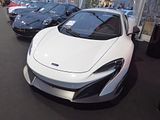
MERCEDES-BENZ
Launched in 1936, the 170V soon became Mercedes’ top-selling model, with over 75,000 made by 1939. Enough of the W136’s tooling survived Allied bombing during World War II (or could be recreated post-war) for it to serve as the foundation upon which the company could rebuild. By 1947 the model 170 V had resumed its place as Mercedes’ top-seller, a position it held until 1953. Most of the cars produced, and an even higher proportion of those that survive, were two or four door “Limousine” (saloon) bodied cars, but the range of different body types offered in the 1930s for the 170 V was unusually broad. A four-door “Cabrio-Limousine” combined the four doors of the four door “Limousine” with a full length foldaway canvas roof. Both the foor door bodies were also available adapted for taxi work, with large luggage racks at the back. There was a two-door two seater “Cabriolet A” and a two-door four seater “Cabriolet B” both with luggage storage behind the seats and beneath the storage location of the hood when folded (but without any external lid for accessing the luggage from outside the car). A common feature of the 170 V bodies was external storage of the spare wheel on the car’s rear panel. The two seater roadster featured a large flap behind the two seats with a thinly upholstered rear partition, and which could be used either as substantial luggage platform or as a very uncomfortable bench – the so-called mother-in-law’s seat. In addition to the wide range of passenger far bodied 170 Vs, a small commercial variant was offered, either as a flatbed truck or with a box-body on the back. Special versions of the 170 V were offered, adapted for use as ambulances or by the police, mountain rescue services and military. Production restarted in May 1946. The vehicles produced were versions of the 170 V, but in 1946 only 214 vehicles were produced and they were all light trucks or ambulances. Passenger car production resumed in July 1947, but volumes were still very low, with just 1,045 170 Vs produced that year. There was no return for the various open topped models from the 1930s. Customers for a Mercedes-Benz 170 V passenger car were restricted to the four door “Limousine” sedan/saloon bodied car. Production did ramp up during the next couple of years, and in 1949 170 V production returned to above 10,000 cars. From May 1949 the car, badged in this permutation as the Mercedes-Benz 170D, was offered with an exceptionally economical 38 PS diesel engine. The 170D was the world’s third diesel fuelled passenger car, and the first to be introduced after the war. A number of updates were made in 1950 and 1952, with more modern and more powerful engines among the changes, but with the appearance of the new Ponton bodied Mercedes-Benz 180 in 1953, the 170 models suddenly appeared very old fashioned. The 170 V was delisted in September 1953: in July 1953 the manufacturer had replaced the existing 170 S with the reduced specification 170 S-V. The car that resulted combined the slightly larger body from the 170 S with the less powerful 45 PS engine that had previously powered the 170 V. The vehicle provided reduced performance but at a reduced price, while salesmen steered more prosperous buyers to the new Ponton bodied 180. The diesel powered 170 S continued to be sold, now branded as the 170 S-D. The internal “W191” designation which had distinguished the previous 170 Ss was removed, and the 170 Ss manufactured from 1953 returned to the “W136” works designation that they had shared with the 170 V till the end of 1951. In September 1955 the last Mercedes-Benz W136, the Mercedes-Benz 170 S was withdrawn from production.
Known under development as the W198, the first iteration of the SL-Class grand tourer was the fastest production car of its day. Introduced in 1954 as a two-seat coupé with distinctive gull-wing doors, it was later offered as an open roadster. Built by Daimler-Benz AG, the direct fuel injected production model was based on the company’s highly successful yet somewhat less powerful carburettor overhead cam straight 6 1952 racer, the W194. The idea of a toned-down Grand Prix car tailored to affluent performance enthusiasts in the booming post-war American market was suggested by Max Hoffman. Mercedes accepted the gamble and the new 300 SL – 300 for its 3.0 litre engine displacement and SL for Sport Leicht (Sport Light) – was introduced at the 1954 New York Auto Show rather than the Frankfurt or Geneva gatherings company models made their usual debuts. Immediately successful and today iconic, the 300 SL stood alone with its distinctive doors, first-ever production fuel injection, and world’s fastest top speed. Even with the upward opening doors, the 300 SL had an unusually high sill, making entry and exit from the car’s cockpit problematic. A steering wheel with a tilt-away column was added to improve driver access. The 300 SL’s main body was steel, with aluminium bonnet, doors and boot lid. It could also be ordered with an 80 kg (180 lb) saving all-aluminium outer skin at tremendous added cost; just 29 were made. Like the W194, the 300 SL borrowed its 3.0 litre overhead cam straight-6 from the regular four-door 300 (W186 “Adenauer”) luxury tourer introduced in 1951. Featuring an innovative diagonal aluminium head that allowed for larger intake and exhaust valves, it was canted to the right at forty-five-degrees to fit under the SL’s considerably lower bonnet line. In place of the W194’s triple two-barrel Solex carburettors, a groundbreaking Bosch mechanical direct fuel injection was installed, boosting power almost 25% over the Grand Prix car’s. Derived from the DB 601 V12 used on the Messerschmitt Bf 109E fighter of World War II, it raised output from 175 hp to 215 hp, almost double that of the original Type 300 sedan’s 115 hp. An optional, even more powerful version, with radical camshaft developed 240 hp @ 6100 rpm and a maximum torque of 217 lb⋅ft @ 4800 rpm, but was rough for city use. The result was a top speed of up to 260 km/h (160 mph) depending on gear ratio and drag, making the 300 SL the fastest production car of its time. However, unlike today’s electrically powered fuel injection systems, the 300 SL’s mechanical fuel pump would continue to inject gasoline into the engine during the interval between shutting off the ignition and the engine’s coming to a stop; this unburned gasoline washed lubricating oil from the cylinder walls, which not only left them unprotected in affected areas during start-up but would dilute the engine’s entire oil supply if the car was not driven hard or long enough to reach a sufficient temperature to evaporate the fuel out of the oil. Exacerbating the problem was the engine’s large racing-oriented oil cooler and enormous 10 litre oil capacity, which virtually guaranteed the oil would not get hot enough. In practice, many owners would block off airflow through the oil cooler and stick rigidly to the appropriately low 1,000 mile recommended oil change interval. An auxiliary fuel pump provided additional fuel for extended high speed operation or cold starts; overuse would also lead to dilution of the oil., Clutch operation was initially very heavy, remedied by an improved clutch arm helper spring which reduced pedal force. From March 1963 to the end of production later that year, a light alloy crankcase was used on a total of 209 vehicles. Aerodynamics played an important role in the car’s speed, with Mercedes-Benz engineers placing horizontal “eyebrows” over the wheel openings to reduce drag. Unlike many cars of the 1950s, steering was relatively precise and the four-wheel independent suspension allowed for a reasonably comfortable ride and markedly better overall handling. However, the rear swing axle, jointed only at the differential, not at the wheels themselves, could be treacherous at high speeds or on imperfect roads due to extreme changes in camber. The enormous fuel tank capacity also caused a considerable difference in handling depending on the quantity of fuel on board. More than 80% of the vehicle’s total production of approximately 1400 units were sold in the US, making the Gullwing the first Mercedes-Benz widely successful outside its home market and thoroughly validating Hoffman’s prediction. The 300 SL is credited with changing the company’s image in America from a manufacturer of solid but staid luxury automobiles to one capable of rendering high-performance sports cars. It should be noted initial sales were sluggish due to many things, of which the price was one. Initial prices were about $6,400, a new Chevrolet Bel-Air could be purchased for $1,700 in the same year. Then there were few mechanics, even at the dealers, who understood the fuel injection system enough to do repairs. Nonetheless, 1400 were built by 1957, at which point Mercedes introduced a roadster version which was broadly similar, but with conventional doors. It was produced until 1963, and achieved sales of 1858 units.
Produced between May 1955 and February 1963, having first been seen in prototype at the 1954 New York Auto Show, the 190SL was designed as a more affordable sports car than the exclusive and rather pricey 300SL, sharing its basic styling, engineering, detailing, and fully independent suspension. While both cars had double wishbones in front and swing axles at the rear, the 190 SL did not use the 300 SL’s purpose-built W198 tubular spaceframe. Instead, it was built on a shortened monocoque R121 platform modified from the W120 saloon. The 190 SL was powered by a new, slightly oversquare 105 PS Type M121 1.9 litre four cylinder engine. Based on the 300 SL’s straight six, it had an unchanged 85 mm bore and 4.3 mm reduced 83.6 mm stroke, was fitted with twin-choke dual Solex carburettors, and produced 120 gross hp. In detuned form, it was later used in the W120 180 and W121 190 models. Both the 190 SL and the 300 SL were replaced by the Mercedes-Benz 230SL in 1963.
Chronologically, next up was a W111 “FinTail”, the staple of the Benz range through the early 1960s. Mercedes-Benz had emerged from World War II in the early 1950s with the expensive 300 Adenauers and the exclusive 300SL grand tourers that gained it fame, but it was the simple unibody Pontons which comprised the bulk of the company’s revenues. Work on replacing these cars began in 1956 with a design focused on passenger comfort and safety. The basic Ponton cabin was widened and squared off, with a large glass greenhouse improving driver visibility. A milestone in car design were front and rear crumple zones for absorbing kinetic energy on impact. The automaker also patented retractable seatbelts. Series production of the first of the new cars, the W111 4-door sedan began in August 1959, with the car making its debut at the Frankfurt Auto Show in autumn. Initially the series consisted of the 220b, 220Sb, and 220SEb. These replaced the 219 W105, the 220S W180 and the 220SE W128 Ponton sedans respectively. The 220b was an entry-level version with little chrome trim, simple hubcaps, and basic interior trim that lacked pockets on doors. Prices were DM16,750, 18,500 and 20,500, with a rough sales ratio of 1:2:1. All modes shared the 2195 cc straight-six engine carried over from the previous generation, producing 95 hp and capable of accelerating the heavy car to 160 km/h. The 220Sb featured twin carburettors and produced 110 hp raising top speed to 103 mph and improving 0–100 km/h acceleration to 15 seconds. The top range 220SEb featured Bosch fuel injection producing 120 hp at 4800 rpm, with top speed of 107 mph and a 0–100 km/h in 14 seconds. In 1961, the W111 chassis and body were shared with the even more basic 4-cylinder W110 and a luxury version built on the W111 chassis with its body and the 3-litre M189 big block 6-cylinder engine, many standard power features, and a high level of interior and exterior trim, was designated the W112. A 2-door coupe/cabriolet version of the W111/W112 was also produced. In summer 1965, the new Mercedes-Benz W108 sedan was launched and production of the first generation of W111’s was ended. Totals were: 220b – 69,691, 220Sb – 161,119, and 220SEb – 65,886. Earlier that year, Mercedes-Benz gave its budget-range W110 series a major facelift, opting to continue producing the W111 as a new model 230S. The previously 4-cylinder W110 received a 6-cylinder, practically identical in terms of chassis and drivetrain. In 1965 the W110 was equipped with a six-cylinder engine, creating the model 230. The 230S, became a flagship model of the Mercedes passenger cars (predecessors to today’s S-class). The 230S was visually identical to the 220S, with a modernised 2306 cc M180 engine with twin Zenith carburettors producing 120 hp.In this final configuration a total of 41,107 cars were built up to January 1968, when the last of 4-door fintails left the production line. Between 1959 and 1968 a total of 337,803 W111s were built.
Most imposing was this example of the 600 model, a high-end large luxury sedan and limousine produced by Mercedes-Benz from 1963 to 1981. Generally, the short-wheel-base (SWB) models were designed to be owner-driven, the long-wheel-base (LWB), often incorporating a central divider with power window, by a chauffeur. The forerunner of the modern Maybach marque, the 600 “Grosser Mercedes” (“Grand Mercedes”) succeeded the Type 300 “Adenauer” as the company’s flagship and most expensive model. Positioned well above the 300-series Mercedes-Benz W112. Its few competitors included certain models of Rolls-Royce and Bentley, the Cadillac Fleetwood 75, stretched Lincoln Continental Lehmann-Peterson, and the Chrysler Imperial Crown Ghia. The 600 marked the last super-luxury model the brand produced in an unbroken line with its demise in 1981 since the model 60 hp Simplex from 1903. The 600 came in two main variants: a short wheelbase 4-door sedan, available with a power divider window separating the front seats from the rear bench seat, although most were built without this feature; along wheelbase 4-door Pullman limousine (with two additional rear-facing seats separated from the driver compartment by a power divider window, of which 304 were built), and a 6-door limousine (with two forward-facing jump-seats at the middle two doors and a rear bench-seat). A number of the Pullman limousines were made as landaulets, with a convertible top over the rear passenger compartment. Two versions of the convertible roof were made- long roof, and short roof. Of them, the short roof, which opens only above the last, third row of seats, is the more common version. Rarer, especially by the 6 door Landaulets, is the long roof, called- Presidential Roof. In all, 59 Pullman Landaulets were produced, and of them, only 26 were 6 door landaulets. And of these 26, only very few- 9, were 6 doors Landaulets with the long Presidential type opening roof. One of these 9 cars was used by the former Yugoslavian president Josip Broz Tito. Landaulets like these were notably used also by the German government, as during the 1965 state visit of Queen Elizabeth II. Also the Vatican, in addition to a elongated Mercedes 300 type D, 4 door convertible, have used for the Pope, specially ordered 4 door Pullman Convertible, which now resides in the Mercedes Benz Factory Museum. Production of the Landaulet versions of 600 model, ended in 1980. Mercedes also made two coupés, one as a gift for retiring long-time Mercedes chief designer Rudolf Uhlenhaut, and the other to Fritz Nallinger. head of Research and development centre of Mercedes in the 50s and 60s. These cars had a wheelbase 22 cm (8.6 inches) shorter than the SWB sedan. A third was much later constructed by 600 experts and restorers Karl Middelhauve & Associates of Wausau, Wisconsin from a SWB sedan. Karl Middelhauve has also created a pair of matching Chevrolet El Camino-style coupes from 600 SWB sedans. One of them has a Vortech supercharger. Some purists question the reason for modifying a classic such as an original 600 into a modified vehicle, while other purists think Karl is extending function in the true spirit of the “Grosser” Mercedes. A single example of a SWB 4-door landaulet, combining the handling of a short-wheelbase with the qualities of a landaulet, was built by Mercedes in 1967 for former racing driver Count von Berckheim. The 600’s great size, weight, and numerous hydraulically driven amenities required more power than Mercedes’ largest engine at that time, the 3-litre 6-cylinder M189, could produce. A new V8 with more than twice the capacity was developed, the 6.3 L M100. It featured single overhead camshafts (SOHC) and Bosch mechanical fuel injection. It developed 300 Hp, however the total usable output was 250 Hp as 50 Hp was used to power the hydraulic convenience system. The 600’s complex 150-bar (2,176 psi) hydraulic pressure system powered the automobile’s windows, seats, sun-roof, boot lid, and automatically closing doors. Adjustable air suspension delivered excellent ride quality and sure handling over any road surface. Production began in 1964 and continued through to 1981. During this time, production totalled 2,677 units, comprising 2,190 Saloons, 304 Pullmans, 124 6-door Pullmans and 59 Landaulets.
The Mercedes range of the 1960s was quite complex, with body styles and mechanical updates proceeding at a different rate, and even by referring to the cars by their internal development codes (the “W” number), they are still quite hard to define unambiguously. In the W111 family, the Coupe was the first to appear, a replacement for the two-door W120 “Ponton” models, and work on it began in 1957. Since most of the chassis and drivetrain were to be unified with the sedan, the scope was focused on the exterior styling. Some of the mockups and prototypes show that Mercedes-Benz attempted to give the two-door car a front styling almost identical to what would be realised in the Pagoda (W113), but ultimately favoured the work of engineer Paul Bracq. The rear featured small tailfins, subtle compared to the fintails’ and evocative of the later squarish styling of the W108/W109. Production began in late 1960, with the coupe making its debut at the 75th anniversary of the opening of Mercedes-Benz Museum in Stuttgart in February of the next year. The convertible followed at the Frankfurt Auto Show a few months later. Almost identical to the coupe, its soft-top roof folded into a recess behind the rear seat and was covered by a tightly fitting leather “boot” in the same colour as the seats. Unlike the previous generation of two-door ponton series, the 220SE designation was used for both the coupe and convertible; both received the same version of the 2195 cc M127 engine. Options included a sliding sunroof for the coupe, automatic transmission, power steering, and individual rear seats. In March 1962, Mercedes-Benz released the exclusive two-door M189-powered 300SE. Like the 300 sedan, it was based on the W111 chasis but shared both Daimler’s top-range 2996 cc fuel-injected engine and the unique W112 chassis designation, efforts on Mercedes’ part to distance it from the maker’s modest W110 and W111 lineups and link it to the prestigious W188 300S two-door luxury sports tourer. It was distinguished by a chrome strip, and featured air suspension and a higher level of interior trim and finish. In summer of 1965, Mercedes-Benz launched replacements for both W111 and W112 sedans, the W108 and W109 respectively. With the tailfin fashion well eroded by the mid 1960s, the new design was based on the restrained W111 coupe, widened and squared off. Work on a future new chassis that would fully replace the Ponton-derived W111/W112 and W108/W109 was well under way. With a concept car of the first S-Class shown in 1967, Daimler declined to develop a two-door W108/W109 vehicle, instead continuing production of the aging W111/W112 with modest changes. The 220SE was superseded in early autumn 1965 by the 250SE, which featured the new 2496cc M129 engine. Producing 150 hp. it gave the vehicle a significant improvement in top speed, to 120 mph. Visibly the only changes affected the new 14-inch rims, which came with new hub cabs and beauty rings accommodating the larger disk brakes and new rear axle from the W108 family. In November 1967 the 250 SE was superseded by the 280 SE. It was powered by the new 2778 cc M130 engine, which produced 160 hp. The top speed was hardly affected, but acceleration improved to 10.5 seconds. Inside the car received a wood veneer option on the dashboard and other minor changes, including door lock buttons and different heater levers. The hubcaps were changed yet again to a new one piece wheelcover, and the exterior mirror was changed. Despite its smaller engine, the 280 SE could outperform the early 1950s M189 powered 300 SE, resulting in the more expensive model’s retirement. The coupe and cabriolet retained their shared model model designation until replaced by a new-generation chassis in 1968. A final model was added in August 1969, the 280 SE 3.5. The car was fitted with the brand-new M116 3499 cc V8. It produced 200 hp, and had a top speed of 130 mph and a 0-100 km/h at 9.5 seconds. To accommodate the large engine, the car’s front grille was widened; front and rear bumpers were also modified with the addition of rubber strips. The rear lenses changed to a flatter cleaner design. This change was carried across the standard 280 SE. As the top of its range, the 280 SE 3.5 is seen as an ideological successor to the W112 300 SE, though it lacked the W112’s air suspension. The last 280 SE was produced in January 1971, with the 280 SE 3.5 ending in July. The total production over the decade was: 220 SEb – 16,902, 250 SE – 6,213, 280 SE – 5,187, and 280 SE 3.5 – 4,502 units. Not including 3,127 W112 300 SE models, the grand total of 2-door W111 models was 32,804 of which 7,456 were convertibles. These days the cars are much sought after and prices, especially for the convertible, are high and still rising.
Sometimes known as the “New Generation”, to distinguish it from predecessor with the same model names, this is an example of the W114/115 range of cars that Mercedes introduced in 1968, which were produced until 1976 when they were replaced by the W123 range. W114 models featured six-cylinder engines and were marketed as the 230, 250, and 280, while W115 models featured four-cylinder engines and were marketed as the 200, 220, 230, and 240. All were styled by Paul Bracq, featuring a three-box design. At the time, Mercedes marketed saloons in two size classes, with the W114/W115, positioned below the Mercedes-Benz S-Class. The W114/W115 models were the first post-war Mercedes-Benz production car to use a newly engineered chassis, not derived from preceding models. The new chassis format of semi-trailing rear arms and ball-joint front end first displayed in the W114/W115 chassis would be used in all new Mercedes passenger car models until the development of the multi-link rear suspensions of the 1980s. The W108/109 S-Class chassis of the 280S/8, 280SE/8 and 300SEL/8 (and W113 280SL Pagoda) would be the last of the low-pivot swing axle and king pin/double wishbone front ends. The next S-Class -the W116 chassis- having the same engineering of the W114/115. Mercedes introduced a coupé variant of the W114 in 1969, featuring a longer boot and available with either a 2.5 or 2.8 litre six-cylinder engine. While a classic and understated design these generally cost less than the W113-based 280 SL model that ran through 1971, and its successor, the 3.5 or 4.5 litre V8 Mercedes SL R107/C107 (1971–1989) roadster and coupé. While a ‘hard-top’ unlike the fully convertible SL, the pillarless design allowed all the windows to be lowered completely for open air motoring. Only 67,048 coupés were manufactured from 1969 to 1976 (vs. 1.852,008 saloons). Of these 24,669 were 280C and 280CE (top of the range), and 42,379 were the lesser 250C and 250CE (A Mercedes-Benz 220D pickup on the W115 chassis was produced briefly in Argentina in the 1970s.) The W114 received a facelift in 1973 – with a lower bonnet-line, lower and broader grill, a single front bumper to replace the double bumpers, lower placement of the headlamps, A-pillar treatment for keeping the side windows clear, removal of the quarter-windows in the front doors, ribbed tail lights to minimise occlusion of the tail lights with road dirt, and larger side mirrors. The interior received inertia reel belts and a new padded steering wheel with a four-hole design. These cars were known to be extremely durable and tough, so the survival rate is quite great, especially in Germany, where they are popular classics.
First Mercedes that we think of as the S Class was the W116, which was launched in 1972. Development began in 1966, which was only a year after the launch of the W108/09. This was the first Mercedes saloon to feature the brand new corporate styling theme which was to be continued until 1993 when the 190 was discontinued. The design, finalised in December 1969 was a dramatic leap forward, with more masculine lines that combined to create an elegant and sporty character. The basic design concept carried through the themes originally introduced on the R107 SL-Class roadster, especially the front and rear lights. As for the SL, the W116 received the ridged lamp covers which kept dirt accumulation at bay; this was to remain a Mercedes-Benz design theme into the 21st century. The W116 was Friedrich Geiger’s last design for Mercedes-Benz; his career had started with the Mercedes-Benz 500K in 1933. The car was presented in September 1972. The model range initially included two versions of the M110 straight-six with 2746 cc — the 280 S (using a Solex carburetor) and the 280 SE (using Bosch D-Jetronic injection), plus the 350 SE, powered by the M116 engine (V8 with 3499). After the 1973 Fuel Crisis, a long-wheelbase version of the 280 was added to the lineup. Six month later, two new models powered by the M117 engine (V8 with 4520 cc) were added to the range—the 450 SE and the 450 SEL (with a 100 mm longer body). The 450 had 225 PS in most markets, federalised cars offered 190 hp while Swedish market cars had an EGR-valve and 200 PS until 1976. The 450s received a plusher interior as well, with velour or leather seats rather than the checkered cloth of the lesser models. The door insides were also of a different design, being pulled up around the windows. The most notable W116 was the high-performance, limited-production 450 SEL 6.9, which was introduced in 1975. This model boasted by far the largest engine installed in a post-war Mercedes-Benz (and any non-American production automobile) up to that time, and also featured self-levelling hydropneumatic suspension. The 450 SE was named the European Car of the Year in 1974, even though the W116 range was first introduced at the Paris Motor Show in the autumn 1972.. The W116 range became the first production car to use an electronic four-wheel multi-channel anti-lock braking system (ABS) from Bosch as an option from 1978 on. Production reached 473,035 units. The W116 was succeeded by the W126 S-Class in 1979.
Mercedes-Benz introduced the W123 four-door versions on 29 January 1976. While there were some technical similarities to their predecessors, the new models were larger in wheelbase and exterior dimensions. The styling was also updated, although stylistic links with the W114 / W115 were maintained. Initially, all models except 280/280E featured quad unequal-size round headlights and the latter large rectangular units. When facelifted, these units became standard across the range. All W115 engines were carried over, with the 3-litre 5-cylinder diesel model being renamed from “240D 3.0” to “300D” (as it had already been called before in North American markets). The only new engine was the 250’s 2,525 cc inline-six (Type M123, a short-stroke version of the 2.8-litre six Type M110) that replaced the old 2,496 cc Type M114 “six”. In the spring of 1976, a Coupé version was introduced on a shorter wheelbase than the saloon (106.7 in versus 110.0 in. This W123C/CE was available as a 230C (later 230CE) and as a 280C/CE in most markets; in North America there were additional 300CD versions with naturally aspirated, later turbocharged 3-litre diesel engines. In North America, buyers favored diesel engines for upmarket cars, while CAFE legislation meant that Mercedes-Benz North America had to lower their corporate average fuel economy. This led to the introduction of a few diesel models only sold in the United States. It is a tribute to the car’s instant popularity – and possibly to the caution built into the production schedules – that nine months after its introduction, a black market had developed in Germany for Mercedes-Benz W123s available for immediate delivery. Customers willing to order new cars from their local authorised dealer for the recommended list price faced waiting times in excess of twelve months. Meanwhile, models that were barely used and were available almost immediately commanded a premium over the new price of around DM 5,000. From August 1976, long-wheelbase versions (134.8 in) were produced. These were available as 7/8 seater saloons with works bodies or as a chassis with complete front body clip, the latter serving as the base for ambulance and hearse bodies by external suppliers like Binz or Miesen. These “Lang” versions could be ordered as 240D, 300D and 250 models. At the Frankfurt Auto Show in September, 1977 the W123T estate was introduced; the T in the model designation stood for “Touring and Transport”. All engines derivative except “200TD” were available in the range. T production began in March, 1978 in Mercedes’ Bremen factory. It was the first factory-built Mercedes-Benz estate, previous estates had been custom-built by external coachbuilders, such as Binz. In early 1979, the diesel models’ power output was increased; power rose from 54 hp to 59 hp in the 200D, from 64 hp to 71 hp in the 240D and from 79 hp to 87 hp in the 300D; at the same time, the 220D went out of production. The first Mercedes turbo diesel production W123 appeared in September, 1981. This was the 300 TD Turbodiesel, available with automatic transmission only. In most markets, the turbocharged 5-cylinder 3-litre diesel engine (Type OM617.95) was offered only in the T body style, while in North America it was also available in saloon and coupé guises. June 1980 saw the introduction of new four-cylinder petrol engines (Type M102). A new 2-litre four with shorter stroke replaced the old M115, a fuel-injected 2.3-litre version of this engine (in 230E/TE/CE) the old carburettor 230. Both engines were more powerful than their predecessors. In 1980/81, the carburettor 280 versions went out of production; the fuel-injected 280E continued to be offered. In September 1982, all models received a mild facelift. The rectangular headlights, previously fitted only to the 280/280E, were standardised across the board, as was power steering. Since February 1982, an optional five-speed manual transmission was available in all models (except the automatic-only 300 turbodiesel). W123 production ended in January, 1986 with 63 final T-models rolling out. Most popular single models were the 240D (455,000 built), the 230E (442,000 built), and the 200D (378,000 built). The W123 introduced innovations including ABS (optional from August, 1980), a retractable steering column and an airbag for the driver (optional from 1982). Power (vacuum servo) assisted disc brakes were standard on all W123s. Available options included MB-Tex (Mercedes-Benz Texturized Punctured Vinyl) upholstery or velour or leather upholstery, interior wood trim, passenger side exterior mirror (standard on T models), 5-speed manual transmission (European market only), 4-speed automatic transmission (standard in turbodiesel models), power windows with rear-seat switch cut-outs, vacuum powered central locking, rear-facing extra seats (estate only), Standheizung (prestart timer-controlled engine heating), self-locking differential, sun roof, air conditioning, climate control, “Alpine” horn (selectable quieter horn), headlamp wipers (European market only), Tempomat (cruise control), power steering (standard after 1982/08), seat heating, catalytic converter (available from 1984 for California only, from fall (autumn) 1984 also in Germany for the 230E of which one thousand were built). These days, the cars are very popular “youngtimer” classics, with all models highly rated.
It is quite sobering to realise that the W201 is now almost a 40 year old design. Mercedes spent over £600 million researching and developing the 190 and subsequently said it was ‘massively over-engineered’. It marked a new venture for Mercedes-Benz, finally giving it a new smaller model to compete with the likes of the BMW 3 Series. The W201-based 190 was introduced in November 1982, and was sold in right-hand drive for the UK market from September 1983. Local red tape in Bremen (which produced commercial vehicles at the time) prevented Daimler-Benz from building the 190 there, so production was started in Sindelfingen at a capacity of just 140,000 units per year. Eventually after just the first year, Bremen was cleared for production of the 190, replacing its commercial vehicle lines, and there the 190 was built with the first running modifications since release. Initially there were just two models, the 190 and 190 E. Each was fitted with an M102 1,997 cc displacement engine. The 190 was fitted with an M102.921 90 hp engine and the 190 E fitted with an M102.962 122 hp engine. In September 1983, the 190 E 2.3 (2,299 cc) was released for the North American market only (although a 190 E 2.3 appeared in other countries later), fitted with a 113 hp M102.961 engine. This reduction in power was due to the emissions standards in the North American market at the time. The intake manifold, camshaft, and fuel injection system were refined in 1984, and the engine produced 122 hp. The carburettor 190 was revised in 1984 as well, increasing its horsepower rating to 105 hp. 1984 also saw the arrival of the 2.3-16 “Cosworth.” In 1985, the 190 E 2.3 now came fitted with the M102.985 engine, producing 130 hp until it was revised in 1987 to use Bosch KE3-Jetronic Injection, a different ignition system, and a higher compression ratio, producing 136 hp. 1987 marked the arrival of the first inline-six equipped 190, the 190 E 2.6. Fitted with the M103.940 engine, the 190 E 2.6 provided 160 hp with a catalyst and 164 hp without. In the North American market, the 190 E 2.6 was sold until 1993, the end of the W201 chassis’s production. From 1992-1993 the 2.6 was available as a special “Sportline” model, with an upgraded suspension and interior. The 190 E 2.3 was sold until 1988, then went on a brief hiatus until it was sold again from 1991 until 1993. The W201 190 D is known for its extreme reliability and ruggedness with many examples doing more than 500,000 miles without any major work. The 190 D was available in three different engines. The 2.0 was the baseline, and was never marketed in North America. The 2.2, with the same power as the 2.0, was introduced in September 1983. It was only available in model years 1984 and 1985, and only in the USA and Canada. The 2.5 was available in the late 80’s and early 90’s. The 2.5 Turbo, while sold in mainland Europe, but not the UK for many years, was available to American buyers only in 1987 and is now somewhat of a collectors item. The exterior of the 2.5 Turbo is different from other models in that it has fender vents in the front passenger side wing for the turbo to breathe. Although the early cars were very basic and not very powerful, they sold strongly, and things only got better as the model evolved, with the result that over 1.8 million had been produced by the time the W202 model arrived in 2002 to replace it.
At the 1999 North American International Auto Show, Mercedes-Benz presented their Vision SLR concept, inspired both by the Mercedes-Benz 300 SLR Uhlenhaut Coupé of 1955, which was a modified Mercedes-Benz W196S race car, and the design of closed-wheel Formula One cars, a field in which Mercedes had prior experience, as Mercedes-Benz were already designing and developing powertrains and electronics for McLaren’s Formula One Team. The car was presented as “Tomorrow Silver Arrow” in a clear reference to the Silver Arrows of the golden age of Mercedes in competition during the fifties. Later that year, during the Frankfurt Motor Show, a roadster version of the SLR concept was presented. The concept car was fitted with a 5.0-litre supercharged AMG V8 engine able to generate a power output of 565 PS (557 bhp) and 720 Nm (531 lb/ft) of torque at 4,000 rpm, mated to a 5-speed automatic gearbox with Touchshift control. Wanting to bring the concept to production following its positive reception, Mercedes joined forces with their Formula One partner, McLaren, thus creating the Mercedes-Benz SLR McLaren. The production version of the car was unveiled to the general public on 17 November 2003 having some minor design adjustments in respect of the initial design. The adjustments included more complex vents on both sides of the car, a redesigned front with the three pointed star plunged in the nose and red tinted rear lights. A new version of the SLR was introduced in 2006, called the Mercedes-Benz SLR McLaren 722 Edition. The “722” refers to the victory by Stirling Moss and his co-driver Denis Jenkinson in a Mercedes-Benz 300 SLR with the starting number 722 (indicating a start time of 7:22 a.m.) at the Mille Miglia in 1955. The “722 Edition” includes a modified version of the engine used in the SLR generating a power output of 650 PS (641 bhp) at 6,500 rpm and 820 Nm (605 lb/ft) at 4,000 rpm. 19-inch light-alloy wheels were used to reduce unsprung mass, while modifications were also made to the suspension, with a stiffer damper setup and 10 mm (0.39 in) lower ride height introduced for improved handling. Larger 15.4 in diameter front brakes and a revised front air dam and rear diffuser were fitted. Other exterior changes include red “722” badging, harking back to the original 722 racer, black tinted tail lights and headlamps. The interior has carbon fibre trim and black leather upholstery combined with Alcantara. The Mercedes-Benz SLR McLaren saw a production run of over six years. On 4 April 2008, Mercedes announced it would discontinue the SLR. The last of the coupés rolled off the production line at the end of 2009 and the roadster version was dropped in early 2010. A total of 2,157 cars were produced, rather less than the 3500 production ceiling which Mercedes initially announced. The car had a mixed reception even when new, but now it is for sure a classic.
By 1955, Mercedes-Benz Technical Director Prof. Fritz Nallinger and his team held no illusions regarding the 190 SL’s lack of performance, while the high price tag of the legendary 300 SL supercar kept it elusive for all but the most affluent buyers. Thus Mercedes-Benz started evolving the 190 SL on a new platform, model code W127, with a fuel-injected 2.2 litre M127 inline-six engine, internally denoted as 220SL. Encouraged by positive test results, Nallinger proposed that the 220SL be placed in the Mercedes-Benz program, with production commencing in July 1957. However, while technical difficulties kept postponing the production start of the W127, the emerging new S-Class W112 platform introduced novel body manufacturing technology altogether. So in 1960, Nallinger eventually proposed to develop a completely new 220SL design, based on the “fintail” W 111 sedan platform with its chassis shortened by 11.8 in, and technology from the W112. This led to the W113 platform, with an improved fuel-injected 2.3 litre M127 inline-six engine and the distinctive “pagoda” hardtop roof, designated as 230 SL. The 230 SL made its debut at the prestigious Geneva Motor Show in March 1963, where Nallinger introduced it as follows: “It was our aim to create a very safe and fast sports car with high performance, which despite its sports characteristics, provides a very high degree of travelling comfort”. The W113 was the first sports car with a “safety body,” based on Bela Barényi’s extensive work on vehicle safety: It had a rigid passenger cell and designated crumple zones with impact-absorbing front and rear sections built into the vehicle structure. The interior was “rounded,” with all hard corners and edges removed, as in the W111 sedan. Production of the 230 SL commenced in June 1963 and ended on 5 January 1967. Its chassis was based on the W 111 sedan platform, with a reduced wheelbase by 11.8 in, recirculating ball steering (with optional power steering), double wishbone front suspension and an independent single-joint, low-pivot swing rear-axle with transverse compensator spring. The dual-circuit brake system had front disc brakes and power-assisted rear drum brakes. The 230 SL was offered with a 4-speed manual transmission, or an optional, very responsive fluid coupled (no torque converter) 4-speed automatic transmission, which was popular for US models. From May 1966, the ZF S5-20 5-speed manual transmission was available as an additional option, which was particularly popular in Italy. The 2,308 cc M127.II inline-six engine with 150 hp and 145 lb/ft torque was based on Mercedes-Benz’ venerable M180 inline-six with four main bearings and mechanical Bosch multi-port fuel injection. Mercedes-Benz made a number of modifications to boost its power, including increasing displacement from 2,197 cc, and using a completely new cylinder head with a higher compression ratio (9.3 vs. 8.7), enlarged valves and a modified camshaft. A fuel injection pump with six plungers instead of two was fitted, which allowed placing the nozzles in the cylinder head and “shooting” the fuel through the intake manifold and open valves directly into the combustion chambers. An optional oil-water heat exchanger was also available. Of the 19,831 230 SLs produced, less than a quarter were sold in the US. Looking identical, the 250 SL was introduced at the 1967 Geneva Motor Show. Production had already commenced in December 1966 and ended in January 1968. The short one-year production run makes the 250 SL the rarest of the W113 series cars. The 250 SL retained the stiffer suspension and sportier feel of the early SLs, but provided improved agility with a new engine and rear disc brakes. Range also improved with increased fuel tank capacity from 65 litres to 82. Like its predecessor, the 250 SL was offered with a 4-speed automatic transmission, and 4-speed or ZF 5-speed manual transmissions. For the first time, an optional limited slip differential was also available. The main change was the use of the 2,496 cc M129.II engine with a larger stroke, increased valve ports, and seven main bearings instead of four. The nominal maximum power remained unchanged at 150 hp, but torque improved from 145 lb/ft to 159 lb/ft. Resiliency also improved with a new cooling water tank (“round top”) with increased capacity and a standard oil-water heat exchanger. The 250 SL also marked the introduction of a 2+2 body style, the so-called “California Coupé”, which had only the removable hardtop and no soft-top: a small fold-down rear bench seat replaced the soft-top well between passenger compartment and boot. It is estimated that only 10% of the 250SLs that were brought into America were California Coupes. Of the 5,196 250 SLs produced, more than a third were sold in the US.The 280 SL was introduced in December 1967 and continued in production through 23 February 1971, when the W 113 was replaced by its successor, the entirely new and substantially heavier R107 350 SL. The main change was an upgrade to the 2,778 cc M130 engine with 170 hp and 180 lb/ft, which finally gave the W 113 adequate power. The performance improvement was achieved by increasing bore by 4.5 mm (0.2 in), which stretched the limits of the M180 block, and required pairwise cylinder casts without cooling water passages. This mandated an oil-cooler, which was fitted vertically next to the radiator. Each engine was now bench-tested for two hours prior to being fitted, so their power specification was guaranteed at last. The M130 marked the final evolution of Mercedes-Benz’ venerable SOHC M180 inline-six, before it was superseded by the entirely new DOHC M110 inline-six introduced with R107 1974 European 280 SL models. For some time, it was also used in the W 109 300 S-Class, where it retired the expensive 3 liter M189 alloy inline-six. Over the years, the W 113 evolved from a sports car into a comfortable grand tourer, and US models were by then usually equipped with the 4-speed automatic transmission and air conditioning. Manual transmission models came with the standard 4-speed or the optional ZF 5-speed, which was ordered only 882 times and thus is a highly sought-after original option today. In Europe, manual transmissions without air conditioning were still the predominant choice. Of the 23,885 280 SLs produced, more than half were sold in the US.
Contrasting with this on the Mercedes-Benz Italia stand was the very latest SL. I know which appeals more to me!
There were also a couple of examples of the go-anywhere Unimog here.
MG
Whilst the TC, the first postwar MG and launched in 1945, was quite similar to the pre-war TB, sharing the same 1,250 cc pushrod-OHV engine, it had a slightly higher compression ratio of 7.4:1 giving 54.5 bhp at 5200 rpm. The makers also provided several alternative stages of tuning for “specific purposes”. It was exported to the United States, even though only ever built in right-hand drive. The export version had slightly smaller US specification sealed-beam headlights and larger twin rear lights, as well as turn signals and chrome-plated front and rear bumpers. The body of the TC was approximately 4 inches wider than the TB measured at the rear of the doors to give more cockpit space. The overall car width remained the same resulting in narrower running boards with two tread strips as opposed to the previous three. The tachometer was directly in front of the driver, while the speedometer was on the other side of the dash in front of the passenger. 10,001 TCs were produced, from September 1945 to Nov. 1949, more than any previous MG model. It cost £527 on the home market in 1947.
MINI
As well as the Innocenti-built version of the classic Mini there was this one here.
MISC
MORETTI
This is a 1954 Moretti 750 Le Cap. The Moretti manufacturing company was founded in 1920 in Turin by Giovanni Moretti, initially as a manufacturer of racing motorcars and motorbikes. At the end of the 1920s, the young man designed and built his first car, a small car with a modest displacement, 500 cc, with rear-wheel drive and homologated 3-seater open bodywork. During the Second World War, due to the shortage of fuel, Moretti came up with the idea of producing a truck equipped with electric propulsion, the Elettrocarro, from which the electric car was born. In 1946, the ‘Cita’, which in Turin dialect means ‘small’, was put on the market; after a short time, the 500 cc capacity was increased to 600 cc, from which the 750 twin-shaft was derived, allowing these cars to take part in important races such as the Mille Miglia and 24 Hours Le Mans. In 1951, two great enthusiasts, Veglia and Butti, on board two Moretti 750s took part in the 1st Algiers – Cape Town Rally, totalling 16,000 km across the continent, finishing 1st and 2nd in their category on arrival in South Africa’s capital city. It was this important milestone that enabled the manufacturer to enjoy an excellent reputation internationally, garnering particular interest from the US market, especially for small sports cars that excelled on both local circuits and international races. A year after the Algiers Rally, in 1952, the Piccoli – Albiero crew aboard the Moretti 750 Giardinetta set off on a round-the-world trip, covering an impressive 120,000 km in three years, crossing five continents, putting the mechanics to the test, which successfully completed this challenge by breaking the world distance record. The name Le Cap derives from the incredible race of two pilots who in 1951 won the 1st Algiers Rally – Cape Town, covering 16,000 kilometers aboard this little Moretti, across Africa. Later, to celebrate its success, the House renamed it with the name of the race. This Moretti 750 is a rare car in itself, but it is even more so if you know its history, rather out of the ordinary. For a start, this car was the protagonist of the 1954 Turin Car Show, where it was displayed at the Moretti stand. Purchased by the first owner, it was driven for only four years because the owner passed away, the car has therefore remained unused under a canopy of a villa in Como, Italy; it is said that the heirs at the time planned of making extensions to the house and it is said that our protagonist, hidden under a cloth, was unintentionally bricked up and never used for 50 years. This is said to be 1 of 5 pre-series cars: compared to the later cars, which were produced in a batch of just 200 units, this version is different because of some details that only the experts of this model can notice, including a wider front grill with a different frieze, aluminum steering box, flat taillights, 4 holes rims instead of 5 and an engine producing 30 hp compared to 27 hp of later cars. To date, no more than four to five cars in the world have been recorded. The discovery was made 4 years ago when it was reported to a collector and lover of unique pieces, who undertook a significant restoration while respecting the car’s originality. It is exciting to know that this car was the protagonist at the Turin Motor Show, and the story is even more singular considering the fact that the conflicts were already over, because when it was sold in 1954, the owner of the car used it very little, as he died just four years after its purchase and it remained unused under a canopy in a villa in Como; the heirs at the time thought of making extensions to the house and the story goes that our protagonist, hidden under a tarpaulin, was unintentionally bricked up and never used again for 50 years. The discovery took place four years ago when the heirs of the house decided to sell it and during a survey of the interior furnishings by an antiques dealer, the latter discovered the specimen and pointed it out to a collector and lover of unique pieces, who undertook significant restoration work, given the long period of inactivity, respecting the car’s originality; the result: a great masterpiece.
Based on the regular Fiat 600D, the Fiat 600D Spider Moretti was designed by Giovanni Michelotti and unveiled at the 1961 Turin Auto Show. Moretti employed the same stylistic system and most of the same equipment to create the coupé and sedan variants as well.
The Fiat 128 Coupé Moretti was built in the factory in via Monginevro in a semi-handmade way (these custom-built they were not assembled on a production life) and in a very limited number of specimens. The 128 Moretti Coupé had an elegant and aggressive line designed by Dany Brawand and gave the impression of a much larger displacement than the actual 1,100 cc one. The performance was decent, similar to the FIAT model from which it derived, the habitability was good for four people and enough for five and the luggage compartment was large.
NECKAR
The NSU/Fiat Weinsberg 500 (1960 Neckar Weinsberg 500 ) is a Fiat automobile. It was produced in two versions (Limousette and Coupé) based on the Fiat 500 (1957–1975). Like the Neckar Pully, the Weinsberg was the creation of NSU/FIAT Karosseriewerke Weinsberg, made possible because NSU/FIAT in Heilbronn also had its own development department, in which designers such as Antonio Fessia worked. Introduced in March 1959 as the NSU/Fiat, 6,228 vehicles were manufactured from 1959 to 1963. The price was 3,840 DM in 1959, 3620DM in 1962. Two Weinsberg versions were sold at 3,840 DM (including heater and sunroof, whitewall tires were an extra 50 DM) – the Coupe and the Limousette. They differ only in the rear window design: The coupé features a wraparound panoramic rear screen, allowing only enough headroom above the rear seat for small children (up to about 7 years old). The Limousette has rear side windows and a steeper, conventional rear window like a small sedan, hence the name. This gives the Limousette a little more headroom than the coupe, but less than a Fiat 500 Nuova. Both Weinsberg models are basically two-seaters with additional space for two children or luggage. Despite having an inviting padded rear seat, it is not practical for adults. The German tire used in the Weinsberg is 4.40×12” size rather than the 125 x 12 of the normal Fiat 500, indicating that the Weinsberg was regarded as a two-seater; the utmost load capacity was slightly less than the slightly wider 125 – 12. In contrast to Autobianchi Bianchina, both Weinsberg versions were built from partially assembled car bodies with modifications to both front and rear panels. The front bonnet is higher, as is the wing profile, with finned rear wings and with rear lights that are unique to the Weinsberg. The cars benefited from some equipment upgrades in character with a luxury version: a sunroof instead of a folding roof, bug ornament, special bumpers, standard two-tone colour and wheel covers, ashtray in the dashboard, better upholstery fabrics and wide pockets in the doors. The luggage space is greater, made possible by the fact that the higher bonnet allows the spare wheel to be placed on the tank. The first version side trim was soon replaced by a contrasting colour side stripe. The Weinsberg’s driving performance and handling characteristics match the Fiat 500. Daily production peaked at 14 cars.
NISSAN
Nissan renewed the Auster and Stanza lines in 1986 (T12 series), introducing squared-off styling. Japan and the US received this model. The US Stanza used the same CA20E engine found in the previous generation. The car was unusually heavy for its class, due to sharing a platform with the contemporary Maxima and as a result of its small engine, underpowered. In part to offset this, some export markets offered turbocharged models, badged “Supremo”; and a cousin, the “Auster XTT”. Europe received a version of the Nissan Auster as a Datsun/Nissan Bluebird replacement. These were built in Sunderland, in the United Kingdom, and badged as the Nissan Bluebird. The estate was the only “real” Bluebird in this range, imported from Japan. In the Middle East, the T12 Auster/Stanza T12 was called the Nissan Liberta (not to be confused with the Nissan Liberta Villa), a partial replacement of the Nissan Liberta Violet T11. The Stanza line was not seen in most other export markets after the 1986 model year. The growth of the Sunny and Pulsar models from below meant there was little room for it. The T12 was introduced in Europe in 1985 as a replacement for the U11 Bluebird. From July 1986, the T12 was imported as a knock-down kit from Japan and assembled at Nissan Motor Manufacturing UK. The saloon versions (four door) were available first and the hatchback (five door) became available in January 1987. Using the U11 platform, Bluebird Estates were still sourced from Japan. Although it was not the first Japanese car to be built in Britain (the Honda-based Triumph Acclaim predated it by five years), the Bluebird was instrumental in proving that a British factory could produce vehicles to the same quality standards as those built in Japan. The Bluebird proved so popular that in December 1987 Nissan announced the institution of a third shift, in order to bump production from 29,000 to circa 40,000 cars annually. Being built in the United Kingdom, it was possible to sell the Bluebird in markets like Spain and Italy without the quota limitations imposed on Japanese-made cars. In Italy it was the only Nissan available in 1989, alongside the Spanish-made Patrol off-roader. The later T72 models replaced the T12 during 1987, followed by a facelift around a year later. This is a point to note, as it is a common mistake to class all pre-facelift models as T12s. The facelift models had a more modern and European look, with round front and rear bumpers and the corporate slatted grill. These were eventually built entirely in England. In 1990, Nissan replaced the Bluebird with the Primera series. In the late 1980s and early 90s, Nissan Bluebirds were very commonly seen as taxis, their drivers racking up phenomenal mileage on just routine servicing and there is one still in daily use as a taxi in Santa Cruz de Tenerife, Canary Islands, Spain (October 2018). The bodyshell’s resistance to corrosion has become legendary – it is not uncommon to see Bluebirds as old as 1987 or 1988 vintage still on British roads with virtually no trace of rust at all. However, the Bluebirds’ reliability and all-around robustness has ultimately led to its demise – as a banger racers’ car of choice. Almost all petrol T12/T72 Bluebirds came with 8-valve versions of Nissan’s CA Engine and either a five-speed manual or a four-speed automatic transmission. The diesel models used the normally aspirated LD20 engine. Performance was average for its class, the 1.6 struggling more with its lower torque characteristics that did not seem suited to the weight of the car. The turbo models used the CA18ET engine with 133 bhp giving a 0 – 60 mph time of 8.6 seconds. This engine used a small turbocharger producing 0.60 bar of boost. This is the same engine used in the European Nissan Silvia S12. Power outputs for the naturally aspirated engines ranged from 83 to 114 bhp from the 1.6 through the 2.0-litre version, while the diesel offered 66 bhp. The car was replaced by the Primera in 1990.
NSU
One of the revelations of the Frankfurt Motor Show in September 1961, the Prinz 4 replaced the original Prinz. Its new body closely resembled the then fashionable Chevrolet Corvair, but was of course much smaller. Like the original Prinz, it was powered by a two-cylinder air-cooled engine in the rear. The Prinz 4 was much improved and continued to be a well-engineered car, like its predecessors. The engine carried on the tradition of eccentric rod driven camshaft inherited from NSU motorcycle engines and interestingly had a dynastart (combined starter/generator) built into the crankcase. Later four-cylinder engines adopted the more conventional (pre-engaged) separate starter motor and alternator. In 1968, Britain’s Autocar road tested a Super Prinz. They had tested a Prinz 4 in 1962, and in commenting on how little the car had changed in the intervening six years quipped some of their road testers appeared to have gained more weight than the commendably light-weight Prinz in that period. The test car achieved a top speed of 113 km/h (70 mph) and accelerated to 60 mph in 35.7 seconds. The home grown Mini 850 reached 97 km/h (60 mph) in 29.5 seconds in an equivalent recent test and also managed to beat the NSU’s top speed, albeit only by about 3%. At this time, the UK car market was heavily protected by tariffs, and the Prinz’s UK manufacturer’s recommended retail price was £597, which was more than the £561 asked for the 850 cc Mini, but certainly not completely out of touch with it. The testers concluded their report that the car was competitively priced in its class and performed adequately. They opined, cautiously, it offered ‘no more than the rest’ but neither did it ‘lack anything important’.
The Sport Prinz was a 2-seater sports coupe variant. It was designed by Franco Scaglione at Bertone studios in Turin. 20,831 were manufactured between 1958 and 1968. The first 250 bodies were built by Bertone in Turin. The rest were built in Neckarsulm at a company called Drautz which was later bought by NSU. The Sport Prinz initially was powered by the 583 cc Prinz 50 straight-2 engine but a maximum speed of 160 km/h (99 mph) was nevertheless claimed. From late 1962 a 598 cc engine was fitted. The NSU Spider was a Wankel rotary powered 2-seater roadster based on the Sport Prinz platform.
The NSU Prinz evolved into the somewhat larger bodied NSU Prinz 1000 (Typ 67a), introduced at the 1963 Frankfurt Motor Show. A sporting NSU 1000 TT (with a 1.1 litre engine) also appeared, which was later developed into the NSU (1200) TT and NSU TTS models. All had the same body with inline-four air-cooled OHC engines and were frequently driven as sports cars, but also as economical family cars as well. The engines were very lively, and highly reliable. Paired with the low total weight, excellent handling and cornering, both the NSU 1000 and the much higher powered NSU 1200 TT/TTS outperformed many sportscars. The Prinz 1000 lost the “Prinz” part of the name in January 1967, becoming simply the NSU 1000 or 1000 C depending on the equipment. It has 40 PS, while the 1200 TT has 65 PS and the most potent TTS version has 70 PS from only one litre.[The 1000 received large oval headlights, while the sportier TT versions have twin round headlights mounted within the same frame. The first 1000 TT has 55 PS and uses the engine first introduced in the larger NSU Typ 110. 14,292 examples of the 1000 TT were built between 1965 and 1967, when it was replaced by the bigger engined TT. This, with a 1.2-litre engine, was built until July 1972 for a total of 49,327 examples. The TT can be recognised by its broad black stripe between its headlights. The TTS was built especially for competition, being successful in both hillclimbs and circuit racing. It has a front-mounted oil cooler and was built in 2,402 examples from February 1967 until July 1971. It was briefly referred to as the “Prinz 1000 TTS” when first introduced. There was also a competition model of the TTS available for sale, with 83 PS. Production of the Typ 67a (NSU 1000) came to a halt in December 1972.
OLDSMOBILE
This is a 1964 Oldsmobile 88 Dynamic Wagon, from the fourth generation of the 88 series. An all-new body and chassis with perimeter “Guard Beam” frame and all-coil suspension replacing the previous leaf springs highlighted the 1961 full-sized Oldsmobiles, which were joined by the new compact F-85. All full-sized Oldsmobiles were now powered by the 394-cubic-inch Rocket V8 with the Dynamic 88 getting a two-barrel, 250 hp version that used regular gas, while the Super 88 was powered by a four-barrel “Ultra High Compression” 394 Skyrocket V8 rated at 325 hp. The Skyrocket engine was available as an extra-cost option on the Dynamic 88. A new three-speed “Roto” Hydra-matic transmission that was smaller and lighter than the previous four-speed unit was introduced as an option. The 1961 Oldsmobile body design represented the after-effect of the 1958 recession. While wheelbases remained the same as in 1960, the overall length and width were reduced slightly – a trend seen throughout all of GM’s marques. Body design focused on a trimmer, fuselage design. At the bottom of the rear quarters, a “skeg”—a downward fin—jutted outboard to counterbalance the rearward point of the quarter panel, an appearance shared with the 1959 Pontiac Bonneville. Round tail lights, one on each side, were set into the rear cove. For 1961, GM retired the compound curve windshields that it introduced in 1954, and the much hated body dogleg necessitated by the shape of the windshield. Instead of adopting the cleaner straight angled “A” pillar, Harley Earl, who was nearing the end of his tenure at GM, pushed for a small curved switch back, used in 1961–62, at the outboard base of the windshield. Like for the previous model year, there were six body styles: a 2-door sedan, the Celebrity Sedan 4-door sedan, the Holiday Sedan 4-door hardtop, the Holiday Coupe 2-door hardtop, the Convertible Coupe drop-top and the Fiesta station wagon, available in both 2- and 3-seat models. All body styles but the 2-door sedan (which was the price leader) were offered both as Dynamic 88 and Super 88. In general all models had thicker pillars than the extremely thin ones found on previous generation models. The Holiday Coupe 2-door hardtop continued the “bubble top” look. The 1961 Holiday Sedan 4-door hardtop had thicker, parallelogram-shaped rear pillar than its predecessor. The extreme “floating roof” look of the 1959–1960 4-door hardtop, with wrap-around panoramic rear window and overhanging roof, had been passed on to the pillared Celebrity Sedan—which had switched from the previous year six-window to a four-window greenhouse. Six-window sedans continued to be offered in the 98 line. At mid-year, a sporty and luxurious convertible called the Oldsmobile Starfire was introduced. It was based on the Super 88 ragtop and featured leather bucket seats, center console with floor shifter for the Hydra-matic transmission (incidentally the first U.S. full-sized production car to feature an automatic transmission with a console-mounted floor shifter) and many other standard items such as power steering, brakes, windows and driver’s seat. The Starfire was also powered by an even higher-performance version of the “Ultra High Compression” 394-cubic-inch Starfire V8 rated at 335 hp. For 1962, the Oldsmobile 88 received a “second-year” facelift that included a revised grille and front bumper. Length was increased somewhat to give the ’62 Olds a longer look. Changes to the rear included the removal of the rear fender skegs (personally ordered by GM’s Vice President of design Bill Mitchell, who disliked them), and oval taillights, one on each side for Dynamic and Super 88 models replaced the 1961’s round units. 1962 Starfires received two oval lights per side, much like the concurrent Oldsmobile Ninety-Eight models. Changes to the greenhouse included new roof lines for the four-door Celebrity Sedan—which relinquished the panoramic rear window—and for the Holiday Coupe two-door hardtop, which received a new fashionable convertible-inspired roofline abandoning the “bubble-top” appearance. The two-door sedan, made redundant as entry-level model by the previous year’s introduction of the F-85 compact, was discontinued. Lastly, the Fiesta station wagon was only partially restyled, retaining most of the 1961’s rear styling; the 3-seat wagon was now only available as Dynamic 88. Engines were uprated to 280 hp for the standard engine in the Dynamic 88 thanks to a higher compression ratio that demanded the use of premium fuel (a regular-fuel 260 hp version was offered as a no-cost option), 330 horses for the “Skyrocket” V8 standard on Super 88 and Ninety-Eight and 345 horsepower for the top Starfire Rocket V8. Oldsmobile marketing continued to use the trade names of “Roto-matic Power Steering” and “Pedal-eeze Power Brakes”. All Oldsmobiles featured the “speed bar” speedometer. Introduced in 1959, the speedometer used a rolling black cylinder with sections painted brilliant green, yellow and bright red. As the car went from a standing stop forward in speed, the cylinder rolled, first exposing the green in a window that matched the numeric speed on stationary speed dial for low speeds, yellow at moderate speeds, and finally red at highway speeds. Drivers who topped the car over 100 mph moved the cylinder into an area where only the black base colour was visible. For 1963, Oldsmobile would revert to a standard speed needle sweeping over a calibrated set of speeds instead. 1962 Oldsmobile Dynamic 88s and Dynamic 88 Fiesta wagons each had their own upholstery patterns in single and dual-tone colors. Super 88s received tri-tone upholstery and trim. Heaters became standard equipment on all models, and the push-button controls were located to the right of the steering wheel column. Vehicles not equipped with air conditioning received push-button vacuum-operated fresh air vents, called “Summer Ventilation”, which replaced the pull level type vents. This control panel was located on the left of the steering column. Cars equipped with factory air conditioning replaced the vent control panel with the air conditioning panel, which also contained its own blower switch. These cars also sported round dash vents for the delivery of A/C airflow. Dynamic 88s received aqua dashboard panel inserts with “OLDSMOBILE” lettering, while Super 88s received panels with that model’s nomenclature on the insert. All full-sized Oldsmobiles underwent extensive body and trim revisions for 1963. Most of the underlying basic body structure and rooflines were carried over from ’62 with new exterior sheet metal abandoning the previous years’ sculpted mid-sections; Lincoln Continental-style slab sides and sharper edges being employed overall. The Starfire gained an exclusive razor-edged roof treatment utilizing a concave backlight similar to that of the new Pontiac Grand Prix. Different rear quarter panels meant Oldsmobile 88s and the more expensive 98s were more differentiated than before. 1963 also brought about GM’s across-the-board adoption of the straight angled windshield “A” pillar on all full-size production vehicles eliminating the unusual 1961 through 1962 reverse-curve treatment. Models and drivetrains in both the Dynamic 88 and Super 88 series were unchanged from 1962. Options that year included a “tilt-away” steering wheel that could be adjusted to six positions, six-way power seats, AM/FM radio and cruise control. The sharp-edged theme continued for 1964, Oldsmobile’s full-sized cars received a minor face-lift that included revised trim, grilles and taillights. New that year was the introduction of price leader for the full-sized Oldsmobile series, the Jetstar 88, which used the same full-size body as other 88 models but also shared key components with that year’s redesigned F-85 intermediate. The Jetstar 88 used the smaller 330 V8 and Jetaway (Super Turbine 300) two-speed automatic transmission in place of the 394-cubic-inch V8 and Roto Hydramatic found in other Oldsmobiles, and 9.5-inch (241.3 mm) drum brakes which were less effective than the 11-inch (279 mm) drums found on other full-sized Olds models. Oldsmobile also introduced the Jetstar I for 1964. Not part of the Jetstar 88 line, the Jetstar I instead was a direct competitor to the Pontiac Grand Prix in the same $3,500 price range. Jetstar I models shared the notchback body style with the Starfire along with its more powerful 345 hp 394-cubic-inch Rocket V8 engine, but with less standard equipment and a lower price tag. Oddly, Oldsmobile teamed the 345 hp Rocket engine with a very unsuitable transmission in the Jetstar I, the Jetaway (Super Turbine 300) two-speed unit with “switch pitch” converter. With the introduction of the Jetstar 88, the Dynamic 88 models were elevated a rung up the ladder for the 1964 model year. Only the Dynamic 88s could be in five body styles: four-door pillared Celebrity Sedan and hardtop Holiday Sedan, two-door hardtop Holiday Coupe, convertible and 2- or 3-seat Fiesta station wagon. The Jetstar 88 was not offered as a station wagon. 1964 was the last for the Super 88 series, which was limited to the two four-door body styles—the Celebrity Sedan and Holiday Sedan. Total production for both four-door Super 88 models reached 19,514 assemblies for the model year. 1964 was also the last year for Oldsmobile to offer full-sized station wagons until the 1971 model year. Oldsmobile’s full-size Fiesta wagons (and Buick’s Estate Wagons) introduced in 1957 had never been strong sellers. From 1960 to 1963, production per model (Super or Dynamic) and seating capacity (six or nine passenger) never broke 15,000 units. The wagons’ bodies weren’t made by Fisher Body, but were instead farmed out to Ionia Manufacturing Company of Ionia, Michigan. As Oldsmobile set its sights on more luxury and performance, full-sized wagons weren’t in the mix. The division introduced the new Vista Cruiser wagon in mid-1964 that featured a raised roofline and skylights over the rear seat and cargo area. The models were offered with six- or nine-passenger seating with all seats facing forward. The Vista Cruiser used a six-inch (152 mm) stretched wheelbase version of the intermediate F-85/Cutlass. This allowed Oldsmobile (and Buick, which used the same body and stretch wheelbase for its Sport Wagon) to offer a wagon comparable in overall size to the full-sized Chevrolet Impala and Pontiac Catalina wagons, but without diluting the cachet of its full-size cars with a utilitarian body style.
OM
1923 saw an all new model, Tipo 665 ‘Superba’ with a 2-litre six-cylinder engine. This model was extremely successful in racing, winning top five positions in the 2-litre class in 1925 and 1926 at the Le Mans but its greatest achievement was the victory in the first Mille Miglia race in 1927 where Ferdinando Minoia and Giuseppe Morandi led home an O.M. ‘123’ at an average speed of 77.7 km/h (48.27 mph) for 21 hours 4 minutes 48 seconds. Some cars were equipped with Roots superchargers.
OM was taken over by the Fiat Group in 1938 and in the following year passenger car production ceased, and OM became a commercial vehicle and train part manufacturer.
OPEL
The first generation Opel GT debuted as a styling exercise in 1965 at the Paris and Frankfurt motor shows. The production vehicle used mechanical components from the contemporary Opel Kadett B and two-door hard top bodywork by French contractor Brissonneau & Lotz. The styling of the GT was often cited as similar to the 1968 Chevrolet Corvette which went on sale in September 1967. The Opel GT was equipped with a base 1.1 L OHV inline-four engine, which produced 67 hp (SAE) at 6,000 rpm. However, most buyers chose an optional 1.9 L camshaft in head engine, which produced 102 hp (SAE) at 5200 to 5400 rpm. Some of the early 1968 models also came with a slightly higher compression “H” code cylinder head. In 1971, due to emissions regulations, Opel reduced the compression ratio of the 1.9 L engine used in the US and output fell to 83 hp (SAE). There was also a GT/J model, which was a less expensive version of the 1900-engined GT which was sold only in Europe. Standard transmission was a manual four-speed. A three-speed automatic was available with the 1.9 L engine.The Opel GT uses a steel unibody and a conventional front-engined, rear-wheel drive layout. The engine is mounted far back in the chassis to improve weight distribution. Front suspension consists of upper A-arms and a lower transverse leaf spring. A live axle and coil springs are used in the rear. The power-assisted braking system uses discs in the front, drums in the rear. Steering is unassisted. One unusual feature of the Opel GT is the operation of the pop-up headlights. They are manually operated, by way of a large lever along the centre console next to the gearlever. Unlike most pop-up headlights, they both rotate in the same direction (counterclockwise from inside the car) about a longitudinal axis. One standard joke about GT owners was that you can easily spot them due to the heavy muscles on their right arm built up by using the lever to pop up the headlights. Designed by Opel stylist Erhard Schnell, the GT is a fastback, that has neither an externally accessible trunk nor a conventional hatchback. There is a parcel shelf behind the seats that can only be accessed through the main doors. Behind the parcel shelf is a fold-up panel that conceals a spare tyre and jack. The interior of the GT is surprisingly large for a car of its size, owing to its original design process in which the exterior metal was sculpted around an interior model. Headroom and legroom are sufficient for those over 6 feet (1.83 m) tall. During 1968 to 1973, a total of 103,463 cars were sold. The most collectible GTs are probably the first few hundred cars hand-assembled in 1968 and the 1968–1970 models with the 1.1 L engine, which totalled 3,573 cars. Of the later cars, 10,760 were the cheaper model (GT/J), which lacked nearly all chrome parts and offered fewer standard features. In some markets, items like a limited slip differential, front and rear anti-sway bars, heated rear window, and engine bay light were standard, although most cars were shipped without them. In North America, the GT was sold at Buick dealerships. Reasons for ending production were the need to redesign the car to remain competitive with up-and-coming sports models, such as the Datsun 240Z, as well as the termination of Brissonneau and Lotz’ bodybuilding contract. Unusually for the period, here was no Vauxhall equivalent model to the GT sold in the United Kingdom.
The Kadett C Coupé GT/E models appeared in August 1975, a year before the rival Volkswagen Golf GTI. The GT/E was priced, in 1975, at 12,950 Marks which was approximately 30% higher than the manufacturer’s listed retail price (9,970 Marks) for a “1.2S” powered Kadett coupé. The fuel injected performance coupé now provided a basis for competition cars. Advertising of the time featured an aggressive two-tone yellow and white paint scheme, although it was also possible to specify a conventional “everyday” body colour. The Kadett GT/E was available, at extra cost, with a five-speed manual transmission. 1975 was the first year that five-speed transmission became available, if only, at this stage, as an option on the top-of-the-range Kadetts. In 1977 five-speed transmission became a standard feature of the Kadett GT/E. Opel’s response to the success of the Golf GTI was the Kadett GT/E, powered by the 1979 cc “20EH” (CIH) unit which had had the compression ratio raised and a resulting increase in maximum power to 115 PS (113 hp). The rear wheel suspension was enhanced through the integration of vertically mounted telescopic gas filled Bilstein shock-absorbers which enhanced road holding and provided a firm “sporting” quality to the ride. Opel produced 8660 of the cars between 1975 and 1977, mostly in black and yellow, and a further 2254 of the 2 litre models, yellow and white, between 1977 and 1979. There were also 8549 of the Kadett Rallye 1.6S and 2.0E , in yellow/white – produced between 1978 and 1979.
OSCA
OSCA’s first automobile was the MT4, for Maserati Tipo 4 cilindri. The initial cars used a Fiat 1100 block and the engine developed 55 hp. OSCA soon developed a new 1,092 cc engine, which produced 72 PS at 6,000 rpm, had a in-house designed aluminium block and alloy head. Some sources state that 9 cars were built with 1.1-liter engines.[9] Originally a single-cam design, in 1950 this was changed to a twin-cam unit, indicated by using the name MT4-2AD, with “2AD” signifying 2 Alberi di Distribuzione (twin camshafts). The 2AD was originally available as an 1100 or a 1350. The bore and stroke changed over the years and to allow competing in various classes, meaning that the displacement of the engines increased from 1092 cc via 1342 cc and then 1453 cc until finally reaching 1492 cc. The four-speed quick-shift gearbox was also an in-house design. The bodywork on early models was a two-seater roadster with or without cycle fenders, lights, and the various other accoutrements required to make it street legal. OSCA only supplied the chassis, the bodies were manufactured by Italian bodywork companies (or in some cases, by the buyers themselves) to the requirements of the individual buyers. This is a 1949 MT4 “Siluro”
Modifications and changes to keep cars competitive or due to changes in taste means that few preserved cars look much like each other. While the original barchetta design was factory built, coachworkers such as Morelli, Moho, Vignale, and Pietro Frua soon supplanted the in-house design. In addition to the barchettas, a few examples were built with berlinetta bodies by Frua and Vignale. A Vignale-bodied MT4 Berlinetta won in the 1,100 cc class at the 1953 24 Hours of Le Mans. In 1949 the engine was modified to 1,342 cc capacity, with power increasing to 80–90 hp at 5,500 rpm depending on the tune specified. In 1950, the new DOHC (MT4-2AD) raised power to a maximum of 100 hp at 6,300 rpm for the 1350 engine, and in 1953 the engine was enlarged to 1,453 cc to compete in the 1500 cc class, producing 110 hp at 6,200 rpm. Note that outputs are generally in SAE gross and are therefore higher than they would be under modern ratings systems. In 1954, this was bored out to a square 78 mm × 78 mm for 1,491 cc and fitted with twin sparkplugs. This “proper” 1500 engine produced 120 hp at 6,300 rpm and was aimed straight at the Porsche 550. Worth noting is that the bore and stroke of the 1500 engine are the same as those of the Maserati 4CL, also developed by the Maserati brothers. In a period road test, Road & Track got a MT4-2AD 1500 (chassis number 1148) to reach 120 mph (193 km/h) in spite of having been fitted with the lowest gearing, while doing the 0–60 mph sprint in 7.0 seconds. The listed price was $10,000, enough to buy three V8-engined Ford Thunderbirds with a good margin, but on the other Road & Track stated that the OSCA had outperformed every lower-priced car ever tested by them. The reviewers also remarked on the rarity of an Italian-made car matching the manufacturer’s claimed top speed, acceleration, and weight figures. The trunk on this example did meet the requirements for competition but mainly housed a spare tire and a 20-US-gallon (76 L) fuel tank. By this time, about half of OSCA’s production was earmarked for the United States, with another ten percent being exported elsewhere.
This is a rare OSCA 1600 GT. A bit of history. Under financial pressure, the Maserati brothers–Ernesto, Ettore and Bindo–sold their race car and racing parts business in 1937 or 1938, but stayed with the company, Maserati, under contract for another decade. When the term ended, Maserati the company was making road cars, while Maserati the brothers wanted to go back to racing; thus, they started OSCA, Officine Specializzata Costruzione Automobile de Fratelli Maserati, as Maserati owned the Maserati name. Over the course of about 20 years, they built several hundred cars, mostly sports racers, before growing weary of constant flirtation with bankruptcy and selling their assets to MV Agusta in 1966. Elsewhere in Italy, Fiat generally kept a small sports car in the lineup and, in the Fifties, had used companies Moretti, Abarth and Stanguellini to build them. Fiat contracted with OSCA in 1958 and arranged for the Maserati brothers to develop a version of their twin-cam 1.5 for the little Fiat 1200. For OSCA, this was a golden opportunity to do engine development on someone else’s budget, and it made a crucial arrangement: Not only would Fiat hand build the OSCA 1500s for Fiat; but it would produce additional engines for OSCA’s use, as well. Both companies benefited from economies of scale, as well as making it much easier for OSCA, as always concerned with racing, to produce 500 engines for homologation. Fiat may have intended to race 1500s, but no program ever developed. OSCA’s 1,568cc engine resembles the Fiat version in many respects and was built by Fiat, but is a racing-oriented unit and built with a different block casting, with mechanical oil pump in an alloy assembly, and vertical oil filter. Rods, pistons and five-main-bearing crank were forged versus cast Fiat units. The finned cast oil pan, front cover, intake and hemi heads were also alloy. After casting, Fiat shipped engines to Bologna where OSCA technicians did the machining and assembly. OSCA engines had larger oil passages, and should be easily distinguished from Fiats by visible “OSCA” castings and unique numbers, if you’re inside the block. Four versions were available: a short-lived GT, with 95hp and a single twin-choke Weber 36 DCLDE; the GT2 (PR2 if Touring-bodied), with twin Weber 38DCOES and 105hp; a 125hp, twin Weber 42DCOE GTV (PRV) trim; and an ultralight, twin-spark, dual 42DCOE 140hp GTS. A number of coachbuilders offered different versions, but you could get any version from Zagato, which bodied almost all of the cars produced. How many that was, no one knows. OSCA indicated it intended a production run of 128, but it didn’t accomplish that. A keen owner started a registry for the 1600 GT and, working with several other enthusiasts, has identified 60 chassis sold (43 Zagato, 14 Fissore and 3 Boneschi), with 31 of those surviving today. Other sources suggest that just 22 of these Touring bodied versions were made.
OSI
Another little known manufacturer, this is Officine Stampaggi Industriali (abbreviated OSI). This is an OSI 1200S which was manufactured 1963 and 1966 in Italy. Produced in spyder and coupe versions, it was marketed in Italy by the OSI network with a Fiat logo and in Germany by the Fiat Neckar subsidiary. Both versions were built on the basis of the Fiat 1100-103 from 1962. This same model received the designations: Fiat OSI 1200S Spyder, in 1963 in Italy. The Spyder version was presented in 1964; Fiat Neckar St Trop’, in 1964 in Germany, spyder and coupe version. The first static prototype was presented at the Turin Motor Show in November 1963. It would be the first automobile model to be marketed under the OSI brand. Previously, all models, even those assembled in OSI body shops, bore the logo of the sponsoring brand, most of them Innocenti or Fiat. The first model presented was the spyder version. The bodywork was designed by Giovanni Michelotti. At the 1964 Geneva Motor Show, OSI presented the Coupé version and the definitive version of the Spyder, production of which had started at the beginning of the year. Not many were built.
This one is an OSI-Ford 20 M TS. Sergio Sartorelli, who also designed the Volkswagen Karmann Ghia Type 34, was responsible for the design in 1965. The vehicle was technically based on the Ford 20M and was manufactured between 1967 and 1968. There were 870 cars with two-liter V6 engine and 409 with 2.3-liter V6 at prices of 14,900 DM and 15,200 DM admitted in Germany. A unique OSI Ford convertible was shown at the 1967 Paris Salon. In 1968 OSI went into bankruptcy. Since 1987, the OSI Owners Association in Germany with reproductions and annual meetings cares about the legacy of OSI. Sources vary on the total number of cars made: some suggest 2200, others 3500, while only around 200 examples are known to exist today.
PANHARD
Dating from 1959 is this Panhard Dyna X86 Sport Rimondi. he Panhard Dyna X is a subcompact class car produced from 1948 to 1953 by the French car manufacturer Panhard. The Dyna X is the first mass-produced car with an all-aluminium body. In 1943, engineer Jean-Albert Grégoire presented a car that incorporates the technical principles of the Amilcar Compound (chassis and suspension), designed on the initiative of the Aluminium Français to promote the use of aluminium in automotive construction. No manufacturer seems interested. However, within the “Plan Pons”, Panhard signs an agreement with Grégoire to resume the development of the AFG prototype (Aluminium Français – Grégoire) by supplying the mechanics. The car, which is called Dyna, was born, it has an aluminium body, steel frame, air-cooled aluminium 610 cc twin-cylinder engine, four-speed gearbox, four-wheel independent suspension with coil springs at the front and torsion bars at the rear axle and, above all, front wheel drive. The Dyna was presented at the 1946 Salon de Paris. Production began in October 1947 and the bodies were subcontracted by the Facel-Métallon company (future manufacturer of the luxurious and powerful Facel Véga). Starting from 1948, the small car is sold as Dyna X type 100 (X84), referring to the maximum speed of 100 km/h, with very few differences compared to the 1946 prototype. The 1950 models are distinguished above all by a new grill with central circular motif. Type 110 (X85) replaces type 100. The 3 hp engine rises from 22 hp to 28 hp SAE. In April, a 745 cc 4 hp engine with a power of 32/34 hp is mounted on the type 120 (X86). In February 1952, the new optional 4 hp Sprint engine offers 36/37 hp thanks to a new camshaft and a double barrel carburettor. In April the derivative roadster Dyna X Junior is launched. In June, the Dyna X type 130 (X87) was equipped with a 5 hp 851 cc engine. In December, types 110 and 120 are eliminated. For the 1953 models, the type 130 reaches 130 km/h with the option of the Sprint 5 hp 40 hp engine. The Dyna X was a fairly generous car for the market segment it was going to occupy: its 3.82 m in length brought it closer to higher-class cars, but its small engine put it in competition with cars such as the Renault 4CV, one of its most direct rivals. It was available both as a sedan, as a convertible and also as a station wagon; the van version (Dyna K) also arrived. The line was decidedly nonconformist, very rounded, with protruding front headlights. The public, initially perplexed because of the unusual shapes of the car, then ended up appreciating it, by virtue of its handling and economy. The performance was also more than good for the time. The Dyna X was built on a tubular chassis and the aluminium alloy body made it lighter and therefore more lively in road behaviour. There were many sporting interpretations and the coachbuilders created aerodynamic sports cars, both closed and open. In 1953, the Dyna X was discontinued and replaced by the Dyna Z. The car with chassis no. 481821 was built in 1954 on a Panhard Junior X86 chassis, with expressly tuned engine, with bodywork handcrafted in the Modena area with a light aluminium “skin” (F.lli Rimondi) sitting on a frame of light tubes (Zucchelli) in a 2-seater “barchetta” type, with the lines that, especially in the front, initially had an aerodynamic shape and somehow Panhard appeal, with a third central headlight. After the first racing season, in 1955 the nose received a larger and more classic air intake with a design reminiscent of the Ferrari styles of the time. It was sold new by Gastone Crepaldi, not only a well-known Ferrari dealer, but head of the Ital-France team, responsible for the Panhard competitive effort in Italy and, at that time, official importer of Panhard cars in Italy. The car participated with its first owner, Adriano Zerbini of Bologna, in the last four editions of the Mille Miglia speed race, in 1954, 1955, 1956 and 1957. In 1954 it ranked 8th in class and 125th overall. The car had a noteworthy racing career with the first owner who drove it in some of the most important races on the Italian territory of those years, such as the Trofeo Supercortemaggiore, the Corsa in salita sulle Torricelle, the Coppa della Consuma among others events. Sold in 1957, it had 4 other passionate owners, before arriving, in 1982, in the hands of the last owner who has kept it, therefore, for 39 years. The chassis car no. 481821 is still registered with its original Bologna plate from 1954. Initially and perfectly restored by Mario Galbiati, using all the original parts, the car undertook a second exciting career since 1986 in re-enactment races for vintage cars, such as the Coppa d’Oro delle Dolomiti and the Stella Alpina, ranking 1st overall at the Coppa dei Due Mari in Riccione. In 1992 it participated in the historic Mille Miglia with a very good result: 5th overall and 4th in class C. In 1993 it was involved in an accident while facing the Mille Miglia, which led to a deep restoration: what was unrecoverable was rebuilt, everything else was kept; the chassis number, still present, has not been compromised. Restored by the F.lli Lopane, with digitization of the Politecnico di Milano and mechanics cared by the specialist Cesare in Valenza, the car has found its place in the circuit of the most important vintage car events. It is fitted with an 850 cc engine tuned for the period races but a conforming to the original disassembled engine (no. S3 *021335*) is also present. The car is published in the book “MILLE MIGLIA’S CHASSIS The Ultimate Opus Volume II”.
PEUGEOT
The 504 was noted for its robust body structure, long suspension travel, and torque tube drive shaft – enclosed in a rigid tube attached at each end to the gearbox housing and differential casing, relieving drive train torque reactions. The 504 ultimately achieved widespread popularity in far-flung rough-terrain countries – including Brazil, Argentina, Australia, Ivory Coast, Ghana, Cameroon, Benin, Kenya and Nigeria. More than three million 504s were manufactured in its European production, with production continuing globally under various licensing arrangements – including 27,000 assembled in Kenya and 425,000 assembled in Nigeria, using knock-down kits – with production extending into 2006. Marketed as Peugeot’s flagship saloon car, the 504 made its public debut on 12 September 1968 at the Paris Salon. The press launch which had been scheduled for June 1968 was at the last minute deferred by three months, and production got off to a similarly delayed start because of the political and industrial disruption which exploded across France in May 1968. The 504 was a sunroof-equipped four-door saloon, introduced with a carbureted 1,796 cc four-cylinder petrol engine 79 bhp with optional fuel injection. A column-mounted four-speed manual transmission was standard; a three-speed ZF 3HP12 automatic available as an upgrade. The 504 was European Car of the Year in 1969, praised for its styling, quality, chassis, ride, visibility, strong engine and refinement. 1969 was also when the 504 reached the Australian market. The 504 Injection two-door coupé and two-door cabriolet were introduced at the Salon de Geneva in March 1969. The engine produced the same 79 bhp as in the fuel-injected saloon, but the final drive ratio was slightly revised to give a slightly higher road speed of 20.6 mph (33.2 km/h) at 1,000 rpm. The 504 received a new four-cylinder 1971 cc engine, rated at 96 bhp (carburated) and 104 bhp (fuel-injected), and a four-cylinder 2112 cc diesel engine rated at 65 bhp. The 1796 cc engine remained available. In September 1970 an estate (“Break”) was added, featuring a higher rear roof, lengthened wheel base, and solid rear axle with four coil springs. It was joined by the 7-seat “Familiale”, which had all its occupants facing forward in three rows of seats. In April 1973, because of the oil crisis Peugeot presented the 504 L. It featured a coil sprung live rear axle and a smaller 1796 cc engine rated at 79 bhp (81 bhp for Automatic). The different rear axle required somewhat more space; this required some alterations to the floor pan which meant marginally less boot space and rear headroom. At the 1974 October Motor Show Peugeot presented a more powerful engine for the 504 coupé and cabriolet, now fitted with a 2664 cc V6 unit developed in collaboration with Volvo and Renault. This was the same engine that would be used for the 604 berline, to be introduced at Geneva five months later, in March 1975. The engine incorporated various innovative features such as an aluminium cylinder block, and a fuel-feed system that employed carburettors of differing type, one (type 34 TBIA) featuring a single chamber controlled directly according to the movement of the accelerator pedal, and the second being a twin chamber carburetor (type 35 CEEI) designed to operate simultaneously with the first, using a pneumatic linkage. Maximum output for the 504 coupé and cabriolet fitted with this new V6 engine was given as 136 bhp, supporting a top speed of 186 km/h (116 mph). During 1975, the first full year of production, 2643 of these six-cylinder 504 coupés and cabriolet were produced, which was considered a respectable number, although dwarfed by the 236,733 four-cylinder 504 “berlines” (saloons/sedans) and “breaks” (estates/station wagons) produced by Peugeot in France in the same year. Following the launch of the six-cylinder cars, the four-cylinder versions of the coupé and cabriolet 504s were delisted: they returned to the showrooms in 1978 in response, it was reported, to customer demand. At the Paris Motor Show of October 1976 the option of an enlarged diesel engine was introduced. The stroke of 83 mm remained the same as that of the existing 2112 cc diesel motor, but for the larger engine the bore was increased to 94 mm, giving an overall 2304 cc along with an increase in claimed power output from 65 to 70 bhp. The 2112 cc diesel engine would also find its way into the Ford Granada since Ford did not at the time produce a sufficient volume of diesel sedans in this class to justify the development of their own diesel engine. Peugeot 504 production in Europe was pruned back in 1979 with the launch of the Peugeot 505, although the 504 Pickup was introduced as a replacement for the 404 Pickup for the 1980 model year. The last European-made example rolled off the production line in 1983, although the pick up version continued in production, and was available in Europe until 1993. More than three million 504 passenger cars were produced in Europe. The 505 shared most of the Peugeot 504 mechanical parts, similarly to the Peugeot 604 and Talbot Tagora. As of December 2015, 197 examples of the Peugeot 504 are still in use in Britain.
The 304 was introduced to the public at the Paris Motor Show in September 1969. Peugeot, which had always been a financially prudent company, saw a gap in the mid-size car market in France, Italy and the rest of Western Europe. By using the smaller 204’s midsection, development costs were minimized resulting in a higher profit margin because of the higher pricing structure in the larger, better equipped market. The 304’s main competitors on its home market came from Renault and Simca, with Citroen noticeably absent from this sector at the launch. The 304 was a success for Peugeot and was noted for several advanced features under its Pininfarina styled exterior. With its independent suspended front-wheel-drive drivetrain and disc brakes, it rode and handled better than most of its contemporaries, including some cars in higher price brackets. The chassis served Peugeot well and lasted for approximately 24 years adapted to derivative models. There was a distinct upmarket feel to the 304, its handsome lines were well suited to postwar Europe’s newly affluent middle classes who desired roomy, advanced and stylish cars to park in their driveways. At about this time the Autoroutes were opening up France and car manufacturers around Europe knew that any car launched hence, would need to add an ability to travel at high speeds, in relative comfort with sure-footed handling to its line-up in order to compete. The 304 fulfilled this brief and became one of the best-selling cars in its market segment., with 1, 178.423 produced. Coupe and Convertible models were part of the range, but these constituted a relatively small percentage of total sales. The saloon model was deleted in the summer of 1979, but the estate remained until spring 1980, both cars replaced by the Peugeot 305,
This is the 205 Rallye, which was produced from 1988 to 1992, having been engineered and produced by Peugeot-Talbot Sport. This edition of the 205 was positioned as a cost effective alternative to the 205 GTI, retaining its sporty character, but being less expensive to buy or maintain. To achieve this, Peugeot used a derivative of the TU-series engine used in the post-1987 205s, which was designated TU24. The engine is essentially the same engine as was in the 1.1 litre 205 with the cylinders bored out to a total engine displacement of 1294 cc, a sports camshaft and twin Weber carburettors. The 1.3 litre engine produced 102 hp at 6800 rpm. The car got the 1.6 GTI front suspension with ventilated brake discs, and the 1.6 GTI rear axle with drum brakes. The 205 Rallye was completely stripped of almost all soundproofing, electrical systems or other luxury items, bringing down the weight to no more than 794 kg (1,750 lb). Its minimalistic equipment, together with the high revs needed to unleash all of the engine’s horsepower gives the 205 Rallye a very spartan character and makes it a difficult but rewarding car to drive hard, which is one of the reasons it is now very popular among 205 GTI enthusiasts. Peugeot expected to build around 5000 Rallyes. In the end 30,111 Rallyes were produced, even though they were only sold in certain mainland European markets (including France, Belgium, Portugal, Spain, Italy and The Netherlands). The distinctive aesthetic features of the 205 Rallye include the squarer wheel arches (which are different from GTI arches), the steel body-coloured wheelrims and the rainbow-coloured Peugeot-Talbot sport decals on the front grille and the tailgate. They were only available in white. The Rallye was sold with a reduced-weight interior with the Peugeot-Talbot sport logo embroidered in the front seats. From 1990 to 1992 Peugeot also built a 1.9 litre version of the 205 Rallye. Only about 1000 of them were produced and they were only sold in Germany, because the 1.3 litre version did not meet German road regulations. The 1.9 Rallye is just a 105 bhp 1.9 GTI with the Rallye bodyshell and the new-style clear indicators and rear light units. Although they are even rarer than the 1.3 Rallye, they are less popular among Peugeot enthusiasts, because they lack the raw and spartan character of the 1.3 Rallye and are 150 kg (331 lb) heavier. In 1994 Peugeot introduced the Rallye to the UK market, it was available in two colours (500 white, 250 yellow) and was essentially a re-badged XT. It came equipped with black cloth seats embroidered with the Peugeot-Talbot Sport logo, the Peugeot-Talbot sports colours behind the front arches and over the back arches, as well as the same markings on the grille and tailgate of its European brother. It was powered by an iron-blocked 1360 cc TU3.2 engine with the same twin-choke solex carburettor found on the earlier XS engine. It produced 75 bhp and achieved 107 mph (172 km/h) with a 0-60 mph of 11.7 seconds. After the 205 Rallye, Peugeot again used the ‘Rallye’ designation for some of its 106 and 306 models.
A cabriolet version of the 205, known as the CJ (or CT in France), was designed and partially assembled by Pininfarina of Italy. A CTi version, with the same plastic arches and wheels as the 1.6 GTI was also available. Only minor changes were made to the car in the next few years, with the most obvious visual change being the switch to grey bumpers and trim from black ones in 1990, along with revised lights. A new dashboard had been incorporated across the entire 205 range a couple of years before this. Sales of the GTI in the UK in the early 1990s were badly hit by soaring insurance premiums, brought about by high theft and ‘joyriding’ of cars of this sort. Increasingly stringent emissions regulations meant the 1.6 GTi went out of production in 1992, while the 1.9 litre was sold for a couple more years thanks to re-engineering of the engine to enable it to work properly with a catalytic converter, which dropped power to 122 bhp. Many of them had a hard life, but there are some nice original cars out there and people are starting to spend serious money in restoring them.
A legend of rallying, this is a 205 T16, the car produced to compete against the Audi Quattro and Lancia Delta of the mid 80s. To homologate the 205 T16 (“Turbo 16”) Group B rally car, Peugeot had to produce 200 road-going examples. According to the Group B regulations, these had to be based on a current production road car. Peugeot decided to base the Group B rally car on the two door version of the 205. The engine was based on the cast iron block of the Diesel version of the then new XU engine family, albeit with a specially developed 16-valve head. The gearbox came from the Citroen SM but was mounted transversely. The car had all wheel drive. The body was built by Heuliez, where standard three door bodyshells from the production line were delivered and heavily modified. Heuliez cut off the complete rear of the car and welded in a transverse firewall between the B-posts. The rear frame was then built in a mixture of sheet steel profiles and tubes. The front was modified in a similar way with a tube frame carrying the front suspension. The completed bodies were delivered to Simca (Talbot) for the 200-series production cars and to Peugeot Talbot Sport for the competition versions. All street versions (VINs P1 to P200) were left hand drive and identically kitted out in dark grey colour, except the first (VIN P1) that was painted white and carried all the competition cars’ decoration for demonstration purposes. The competition cars of the first evolution series (VIN C1 to C20) were built at the sport department Peugeot Talbot Sport and presented to the public at the same day as the standard street version. Later competition vehicles of the Evolution 2 series (VIN C201 to C220) were built differently as the rear spaceframe had no more sheet steel profiles in it but was completely made from tubes only. Apart from the appearance, the road variants had practically nothing in common with the regular production model and shared the transverse mid-engine, four-wheel drive layout of the rally car, but had less than half the power; at around 200 PS. The T was for Turbo; the 16 stands for 16 valves. Outwardly similar to a normal 205, the T16 had wider wheel arches, and the whole rear section lifted up to give access to the engine. Underneath, the complex drivetrain from the rally car was kept to abide by the Group B rules In addition to the Group B model, the lesser 205 GTI was also FIA approved for competition in the Group N and Group A categories. Peugeot Talbot Sport’s factory 205 T16s under Jean Todt were the most successful cars to compete in the last two years of the World Rally Championship’s Group B era, winning the 1985 and 1986 Constructors’ and Drivers’ titles with Timo Salonen and Juha Kankkunen respectively against such notable competition from Audi, Lancia and Ford, with an Evolution 2 model being introduced for the latter of those two seasons.
The Peugeot 405 is a large family car released by the French automaker Peugeot in July 1987, and which continues to be manufactured under licence outside France, having been discontinued in Europe in 1997. It was voted European Car of the Year for 1988 by the largest number of votes in the history of the contest. About 2.5 million vehicles have been sold worldwide, both in LHD and RHD, as a saloon and estate. In early 2020, the 33-year production run of the Peugeot 405 was counted as the twentieth most long-lived single generation car in history.” Its appearance is similar to the Alfa Romeo 164, launched the same year and also styled by Pininfarina. While the 405 shares its floorpan with the Citroën BX, it does not have that car’s hydropneumatic suspension except 4×4 version on the rear axle (SRix4, Mi16x4 and T16). As with the BX, the 405 used TU/XU petrol and XUD diesel engines. The 405 was the last Peugeot vehicle sold in the United States, on sale between 1988 and 1991, including the Mi16. The 405 has been available in LHD, and RHD versions, as a saloon and estate, in front wheel, and four wheel drive. No coupé model was ever offered to the public, unlike the 504 and later 406: only two examples of the purpose-built 405 Turbo 16 (not to be confused with 405 T16) were made. In July 1987, Peugeot unveiled ten versions of the 405 saloon simultaneously for the 1988 model year, with sales on the continent beginning in October 1987 and sales in the United Kingdom beginning in January 1988. It succeeded the long-running Peugeot 305, but also the Chrysler Alpine hatchback and Solara saloon which had been discontinued when the Talbot brand was axed a year earlier. The slightly smaller 305 was discontinued from the Peugeot range soon after the 405’s launch, with production of the larger 505 ending a few years later. Peugeot’s new range-topping model after 1989 was the larger 605. Estate sales began in May 1988, although the British market did not receive estate versions until October 1988. No coupé was ever offered to the public, unlike the 504 and later 406. Right hand drive versions being produced at the former plant of Rootes/Chrysler at Ryton near Coventry, and left hand drive production taking place at Sochaux in France. Four cylinder petrol engines ranging from 1.4 to 1.9 litres and 65 to 160 bhp were available. In 1988, naturally aspirated (1.9) and turbocharged (1.8) diesel engines were added to the range. The 500,000th 405 was produced during 1989, followed by the one millionth 405 to leave the Sochaux factory in 1990. This was also when the BE1 transmission was replaced by the BE3. In 1991, there were updates to the dashboard, steering wheel, and soundproofing, but for 1992, the Phase II model arrived with a new boot with better ingress, new rear lights and boot design, and a new dashboard. 405 production had reached over 1,500,000 by this time. The 405 was one of Europe’s best selling larger family cars, particularly in France and Britain. It was the eighth best selling car in Britain in 1992 and 1993. The 405 also became a popular model in Thailand, following the success of the Peugeot 505 after the Government of Thailand cancelled a restriction on CBU car imports in the late 1980s. The 405 range included three petrol engines and two diesel engines, all four cylinders, in a variety of states of tune and specification. The range was tailored to suit different export markets. The 1.6 litre saloon featured a low drag co efficient of Cd=0.29, with other models varying up to Cd=0.33. The 1,360 cc engine was fitted with a four-speed manual gearbox. It produces 70 bhp at 5,600 rpm. The 1,580 cc engine was fitted with a five speed manual gearbox and produced 92 hp at 6,000 rpm. The 1.9 litre engine was available with a five speed manual gearbox, with an option of an automatic in the lower powered version. The eight valve version of the 1905 cc engine was available in two levels of tune; 110 bhp or 125 bhp, with numbers varying somewhat depending on the year and the market. A 16-valve version was available with the Mi16 model and this produced 160 bhp at 6,500 rpm and could reach a top speed of 220 km/h (137 mph). The catalyzed version produces 148 bhp with a top speed of 214 km/h (133 mph). In 1992, the range was facelifted. While the changes were deep, including a modified bottom plate and chassis structure, the design was almost indistinguishable from the pre-facelift model. The windscreens were now bonded; all of these changes increased torsional rigidity considerably while still allowing a deeper opening for the bootlid of the sedan. The taillights were also redesigned and the trim piece between them removed, all in the image of the bigger 605. The interior was also redone, with an all new dashboard and door trim, inheriting many detail parts as well as the overall appearance from the 605. In April 1993, the T16 was introduced to celebrate the successes of the competition model, with a 2.0 litre 16 valve turbocharged XU10J4TE engine with water cooled chargecooler, constant four wheel drive with 53/47% power distribution and self regulating hydraulic rear axle. It was never built in a right hand drive model. The T16 produced 200 bhp at 1.1 bar (16 psi) (normal boost) or 220 bhp at 1.3 bar (19 psi) (overboost) which lasts for 45 seconds. 1,061 examples were built, 60 of them for the French Police. The diesel engine options included a 1,905 cc unit producing 70 hp at 4,600 rpm or a turbocharged 1,769 cc unit producing 90 hp. At launch in Britain in January 1988, the 405 was available with a choice 1.6, and 1.9 carbureted engines, and an injected 1.9. Both diesel and petrol engines were available at launch. Late 1988 saw the debut of the performance model, the Mi 16. Addition of the estate and a 1.8 litre turbo diesel. Late 1989: four wheel drive Mi16x4, GRiX4 were added. 1990: Update to dashboard. 1992: Updates to interior, 1.9s petrol engine replaced by a catalysed 2.0. 1994: power steering and remote central locking become standard on all models. Driver’s airbag added. 1995: Executive and Quasar models added. 1996: 405 saloon replaced by the 406. Estate revised and sold until replaced by the 406 estate in 1997. Other engines included 1.4, 1.6, and 1.8. Other styles included the GE, GL, GLx4, GLD, GLDT, GR, GTXi, GTXDT, Le Mans, LX, Mi, Style D, Style DT, Quasar, SRi, SRDT, STi, and STDT. In the autumn of 1995, the 405’s replacement, the 406 was introduced and the 405 saloon was discontinued. An airbag had been available on the 405 since 1994, and standard on the left hand drive Mi16 and T16. At the beginning of 1997, the estate version of the 406 was launched, marking the end of European 405 production after ten years.
POLIZIA, CARABINIERI and GUARDIA di FINANZA
A popular feature at the event, there is a display of historic cars and other exhibits associated with various of the Italian law enforcement agencies, the Polizia, Carabinieri and the Guardia di Finanza, with the cars sourced from the “Museo delle Auto della Polizia di Stato” in Rome. As well as the indoor display, a couple of the cars were parked up outside this time. Alfa Romeo models have been popular for many years though this year there was also a Fiat 125 here as well as various Alfas, from the Giulia Berlina of the 1960s to the latest Giulia.
PORSCHE
The 356 was created by Ferdinand “Ferry” Porsche (son of Dr. Ing. Ferdinand Porsche, founder of the German company), who founded the Austrian company with his sister, Louise. Like its cousin, the Volkswagen Beetle (which Ferdinand Porsche Senior had designed), the 356 was a four-cylinder, air-cooled, rear-engine, rear-wheel-drive car utilising unitised pan and body construction. The chassis was a completely new design as was the 356’s body which was designed by Porsche employee Erwin Komenda, while certain mechanical components including the engine case and some suspension components were based on and initially sourced from Volkswagen. Ferry Porsche described the thinking behind the development of the 356 in an interview with the editor of Panorama, the PCA magazine, in September 1972. “….I had always driven very speedy cars. I had an Alfa Romeo, also a BMW and others. ….By the end of the war I had a Volkswagen Cabriolet with a supercharged engine and that was the basic idea. I saw that if you had enough power in a small car it is nicer to drive than if you have a big car which is also overpowered. And it is more fun. On this basic idea we started the first Porsche prototype. To make the car lighter, to have an engine with more horsepower…that was the first two seater that we built in Carinthia (Gmünd)”. The first 356 was road certified in Austria on June 8, 1948, and was entered in a race in Innsbruck where it won its class. Porsche re-engineered and refined the car with a focus on performance. Fewer and fewer parts were shared between Volkswagen and Porsche as the ’50’s progressed. The early 356 automobile bodies produced at Gmünd were handcrafted in aluminium, but when production moved to Zuffenhausen, Germany in 1950, models produced there were steel-bodied. Looking back, the aluminium bodied cars from that very small company are what we now would refer to as prototypes. Porsche contracted with Reutter to build the steel bodies and eventually bought the Reutter company in 1963. The Reutter company retained the seat manufacturing part of the business and changed its name to Recaro. Little noticed at its inception, mostly by a small number of auto racing enthusiasts, the first 356s sold primarily in Austria and Germany. It took Porsche two years, starting with the first prototype in 1948, to manufacture the first 50 automobiles. By the early 1950s the 356 had gained some renown among enthusiasts on both sides of the Atlantic for its aerodynamics, handling, and excellent build quality. The class win at Le Mans in 1951 was clearly a factor. It was always common for owners to race the car as well as drive them on the streets. They introduced the four-cam racing “Carrera” engine, a totally new design and unique to Porsche sports cars, in late 1954. Increasing success with its racing and road cars brought Porsche orders for over 10,000 units in 1964, and by the time 356 production ended in 1965 approximately 76,000 had been produced. The 356 was built in four distinct series, the original (“pre-A”), followed by the 356 A, 356 B, and then finally the 356 C. To distinguish among the major revisions of the model, 356’s are generally classified into a few major groups. 356 coupés and “cabriolets” (soft-top) built through 1955 are readily identifiable by their split (1948 to 1952) or bent (centre-creased, 1953 to 1955) windscreens. In late 1955 the 356 A appeared, with a curved windshield. The A was the first road going Porsche to offer the Carrera 4 cam engine as an option. In late 1959 the T5 356 B appeared; followed by the redesigned T6 series 356 B in 1962. The final version was the 356 C, little changed from the late T6 B cars but with disc brakes to replace the drums.
Also here was the 914, a model born of a joint need that Porsche had for a replacement for the 912, and Volkswagen’s desire for a new range-topping sports coupe to replace the Karmann Ghia. At the time, the majority of Volkswagen’s developmental work was handled by Porsche, part of a setup that dated back to Porsche’s founding; Volkswagen needed to contract out one last project to Porsche to fulfill the contract, and decided to make this that project. Ferdinand Piëch, who was in charge of research and development at Porsche, was put in charge of the 914 project. Originally intending to sell the vehicle with a flat four-cylinder engine as a Volkswagen and with a flat six-cylinder engine as a Porsche, Porsche decided during development that having Volkswagen and Porsche models sharing the same body would be risky for business in the American market, and convinced Volkswagen to allow them to sell both versions as Porsches in North America. On March 1, 1968, the first 914 prototype was presented. However, development became complicated after the death of Volkswagen’s chairman, Heinz Nordhoff, ohn April 12, 1968. His successor, Kurt Lotz, was not connected with the Porsche dynasty and the verbal agreement between Volkswagen and Porsche fell apart. In Lotz’s opinion, Volkswagen had all rights to the model, and no incentive to share it with Porsche if they would not share in tooling expenses. With this decision, the price and marketing concept for the 914 had failed before series production had begun. As a result, the price of the chassis went up considerably, and the 914/6 ended up costing only a bit less than the 911T, Porsche’s next lowest price car. The 914/6 sold quite poorly while the much less expensive 914/4 became Porsche’s top seller during its model run, outselling the Porsche 911 by a wide margin with over 118,000 units sold worldwide. Volkswagen versions originally featured an 80 PS fuel-injected 1.7 L flat-4 engine based on the Volkswagen air-cooled engine. Porsche’s 914/6 variant featured a carburettor 110 PS 2.0 litre flat-6 engine from the 1969 911T, placed amidships in front of a version of the 1969 911’s “901” gearbox configured for a mid-engine car. Karmann manufactured the rolling chassis at their plant, completing Volkswagen production in-house or delivering versions to Porsche for their final assembly. 914/6 models used lower gear ratios and high brake gearing in order to try to overcome the greater weight of the 6 cylinder engine along with higher power output. Suspension, brakes, and handling were otherwise the same. A Volkswagen-Porsche joint venture, Volkswagen of America, handled export to the U.S., where both versions were badged and sold as Porsches, except in California, where they were sold in Volkswagen dealerships. The four-cylinder cars were sold as Volkswagen-Porsches at European Volkswagen dealerships. Slow sales and rising costs prompted Porsche to discontinue the 914/6 variant in 1972 after producing 3,351 of them; its place in the lineup was filled by a variant powered by a new 100 PS 2.0 litre, fuel-injected version of Volkswagen’s Type 4 engine in 1973. For 1974, the 1.7 L engine was replaced by a 85 PS 1.8 litre, and the new Bosch L-Jetronic fuel injection system was added to American units to help with emissions control. 914 production ended in 1976. The 2.0 litre flat-4 engine continued to be used in the 912E, which provided an entry-level model until the 924 was introduced.
The 911 traces its roots to sketches drawn by Ferdinand “Butzi” Porsche in 1959. The Porsche 911 was developed as a more powerful, larger and a more comfortable replacement for the 356, the company’s first model. The new car made its public debut at the 1963 Frankfurt Motor Show. The car was developed with the proof-of-concept twin-fan Type 745 flat-six engine, but the car presented at the auto show had a non-operational mockup of the single-fan 901 engine, receiving a working unit in February 1964. It originally was designated as the “Porsche 901” (901 being its internal project number). A total of 82 cars were built as which were badges as 901s. However, French automobile manufacturer Peugeot protested on the grounds that in France it had exclusive rights to car names formed by three numbers with a zero in the middle. Instead of selling the new model with a different name in France, Porsche changed the name to 911. Internally, the cars’ part numbers carried on the prefix 901 for years. Production began in September 1964, with the first 911s exported to the US in February 1965. The first models of the 911 had a rear-mounted 130 hp Type 901/01 flat-6 engine, in the “boxer” configuration like the 356, the engine is air-cooled and displaces 1,991 cc as compared to the 356’s four-cylinder, 1,582 cc unit. The car had four seats although the rear seats were small, thus it is usually called a 2+2 rather than a four-seater (the 356 was also a 2+2). A four or five-speed “Type 901” manual transmission was available. The styling was largely penned by Ferdinand “Butzi” Porsche, son of Ferdinand “Ferry” Porsche. Butzi Porsche initially came up with a notchback design with proper space for seating two rear passengers but Ferry Porsche insisted that the 356’s successor was to use its fastback styling. 7 prototypes were built based on Butzi Porsche’s original design and were internally called the Porsche 754 T7. Erwin Komenda, the leader of the Porsche car body construction department who initially objected, was also involved later in the design. In 1966, Porsche introduced the more powerful 911S with Type 901/02 engine having a power output of 160 PS. Forged aluminum alloy wheels from Fuchsfelge, with a 5-spoke design, were offered for the first time. In motorsport at the same time, the engine was developed into the Type 901/20 and was installed in the mid-engine 904 and 906 with an increased power output of 210 PS, as well as fuel injected Type 901/21 installed in later variants of the 906 and 910 with a power output of 220 PS. In August 1967, the A series went into production with dual brake circuits and widened (5.5J-15) wheels still fitted with Pirelli Cinturato 165HR15 CA67 tyres. and the previously standard gasoline-burning heater became optional. The Targa version was introduced. The Targa had a stainless steel-clad roll bar, as automakers believed that proposed rollover safety requirements by the US National Highway Traffic Safety Administration (NHTSA) would make it difficult for fully open convertibles to meet regulations for sale in the US, an important market for the 911. The name “Targa” came from the Targa Florio sports car road race in Sicily, Italy in which Porsche had several victories until 1973. The last win in the subsequently discontinued event was scored with a 911 Carrera RS against prototypes entered by Ferrari and Alfa Romeo. The road going Targa was equipped with a removable roof panel and a removable plastic rear window (although a fixed glass version was offered from 1968). The 110 PS 911T was also launched in 1967 with Type 901/03 engine. The 130 PS model was renamed the 911L with Type 901/06 engine and ventilated front disc brakes. The brakes had been introduced on the previous 911S. The 911R with 901/22 engine had a limited production (20 in all), as this was a lightweight racing version with thin fibreglass reinforced plastic doors, a magnesium crankcase, twin overhead camshafts, and a power output of 210 PS. A clutchless semi-automatic Sportomatic model, composed of a torque converter, an automatic clutch, and the four-speed transmission was added in Autumn 1967. It was cancelled after the 1980 model year partly because of the elimination of a forward gear to make it a three-speed. The B series went into production in August 1968, replacing the 911L model with 911E with fuel injection. It remained in production until July 1969. The 911E gained 185/70VR15 Pirelli Cinturato CN36. and 6J-15 wheels. The C series was introduced in August 1969 with an enlarged 2.2-litre engine. The wheelbase for all 911 and 912 models was increased from 2,211–2,268 mm (87.0–89.3 in), to help as a remedy to the car’s nervous handling at the limit. The overall length of the car did not change, but the rear wheels were relocated further back. Fuel injection arrived for the 911S (901/10 engine) and for a new middle model, 911E (901/09 engine). The D series was produced from Aug. 1970 to July 1971. The 2.2-litre 911E (C and D series) had lower power output of the 911/01 engine (155 PS) compared to the 911S’s Type 911/02 (180 PS, but 911E was quicker in acceleration up to 160 km/h. The E series for 1972–1973 model years (August 1971 to July 1972 production) consisted of the same models, but with a new, larger 2,341 cc engine. This is known as the “2.4 L” engine, despite its displacement being closer to 2.3 litres. The 911E (Type 911/52 engine) and 911S (Type 911/53) used Bosch mechanical fuel injection (MFI) in all markets. For 1972 the 911T (Type 911/57) was carbureted, except in the US and some Asian markets where the 911T also came with (MFI) mechanical fuel injection (Type 911/51 engine) with power increase over European models (130 hp) to 140 hp commonly known as a 911T/E. With power and torque increase, the 2.4-litre cars also got a newer, stronger transmission, identified by its Porsche type number 915. Derived from the transmission in the 908 race car, the 915 did away with the 901 transmission’s “dog-leg” style first gear arrangement, opting for a traditional H pattern with first gear up to the left, second gear underneath first, etc. The E series had the unusual oil filler behind the right side door, with the dry sump oil tank relocated from behind the right rear wheel to the front of it in an attempt to move the center of gravity slightly forward for better handling. An extra oil filler/inspection flap was located on the rear wing, for this reason it became known as an “Oil Klapper”, “Ölklappe” or “Vierte Tür (4th door)”. The F series (August 1972 to July 1973 production) moved the oil tank back to the original behind-the-wheel location. This change was in response to complaints that gas-station attendants often filled gasoline into the oil tank. In January 1973, US 911Ts were switched to the new K-Jetronic CIS (Continuous Fuel Injection) system from Bosch on Type 911/91 engine. 911S models also gained a small spoiler under the front bumper to improve high-speed stability. The cars weighed 1,050 kg (2,310 lb). The 911 ST was produced in small numbers for racing (the production run for the ST lasted from 1970 to 1971). The cars were available with engines of either 1,987 cc or 2,404 cc, having a power output of 270 PS at 8,000 rpm. Weight was down to 960 kg (2,120 lb). The cars had success at the Daytona 6 Hours, the Sebring 12 Hours, the 1000 km Nürburgring, and the Targa Florio. The G Series cars, with revised bodies and larger impact-absorbing bumpers arrived in the autumn of 1973 and would continue in production with few visual changes but plenty of mechanical ones for a further 16 years.
The car continued to evolve throughout the 1960s and early 1970s, though changes initially were quite small. The SC appeared in the autumn of 1977, proving that any earlier plans there had been to replace the car with the front engined 924 and 928 had been shelved. The SC followed on from the Carrera 3.0 of 1967 and 1977. It had the same 3 litre engine, with a lower compression ratio and detuned to provide 180 PS . The “SC” designation was reintroduced by Porsche for the first time since the 356 SC. No Carrera versions were produced though the 930 Turbo remained at the top of the range. Porsche’s engineers felt that the weight of the extra luxury, safety and emissions equipment on these cars was blunting performance compared to the earlier, lighter cars with the same power output, so in non-US cars, power was increased to 188 PS for 1980, then finally to 204 PS. However, cars sold in the US market retained their lower-compression 180 PS engines throughout. This enabled them to be run on lower-octane fuel. In model year 1980, Porsche offered a Weissach special edition version of the 911 SC, named after the town in Germany where Porsche has their research centre. Designated M439, it was offered in two colours with the turbo whale tail & front chin spoiler, body colour-matched Fuchs alloy wheels and other convenience features as standard. 408 cars were built for North America. In 1982, a Ferry Porsche Edition was made and a total of 200 cars were sold with this cosmetic package. SCs sold in the UK could be specified with the Sport Group Package (UK) which added stiffer suspension, the rear spoiler, front rubber lip and black Fuchs wheels. In 1981 a Cabriolet concept car was shown at the Frankfurt Motor Show. Not only was the car a true convertible, but it also featured four-wheel drive, although this was dropped in the production version. The first 911 Cabriolet debuted in late 1982, as a 1983 model. This was Porsche’s first cabriolet since the 356 of the mid-1960s. It proved very popular with 4,214 sold in its introductory year, despite its premium price relative to the open-top targa. Cabriolet versions of the 911 have been offered ever since. 911 SC sales totalled 58,914 cars before the next iteration, the 3.2 Carrera, which was introduced for the 1984 model year. Coupe models outsold the Targa topped cars by a big margin.
Replacing the 964, the 993 models were first seen in October 1993, with production starting a few weeks later. Its arrival marked the end of air-cooled 911 models. The 993 was much improved over, and quite different from its predecessor. According to Porsche, every part of the car was designed from the ground up, including the engine and only 20% of its parts were carried over from the previous generation. Porsche refers to the 993 as “a significant advance, not just from a technical, but also a visual perspective.” Porsche’s engineers devised a new light-alloy subframe with coil and wishbone suspension (an all new multi-link system), putting behind the previous lift-off oversteer and making significant progress with the engine and handling, creating a more civilised car overall providing an improved driving experience. The 993 was also the first 911 to receive a six speed transmission. The 993 had several variants, as its predecessors, varying in body style, engines, drivetrains and included equipment. Power was increased by the addition of the VarioRam system, which added additional power, particularly in the mid-ranges, and also resulted in more throttle noise at higher revs; as a consequence, resulted in a 15% increase in power over its predecessor. The external design of the Porsche 993, penned by English designer Tony Hatter, retained the basic body shell architecture of the 964 and other earlier 911 models, but with revised exterior panels, with much more flared wheel arches, a smoother front and rear bumper design, an enlarged retractable rear wing and teardrop mirrors. A major change was the implementation of all alloy multi-link rear suspension attached to an alloy sub frame, a completely new design derived from the 989, a four-door sedan which never went into production. The system later continued in the 993’s successor, the 996, and required the widening of the rear wheel arches, which gave better stability. The new suspension improved handling, making it more direct, more stable, and helping to reduce the tendency to oversteer if the throttle was lifted during hard cornering, a trait of earlier 911s. It also reduced interior noise and improved ride quality. The 993 was the first generation of the 911 to have a 6-speed manual transmission included as standard; its predecessors had 4 or 5-speed transmissions. In virtually every situation, it was possible to keep the engine at its best torque range above 4,500 rpm. The Carrera, Carrera S, Cabriolet and Targa models (rear wheel drive) were available with a “Tiptronic” 4-speed automatic transmission, first introduced in the 964. From the 1995 model year, Porsche offered the Tiptronic S with additional steering wheel mounted controls and refined software for smoother, quicker shifts. Since the 993’s introduction, the Tiptronic is capable of recognising climbs and descents. The Tiptronic equipped cars suffer as compared to the manual transmission equipped cars in both acceleration and also top speed, but the differences are not much notable. Tiptronic cars also suffered a 55 lb (25 kg) increase in weight. The 993’s optional all wheel drive system was refined over that of the 964. Porsche departed from the 964’s setup consisting of three differentials and revised the system based on the layout from its 959 flagship, replacing the centre differential with a viscous coupling unit. In conjunction with the 993’s redesigned suspension, this system improved handling characteristics in inclement weather and still retained the stability offered by all wheel drive without having to suffer as many compromises as the previous all-wheel-drive system. Its simpler layout also reduced weight, though the four wheel drive Carrera 4 weighs 111 lb (50 kg) more than its rear wheel drive counterpart (at 3,131 lb (1,420 kg) vs. 3,020 lb (1,370 kg)). Other improvements over the 964 include a new dual-flow exhaust system, larger brakes with drilled discs, and a revised power steering. A full range of models arrived before the arrival of the 996 generation in 1998.
During the 1990s, Porsche was facing financial troubles and rumours of a proposed takeover were being spread. The signature air-cooled flat-6 of the 911 was reaching the limits of its potential as made evident by the 993. Stricter emissions regulations world wide further forced Porsche to think of a replacement of the air-cooled unit. In order to improve manufacturing processes, Porsche took the aid of leading Japanese car manufacturer Toyota whose consultants would assist in the overhaul of the Zuffenhausen manufacturing facility introducing mass production techniques which would allow Porsche to carry out production processes more efficiently. Porsche had realised that in order to keep the 911 in production, it would need radical changes. This led to the development of the 996. The sharing of development between the new 911 and the entry level Boxster model allowed Porsche to save development costs. This move also resulted in interchangeable parts between the two models bringing down maintenance costs. The Porsche 996 was a new design developed by Pinky Lai under Porsche design chief Harm Lagaay from 1992 to 1994; it was the first 911 that was completely redesigned, and carried over little from its predecessor as Porsche wanted the design team to design a 911 for the next millennium. Featuring an all new body work, interior, and the first water-cooled engine, the 996 replaced the 993 from which only the front suspension, rear multi-link suspension, and a 6-speed manual transmission were retained in revised form. The 996 had a drag coefficient of Cd=0.30 resulting from hours spent in the wind tunnel. The 996 is 185 mm (7 in) longer and 40 mm (2 in) wider than its predecessor. It is also 45% stiffer courtesy of a chassis formed from high-strength steel. Additionally, it is 50 kg (110 lb) lighter despite having additional radiators and coolant. All of the M96 engines offered in the 996 (except for the variants fitted to the Turbo and GT2/GT3 models) are susceptible to the Porsche Intermediate Shaft Bearing issue which can potentially cause serious engine failure if not addressed via a retrofit. The 996 was initially available in a coupé or a cabriolet (Convertible) bodystyle with rear-wheel drive, and later with four-wheel drive, utilising a 3.4 litre flat-6 engine generating a maximum power output of 296 bhp. The 996 had the same front end as the entry-level Boxster. After requests from the Carrera owners about their premium cars looking like a “lower priced car that looked just like theirs did”, Porsche redesigned the headlamps of the Carrera in 2002 similar to the high performance Turbo’s headlamps. The design for the initial “fried egg” shaped headlamps could be traced back to the 1997 911 GT1 race car. In 2000, Porsche introduced the 996 Turbo, equipped with a four-wheel-drive system and a 3.6-litre, twin-turbocharged and intercooled flat-six engine generating a maximum power output of 420 bhp, making the car capable of accelerating from 0–60 mph in 4.2 seconds. An X50 option which included larger turbochargers and intercoolers along with revised engine control software became available from the factory in 2002, increasing power output to 451 bhp. In 2005, Porsche introduced the Turbo S, which had the X50 option included as standard equipment, with the formerly optional Carbon fibre-reinforced Silicon Carbide (C/SiC) composite ceramic brakes (PCCB) also included as standard. In 2000, power output on the base Carrera model was increased to 300 bhp. 2001 marked the final year of production for the base Carrera 4 Coupé in narrow body format. In 2002, the standard Carrera models underwent the above-mentioned facelift. In addition, engine capacity was also increased to 3.6-litres across the range, yielding gains of 15 bhp for the naturally aspirated models. 2002 also marked the start of the production of the 996 based Targa model, with a sliding glass “green house” roof system as introduced on its predecessor. It also features a rear glass hatch which gave the driver access to the storage compartment. Also in 2002, the Carrera 4S model was first introduced.
The 997 GT3 RS was first announced in early 2006 as a homologation version of the GT3 RSR racing car for competition events like Sebring and the 24 Hours of Le Mans. The drivetrain of the RS is based on the 911 GT3, except for the addition of a lightweight flywheel and closer gear ratios for further improved response under acceleration. Unlike the GT3, the RS is built on the body and chassis of the 911 Carrera 4 and Turbo, and accordingly has a wider rear track for better cornering characteristics on the track. Visually, the RS is distinguished by its distinctive colour scheme – bright orange or green with black accents, which traces its roots to the iconic Carrera RS of 1973. The plastic rear deck lid is topped by a wide carbon-fibre rear wing. The front airdam has been fitted with an aero splitter to improve front downforce and provide more cooling air through the radiator. The European version of the RS is fitted with lightweight plexiglass rear windows and a factory-installed roll cage. Production of the first generation 997 GT3 RS ended in 2009, with worldwide production estimated to be under 2,000 vehicles. In August 2009, Porsche announced the second generation of the 997 GT3 RS with an enlarged 3.8-litre engine having a power output of 450 PS (444 hp), a modified suspension, dynamic engine mounts, new titanium sport exhaust, and modified lightweight bodywork. In April 2011, Porsche announced the third generation of the 997 GT3 RS with an enlarged 4.0-litre engine having a power output of 500 PS (493 hp), Porsche designed the GT3 RS 4.0 using lightweight components such as bucket seats, carbon-fibre bonnet and front wings, and poly carbonate plastic rear windows for weight reduction, while using suspension components from the racing version. Other characteristics include low centre of gravity, a large rear wing and an aerodynamically optimised body. The lateral front air deflection vanes, a first on a production Porsche, increase downforce on the front axle. Aided by a steeply inclined rear wing, aerodynamic forces exert an additional 190 kg, enhancing the 911 GT3 RS 4.0’s grip to the tarmac. The GT3 RS 4.0 weighs 1,360 kg.
Porsche unveiled the facelifted 991.2 GT3 at the 2017 Geneva Motor Show. Extensive changes were made to the engine allowing for a 9,000 rpm redline from the 4.0 litre flat-six engine derived from Porsche 911 GT3 R and Cup racing cars. The engine has a power output of 500 PS (493 bhp) and 460 Nm (339 lb/ft) of torque. Porsche’s focus was on reducing internal friction to improve throttle response. Compared to the 991.1, the rear spoiler is 0.8 inch taller and located farther back to be more effective resulting in a 20% increase in downforce. There is a new front spoiler and changes to the rear suspension along with larger ram air ducts. The car generates 154 kg (340 lb) of downforce at top speed. The 991.2 GT3 brought back the choice between a manual transmission or a PDK dual clutch transmission. Performance figures include a 0-60 mph acceleration time of 3.8 seconds (3.2 seconds for the PDK version) and a quarter mile time of 11.6 seconds. The GT3 can attain a top speed of 319 km/h (198 mph).
Bringing things up to date was the latest 992-generation GT3 car, deliveries of which started earlier in the year.
RAYTON FISSORE
The Rayton-Fissore Magnum is an Italian-designed and built luxury off-roader, in small scale production between 1985 and 1998. The American V8-powered versions were marketed as Laforza and were built from 1989 until 2003. The Magnum began life intended for military and police use, but the Tom Tjaarda designed car, fitted with a sumptuous Italian leather interior in the spirit of the Maserati Biturbo and a range of 4-, 6-, and 8-cylinder engines was marketed as a “luxury 4×4.” It was intended as a competitor for the Range Rover and was designed to meet those needs the Range Rover left unfulfilled at the time, such as a more luxurious interior and more fuel-efficient smaller engines – including turbodiesels. Better fuel efficiency was essential to European market conditions. The vehicle was refreshed in 1998 with a facelifted design to include more modern amenities, but still used the same basic body and drivetrain. The origin of the Laforza is the Rayton-Fissore Magnum 4×4, presented in July 1984. This vehicle was based on the shortened and lowered chassis of a projected medium-weight military off-roader called the Iveco “40 PM 10” (this project ended up being adopted as the Iveco VM 90). While the original Magnum prototype used the same turbodiesel engine as does the Iveco Turbodaily, the 2,445 cc Sofim turbodiesel which ended up being installed in most of the Rayton-Fissore Magnums was projected from an early stage. The front and rear differentials, suspension, and brakes were carried over from the Iveco truck, which was based on the four-wheel drive version of the Iveco Daily. The steel body shell added additional strength to the chassis through a construction technique developed by Rayton Fissore called “UNIVIS.” The body consisted of a square tubular structure bolted to the subframe with 10 rubber mounts (Silentbloc). Pre-series cars (built before March 1985) have fiberglass bodywork; the steel-bodied production cars retained the plastic bonnet and bootlid. Most of the Magnum bodies were built by Golden Car of Caramagna Piemonte and then sent to Rayton-Fissore in Cherasco to be finished. Many details such as the lamps came from Italian mass-market automobiles. The four-wheel-drive system was part-time with front and rear differentials, with the rear axle always being engaged. A BorgWarner transfer case provided a low set of gears for off-road use. The rear axle is a leaf-sprung live unit from the Iveco Daily. The standard power steering came from ZF. About 6,000 Magnums were produced in 18 years of production, of which around 1,200 were the US-market Laforzas. Approximately 1,000 Magnums fitted with the VM turbodiesel were sold to various Italian law enforcement agencies up until the late nineties. Other institutional purchasers included Italy’s Guardia di Finanza, the State Forestry Corps, and other, lesser entities. Rayton-Fissore did not have a strong enough sales network to properly market the car and also lacked the financial resources to update it. The Magnum was originally available with two petrol engine and one diesel engine. The 2.4 litre Sofim turbo diesel produces 90 to 110 PS. The 2.0-litre four-cylinder supercharged petrol engine from Fiat/Lancia produces 138 PS and the 2.5-litre Alfa Romeo sourced V6 produces 160 PS with the V6 being marketed as the Magnum VIP. Only about 120 of the V6-engined version were built. With an updated version shown at the 1988 Turin Motor Show, the Fiat and Alfa Romeo engines were replaced with VM Motori turbodiesels and a BMW 3.4 liter inline-six as well as a BMW turbodiesel.
RENAULT
The Renault 1 000 Kg is a light van, initially of a one ton capacity, introduced by the manufacturer in 1947. A 1,400 Kg version followed in 1949, and the Renault 1,400 Kg soon became the more popular choice. A name change in 1959 saw the vans branded as the Renault Voltigeur (1,000 Kg) and the Renault Goélette (1,400 Kg), but in retrospect the Renault 1,000 Kg name is frequently preferred. The 1000 Kg was originally presented in 1945 as a prototype light van designed for the military, and was offered for general sales from February 1947. In the summer of 1944 the French Ministry of Industrial Production set out a prescriptive plan for the post war motor industry. It was headed by Paul-Marie Pons and so it was known as the Plan Pons. Under “The Plan”, Renault and Peugeot (along with their Chenard & Walcker debtor/subsidiary) were restricted to making vans for the 1000–1400 kg market, while Citroën was to make small trucks of between 2 and 3.5 tonnes. In the event Citroën, which had already developed a van in the 1000 kg class before the war, went ahead with the design of the Citroën H Van, which was launched in 1947. It was the Citroën which would be the Renault’s most effective rival in this sector, although the Renault would in the early years beat its rival on volumes thanks in part to the large number of Renaults produced for military and police use and for other public sector vehicle operators such as the French postal service. Police versions gained the informal appellation “panier à salade” (“paddy wagon”), appearing in newsreels removing arrested suspects following instances of civil disturbance during the troubled 1950s or, more memorably for many United States and UK film-goers in the 1960s, removing Inspector Clouseau following his arrest in the wake of a successful bank raid. Renault followed the Plan Pons agreement and designed the 206 E1 following general pre-war design ideas. It had a chassis onto which the van body was bolted and the body was made, until 1950, by fitting metal panels to a wooden frame. At a time when French industrial wages were low, the Renault was quick and inexpensive to produce. In contrast to the rival Citroën H Van, Renault’s design applied a traditional approach, using a rear wheel drive layout and rigid axles. Large wheels combined with a short wheelbase allowed for a tight turning circle and good ground clearance. These features reflected plans for a four wheel drive version in anticipation of military sales and to deal with the poor state of many French roads, especially in the countryside, at this time. The rear-wheel drive and big wheels resulted in the vehicle’s raised interior floor height. Renault saw a steady demand for the van, especially from public sector buyers, and 124,570 units vehicles were produced. By some criteria, it was France’s best selling vehicle in its class during the 1950s. The basic architecture and overall silhouette of the vehicle barely changed during a production run of nearly two decades, but there were numerous minor changes to the sheet metal, door hinge arrangements, front bumpers, lights and indicators as well as extensive adaptations for military and police versions. Later models, from the 1960s, can be distinguished by a small additional windows behind each of the side-doors. At launch the vehicle appeared as a boxy flat sided van with an advertised load volume of 7.45 m³ which compared with 7.3 m³ for the Citroën H as it appeared in the same year. The Renault’s 2,383cc petrol engine had originally been introduced in 1936 for the Renault Primaquatre; slightly downtuned for this application it offered 62 PS. The dry weight of 835 kg (1,841 lb) provided a maximum laden weight of 1,835 kg (4,045 lb). During 1947 a flatbed truck version appeared along with a bare chassis version enabling users to specify their own bespoke body variants from specialist truck-body builders. In July 1949, a heavy duty 1,400 kg version joined the range, and this was also the year when four-wheel drive became an advertised option. By 1952, Renault offered a more modern engine for economy minded buyers and a detuned version of the 1996 cc 49 PS unit from the recently introduced Renault Frégate was an option for the 1,000 kg model. In 1959 the vans received a name, now being branded as the Renault Voltigeur and the Renault Goélette. The Goélette, with its 1,400 kg (3,100 lb) weight limit, was now offered with the 2141 cc “Étendard” engine, which featured the same 88mm bore as the 1996 cc but had an 88mm stroke. This engine was also developed for the Renault Frégate, which during its earlier years had failed to win market acceptance mainly because it was underpowered. The 64 PS output when the engine in the van was lower than that produced in the passenger car. For 1961 buyers could specify a diesel option. The 1816 cc 58 PS diesel unit came from Indenor, a company established by Peugeot to specialise in the design and manufacture of diesel engines. This engine was offered in the Peugeot D4 since 1959. Although diesel powered vehicles were not popular in France, the lower fuel tax rate on diesel fuel made it attractive for buyers. From the middle of 1962, Renault substituted a 2720 cc diesel engine of their own construction producing 61 PS. In 1959 Renault launched the Renault Estafette with a front-wheel drive layout which allowed for a lower floor and much improved space utilisation: the bulkier but in other respects comparable Renault Voltigeur was formally withdrawn in 1963. Production of the Renault Goélette continued until May 1965, when it was replaced by the Renault Super Goélette SG2 range of larger light trucks.
Quite unlike any Renault you or I have ever seen, this is a 1954 Renault 750 Sport, with bodywork by Motto. Just two were produced, with the humble 4CV as the basis for this car.
There was a panel van (Fourgonnette) version of the R4, which with its “high cube” bodyshell and the unique ‘giraffon’ (giraffe hatch) at the rear became the idiosyncratic French “Boulangerie” van. For many years, this was a successful vehicle of its type and for many customers, as it represents their idea of a Renault 4 more than a passenger version. It remained on sale in Europe until 1993 and was replaced by the Renault Express (called Extra in UK and Ireland, Rapid in Germany), which was based on the second generation Renault 5 ‘Supercinq’.
Although a very French product of its time, its inspiration comes from America. In the late 1950s, Renault was envious of the growing success in North America of the Volkswagen Beetle and were looking for ways they might match the Volkswagen’s success with their own Renault Dauphine. At a convention of North American distributors that took place in Florida, Renault’s US dealers called for the creation of a Dauphine coupé/cabriolet which would improve Renault’s image in the critical US market. Renault’s chairman, Pierre Dreyfus, agreed, and since the concept had been born at a convention in Florida the car instantly became known within the company as the “Renault Floride”. Ironically, the “Floride” name was considered unsuitable for 49 of the 50 states of the USA, however, since it could have implied disrespect to states other than Florida. For this reason an alternative name, “Caravelle”, was from the start used for North America and for other major markets (including the UK) where the principal language was a form of English. The Floride was unveiled at the 1958 Paris Motor Show. A small rear-engined design by Pietro Frua at Carrozzeria Ghia, it used the floorpan and engine of the Renault Dauphine. The car was offered as a 2+2 coupe, a 2+2 cabriolet and as a convertible, the latter being a cabriolet with a removable hardtop. The 89.2 in wheelbase was shared with the Renault Dauphine but longer overhangs meant that overall the Floride was longer by a significant 12.6 in, as well as being slightly lower and very slightly wider. At launch the Floride, like the Dauphine on which it was based, came with an 845cc four-cylinder water-cooled engine mounted at the back of the car. However, the power unit on the Floride was fed using a Solex 32 mm carburettor as against the 28 mm diameter of the Solex carburetor on the Dauphine. The Florides making their French show debut on the stand at the 1958 Paris Motor Show came with a claimed power output of 37 hp. By the time deliveries commenced, in early summer 1959, it was also possible for customers to specify a performance version, engineered by Amedee Gordini, which produced 40 hp by means of various modifications to the inlet manifold and camshaft, and a compression ratio raised from 7.6:1 to 8.0:1. Power was delivered to the rear wheels via a three speed manual transmission with synchromesh on the upper two ratios. For a supplement of 200 New Francs customers could instead specify a four speed transmission on the slightly heavier coupé version of the car. Having regard to the car’s power-to-weight ratio most customers chose to pay extra for the four speed gear box. Although designed by Frua of Italy, the car’s body was constructed locally, by the automobile body maker Société des usines Chausson, based in Asnières-sur-Seine at the northern edge of Paris, and known in France as the producer of many of the school bus bodies used for transporting children in country areas. In October 1959, the Floride, along with the Renault Dauphine, appeared with significant suspension improvements. The new suspension was conceived by the by now almost legendary automotive engineer Jean-Albert Grégoire and baptised by Renault “Suspension Aérostable”, being intended to improve the car’s ride and road holding. The addition of extra rubber springs at the front reduced roll and auxiliary air spring units (mounted inboard of the conventional coils) at the rear gave the rear wheels a small degree of negative camber and increased cornering grip. In March 1962, the Caravelle received a new 956 cc engine that would be also used by the new Renault 8 from June. Although the new “Sierra” series five-bearing engine shared no components with the existing 845 cc Dauphine engine, it was conceptually very similar: the engine size was chosen in order to come in (slightly) below the top of the 5CV car tax band in France. It had a sealed cooling system as well as a new front suspension, new rear geometry, new steering, and a new gear linkage. Moving the radiator behind the engine also freed up an extra 12 cm of space behind the front seat. Maximum power output increased to 48 hp. Four-speed transmission, already included in the price at no extra cost on some export markets, now came as part of the standard with the new engine even for French buyers, although bottom gear still made do without synchromesh The upgraded cars, first presented at the 1962 Geneva Motor Show, now featured disc brakes on all four wheels: the Floride was the first French volume car to benefit from this enhancement which also reduced unsprung weight by approximately 6 kg The Caravelle name also replaced the Floride name in all markets from 1962 onwards. In 1964 another R8-derived engine of 1108 cc was introduced to the Caravelle, producing 55 hp. This model was tested by “Autocar” magazine in November 1965, who found it had a top speed of 89 mph and accelerated from 0-60 mph in 17.8 seconds, with an “overall” fuel consumption of 30.2 mpg. The Caravelle’s performance closely matched that of the contemporary Triumph Spitfire 4 under most headings, though the Spitfire was a couple of mph ahead on top speed. The British car market was still protected by tariffs at this time, but even allowing for that the Renault looks expensive in this company: The Caravelle came with a UK recommended price of £1039 as against £666 for the Spitfire 4. Production got under way slowly, with only 3,777 cars completed in 1959. However, in 1960, following the important “Aérostable” suspension upgrades, Renault produced 36,156 Florides. By the mid-1960s the Caravelle, which had been fashionably styled at launch, was looking dated, while the reduction and elimination of internal tariffs within the Common Market led to intensified competition in France for buyers of inexpensive sports cars, notably from Italy. Between 1966 and 1967 annual production tumbled from 4,880 to 2,991. During 1968 only 1,438 were produced, and it was during the summer of that year that Renault withdrew the Caravelle.
Very rare these days, since as well as rust taking hold, a number of these Fuego cars lived up to their name and burst into flames, this stylish car replaced the Renault 15 and 17 coupés of the 1970s. It was marketed in the United States by American Motors Corporation (AMC), and was also assembled in several countries in South America. The Fuego’s exterior was designed by Michel Jardin, working under Robert Opron (who previously designed the Citroën SM, Citroën GS, Citroën CX in the 1970s, and then followed with the Renault 25 in 1984). It was heavily based on the Renault 18, sharing its floorpan and drivetrain, but featuring a new front suspension design developed from the larger Renault 20/30. The design kept the familiar double wishbone layout common with the Renault 18 but no parts were interchangeable and the design incorporated negative scrub radius geometry. The new suspension design would later be introduced in the facelifted Renault 18, and with minor refinements (larger bushings, etc.), it was used in the Renault 25. In 1984, the Fuego dashboard was added to the facelifted R18. European production continued into 1986 (to 1985 in France and 1986 in Spain), while Renault Argentina produced the Fuego from 1982 until finally ending production in 1995 with the 2.2 litre “GTA Max” (the final phase III facelift introduced in 1990). It was the first mass-produced four-seat sports model to be designed in a wind tunnel. The resulting drag coefficient (Cd) factor of 0.32-0.35 depending on model and year. In October 1982, the Turbo Diesel model was classified as the then-fastest diesel car in the world with a top speed of 180 km/h. The Fuego was the first car to have a remote keyless system with central locking that was available from October 1982. The system was invented by Frenchman Paul Lipschutz (hence the name PLIP remote which is still used in Europe), and later introduced on other Renault models. The Fuego was also the first car to have steering wheel mounted satellite controls for the audio system. This feature became popularised on the new 1984 model Renault 25. A number of different engines and trims were offered which in Europe initially comprised the 1.4 litre TL, GTL; 1.6 litre TS, GTS; 2.0 litre TX, and GTX., A 2.1 litre Turbo Diesel was also produced for LHD European markets in the 1982-84 period. The Fuego Turbo, launched in 1983 included a new front grille, bumpers, wheel design, interior trim and a revised dashboard on LHD models. The Fuego became the number one selling coupé in Europe during the years 1980 through 1982. The official Renault website states that a total of 265,367 Fuegos were produced. In France (thus, excluding Argentina and Spain) the number produced from 1980 to 1985 was 226,583.
In response to Lancia’s rallying success with the mid-engined Stratos, Renault’s Jean Terramorsi, vice-president of production, asked Bertone’s Marc Deschamps to design a new sports version of the Renault 5 Alpine supermini. The distinctive new rear bodywork was styled by Marcello Gandini at Bertone. Although the standard Renault 5 has a front-mounted engine, the 5 Turbo featured a mid-mounted 1,397 cc Cléon-Fonte with fuel fed by Bosch K-Jetronic fuel injection and a Garrett AiResearch T3 turbocharger OHV 2 valves per cylinder Inline-four engine placed behind the driver in mid-body in a modified Renault 5 chassis. In standard form, the engine developed 160 PS at 6000 rpm and maximum torque of 221 Nm (163 lb/ft) at 3250 rpm. Though it used a modified body from a standard Renault 5, and was badged a Renault 5, the mechanicals were radically different, the most obvious difference being rear-wheel drive and rear-mid-engined instead of the normal version’s front-wheel drive and front-mounted engine. At the time of its launch it was the most powerful production French car. The first 400 production 5 Turbos were made to comply with Group 4 homologation to allow the car to compete in international rallies, and were manufactured at the Alpine factory in Dieppe. Many parts later transferred to the Alpine A310, such as the suspension or alloy wheel set. The R5 Turbo was conceived with dual intent, promoting the sales of the common R5 and being homologated in the FIA group 3 and 4 categories of the rally championship (today WRC). All the motorsport derivatives were based on the Turbo 1. The factory pushed the engine output up to 180 PS for the Critérium des Cévennes, 210 PS for the Tour de Corse, and by 1984 as much as 350 PS in the R5 Maxi Turbo. Driven by Jean Ragnotti in 1981, the 5 Turbo won the Monte Carlo Rally on its first outing in the World Rally Championship. The 2WD R5 Turbo soon faced the competition of new Group B four-wheel drive cars that proved faster on dirt. There are several victories throughout the early 80’s in the national championships in France, Portugal, Switzerland, Hungary, and Spain, many victories in international rallies throughout Europe, with wins in iconic rallies such as Monte-Carlo. After the factory ceased support, it lived a second life being developed by many teams and enthusiasts to compete in regional championships and local races in which it was ubiquitous and reached many success for almost 20 years. At the time of retirement, the newly created historical categories allowed these cars to return to international events and competitions, living a third life. For these reasons it has accessed to a legendary status and has a huge fan base.
EBS is a Belgian body shop which, during the Eighties, was looking to expand its market into manufacturing. In order to achieve this they presented to Renault a convertible version of the Supercinq. The French were thoroughly impressed, but due to the arrival of a new CEO, the contract fell through. “Who cares”, thought EBS, who decided to follow through regardless with the production of this convertible. Production of the car began in 1987 and lasted until 1996. Officially only 886 Super-Cabrios were produced, of which only 130 bore the desirable markings GT Turbo, offering its lucky driver a hair-raising experience on the road.
This is a Renault Clio V6 Renault Sport, to give the car its full and rather cumbersome name. This was a rear mid-engine, rear-wheel-drive layout hot hatch based on the Renault Clio launched in 2001, very much in the same style as the earlier mid-engined R5 Turbo models of the 1980s. Designed by Renault, the Phase 1 models were built by Tom Walkinshaw Racing and Phase 2 were designed and helped by Porsche and built by Renault Sport in Dieppe. The Clio V6 was based on the Clio Mk II, though it shared very few parts with that car. The 3.0 litre 60° V6 engine, sourced from the PSA group. It was the ES9J unit as used in the Peugeot 406, 407 and 607, and the Citroen C 5 and not the one that Renault used in the 3 litre Laguna engine, which had an PRV (Peugeot, Renault & Volvo) an earlier development 90° V based on a V8 that never was. For this car it was upgraded to around 227 bhp and placed in the middle of the vehicle where the more ordinary Clios have rear seats – making this car a two-seater hot hatch. In order to accommodate the radical change from front-engine, front-wheel drive hatchback to mid-engine, rear-wheel drive two-seater quasi-coupé, the car had to be extensively reworked structurally, leading to the Phase 1 version being some 300 kg (660 lb) heavier than the sportiest “regular” Clio, the 172 Cup. Due to this, even though the V6 model had significantly more power, it was not remarkably faster in a straight line accelerating to legal road speeds than the 172 Cup – accelerating to 60 mph in 6.2 seconds compared to the Cup’s 6.7 seconds – though its maximum speed was significantly higher at 146 mph compared to 138 mph. Opinions varied on the handling, but many found it very twitchy and the car soon a gained a reputation for breaking away with little warning. That was largely addressed by the Phase 2 cars which were launched in 2003. The front end took on the same sort of new design as had been applied to the regular models. The engine was upgraded, to make the Phase 2 Clio V6 the most powerful serial produced hot hatch in the world with 255 bhp exceeding the 247 bhp of the Alfa Romeo 147 GTA and the 222 bhp SEAT León Cupra R. Based on the Phase 1 engine, its extra performance was helped with assistance from Porsche and although the Phase 2 gained even more weight, the result was a a reduced 0–60 mph run at 5.9 seconds and a top speed of 153 mph. Though based on a utilitarian hatchback, the Clio V6 was not a practical family car. With an average fuel consumption of 24 mpg, this resulted in an empty fuel tank in just over 300 miles. The loss of the back seats and most of the boot space, due to the engine placement, resulted in a severe restriction in luggage space – there was only a small space in the front where the engine used to be, suitable for a holdall or week-end groceries, a small netted area behind the seats plus a small stash area under the tailgate. The enhanced steering made tight manoeuvring a little challenging, the turning circle being a rather awkward 13 m (42.7 ft) – around three car lengths – turning what might normally be a three-point turn into a five-point turn. Standard equipment in the car was good, this was not a stripped-out special, and it included rain sensing windscreen wipers, automatic headlights, air conditioning, and six speakers and CD changer. The Phase 2 Clio V6 retailed for £27,125 in the United Kingdom, until it was withdrawn from sale in 2005 coinciding with a facelift for the Clio range. The Phase 2 was received far more enthusiastically by the ever-critical UK press. These days there is no doubting the fact that this is a modern classic.
RENAULT-ALPINE
Sole example of the Alpine that I saw was one of the latest and still current A110 models.
RILEY
ROLLS ROYCE
The Rolls-Royce 25/30 built between 1936 and 1938 is an updated version of the 20/25 with larger engine to provide more power, as over-large bodies had often been fitted to the earlier model leading to complaints about its performance. The in-line 6-cylinder, overhead-valve 25/30 hp engine is similar to that used in the 20/25 but increased in capacity to 4,257 cc by increasing the bore from 8.3 cm to 8.9 cm, with the stroke remaining at 114.3 mm. The compression ratio is 6:1. A single proprietary Stromberg downdraught carburettor replaced the Rolls-Royce one, and magneto ignition was no longer fitted, but a standby coil was provided. The four-speed gearbox is mounted in unit with the engine, and a traditional right-hand change used. Synchromesh is fitted to third and top gears. The riveted chassis has rigid front and rear axles suspended by half-elliptic springs with hydraulic dampers. Braking is on all four wheels assisted by a mechanical servo, famously under licence of Hispano-Suiza. Separate rear brakes are fitted for the handbrake. The traditional Rolls-Royce radiator with triangular top was used with vertical louvres, the opening angle of which is controlled thermostatically to control engine cooling. Only the chassis and mechanical parts were made by Rolls-Royce. The body was made and fitted by a coachbuilder selected by the owner. Some of the most famous coachbuilders who produced bodies for Rolls Royce cars are Park Ward, Thrupp & Maberly, H. J. Mulliner & Co., Arthur Mulliner and Hooper.
When new, the Silver Shadow was considered a big car, but looking at this one, it does not seem quite so massive any more.The Silver Shadow was produced from 1965 to 1976, and the Silver Shadow II from 1977 to 1980. Initially, the model was planned to be called “Silver Mist”, a natural progression from its predecessor Silver Cloud. The name was changed to “Silver Shadow” after realising that “Mist” is the German word for manure, rubbish, or dirt. The design was a major departure from its predecessor, the Silver Cloud; although several styling cues from the Silver Cloud were modified and preserved, as the automobile had sold well. The John Polwhele Blatchley design was the firm’s first single bow model. The original Shadow was 3 1⁄2 inches narrower and 7 inches shorter than the car it replaced, but nevertheless managed to offer increased passenger and luggage space thanks to more efficient packaging made possible by unitary construction. Aside from a more modern appearance and construction, the Silver Shadow introduced many new features such as disc rather than drum brakes, and independent rear suspension, rather than the outdated live axle design of previous cars. The Shadow featured a 172 hp 6.2 litre V8 from 1965 to 1969, and a 189 hp 6.75 litre V8 from 1970 to 1980. Both powerplants were coupled to a General Motors-sourced Turbo Hydramatic 400 automatic gearbox, except on pre-1970 right-hand-drive models, which used the same 4-speed automatic gearbox as the Silver Cloud (also sourced from General Motors, the Hydramatic). The car’s most innovative feature was a high-pressure hydropneumatic suspension system licensed from Citroën, with dual-circuit braking and hydraulic self-levelling suspension. At first, both the front and rear of the car were controlled by the levelling system; the front levelling was deleted in 1969 as it had been determined that the rear levelling did almost all the work. Rolls-Royce achieved a high degree of ride quality with this arrangement. In 1977, the model was renamed the Silver Shadow II in recognition of several major changes, most notably rack and pinion steering; modifications to the front suspension improved handling markedly. Externally, the bumpers were changed from chrome to alloy and rubber starting with the late 1976 Silver Shadows. These new energy absorbing bumpers had been used in the United States since 1974, as a response to tightening safety standards there. Nonetheless, the bumpers on cars sold outside of North America were still solidly mounted and protruded 2 in less. Also now made standard across the board was the deletion of the small grilles mounted beneath the headlamps. Outside of North America, where tall kerbs and the like demanded more ground clearance, a front skirt was also fitted to the Silver Shadow II and its sister cars. In 1979 75 Silver Shadow II cars were specially fitted to commemorate the 75th anniversary of the company with the original red “RR” badges front and rear, pewter/silver paint, grey leather with red piping, scarlet red carpets, and a silver commemorative placard on the inside of the glove box door. 33 75th anniversary cars were designated for and shipped to the North American market. 8425 examples of the Shadow II were made, which, when added to the total of over 16,000 of the first generation cars made this the biggest selling Rolls Royce of all time.
SAAB
The Saab 93 (pronounced ninety-three) is the second production automobile that was manufactured by Saab. Styled by Sixten Sason, it was first presented on December 1, 1955. The 93 was powered by a longitudinally-mounted three-cylinder 748 cc Saab two-stroke engine giving 33 hp. The gearbox had three gears, the first unsynchronised. In order to overcome the problems of oil starvation on overrun (engine braking) for the two-stroke engine, a freewheel device was fitted. In 1957, two-point seatbelts were introduced as an option. The 93 was the first Saab to be exported from Sweden, with most exports going to the United States. A Saxomat clutch and a cabrio coach (large cloth sunroof) were available as options. On September 2, 1957, the 93B was introduced. The original two-piece windshield was also replaced with a one-piece windshield. In 1957, Erik Carlsson finished 1st in the Finland Rally in a Saab 93; in 1959, he was 1st in the Swedish Rally, also in a Saab 93. However, Saab was not the first Swedish manufacturer to win the Swedish Rally. Saab’s long-standing Swedish rival, Volvo, had beaten them consecutively in 1957 and 1958 with the PV544. n late 1959, the 93F was introduced, featuring front-hinged doors from the Saab GT750. 1960 was the last year of production for the 93. The 93 was replaced by the Saab 96, although the two models were sold side by side for the earlier part of the year. A total of 52,731 Saab 93s were made.
SIATA
The Amica was the first car produced by Giorgio Ambrosini’s Siata concern, having started out building tuning parts for Fiats. Unsurprisingly, a Fiat 500cc engine provides the motive power in a tubular-frame construction. Just 50 were produced in either two-seater coupé or convertible form. An optional 750cc engine was available, upping the power from 22hp to 25hp.
STANGUELLINI
STEYR PUCH
The Puch 500 was a city car produced by the Austrian manufacturer Puch, a subsidiary of Steyr-Daimler-Puch in Graz. It was built under licence from Fiat and was based on the Fiat 500. In 1954 it was decided at Steyr-Puch to resume car production after the war. Because of the high costs associated with the development of a completely new design, an agreement was made with Fiat to acquire and adapt the body in white of their Nuova 500 (Italian: Cinquecento) model designed by Dante Giacosa. Of the body, only the engine cover and later the roof was produced in-house. On the other hand, engine, transmission and carriage were all manufactured by Steyr-Puch. The engine was a two-cylinder (16 hp) flat engine which proved to be far more smooth-running than the straight-twin engine used by Fiat. It brought good driving behaviour for its time, especially in mountain rides. The Italians too had experimented mounting this engine to their car originally, but it was dropped in favor of the simpler in-line twin. The first Steyr-Puch 500 Modell Fiat was launched in 1957 and sold well. At first it was offered with a folding roof only, and it was expected to draw in motorcyclists as a buying audience. The Puchwagen or Pucherl, as it was called, was the official car for the Austrian AA-service. In 1959 came the first revision. The model Steyr-Puch 500 D was provided with the metal roof produced by Fiat (D for Dach, i.e. “roof” in German), and in addition to that the luxury model 500 DL was equipped with a stronger engine (20 hp). 1961 saw the launch of two estate models, 700 C (C for Combi) and 700 E (E for Economy), both featuring a larger 643 cc engine but with different power ratings. In 1962 the sedan, too, was equipped with the larger engine, leading to the 650 T (T for Thondorf, the location of the manufacturing plant in Graz). A few years later the engine was boosted even more, resulting in the models 650 TR and 650 TR II (R for Rallye) – models at first intended for police use, but later also offered as standard. Going through homologation in the Group 2 racing class, they successfully participated in motorsport events, competing with its Abarth sister models. In 1966 the Polish driver Sobiesław Zasada won the European Rally Championship with a Steyr-Puch 650 TR II, the smallest vehicle ever to achieve such victory. Gerard van Lennep won the Production Cars Championship (up to 700 cc.) of the Netherlands in 1966 and 1967 with a yellow 650 TR. He also competed in European Cup races, winning in Belgrade. The body and outfit had remained more or less the same, until in 1967 the modified Fiat 500 design introduced in 1965 was adopted in Graz. The most essential new feature were the front hinged doors as opposed to the former suicide doors. At the same time, the roof was adopted from Fiat. The new models were given the additional label “Europa”. In 1969, due to decreasing demand, it was decided to adopt not only the body but the complete drivetrain minus engine from Fiat. The engine was the only unit remaining under local manufacture and the model was now called 500 S (Sport). In 1960, 20-year-old recent design school graduate Werner Hölbl designed a handsome italianate coupé bodywork for the Puch 500. It is referred to as the Steyr Puch Adria TS, the Puch Adria TS, or also Steyr-Puch 700 Sport-Coupé. One example was presented to Gianni Agnelli who was visiting Austria, as series production was hoped for, but it never materialized and only 18 examples were built. The cars built were finished mostly by hand in Hölbl’s father’s bodyshop – the first few cars in Klagenfurt but most of them after a move to Vienna. To improve the proportions of the car, the longer chassis of the 700 C estate. It was also equipped with the larger engine (called a “700”), but tuned to 28 PS, and there was also a Super Sport model with 32 PS listed in a period advertisement. In 1973, Fiat’s successor model, the 126, was adopted in Graz. Here, too, Puch restricted themselves essentially to fitting a Puch flat engine in the otherwise nearly finished car. As early as 1975, production was stopped due to diminishing demand. The small car sold well, with around 60,000 units produced between 1957 and 1975. Despite restrictive licensing terms from Fiat, quite a few cars were distributed outside Austria, most of them in Germany and Hungary, as well as in Finland, imported by Sisu Auto.
TRACTORS
As well as the Lamborghini tractors seen elsewhere in this report there were a number of others, including a Porsche model and a Lanz Bulldog.
TRIUMPH
Launched in 1955, the TR3 was an evolution of the TR2 and not a brand new model. It was powered by a 1991 cc straight-4 OHV engine initially producing 95 bhp, an increase of 5 hp over the TR2 thanks to the larger SU-H6 carburettors fitted. This was later increased to 100 bhp at 5000 rpm by the addition of a “high port” cylinder head and enlarged manifold. The four-speed manual gearbox could be supplemented by an overdrive unit on the top three ratios, electrically operated and controlled by a switch on the dashboard. In 1956 the front brakes were changed from drums to discs, the TR3 thus becoming the first British series production car to be so fitted. The TR3 was updated in 1957, with various changes of which the full width radiator grille is the easiest recognition point and the facelifted model is commonly referred to as the Triumph “TR3A”, though unlike the later TR4 series, where the “A” suffix was adopted, the cars were not badged as such and the “TR3A” name was not used officially, Other updates included exterior door handles, a lockable boot handle and the car came with a full tool kit as standard (this was an option on the TR3). The total production run of the “TR3A” was 58,236. This makes it the third best-selling TR after the TR6 and TR7. The TR3A was so successful that the original panel moulds eventually wore out and had to be replaced. In 1959 a slightly modified version came out that had raised stampings under the bonnet and boot hinges and under the door handles, as well as a redesigned rear floor section. In addition, the windscreen was attached with bolts rather than the Dzus connectors used on the early “A” models. Partly because it was produced for less time, the original TR3 sold 13,377 examples, of which 1286 were sold within the UK; the rest being exported mainly to the USA.
The TR’s smaller and cheaper brother was the Spitfire and there were a couple of examples from the later part of production. Based on the chassis and mechanicals of the Triumph Herald, the Spitfire was conceived as a rival to the Austin-Healey Sprite and MG Midget, which were launched a year earlier. The Triumph soon found a strong following, with many preferring it to the BMC cars which in time would become in-house stablemates. Mark II models arrived in 1965 and a more comprehensive facelift in 1967 with the distinctive “bone in mouth” front grille necessitated by US bumper height regulations also brought changes, but it was with the Mark IV that the greatest number of alterations would come about. The Mark IV featured a completely re-designed cut-off rear end, giving a strong family resemblance to the Triumph Stag and Triumph 2000 models, both of which were also Michelotti-designed. The front end was also cleaned up, with a new bonnet pressing losing the weld lines on top of the wings from the older models, and the doors were given recessed handles and squared-off glass in the top rear corner. The interior was much improved: a proper full-width dashboard was provided, putting the instruments ahead of the driver rather than over the centre console. This was initially black plastic however was replaced with wood in 1973. An all-new hardtop was also available, with rear quarter-lights and a flatter rear screen. By far the most significant change, however, was to the rear suspension, which was de-cambered and redesigned to eliminate the unfortunate tendencies of the original swing-axle design. The Triumph GT6 and Triumph Vitesse had already been modified, and the result on all these cars was safe and progressive handling even at the limit. The 75 hp engine was now rated at 63 hp (for UK market employing the 9:1 compression ratio and twin SU HS2 carburettors; the less powerful North American version still used a single Zenith Stromberg carburettor and an 8.5:1 compression ratio) due to the German DIN system; the actual output was the same for the early Mark IV. However, it was slightly slower than the previous Mark III due to carrying more weight, and employing a taller 3.89:1 final drive as opposed to the earlier 4.11:1. The engine continued at 1296 cc, but in 1973 was modified with larger big-end bearings to rationalise production with the TR6 2.5 litre engines, which somewhat decreased its “revvy” nature; there was some detuning, to meet new emissions laws, which resulted in the new car being a little tamer. With the overall weight also increasing to 1,717 lb (779 kg) the performance dropped as a consequence, 0 to 60 mph now being achieved in 15.8 seconds and the top speed reducing to 90 mph. The overall fuel economy also dipped to 32mpg. The gearbox gained synchromesh on its bottom gear. The Mark IV went on sale in the UK at the end of 1970 with a base price of £735. In 1973 in the United States and Canada, and 1975 in the rest of the world, the 1500 engine was used to make the Spitfire 1500. Although in this final incarnation the engine was rather rougher and more prone to failure than the earlier units, torque was greatly increased by increasing the cylinder stroke to 87.5 mm (3.44 in), which made it much more drivable in traffic. While the rest of the world saw 1500s with the compression ratio reduced to 8.0:1, the American market model was fitted with a single Zenith-Stromberg carburettor and a compression ratio reduced to 7.5:1 to allow it to run on lower octane unleaded fuel, and after adding a catalytic converter and exhaust gas recirculating system, the engine only delivered 53 bhp with a slower 0–60 time of 16.3 seconds. The notable exception to this was the 1976 model year, where the compression ratio was raised to 9.1:1. This improvement was short-lived, however, as the ratio was again reduced to 7.5:1 for the remaining years of production. In the UK the 9:1 compression ratio, less restrictive emissions control equipment, and the Type HS2 SU carburettors now being replaced with larger Type HS4 models, led to the most powerful variant to date. The 1500 Spitfire now produced 71hp (DIN) at 5500 rpm, and produced 82 lb/ft of torque at 3000 rpm. Top speed was now at the magical 100 mph mark, and 0 to 60 mph was reached in 13.2 seconds. Fuel economy was reduced to 29mpg. Further improvements to the suspension followed with the 1500 included longer swing axles and a lowered spring mounting point for more negative camber and a wider rear track. The wider, lower stance gave an impressive skid pad result of 0.87g average. This put the Spitfire head and shoulders over its competition in handling. The American market Spitfire 1500 is easily identified by the big plastic over-riders and wing mounted reflectors on the front and back wings. The US specification models up to 1978 still had chrome bumpers, but on the 1979 and 1980 models these were replaced by black rubber bumpers with built-in over-riders. Chassis extensions were also fitted under the boot to support the bumpers. Detail improvements continued to be made throughout the life of the Mark IV, and included reclining seats with “chequered brushed nylon centre panels” and head restraints, introduced for domestic market cars early in 1977 along with a new set of column stalk operated minor controls (as fitted already in the TR7) replacing the old dashboard mounted knobs and switches. Also added for the model’s final years were a wood dash, hazard flashers and an electric screen washer, in place of the previous manual pump operated ones. Options such as the hard top, tonneau cover, map light and overdrive continued to be popular, but wire wheels ceased to be available. The 1980 model was the last and the heaviest of the entire run, weighing 1,875 lb (850.5 kg). Base prices for the 1980 model year was £3,631 in the UK. The last Spitfire, an Inca Yellow UK-market model with hardtop and overdrive, rolled off the assembly line at Canley in August 1980, shortly before the factory closed. It was never sold and is now displayed at the museum at Gaydon.
Contemporary Triumph marketing advertised the GT6 as being developed from the “race winning Le Mans Spitfires” to capitalise on their aesthetic similarities, whereas the Le Mans Spitfires and the GT6 were actually two entirely separate development programmes (the GT programme pre-dating the racing programme). However, the marketing spin was so successful that many people erroneously believed the Le Mans Spitfires to actually be GT6s. The production car was introduced in 1966 and called the Triumph GT6. The new body was a sleek fastback design with an opening rear hatch which gave the GT6 the nickname “Poor man’s E-Type”. It was really a 2-seater, but a small extra rear seat could be ordered if required and was large enough for small children. The family resemblance to the Spitfire Mk II was strong, the longer 6-cylinder engine necessitated a new bonnet top with a power bulge and the doors were provided with opening quarter light windows and squared-off glass in the top rear corner. The 6-cylinder engine was tuned to develop 95 bhp at 5000 rpm, and produced 117 lb·ft of torque at 3000 rpm. The increased power necessitated certain changes to the Spitfire mechanics; the radiator was new and mounted further forward in the car and the gearbox was the stronger unit from the Vitesse, with optional overdrive. Front springs were uprated to cope with the extra weight of the new engine. The overall vehicle weight unladed was 1,904 lb (864 kg). The interior of the GT6 was well equipped; a wooden dashboard housed a full complement of instruments, with carpets and heater included as standard. The new car had some very strong selling points. The new engine provided a 106 mph top speed and 0–60 mph in 12 seconds, a little better than the MGB GT. Moreover, the unit was comparatively smooth and tractable, in marked contrast to the MG’s rather harsh 4-cylinder engine. Fuel economy was very reasonable for the period at 20mpg, and the interior well up to the competition. The only major criticism was of its rear suspension; the GT6 inherited the swing-axle system from the Spitfire, which in turn was copied from the Herald small saloon. In the saloon it was tolerated, in the little Spitfire it was not liked and in the powerful GT6 it was heavily criticised. Triumph had done nothing to improve the system for the GT6 and the tendency to break away if the driver lifted off the power mid-corner was not helped at all by the increased weight at the front of the car. The handling was most bitterly criticised in the USA, an important export market for Triumph, where they were traditionally very strong. Similar criticism was being levelled at the Vitesse saloon, which shared the GT6’s engine and its handling problems. Triumph realised that they needed to find an answer to the handling problem, if only to maintain their reputation in the USA. Their response came with the 1969 model year, with the introduction of the GT6 Mk II, known in the States as the GT6+. The rear suspension was significantly re-engineered using reversed lower wishbones and Rotoflex driveshaft couplings, taming the handling and turning the Triumph into an MGB beater. The Vitesse was also modified, but the Spitfire had to wait until 1970 for any improvements to be made. There were other changes for the Mk II; the front bumper was raised (in common with the Spitfire Mk.3) to conform to new crash regulations, necessitating a revised front end, and side vents were added to the front wings and rear pillars. Under the bonnet, the engine was uprated to develop 104 bhp with a new cylinder head, camshaft, and manifolds. Performance improved to 107 mph but perhaps more noteworthy the 0–60 mph time dropped to 10 seconds. The fuel economy was also improved to 25 mpg. The interior was updated with a new dashboard and better ventilation, a two-speed heater fan and a black headlining. Overdrive remained a popular option for the manual transmission. A further update to the Series 3 came in the autumn of 1970, at the same time as the Spitfire Mark IV was launched, but sales remained low and the car was deleted in the autumn of 1973 with production having reached 40,926 examples.
Towards the end of the 1950s Standard-Triumph offered a range of two-seater Triumph sports cars alongside its Standard saloons, the Standard 8 and 10, powered by a small (803 cc or 948 cc) 4-cylinder engine, which by the late 1950s were due for an update. Standard-Triumph therefore started work on the Herald. The choice of the Herald name suggests that the car was originally intended to be marketed as a Standard, as it fits the model-naming scheme of the time (Ensign, Pennant and Standard itself). But by 1959 it was felt that the Triumph name had more brand equity, and the Standard name was phased out in Britain after 1963. Giovanni Michelotti was commissioned to style the car by the Standard-Triumph board, encouraged by chief engineer Harry Webster, and quickly produced designs for a two-door saloon with a large glass area that gave 93 per cent all-round visibility in the saloon variant and the “razor-edge” looks to which many makers were turning. As Fisher & Ludlow, Standard-Triumph’s body suppliers became part of an uncooperative BMC, it was decided that the car should have a separate chassis rather than adopting the newer monocoque construction. The main body tub was bolted to the chassis and the whole front end hinged forward to allow access to the engine. Every panel – including the sills and roof – could be unbolted from the car so that different body styles could be easily built on the same chassis. As an addition to the original coupé and saloon models, a convertible was introduced in 1960. The Standard Pennant’s 4-cylinder 948 cc OHV engine and 4 speed manual gearbox was used with synchromesh on the top three gears and remote gear shift and driving the rear wheels. Most of the engine parts were previously used in the Standard 8/10. The rack and pinion steering afforded the Herald a tight 25-foot turning circle. Coil and double-wishbone front suspension was fitted, while the rear suspension, a new departure for Triumph, offered “limited” independent springing via a single transverse leaf-spring bolted to the top of the final drive unit and swing axles. Instruments were confined to a single large speedometer with fuel gauge in the saloon (a temperature gauge was available as an option) on a dashboard of grey pressed fibreboard. The coupé dashboard was equipped with speedometer, fuel and temperature gauges, together with a lockable glovebox. The car had loop-pile carpeting and heater as standard. A number of extras were available including twin SU carburettors, leather seats, a wood-vaneered dashboard, Telaflo shock absorbers and paint options. In late 1958, prototype cars embarked on a test run from Cape Town to Tangiers. An account of the journey was embellished by PR at the time. However only minor changes were deemed necessary between the prototype and production cars. The new car was launched at the Royal Albert Hall in London on 22 April 1959 but was not an immediate sales success, partly owing to its relatively high cost, approaching £700 (including 45 per cent Purchase Tax). In standard single-carburettor form the 34.5 bhp car was no better than average in terms of performance. A saloon tested by The Motor magazine in 1959 was found to have a top speed of 70.9 mph and could accelerate from 0–60 mph in 31.1 seconds. A fuel consumption of 34.5 mpg was recorded. The rear suspension was criticised as yielding poor handling at the extremes of performance though the model was considered easy to drive with its good vision, light steering (smallest turning circle of any production car) and controls, and ease of repair. A Herald S variant was introduced in 1961 with a lower equipment level and less chromium than the Herald, offered in saloon form only. The 948cc Herald Coupe and Convertible models were discontinued in 1961, the 948cc Herald Saloon in 1962 and the Herald S in 1964. Standard-Triumph experienced financial difficulties at the beginning of the 1960s and was taken over by Leyland Motors Ltd in 1961. This released new resources to develop the Herald and the car was re-launched in April 1961 with an 1147 cc engine as the Herald 1200. The new model featured rubber-covered bumpers, a wooden laminate dashboard and improved seating. Quality control was also tightened up. Twin carburettors were no longer fitted to any of the range as standard although they remained an option, the standard being a single down-draught Solex carburettor. Claimed maximum power of the Herald 1200 was 39 bhp, as against the 34.5 bhp claimed for the 948 cc model. One month after the release of the Herald 1200, a 2-door estate was added to the range. Disc brakes became an option from 1962. Sales picked up despite growing competition from the BMC Mini and the Ford Anglia, with the car proving particularly popular to women drivers. The coupé was dropped from the range in late 1964 as it was by then in direct competition with the Triumph Spitfire. The Triumph Courier van, a Herald estate with side panels in place of rear side windows, was produced from 1962 until 1966, but was dropped following poor sales. Production in England ceased in mid-1964. CKD assembly by MCA in Malta continued till late 1965, at least. The Courier was powered by the 1147 cc engine. An upmarket version, the Herald 12/50, was offered from 1963 to 1967. It featured a tuned engine with a claimed output of 51 bhp in place of the previous 39, along with a sliding (Webasto) vinyl-fabric sunroof and front disc brakes as standard. The 12/50, which was offered only as a 2-door saloon, was fitted with a fine-barred aluminium grille. The power output of the 1200, which remained in production alongside the 12/50, was subsequently boosted to 48 bhp. In October 1967 the range was updated with the introduction at the London Motor Show of the Herald 13/60, which was offered in saloon, convertible and estate-bodied versions. The sun-roof remained available for the saloon as an optional extra rather than a standard feature. The front end was restyled using a bonnet similar to the Triumph Vitesse’s and the interior substantially revised though still featuring the wooden dashboard. Interior space was improved by recessing a rear armrest in each side panel. The engine was enlarged to 1296 cc, essentially the unit employed since 1965 in the Triumph 1300, fitted with a Stromberg CD150 carburettor, offering 61 bhp and much improved performance. In this form (though the 1200 saloon was sold alongside it until the end of 1970) the Herald Saloon lasted until December 1970 and the Convertible and Estate until May 1971, by which time, severely outdated in style if not performance, it had already outlived the introduction of the Triumph 1300 Saloon, the car designed to replace it and was still selling reasonably well but, because of its labour-intensive method of construction, selling at a loss.
TVR
The Tuscan was launched in 2000, by which time there had been a series of what we think of as the modern era TVRs produced for nearly a decade, the Cerbera, Griffith and Cerbera. The Tuscan did not replace any of them, but was intended to help with the company’s ambitious push further up market to become a sort of Blackpool-built alternative to Ferrari. It did not lack the styling for the task, and unlike the preceding models with their Rover V8 engines, the new car came with TVR’s own engine, a straight six unit of 3.6 litre capacity putting out 360 bhp. The Tuscan was intended to be the grand tourer of the range, perfectly practical for everyday use, though with only two seats, no ABS, no airbags and no traction control, it was a tough sell on wet days in a more safety conscious world, but at least there was a removable targa top roof panel for those days when the sun came out. The car may have lacked the rumble of a V8, but when pushed hard, the sound track from the engine was still pretty special, and the car was faster than the Cerbera, but sadly, the car proved less than reliable, which really started to harm TVR’s reputation, something which would ultimately prove to be its undoing.
Taking its name from the Greek name of a lightweight battle-axe used by the Scythians which was feared for its ability to penetrate the armour of their enemies, the final TVR model to be seen here was a Sagaris, a car which made its debut at the MPH03 Auto Show in 2003. The pre-production model was then shown at the 2004 Birmingham Motorshow. In 2005 the production model was released for public sale at TVR dealerships around the world. Based on the TVR T350, the Sagaris was designed with endurance racing in mind. Several design features of the production model lend themselves to TVR’s intentions to use the car for such racing. The multitude of air vents, intake openings and other features on the bodywork allow the car to be driven for extended periods of time on race tracks with no modifications required for cooling and ventilation. The final production model came with several variations from the pre-production show models such as the vents on the wings not being cut out, different wing mirrors, location of the fuel filler and bonnet hinges. As with all modern TVRs the Sagaris ignored the European Union guideline that all new cars should be fitted with ABS and at least front airbags because Peter Wheeler believed that such devices promote overconfidence and risk the life of a driver in the event of a rollover, which TVRs are engineered to resist. It also eschewed electronic driver’s aids (such as traction control or electronic stability control). In 2008, TVR unveiled the Sagaris 2, which was designed to replace the original Sagaris. In the prototype revealed, there were minor changes to the car including a revised rear fascia and exhaust system, and modifications to the interior. Sagaris models. on the rare occasions that they come up for sale, are pricey.
VIGNALE
While Fiat’s 600 was intended to be an automobile for the masses and sold in great number within its native Italy, it was only natural that an Italian coachbuilder try their hand at designing coachwork on a Fiat 600 of their own. Dubbed the ‘Rendez Vous’, Vignale produced a small series of these, thought to be around 20 examples, from 1955 through 1959. Drawing inspiration from their design of Lancia’s Aurelia B20 and B52 platforms, similarities can also be seen in the design of Vignale-bodied Fiat 8Vs, which were also designed by Giovanni Michelotti. These charming and diminutive coupes were aimed at their traditional well-heeled clientele, who might be looking for a car with a Fiat 600 sized footprint, albeit one a bit more distinctive.
The introduction of the Fiat 600 in 1955 meant the start of the era of Italian mass mobility. For the first time in their lives many Italians could afford to have their own motor car. Vignale was eager to produce their own interpretations on the Fiat 600 right from its introduction and it was with their Fiat 600 based Coupe and Spider that the name of Vignale became famous with the Italian public. Clothing the standard Fiat mechanicals in all-new pretty bodies, these cars provided a more desirable product at a modest price. In 1960 Fiat offered the 600 in a variant with an engine enlarged to 750 cc. Vignale offered three new models dubbed the 750 Berlinetta, 750 Coupe and 750 Spider. The cars were produced until 1964. They are rare now.
Vignale produced their own bodies for a lot of Fiat models in the 1960s, most of which you will only see occasionally now, as they sold in small quantities when new. They produced three different models based on the Fiat 850 floorpan and mechanicals, which were a 4/5-seat Berlina, a 2+2 Coupé and a 2+2 Spider. All three cars shared the standard 850 wheelbase and also came with a fake leather interior, ‘door-open’ lights mounted on the doors and a central tunnel with a ‘loose-object’ tray and a cigarette holder. All were also available in ‘Lusso Export’ specification which added a cigarette lighter, metallic paint, electric windows, a wooden steering wheel, chromed gearchange and handbrake levers and an electronic revcounter. Vignale also produced a very pretty aerodynamic 850 coupé.
This stylish car is a small built by Vignale coachworks in the mid-sixties, based on the Fiat 1300 Berlina, whose chassis and engine it used. It was a cheap way to stand out of the crowd thanks to Michelotti’s design. About 50 examples were produced, of which there are about 15 believed still to exist.
VOLKSWAGEN
As well as the regular saloon there were a number of examples of the Beetle Cabrio. These were produced by Karmann at their Osnabruck facility. Production of an open-topped Type 1 Beetle Cabriolet began in 1949. The convertible was more than a Beetle with a folding top. To compensate for the strength lost in removing the roof, the sills were reinforced with welded U-channel rails, a transverse beam was fitted below the front edge of the rear seat cushion, and the side cowl-panels below the instrument panel were double-wall. In addition, the lower corners of the door apertures had welded-in curved gussets, and the doors had secondary alignment wedges at the B-pillar. The top was cabriolet-style with a full inner headliner hiding the folding mechanism and crossbars. In between the two top layers was 1 in (25 mm) of insulation. The rear window was tempered safety glass, and after 1968, heated. Due to the thickness of the top, it remained quite tall when folded. To enable the driver to see over the lowered top, the inside rearview was mounted on an offset pivot. By twisting the mirror 180 degrees on a longitudinal axis, the mirror glass would raise approximately 2 in (5.1 cm). The convertible was generally more lavishly equipped than the sedan with dual rear ashtrays, twin map pockets, a visor vanity mirror on the passenger side, rear stone shields, and through 1969, wheel trim rings. Many of these items did not become available on other Beetles until the advent of the optional “L” (Luxus) Package of 1970. After a number of stylistic and technical alterations made to the Karmann cabriolet, corresponding to the many changes VW made to the Beetle throughout its history, the last of 331,847 cabriolets came off the production line on 10 January 1980.
Related to the Beetle was this nice example of the Type 1, or sometimes known as Type 14, Karmann Ghia Cabrio. The model debuted at the October 1953 Paris Auto Show as a styling concept created for Ghia by Luigi Segre. In the early 1950s, Volkswagen was producing its economy car, the Type 1 (Beetle), but with an increase in post-war standards of living, executives at Volkswagen proposed adding a halo car to its model range, contracting with German coachbuilder Karmann for its manufacture. Karmann in turn contracted the Italian firm Ghia, who adapted styling themes previously explored for Chrysler and Studebaker to a Beetle floorpan widened by 12 in. Virgil Exner claimed that the design was his, based on the 1953 Chrysler D’Elegance. In contrast to the Beetle’s machine-welded body with bolt-on wings, the Karmann Ghia’s body panels were butt-welded, hand-shaped, and smoothed with English pewter in a time-consuming process commensurate with higher-end manufacturers, resulting in the Karmann Ghia’s higher price. The design and prototype were well received by Volkswagen executives, and in August 1955 the first Type 14 was manufactured in Osnabrück, Germany. Public reaction to the Type 14 exceeded expectations, and more than 10,000 were sold in the first year. The Type 14 was marketed as a practical and stylish 2+2 rather than as a true sports car. As they shared engines, the Type 14’s engine displacement grew concurrently with the Type 1 (Beetle), ultimately arriving at a displacement of 1584 cc, producing 60 hp. In August 1957, Volkswagen introduced a convertible version of the Karmann Ghia. Exterior changes in 1961 included wider and finned front grilles, taller and more rounded rear taillights and headlights relocated to a higher position – with previous models and their lower headlight placement called lowlights. The Italian designer Sergio Sartorelli, designer of the larger Type 34 model, oversaw the various restylings of the Type 14. In 1970, larger taillights integrated the reversing lights and larger wrap-around indicators. Still larger and wider taillights increased side visibility. In 1972, large square-section bumpers replaced the smooth round originals. For the USA model only, 1973 modifications mandated by the National Highway Traffic Safety Administration (NHTSA) included energy-absorbing bumpers. A carpeted package shelf replaced the rear seat. In late 1974 the car was superseded by the Porsche 914 and the Golf based Scirocco.
The first generation of the Volkswagen Type 2 with the split windshield, informally called the Microbus, Splitscreen, or Splittie among modern fans, was produced from 8 March 1950 through the end of the 1967 model year. From 1950 to 1956, the T1 (not called that at the time) was built in Wolfsburg; from 1956, it was built at the completely new Transporter factory in Hanover. Like the Beetle, the first Transporters used the 1100 Volkswagen air-cooled engine, an 1,131 cc 24 bhp, air-cooled flat-four-cylinder ‘boxer’ engine mounted in the rear. This was upgraded to the 1200 – an 1,192 cc 30 bhp in 1953. A higher compression ratio became standard in 1955; while an unusual early version of the 40 bhp engine debuted exclusively on the Type 2 in 1959. Any 1959 models that retain that early engine today are true survivors. Since the engine was totally discontinued at the outset, no parts were ever made available. The early versions of the T1 until 1955 were often called the “Barndoor” (retrospectively called T1a since the 1990s), owing to the enormous rear engine cover, while the later versions with a slightly modified body (the roofline above the windshield is extended), smaller engine bay, and 15″ roadwheels instead of the original 16″ ones are nowadays called the T1b (again, only called this since the 1990s, based on VW’s retrospective T1,2,3,4 etc. naming system.). From the 1964 model year, when the rear door was made wider (same as on the bay-window or T2), the vehicle could be referred to as the T1c. 1964 also saw the introduction of an optional sliding door for the passenger/cargo area instead of the outwardly hinged doors typical of cargo vans. In 1962, a heavy-duty Transporter was introduced as a factory option. It featured a cargo capacity of 1,000 kg (2,205 lb) instead of the previous 750 kg (1,653 lb), smaller but wider 14″ roadwheels, and a 1.5 litre 42 bhp DIN engine. This was so successful that only a year later, the 750 kg, 1.2 L Transporter was discontinued. The 1963 model year introduced the 1500 engine – 1,493 cc as standard equipment to the US market at 51 bhp DIN with an 83 mm bore, 69 mm stroke, and 7.8:1 compression ratio. When the Beetle received the 1.5 litre engine for the 1967 model year, its power was increased to 54 bhp DIN. German production stopped after the 1967 model year; however, the T1 still was made in Brazil until 1975, when it was modified with a 1968–79 T2-style front end, and big 1972-vintage taillights into the so-called “T1.5” and produced until 1996. The Brazilian T1s were not identical to the last German models (the T1.5 was locally produced in Brazil using the 1950s and 1960s-era stamping dies to cut down on retooling, alongside the Beetle/Fusca, where the pre-1965 body style was retained), though they sported some characteristic features of the T1a, such as the cargo doors and five-stud 205 mm (8.1 in) Pitch Circle Diameter rims. Wheel tracks varied between German and Brazilian production and with 14-inch, 15-inch and 16-inch wheel variants but commonly front track varied from 1290 mm to 1310 mm and rear track from 1370 mm to 1390 mm. Among American enthusiasts, it is common to refer to the different models by the number of their windows. The basic Kombi or Bus is the 11-window (a.k.a. three-window bus because of three side windows) with a split windshield, two front cabin door windows, six rear side windows, and one rear window. The DeLuxe model featured eight rear side windows and two rear corner windows, making it the 15-window (not available in Europe). Meanwhile, the sunroof DeLuxe with its additional eight small skylight windows is, accordingly, the 23-window. From the 1964 model year, with its wider rear door, the rear corner windows were discontinued, making the latter two the 13-window and 21-window respectively. The 23- and later 21-window variants each carry the nickname “Samba” or in Australia, officially “Alpine”. The Volkswagen Samba, in the United States also known as Sunroof Deluxe, was the most luxurious version of the T1. Volkswagen started producing Sambas in 1951. In the USA Volkswagen vans were informally classified according to the number of windows they had. This particular model had 23 and later 21 windows including eight panoramic windows in the roof (the 23 window version had additional curved windows in the rear corners). To distinguish it from the normal Volkswagen van the name Samba was coined. Instead of a sliding door at the side the Samba had two pivot doors. In addition the Samba had a fabric sunroof. At that time Volkswagen advertised with the idea of using the Samba to make tourist trips through the Alps. Sambas were painted standard in two colours. Usually, the upper part was coloured white. The two colored sections were separated by a decorative strip. Further the bus had a so-called “hat”: at the front of the van the roof was just a little longer than the car itself to block the sun for the driver. The windows had chrome tables and the van had a more comprehensive dashboard than the normal T1. When Volkswagen started producing the successor of the T1 (the T2) the company also stopped producing the Samba so there are no Sambas in later versions of the Transporter.
There were a couple of examples of the Type 2 “Bus”, the second generation of VW’s versatile van range, first seen in late 1967. It was built in Germany until 1979. In Mexico, the Volkswagen Kombi and Panel were produced from 1970 to 1994. Models before 1971 are often called the T2a (or “Early Bay”), while models after 1972 are called the T2b (or “Late Bay”). This second-generation Type 2 lost its distinctive split front windshield, and was slightly larger and considerably heavier than its predecessor. Its common nicknames are Breadloaf and Bay-window, or Loaf and Bay for short. At 1.6 litres and 47 bhp DIN, the engine was also slightly larger. The battery and electrical system was upgraded to 12 volts, making it incompatible with electric accessories from the previous generation. The new model also did away with the swing axle rear suspension and transfer boxes previously used to raise ride height. Instead, half-shaft axles fitted with constant velocity joints raised ride height without the wild changes in camber of the Beetle-based swing axle suspension. The updated Bus transaxle is usually sought after by off-road racers using air-cooled Volkswagen components. The T2b was introduced by way of gradual change over three years. The first models featured rounded bumpers incorporating a step for use when the door was open (replaced by indented bumpers without steps on later models), front doors that opened to 90° from the body, no lip on the front guards, unique engine hatches, and crescent air intakes in the D-pillars (later models after the Type 4 engine option was offered, have squared off intakes). The 1971 Type 2 featured a new, 1.6 litre engine with dual intake ports on each cylinder head and was DIN-rated at 50 bhp. An important change came with the introduction of front disc brakes and new roadwheels with brake ventilation holes and flatter hubcaps. Up until 1972, front indicators are set low on the nose rather than high on either side of the fresh air grille – giving rise to their being nicknamed “Low Lights”. 1972’s most prominent change was a bigger engine compartment to fit the larger 1.7- to 2.0-litre engines from the Volkswagen Type 4, and a redesigned rear end which eliminated the removable rear apron and introduced the larger late tail lights. The air inlets were also enlarged to accommodate the increased cooling air needs of the larger engines. In 1971 the 1600cc Type 1 engine as used in the Beetle, was supplemented with the 1700cc Type 4 engine – as it was originally designed for the Type 4 (411 and 412) models. European vans kept the option of upright fan Type 1 1600 engine but the 1700 Type 4 became standard for US spec models. In the Type 2, the Type 4 engine, or “pancake engine”, was an option for the 1972 model year onward. This engine was standard in models destined for the US and Canada. Only with the Type 4 engine did an automatic transmission become available for the first time in the 1973 model year. Both engines were 1.7 L, DIN-rated at 66 bhp with the manual transmission and 62 bhp with the automatic. The Type 4 engine was enlarged to 1.8 L and 67 bhp DIN for the 1974 model year and again to 2.0 L and 70 bhp DIN for the 1976 model year. The two-litre option appeared in South African manufactured models during 1976, originally only in a comparably well-equipped “Executive” model. The 1978 2.0 L now featured hydraulic valve lifters, eliminating the need to periodically adjust the valve clearances as on earlier models. The 1975 and later U.S. model years received Bosch L-Jetronic electronic fuel injection as standard equipment; 1978 was the first year for electronic ignition, utilising a hall effect sensor and digital controller, eliminating maintenance-requiring contact-breaker points. As with all Transporter engines, the focus in development was not on power, but on low-end torque. The Type 4 engines were considerably more robust and durable than the Type 1 engines, particularly in Transporter service. In 1972, exterior revisions included relocated front turn indicators, squared off and set higher in the valance, above the headlights. Also, square-profiled bumpers, which became standard until the end of the T2 in 1979, were introduced in 1973. Crash safety improved with this change because of a compressible structure behind the front bumper. This meant that the T2b was capable of meeting US safety standards for passenger cars of the time, though not required of vans. The “VW” emblem on the front valance became slightly smaller. Later model changes were primarily mechanical. By 1974, the T2 had gained its final shape. Very late in the T2’s design life, during the late 1970s, the first prototypes of Type 2 vans with four-wheel drive (4WD) were built and tested.
VW had enjoyed considerable success with the Scirocco, a front wheel drive Hatch that was based on the Golf, and offered a stylish modern alternative to the Ford Capri and Opel Manta. the second generation car did not quite the same favour as the first, but even so there was eager anticipation of what was initially thought would be the third generation car. But as VW looked to push the model further upmarket, they opted for a new name, choosing Corrado for the car, which debuted in 1988. Although the new car’s floorpan was based on that of the Mark 2 Golf/Jetta, there had been a plan that the model would actually replace the Porsche 944. That idea came to nought and the car, built by Karmann, as the Scirocco had been, took its place in the VW range, alongside the Scirocco which remained in production for a further three years. All Corrados were front-wheel drive and featured petrol engines, the car debuting with two engine choices: a 1.8 litre 16-valve inline-four with 136 hp and a troublesome supercharged 1.8 litre eight-valve inline-four, marketed as the G60 and delivering 160 hp. The Corrado G60 was named for the G-Lader with which it was equipped, a scroll supercharger whose interior resembles the letter “G”. Volkswagen introduced two new engines for 1992. The first was a naturally-aspirated 2.0 litre 16-valve 136 bhp inline-four, basically a further development of the 1.8 litre engine; this engine was not made available to the North American market. The second was the 12-valve VR6 engine, which came in two variants: a 2.8 litre 179 bhp model for the US and Canadian markets and a 2.9 litre 187 bhp version for the European market. Upon revising the engine, VW updated the styling with a new front grille and foglamps. With the introduction of the VR6 engine, the G60 engine disappeared from the North American market after 1992 and European market in 1993. The VR6 engine provided a compromise between both V-shaped and straight engines by placing the two cylinder banks at an angle of 15° with a single cylinder head. This design allowed engineers to fit a six-cylinder engine into roughly the same space that was previously occupied by four-cylinder engines, while closely approaching the smoothness of a straight-six design. By the time it was launched, VW had updated the Golf to the Mark 3,and some elements of its A3 platform was introduced on the Corrado with the VR6 announcement, including the suspension components, the rear axle assembly and some parts of the A3’s ‘plus’ type front axle assembly. The subsequent wider front wheel-track of the Corrado VR6 necessitated the fitting of new front wings with wider wheel arches and liners along with a new front bumper assembly. Together with a new raised-style bonnet to accommodate the VR6 engine, these body improvements were carried across the model range. A 2.0 litre eight-valve model with 115 hp was produced in Europe in 1995. A UK-only limited production model, the Corrado Storm, was also sold. Some discreet “Storm” badging, a colour-keyed front grille, an additional Storm badge on the gear gaiter surround (an upgrade from the standard Karmann badge), 15 inch BBS “Solitude” alloy wheels, and standard fitment of some previously optional items (such as the leather heated front seats) were all that differentiated this model from the base Corrado VR6. Only 500 were produced: 250 in Classic Green with a cream leather interior, and 250 in Mystic Blue, a colour unique to the Storm, with a black leather interior. The Storm models are the most desirable of all these days. Production ended in 1995. Although the car was much praised for its handling, and the VR6 engine was sublime, it was costly, Karmann’s build quality was patchy and those who experienced the G60 versions had more than their fair share of reliability issues (A colleague of mine had at least 4 superchargers blow in the first 60,000 miles). All told, 97,521 Corrados were produced.
VOLUGRAFO
Perhaps the best name of all…… the Volugrafo Bimbo!! Belmondo developed the vehicle called Volugrafo Bimbo 46, in November 1945 and produced from spring 1946. Production ended in 1948 after about 60 were made. The vehicle had a tubular frame and a narrow track of only 78 cm. The fully encased front wheels were guided on double wishbones of equal length, and steering from the large steering wheel positioned slightly left of the centre was transmitted by a chain. The open, doorless body contained a bench on which two people could sit next to each other in an emergency. The vehicle was 2.4 meters long and 90 centimeters high. There was a thin fabric top without side panels as weather protection. It was powered by an air-cooled single-cylinder 125cc engine of 5 HP driving the left rear wheel. There was also a sports version equipped with a second drive set on the right rear wheel. At least five vehicles have survived, two being exhibited in the Musée Communal de l’Automobile Mahymobiles in Leuze-en-Hainaut and in the Museo Ford Gratton in Farra d’Isonzo (Italy) respectively.
ZAGATO
Dating from 1951 is this Fiat 750 Coupe Turismo Zagato. The Fiat 500 Topolino was often modified, from mildly to radically, for the races. Workshop, body shops, small factories and artisans built their ultimate version. Some just cut the roof, someone else built barchetta roadsters on tubular chassis, while the engine grew up to the 750-cc category limit to the most possible power. At the Mille Miglia, for example, 95% of the 750 cc Sport cars were registered as Fiat, although the Turin-based company never built roadsters, barchette or racing coupés. In 1947, as a gift for his graduation at Bocconi University of Milan, Elio Zagato, Ugo’s first-born son, received an open-top sports car based on a Fiat 500 B chassis. This car represented the beginning of his career as a gentleman driver and as a manager of the family company. The birth of the Gran Turismo category, conceived in 1949 by Count Giovanni Lurani, journalist Giovanni Canestrini and Elio himself changed the world of automotive competition: the category comprised cars with sports coachwork and a production chassis. To take part in that competitions there should be 30 examples built. Most important cars’ chassis wore Zagato GT bodies: the Zagato business boomed. Taking the chassis of the Fiat 500 C as a starting point, Ugo and Elio Zagato built the Fiat 750 Zagato, one of the most successful creations in the International Gran Turismo category. With a series of well-applied modifications, the Milanese coachbuilders were able to obtain surprising performance from their car and above all to convince enthusiasts of the 750’s qualities; both with a string of notable victories and proving their car’s endurance. The 750 Zagatos, in their first (1951) racing season, imposed themselves on very fast circuits, such as Monza, as well as on alpine roads of the Coppa delle Dolomiti. And to complete the statements: the Mille Miglia, the Milano Sanremo, the Coppa della Toscana and the Circuito di Caracalla. Among the drivers who achieved excellent performances with the small GT, we find well-known names of the time, such as Elio Zagato, Franco Martinengo, Alessandro Zafferri. If the line of the 750 GT is not as daring as in the “Panoramica”, it differs little from it and is clearly Zagato to the core and ends in a kaon-tail. Not even an edge in the whole shape, if not the two Z of the Zagato name. As for the mechanics, on the Fiat chassis, the Topolino engine was profoundly revised. The block is in cast iron and the cylinder head in light alloy. The compression ratio is 7.5 and the power is around 28 hp at 4900 rpm. Claimed rpm and horsepower were “conservative” because the engine revved very high.
This is a Milanina, an electric micro-car that was made by Zagato for the 1972 Milan International Trade Fair. 25 were made for transport around the fair. Zagato’s experience with the Milanina led directly to the development of their Zele electric car.
Not Zagato’s regular fare, the rationale for designing the Zele was straightforward: Zagato’s traditional market of handmade Italian GT cars was being eaten away by cheap rivals at Ford, Opel and Datsun. First displayed at the 1972 Geneva Motor Show, the electric-powered Zele proved to be eerily prescient – just a year later the global fuel crisis had hit. Production started in 1974 and there were three versions, the Zagato Zele 1000, 1500, 2000 (sold in the United States as the Elcar). This fibreglass bodied microcar was an unusual departure from Zagato’s famous designs, which had long been known for their beauty and performance. The Zele, however, was high, square cornered and had a low top speed. They were produced in 7 colours (Orange-red, Brown, Dark blue, Pastel blue, White, Green and metal flake Blue) and the chassis and suspension were derived from the Fiat 500 and Fiat 124. The 1000, 1500, and 2000 stands for the wattage of the motors respectively. The Zele employed a 4 position speed selector and a 2 position foot pedal providing six forward speeds, two reverse speeds and a range of approximately 50 miles (80 km). The Zele 2000 also featured a boost switch which, once at top speed, weakens the motor’s magnetic fields in the field coils to produce less torque but a greater top speed. Its top speed was between 25 and 30 mph. The American importer for the vehicle, Elcar Corporation, also created an elongated four-seat prototype called the Elcar Wagonette. Approximately 500 were made.
ZILIANI
This is a one off car, Corvette based, that resembles Zagato’s Alfa Romeo TZ3.
AT THE ALFA DEALERSHIP
Walking back to the car park, I pass a number of car dealerships. As in previous years, there was quite an assembly of classic Alfa models outside the FCA Showroom. It was of course dark, so the lighting was less than ideal, but there were some nice cars here and I could not resist a few more photos of classic Alfa Romeo models.
Even by leaving the event as late as possible, I know that I still missed out on some of the cars that were on show here, as the event is huge but there was more than enough to make me think I had had a really good day, having seen all sorts of cars that I had never seen, or in many cases, even heard of before. It seemed like a fitting end to 39 years of the Auto e Moto d’Epoca in Padova, as for 2023 the event moves to the Fiera in Bologna, which has more space and which will be a bit easier to get to. Since the first of these events in Padova, apparently there have been 2.7 million visitors and 84,500 cars which, if parked end to end would stretch for 380km. I look forward to the start of the new chapter in Bologna in October 2023


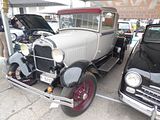
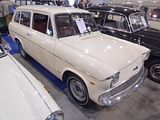
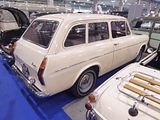
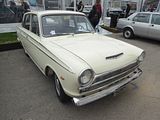
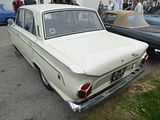


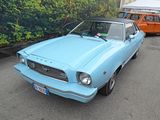
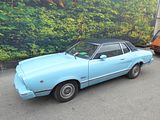
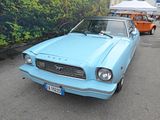

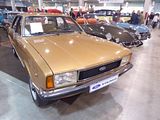
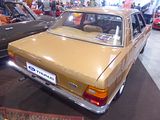
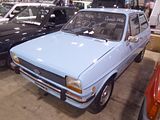

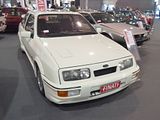
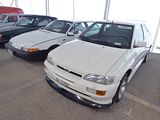
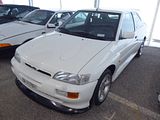
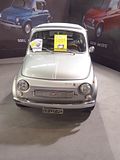

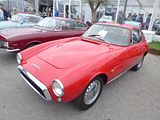
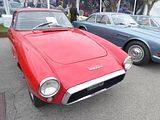
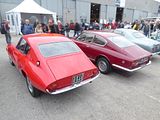
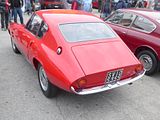
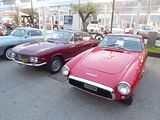

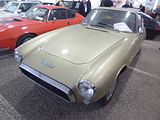
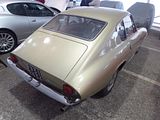
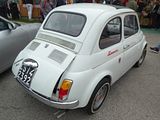
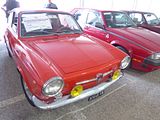


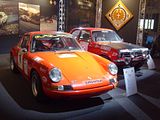
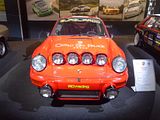
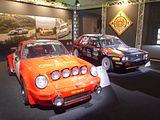

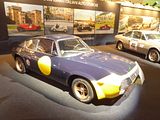
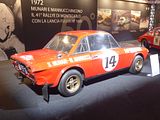
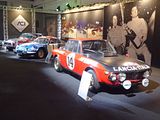

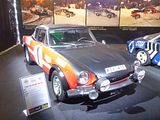
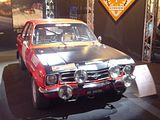
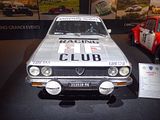

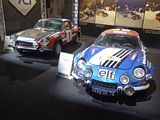
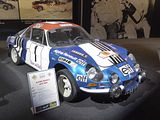

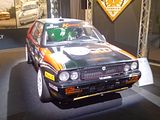



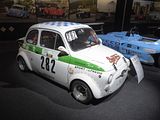

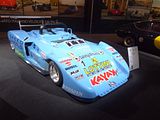


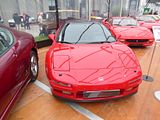
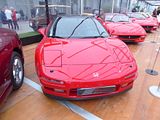

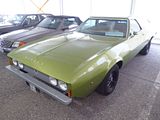
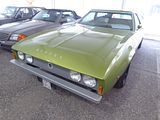

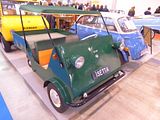
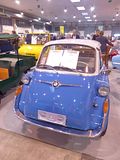
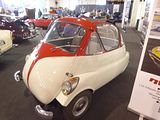
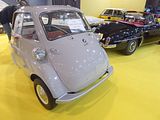
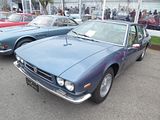

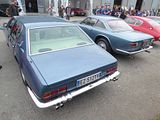
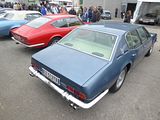
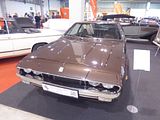
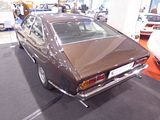

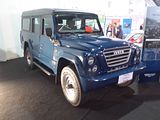
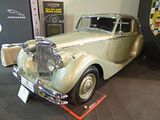
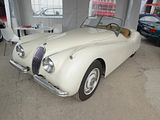



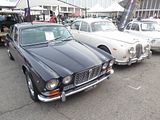
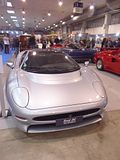

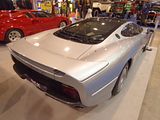
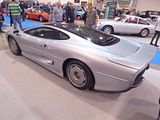
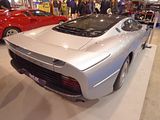
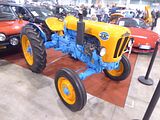
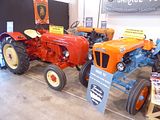


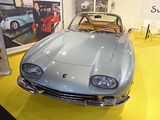
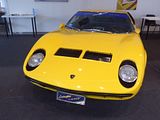
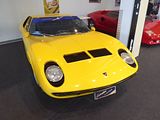
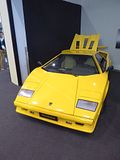


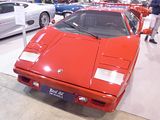
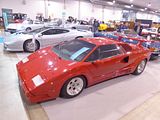
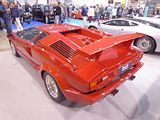
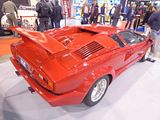

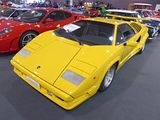

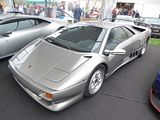
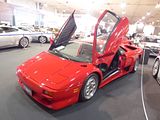
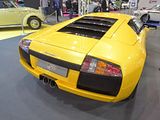
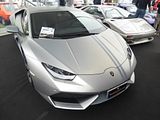



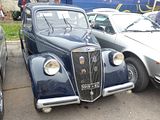
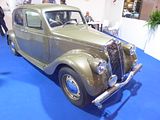
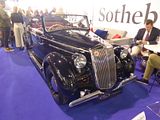
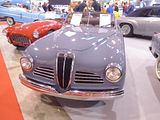
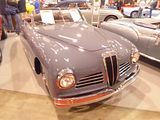
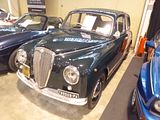
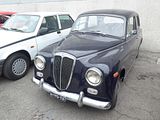
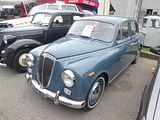
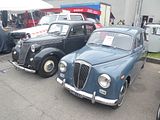
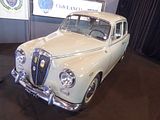
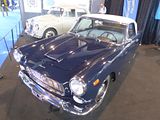
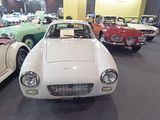
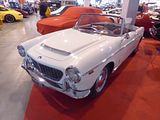
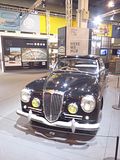

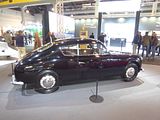
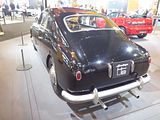
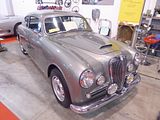
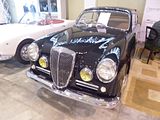
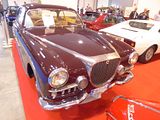

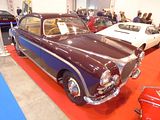
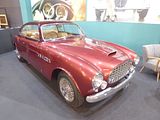
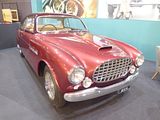


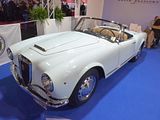

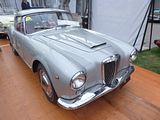
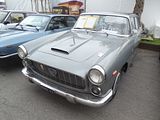
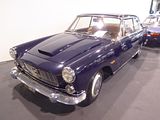
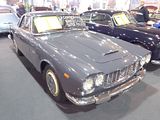

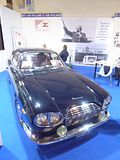
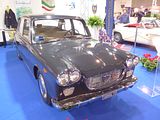
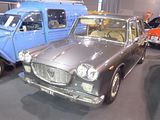
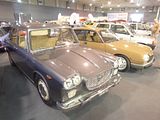
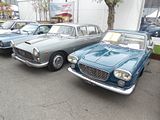
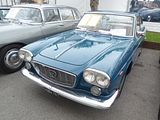
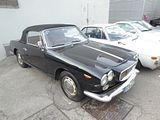
.jpg?width=180&height=120&fit=bounds)
